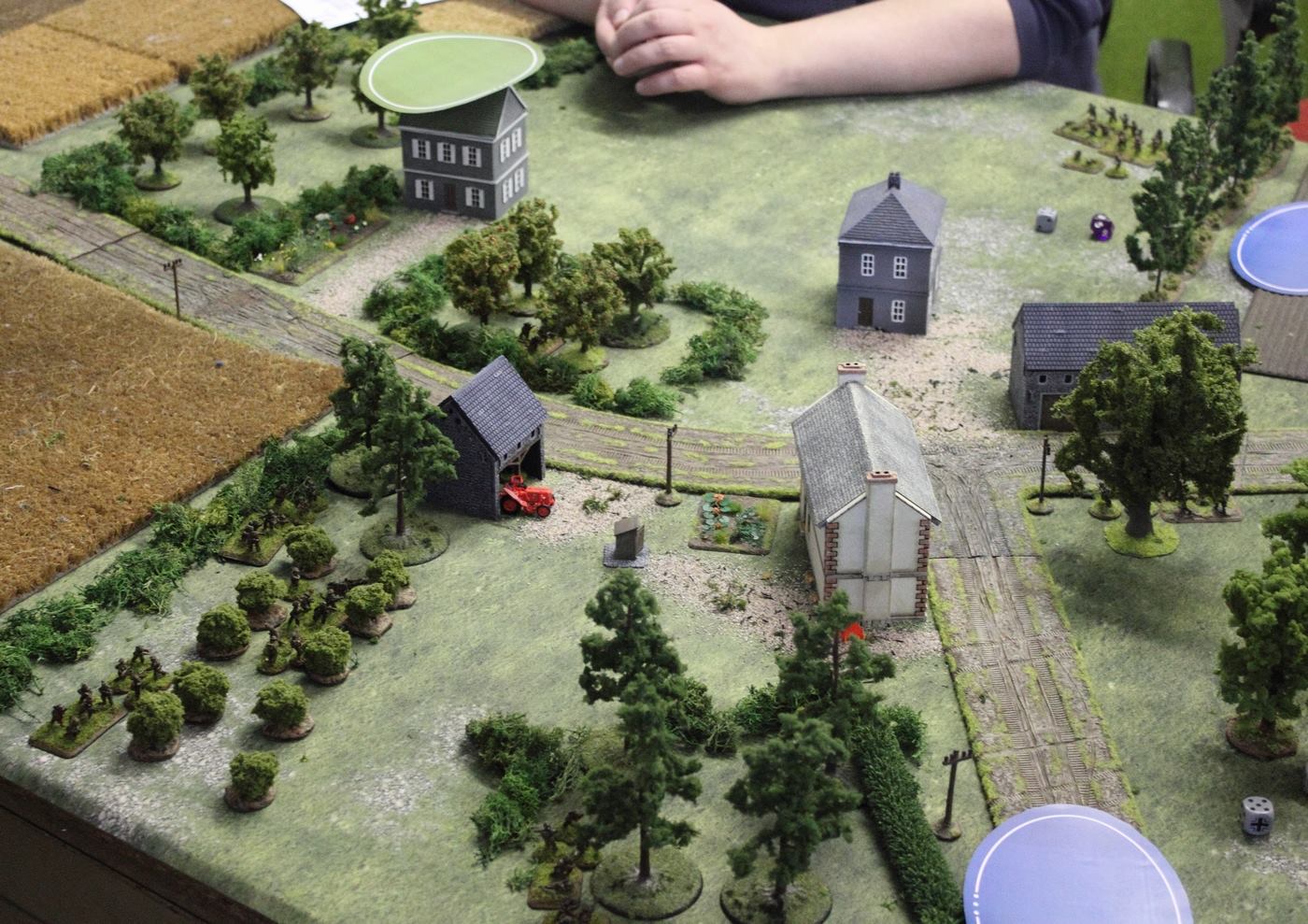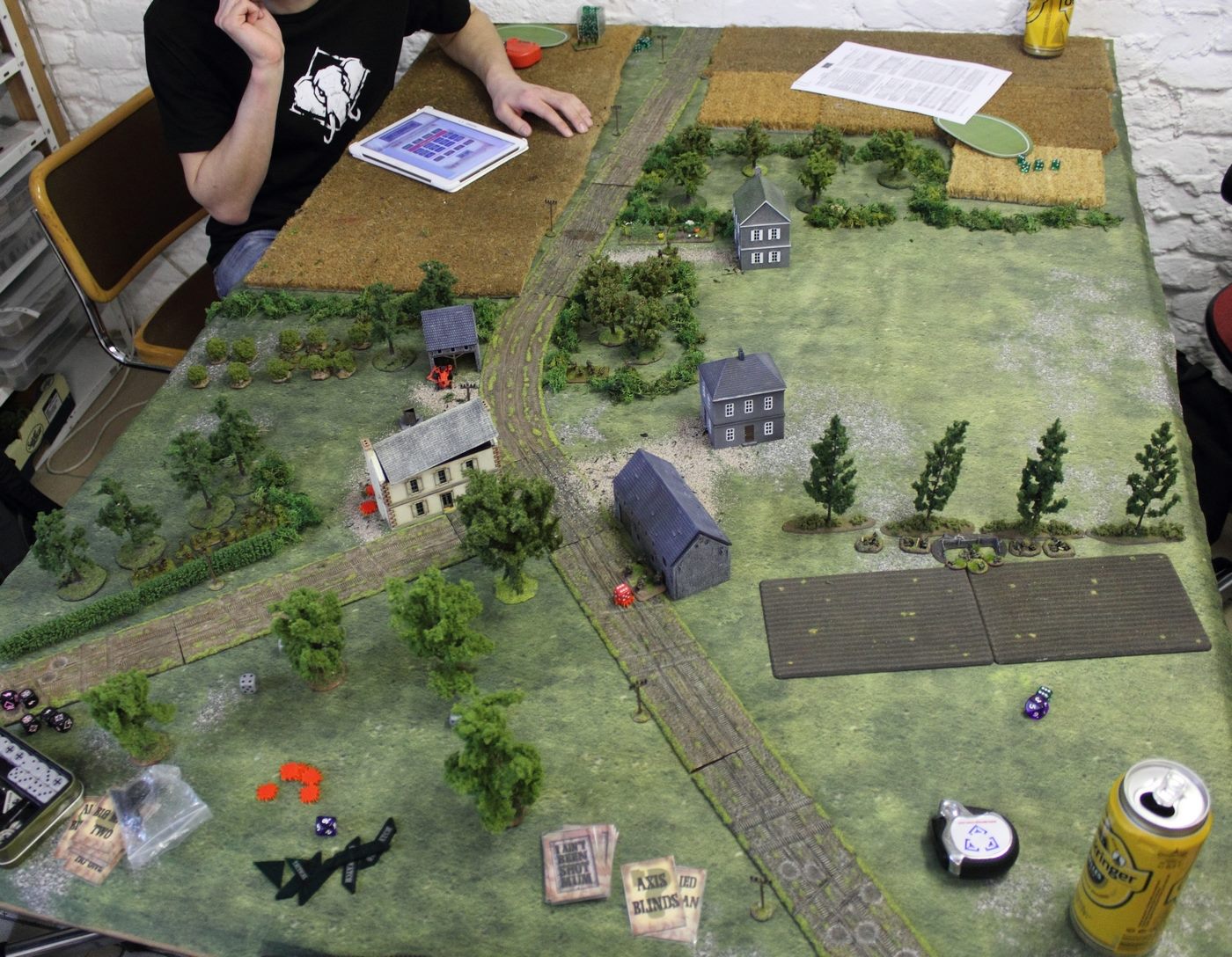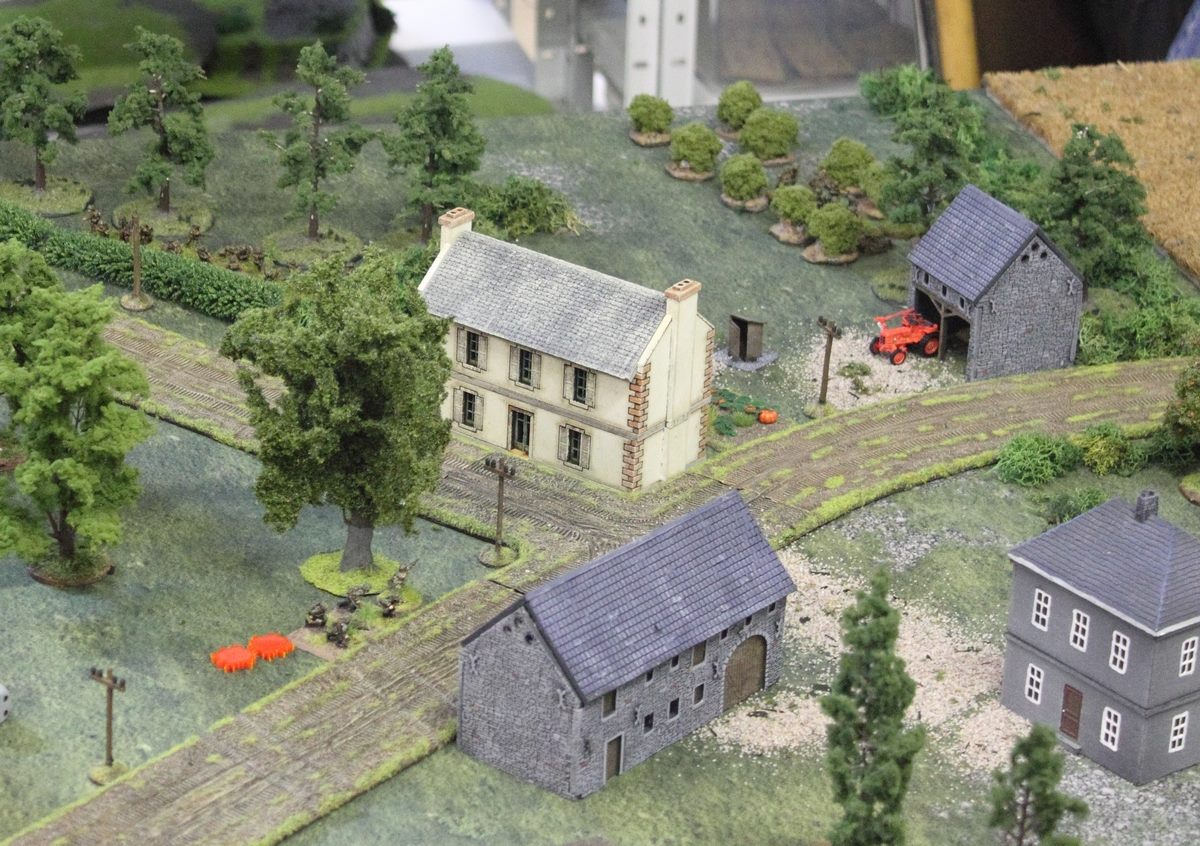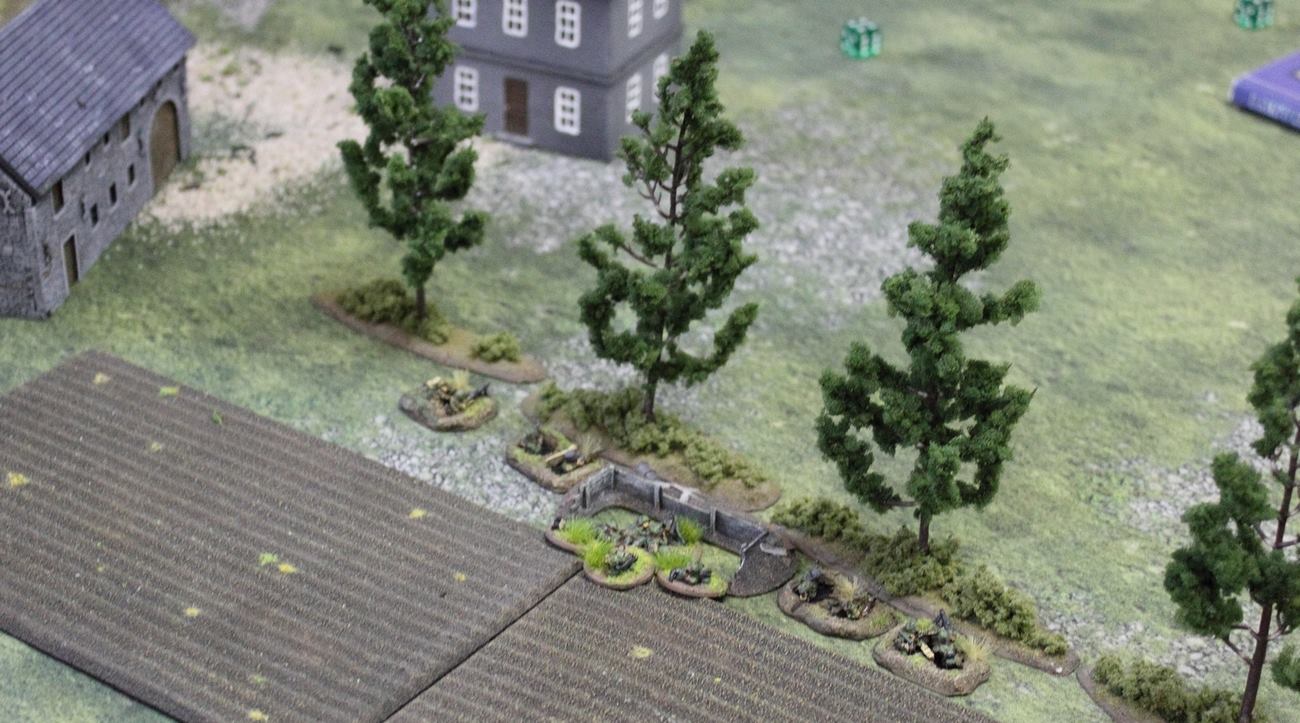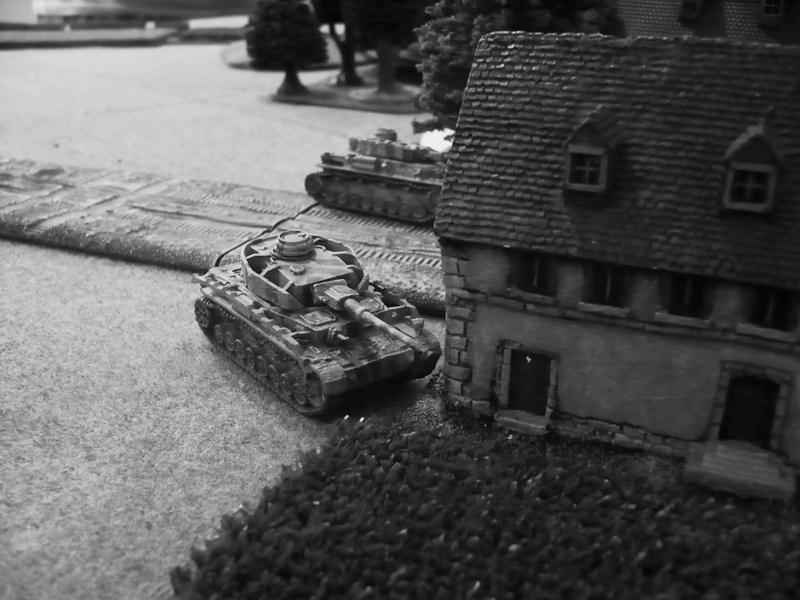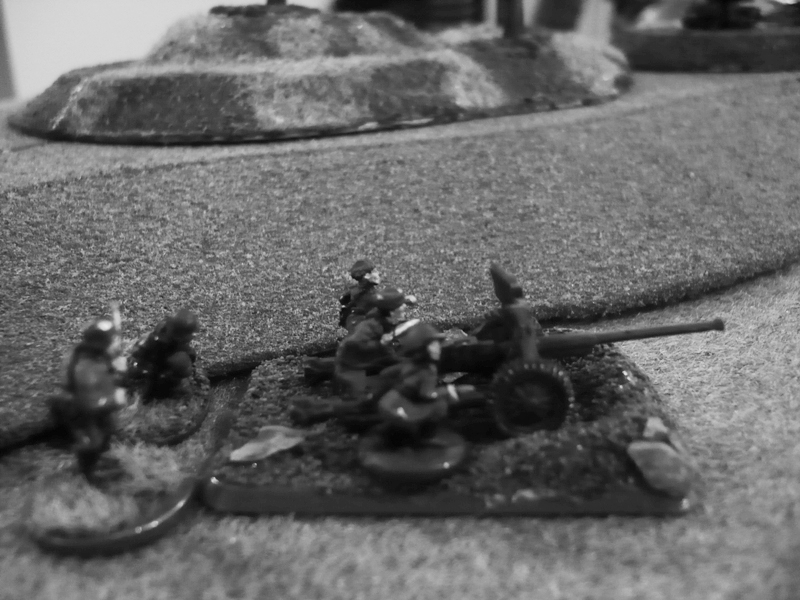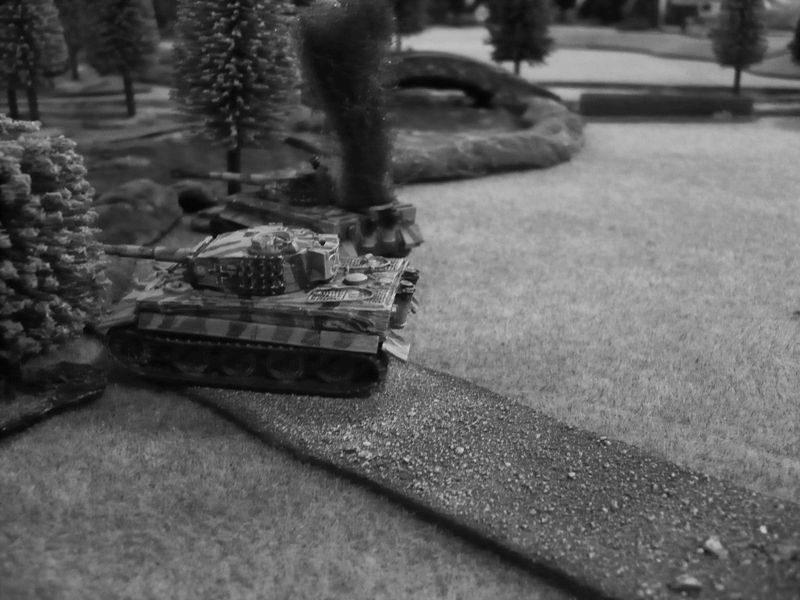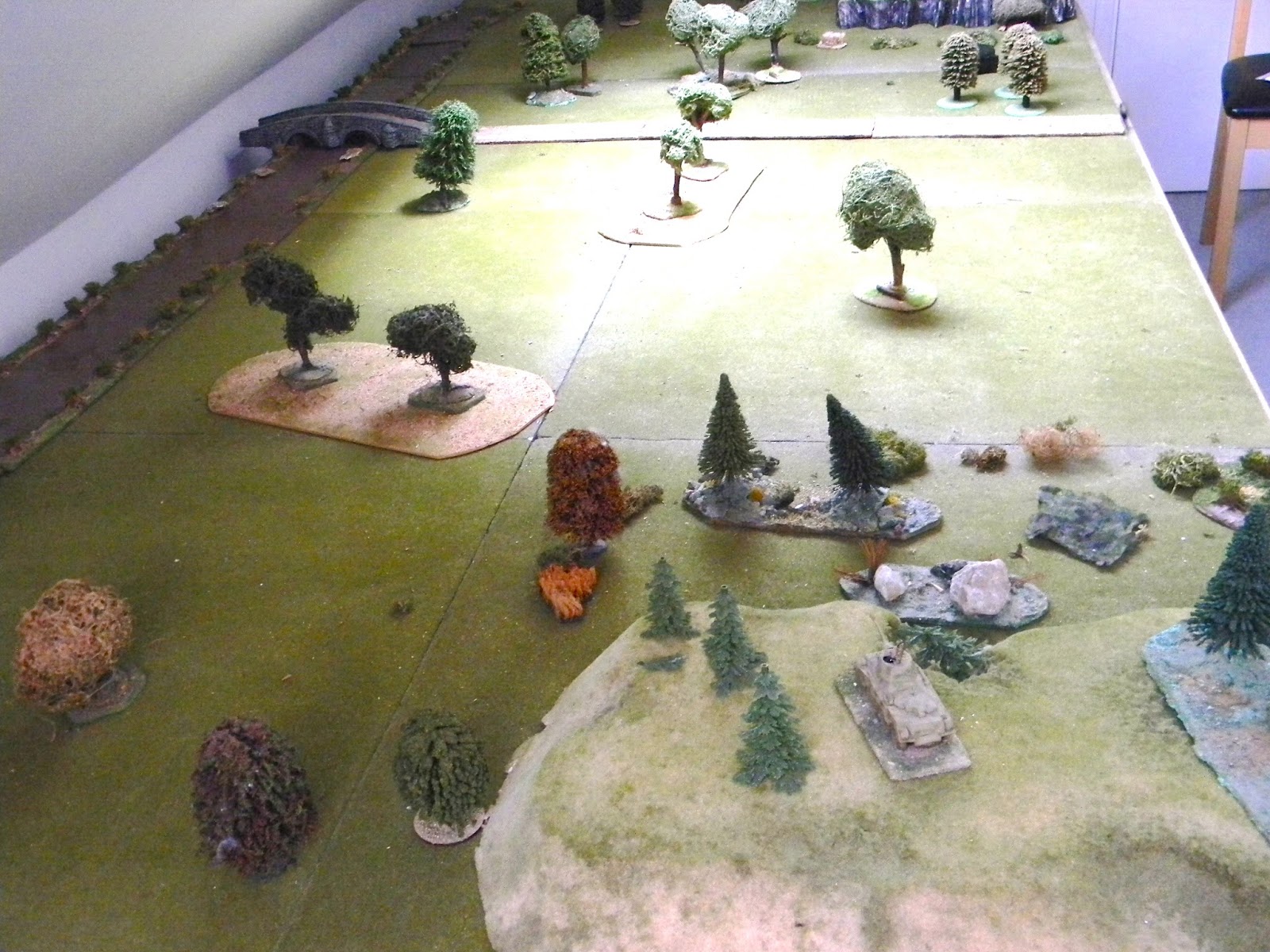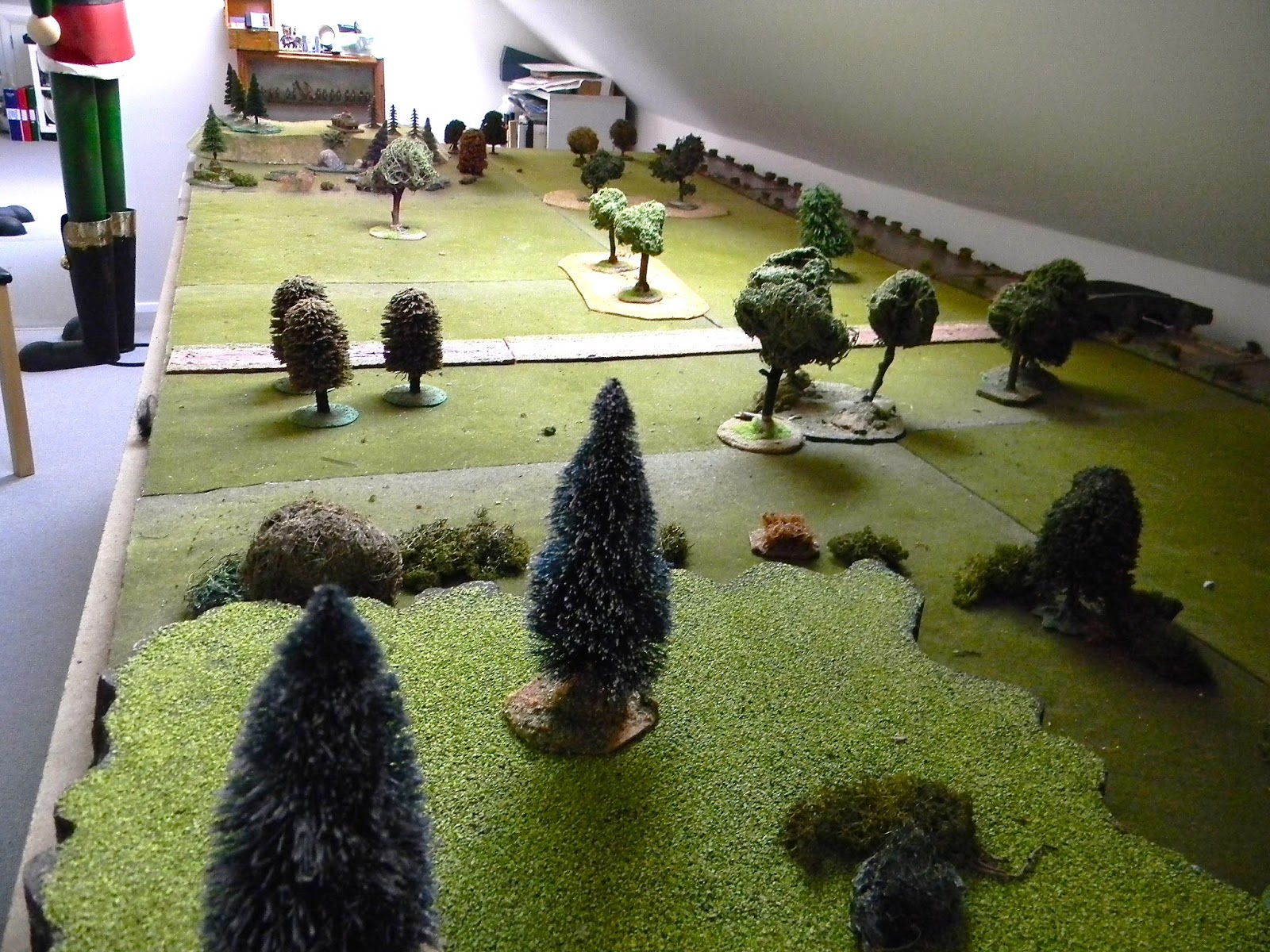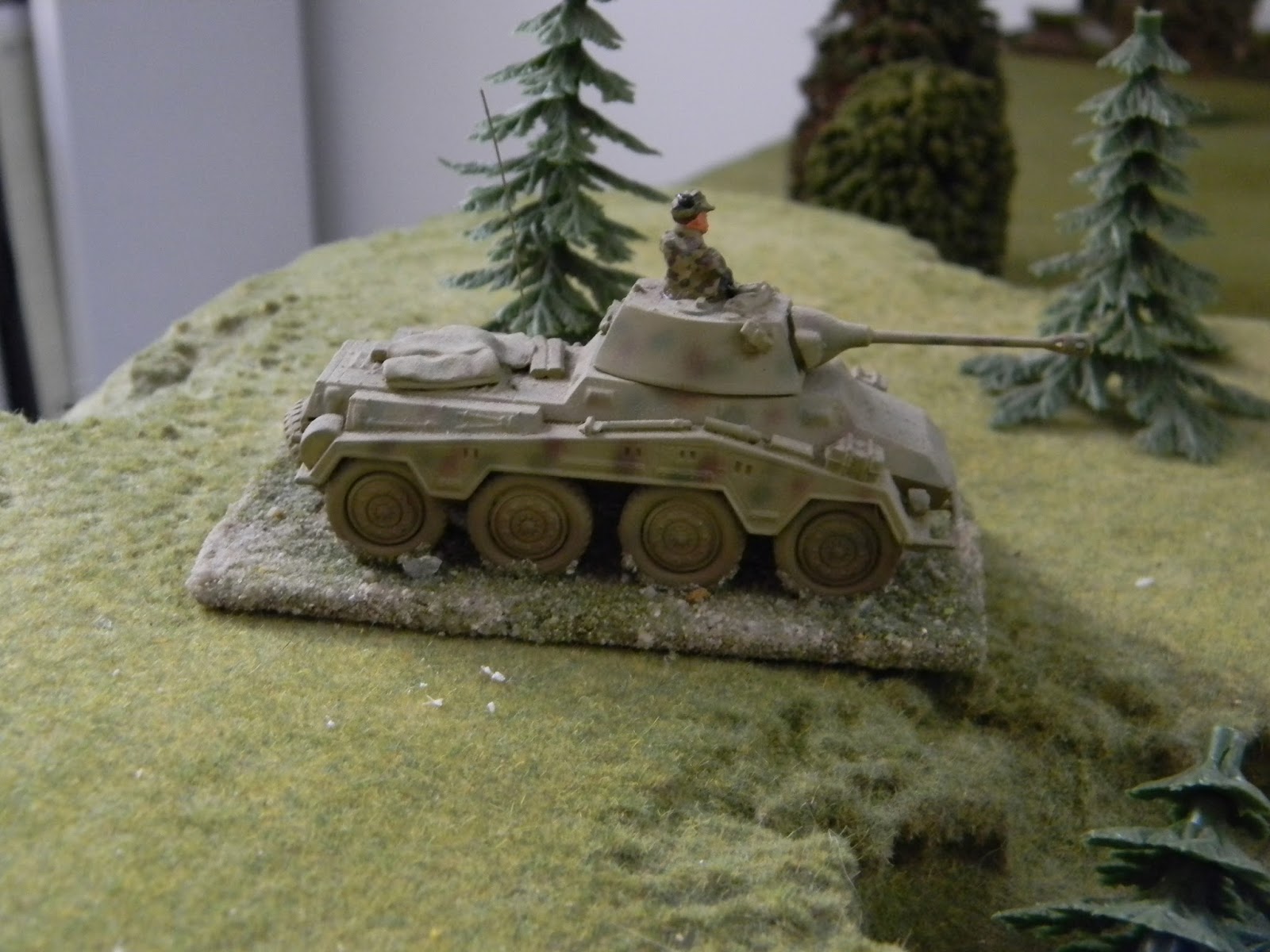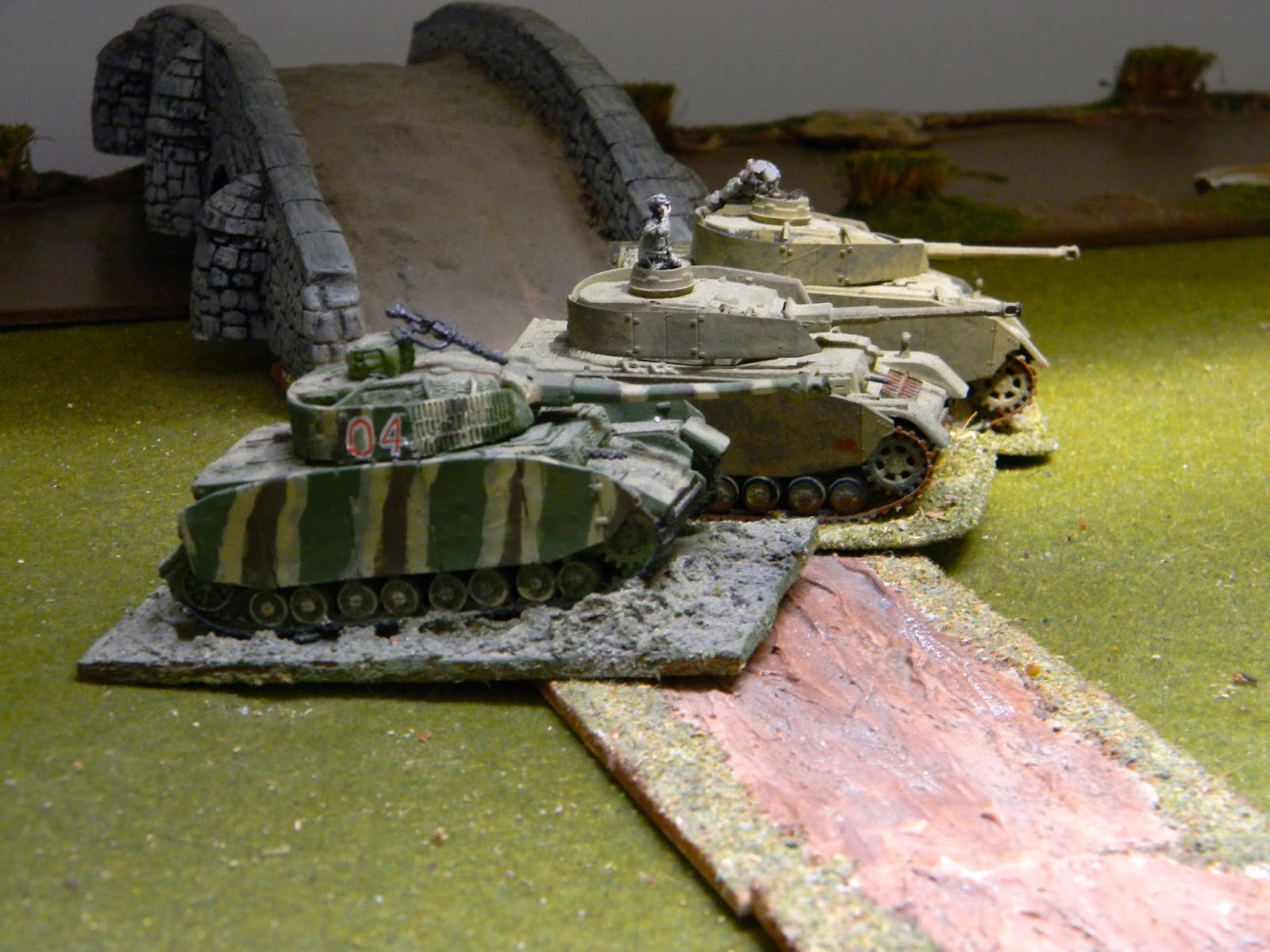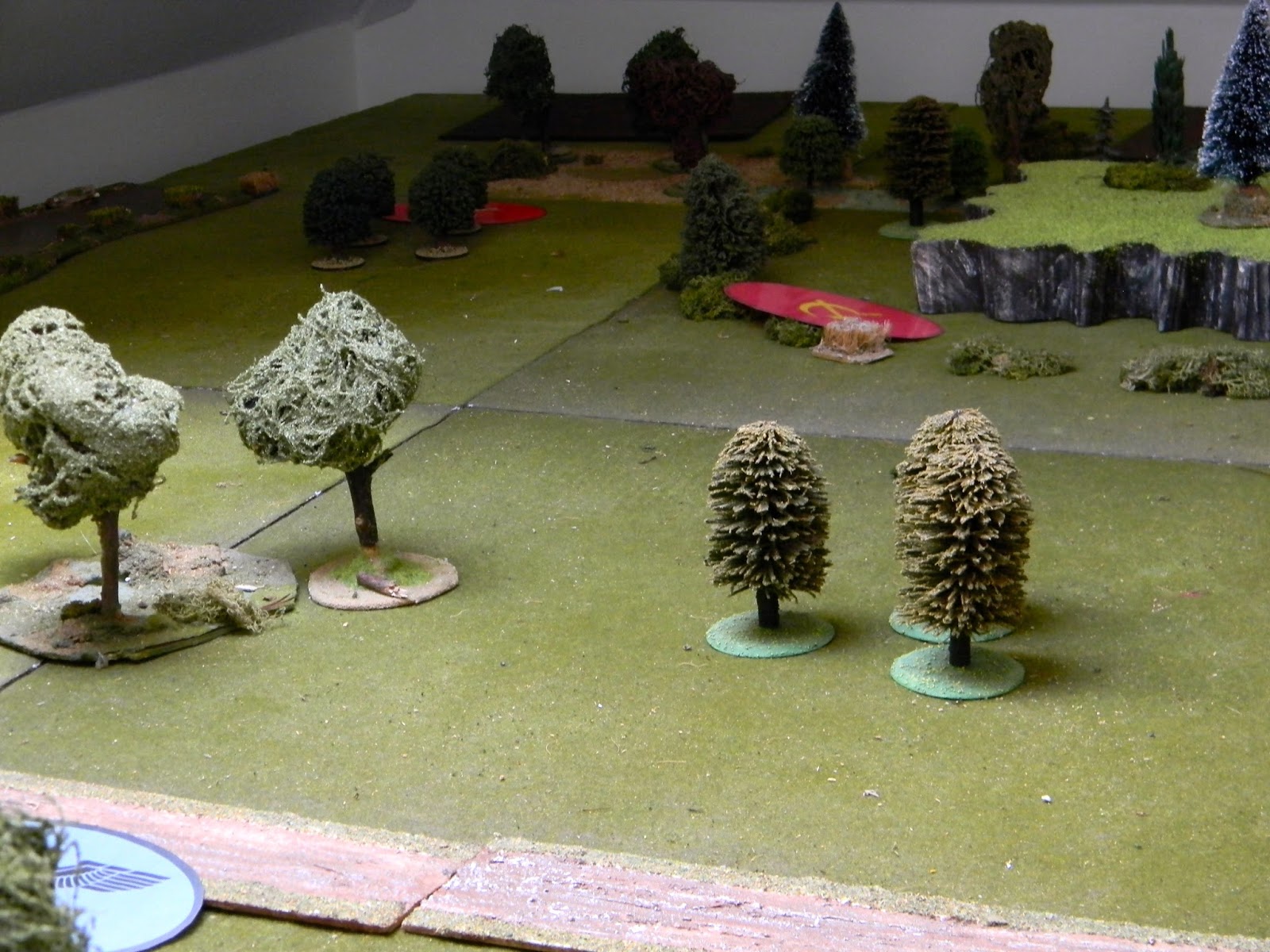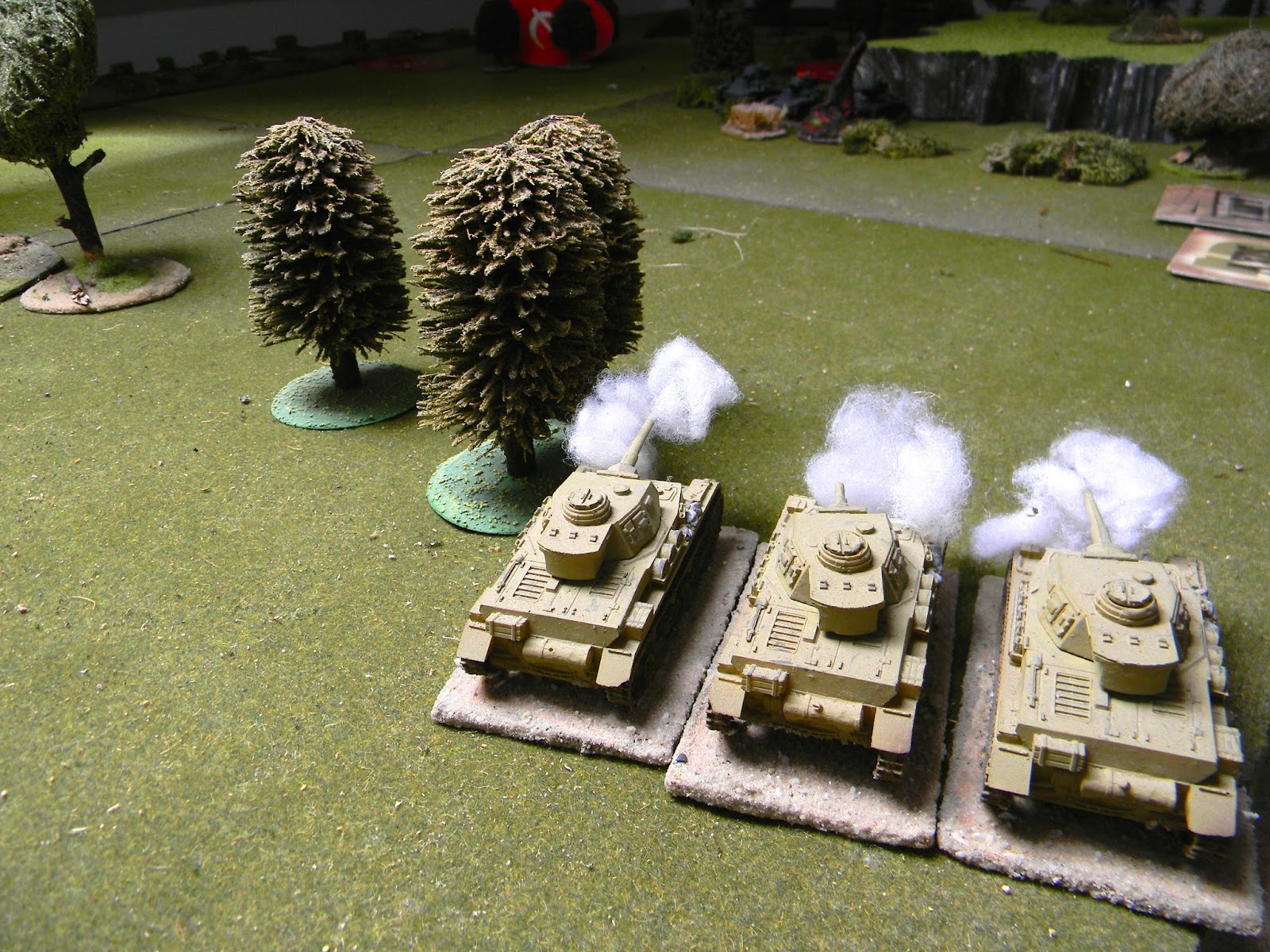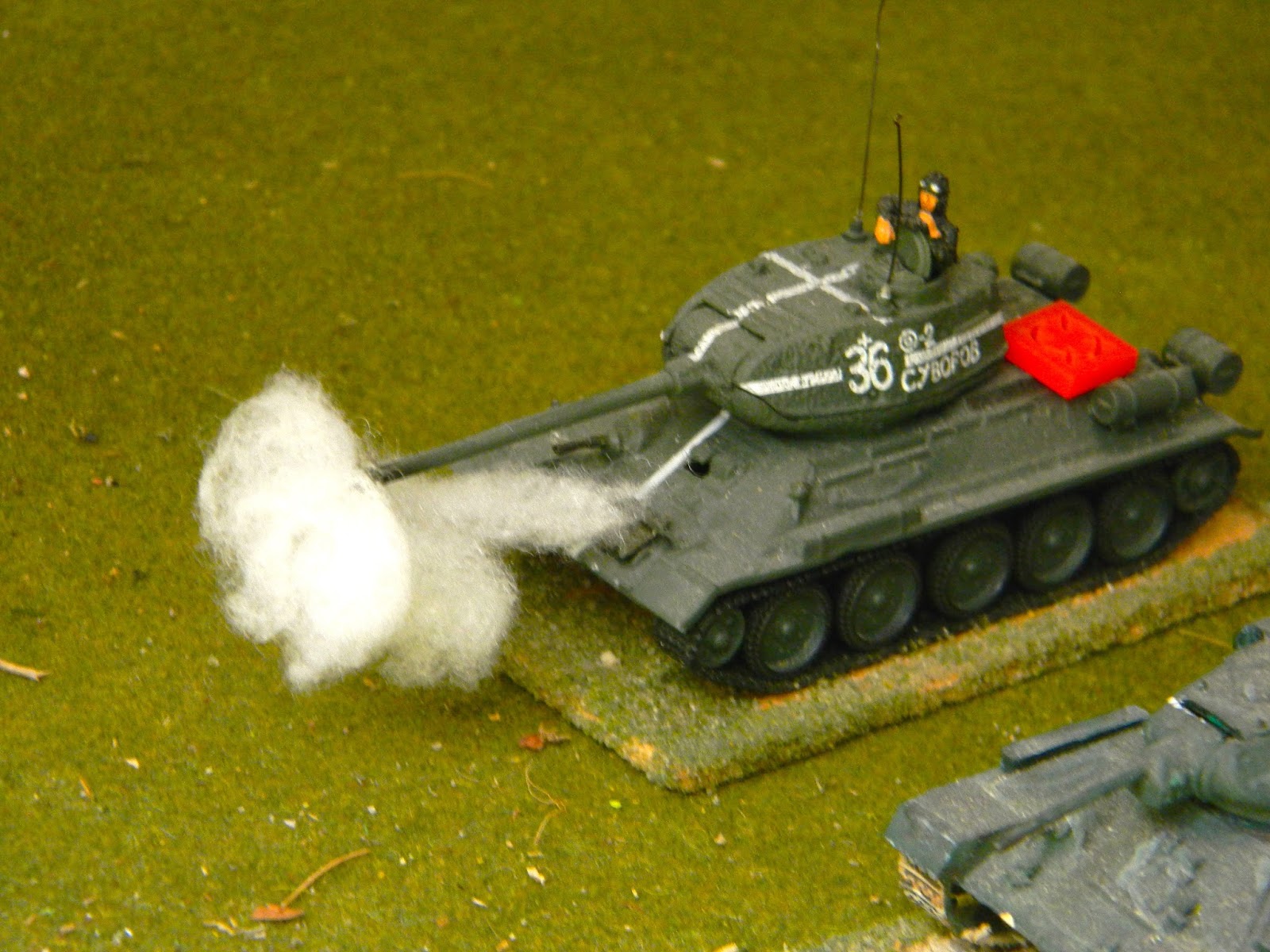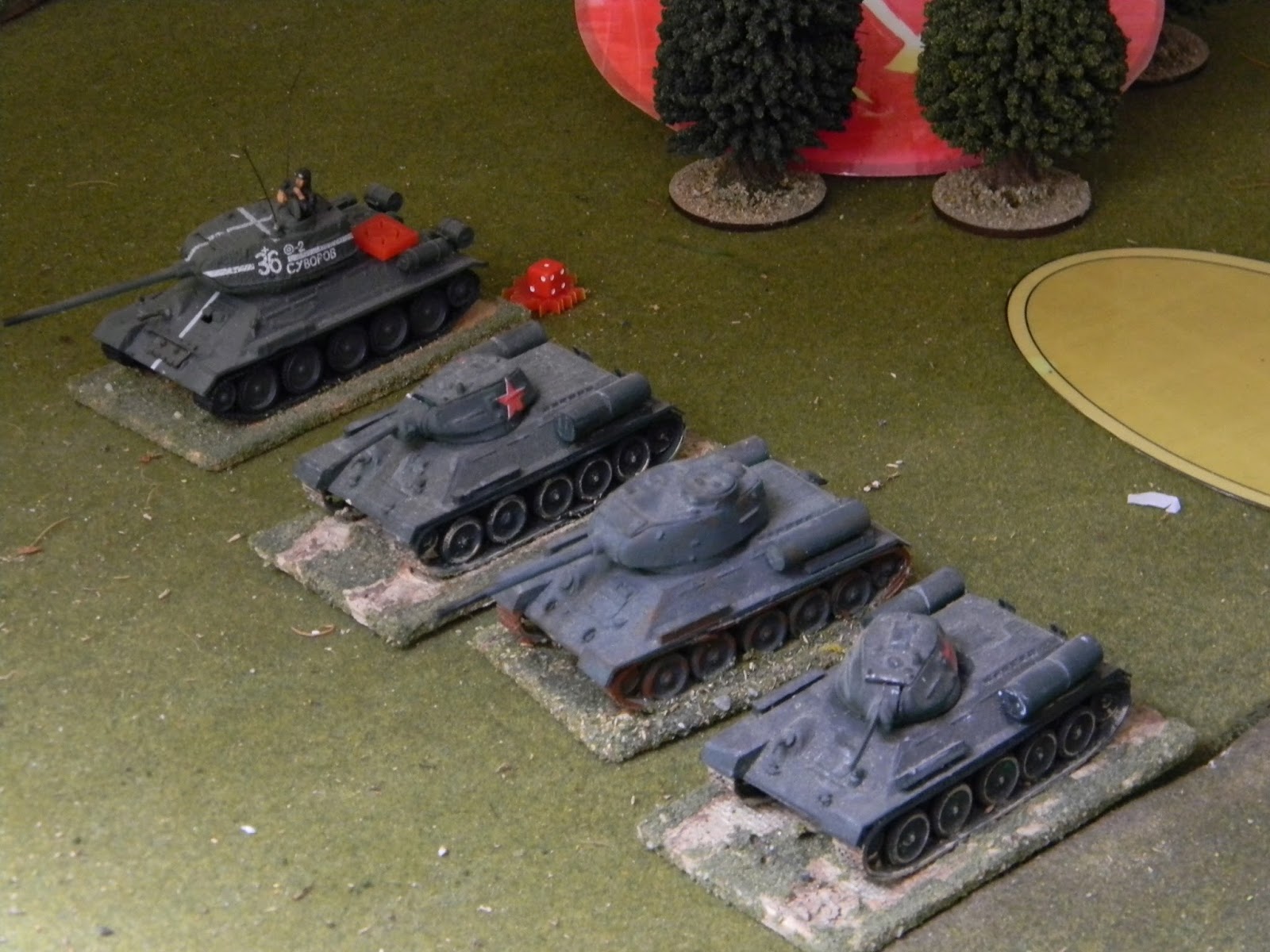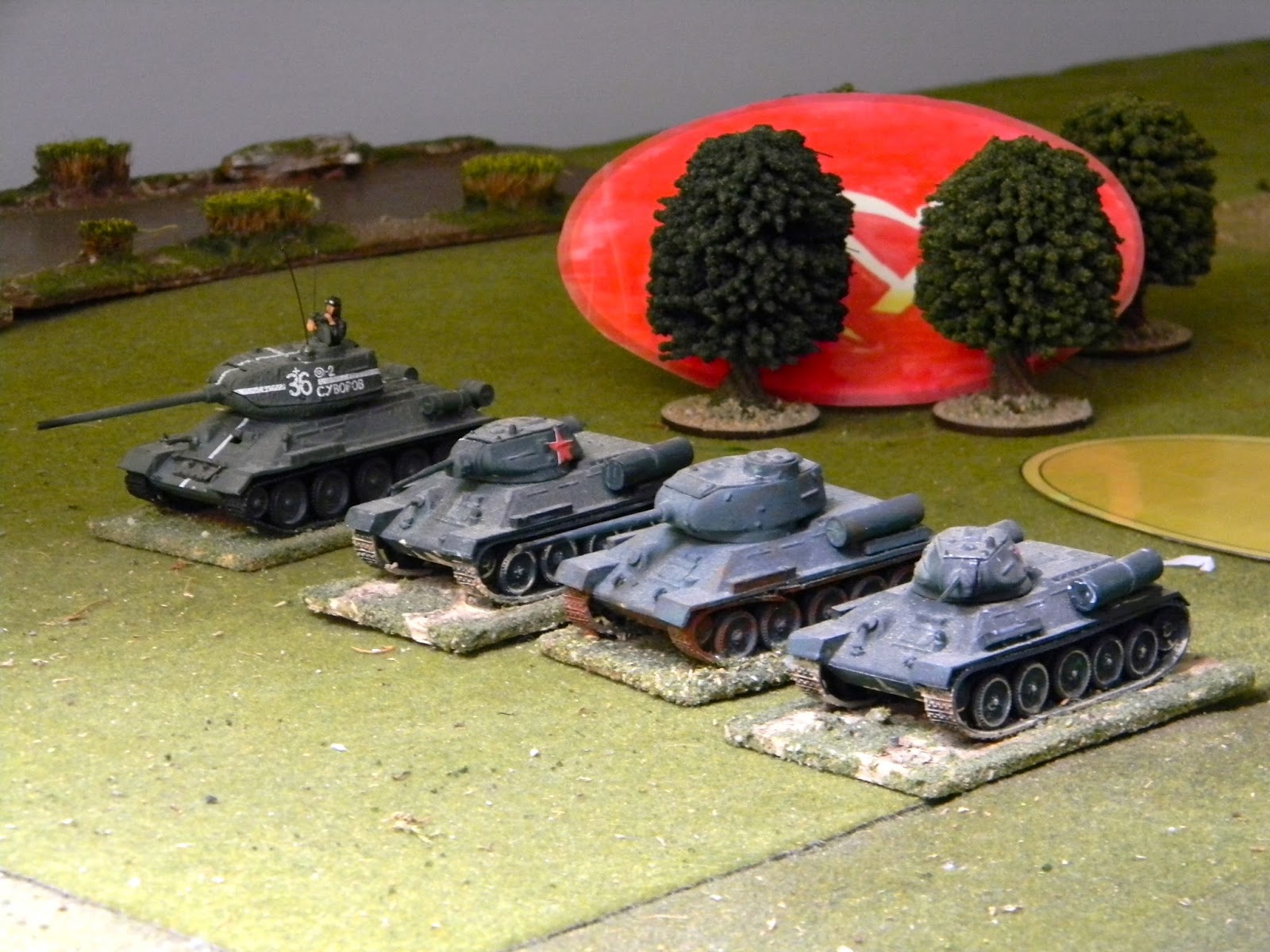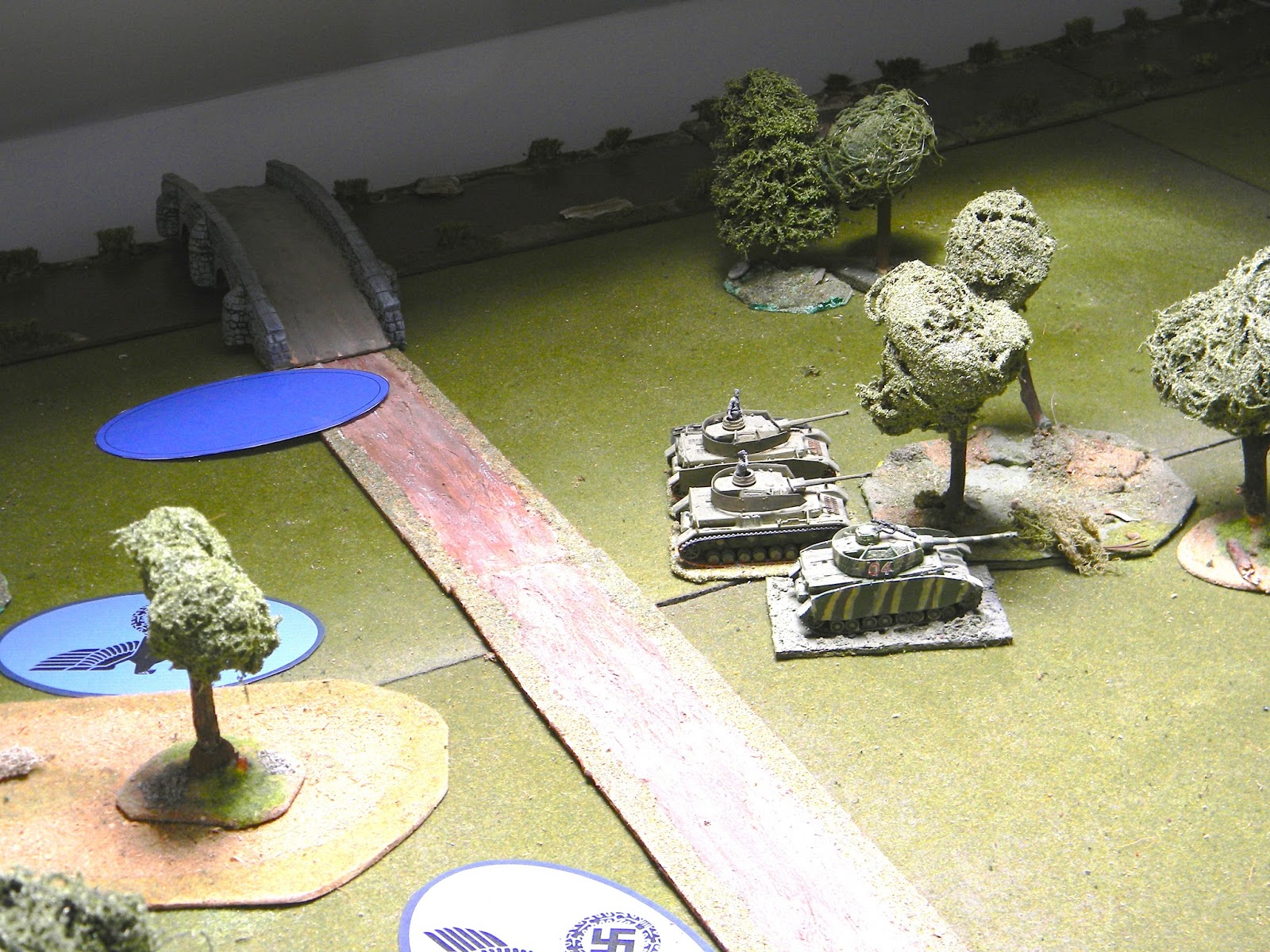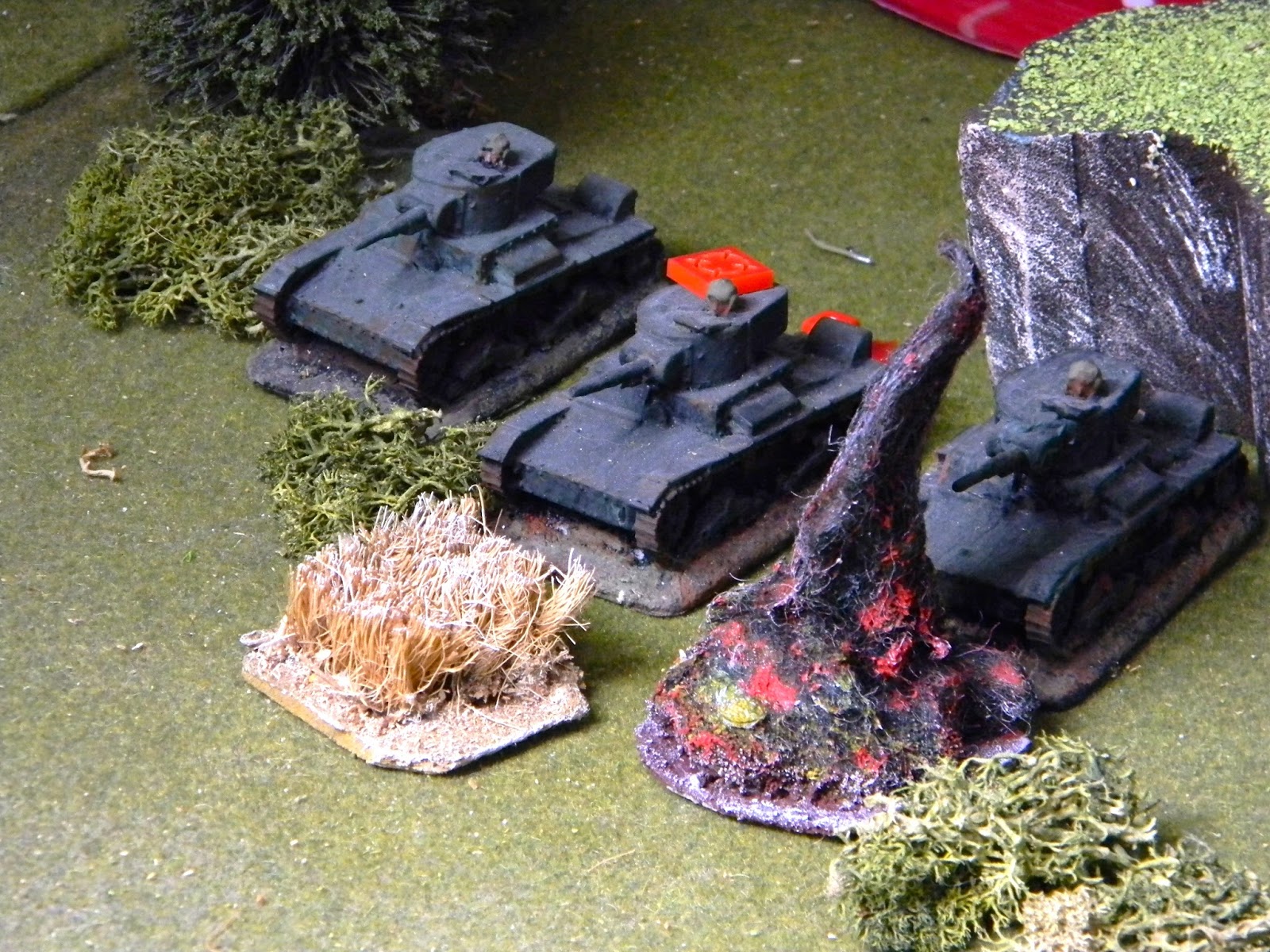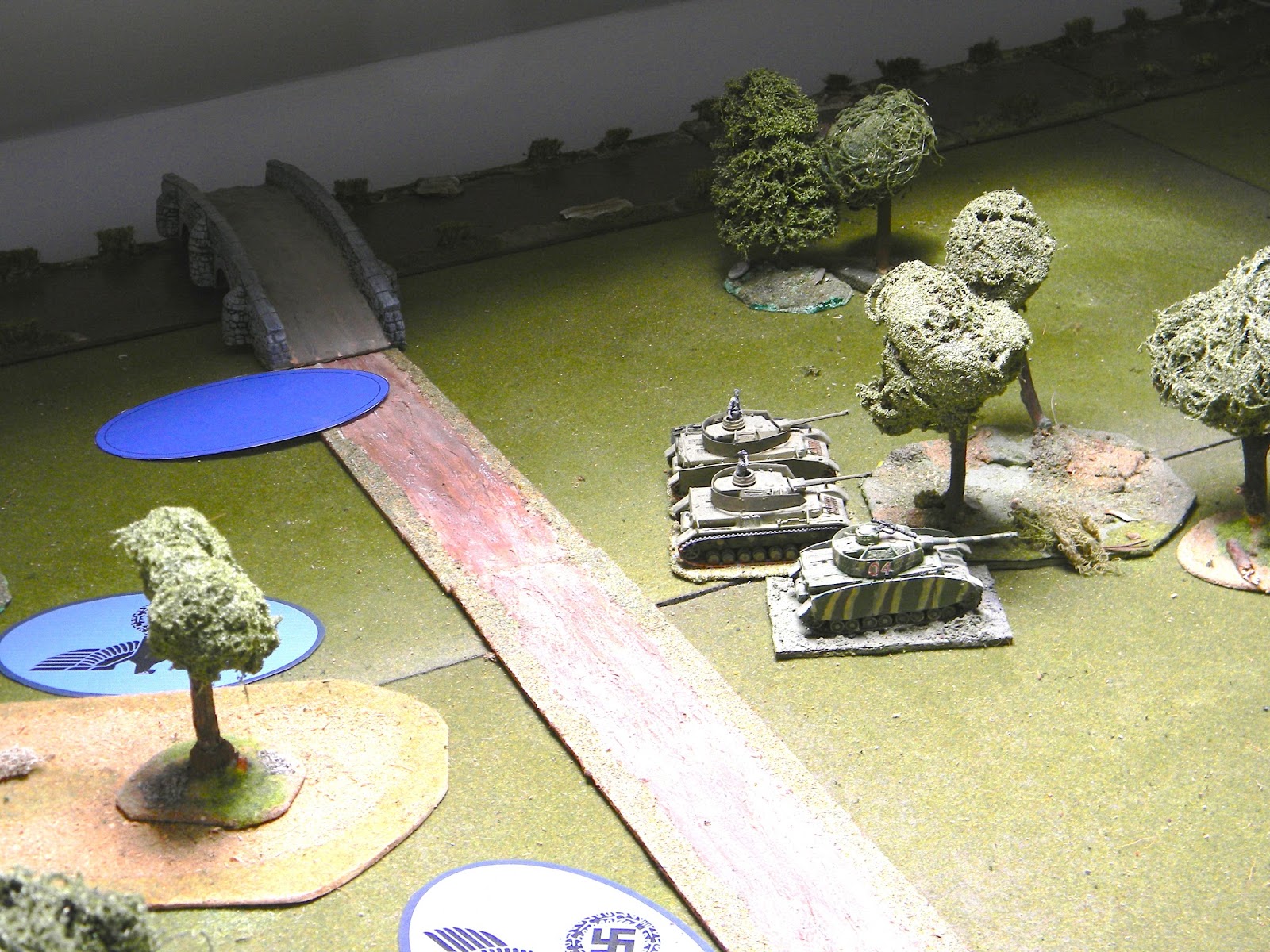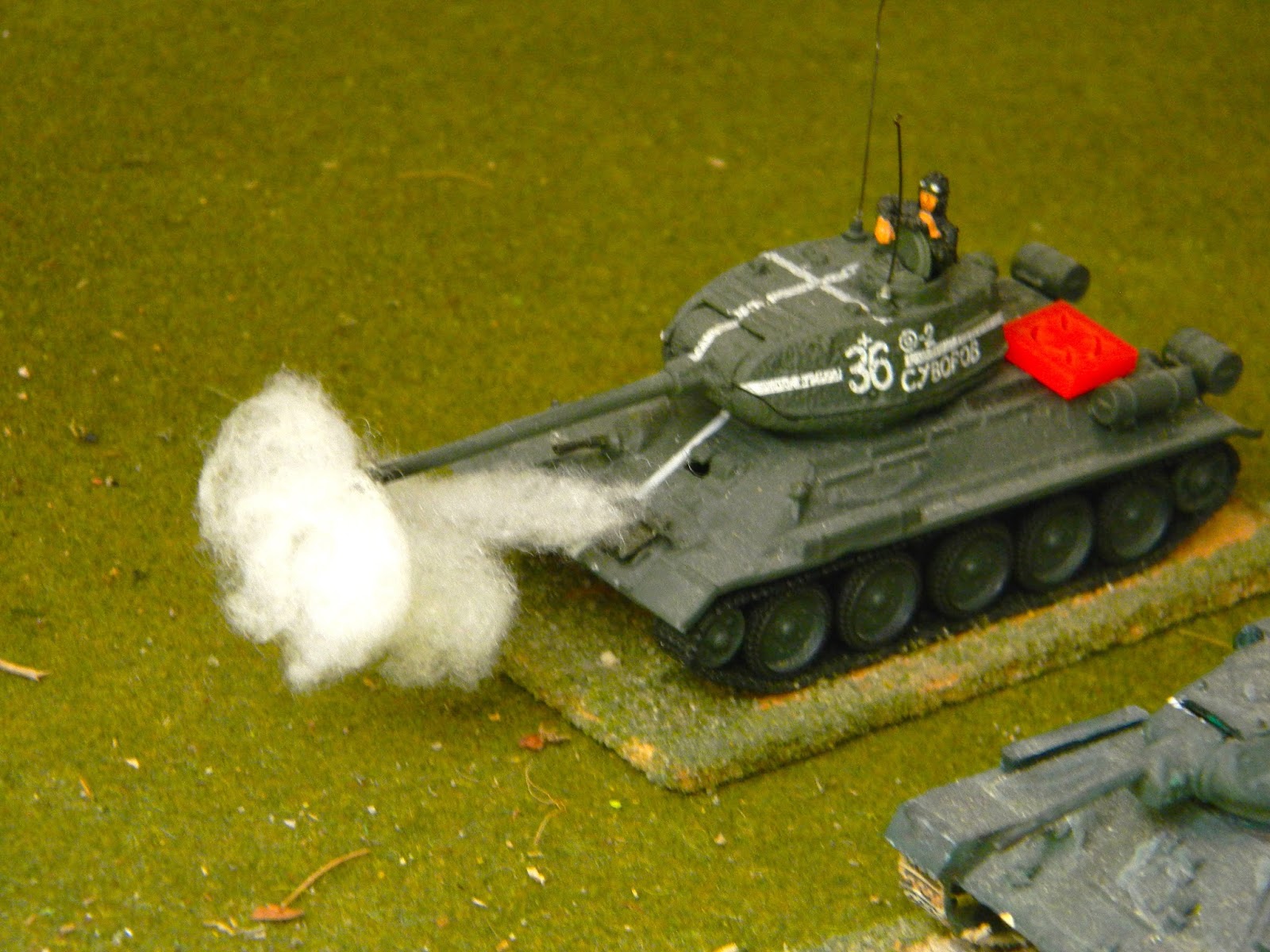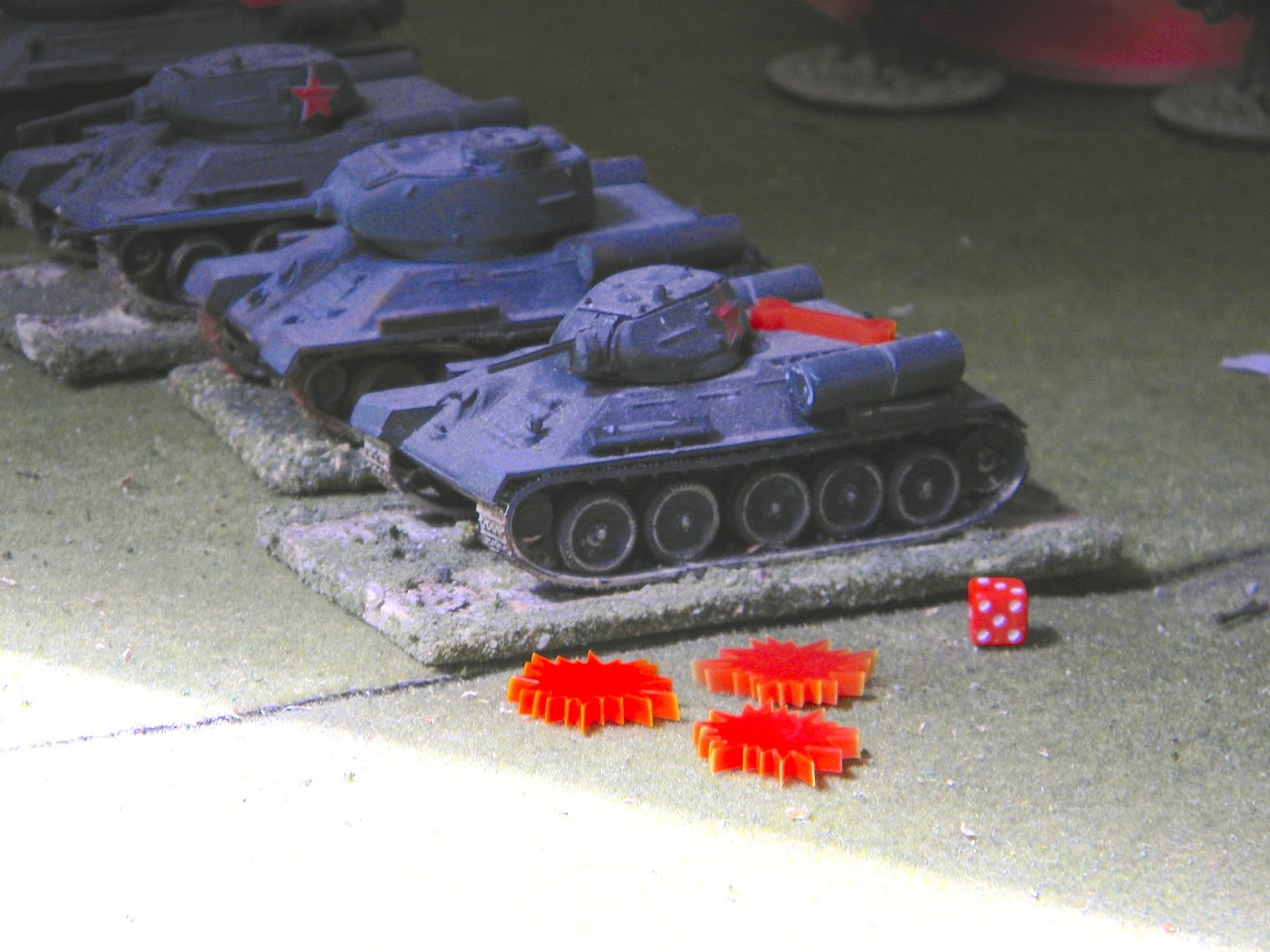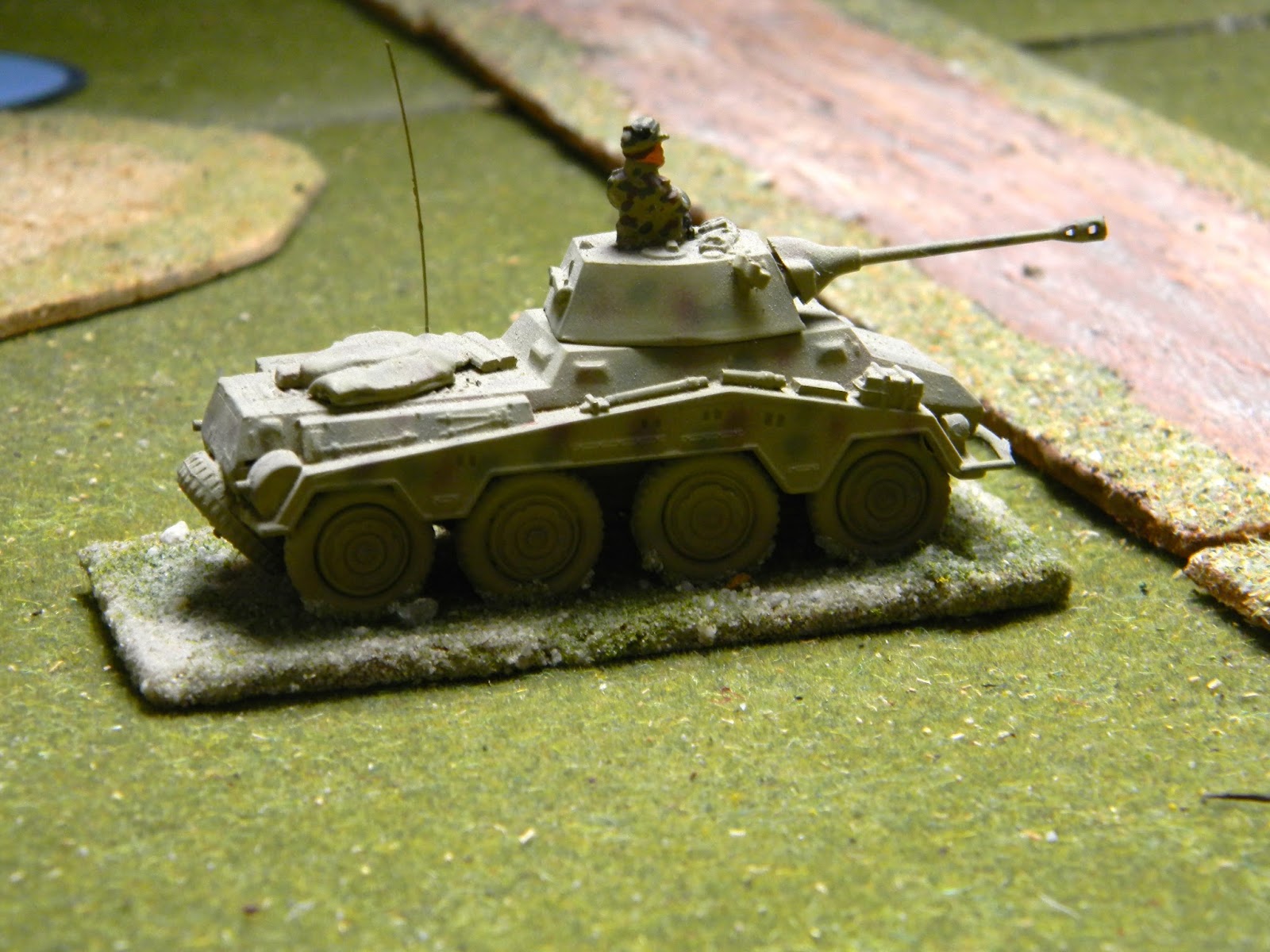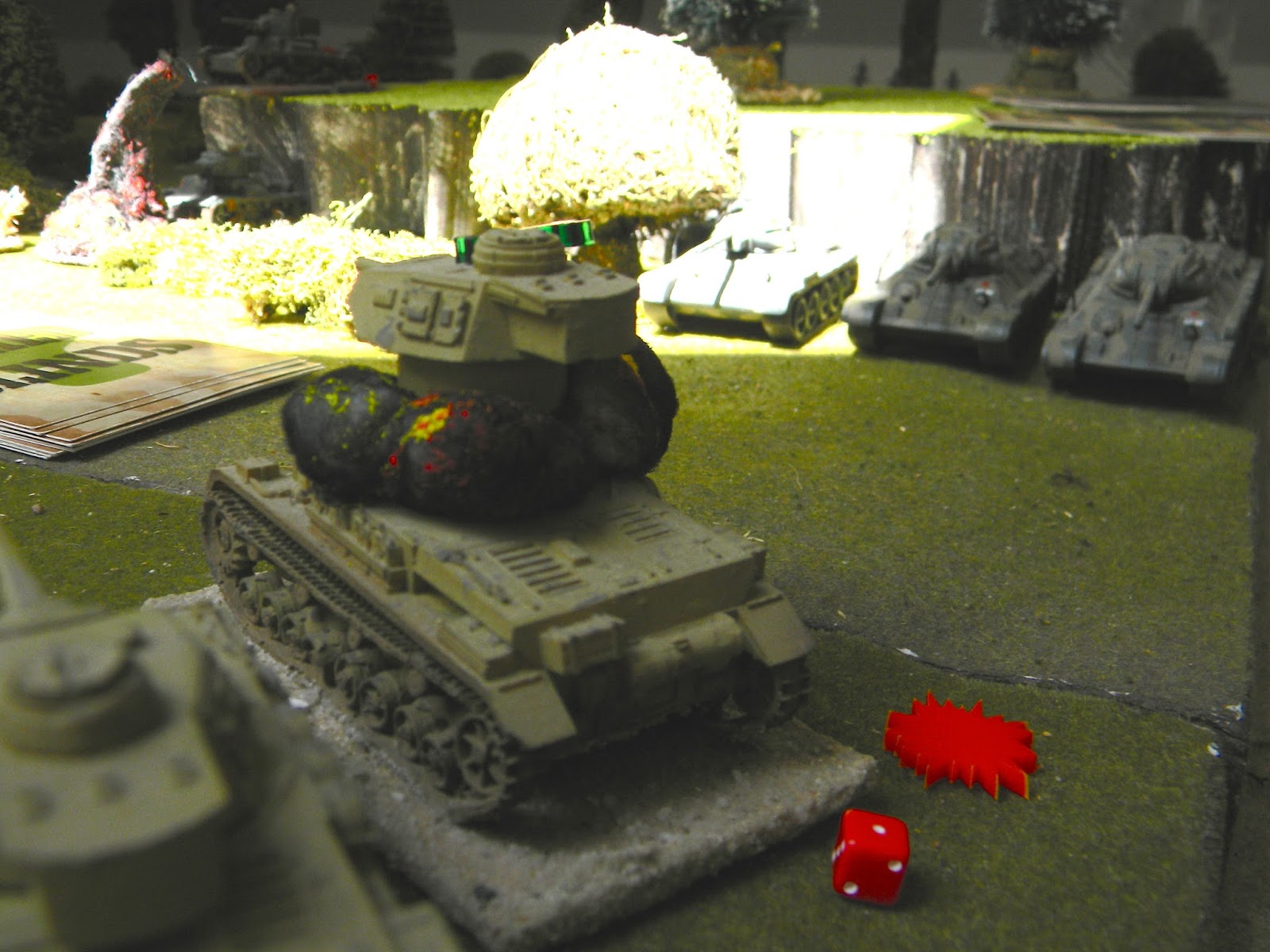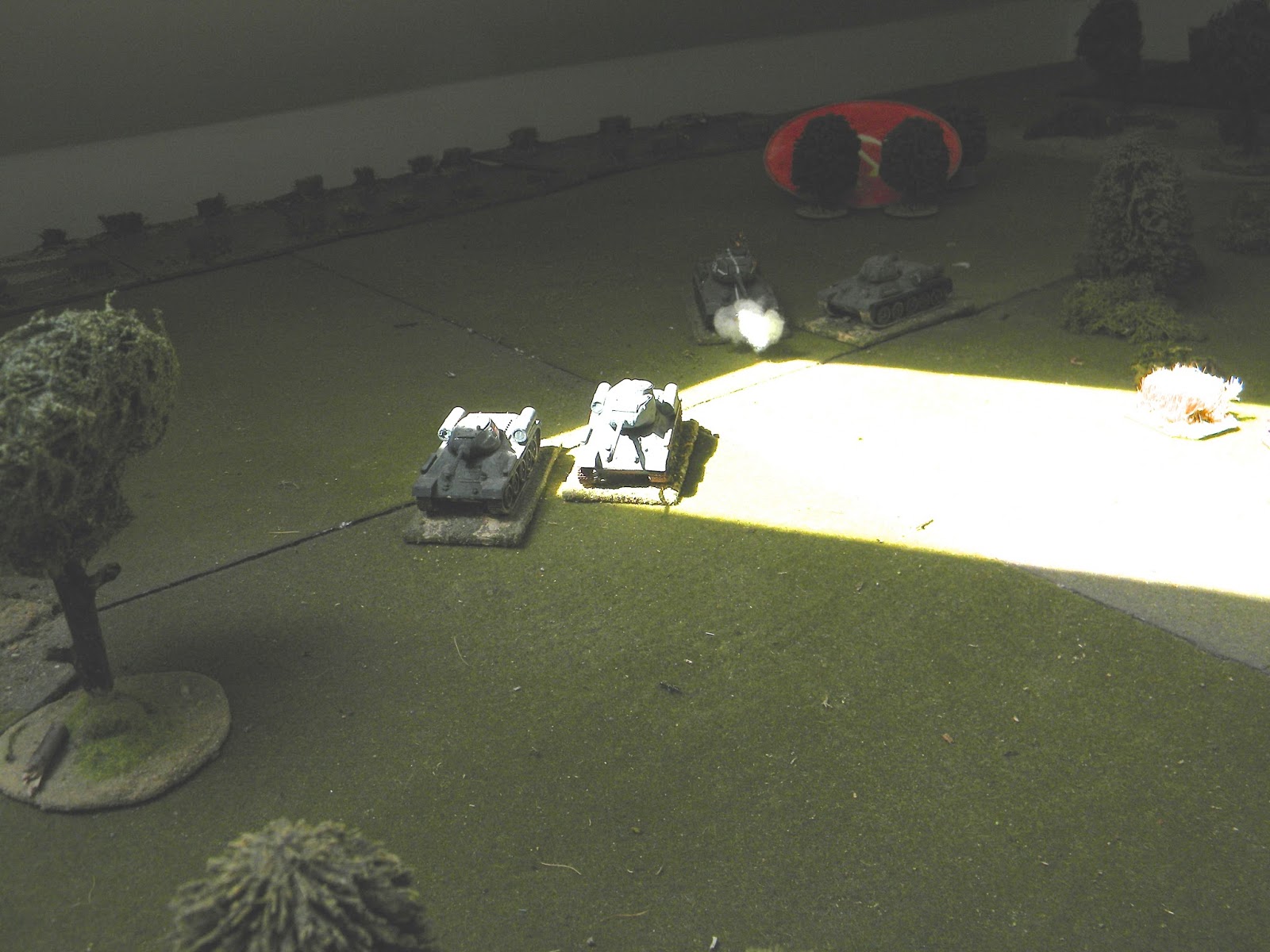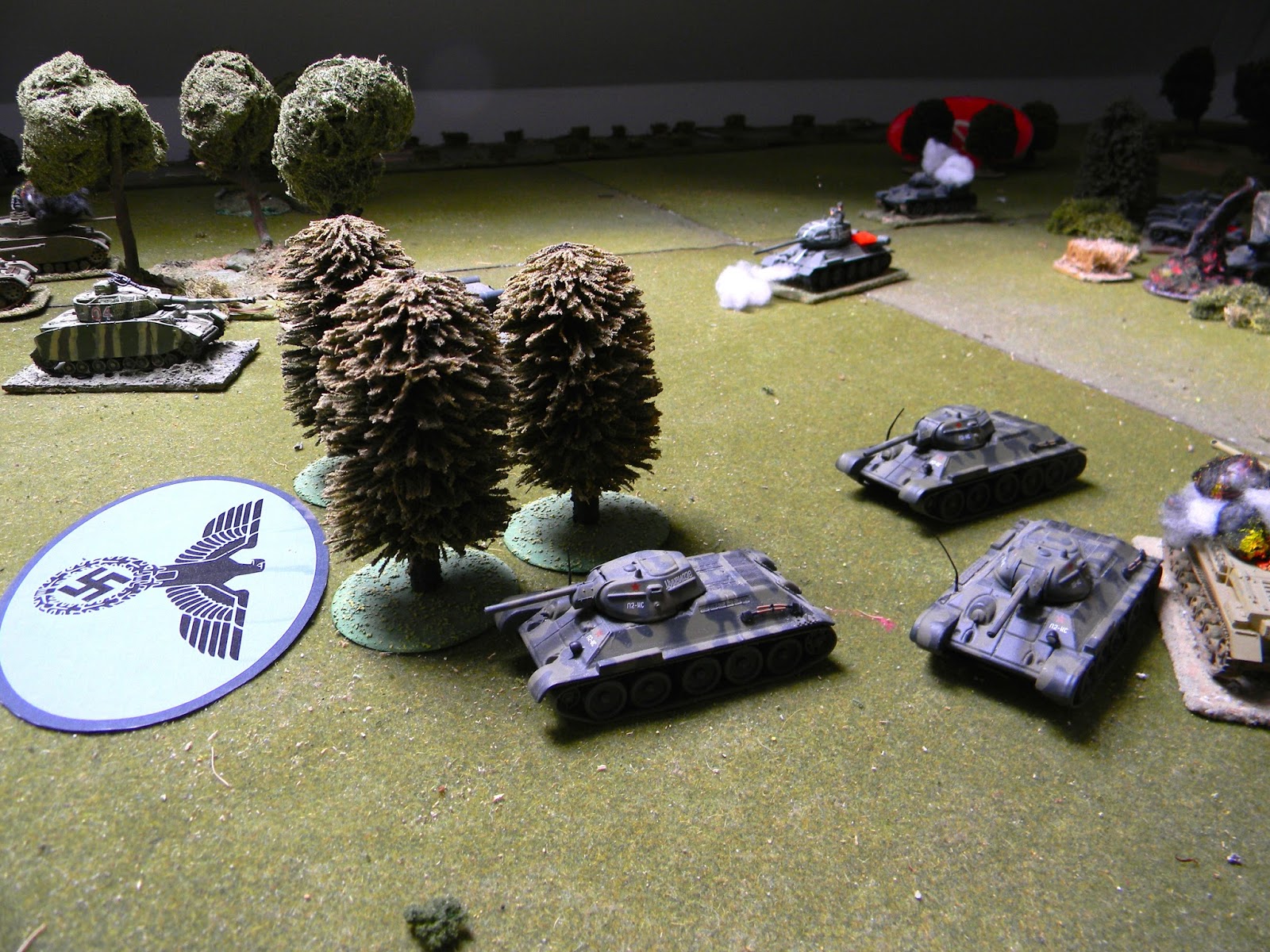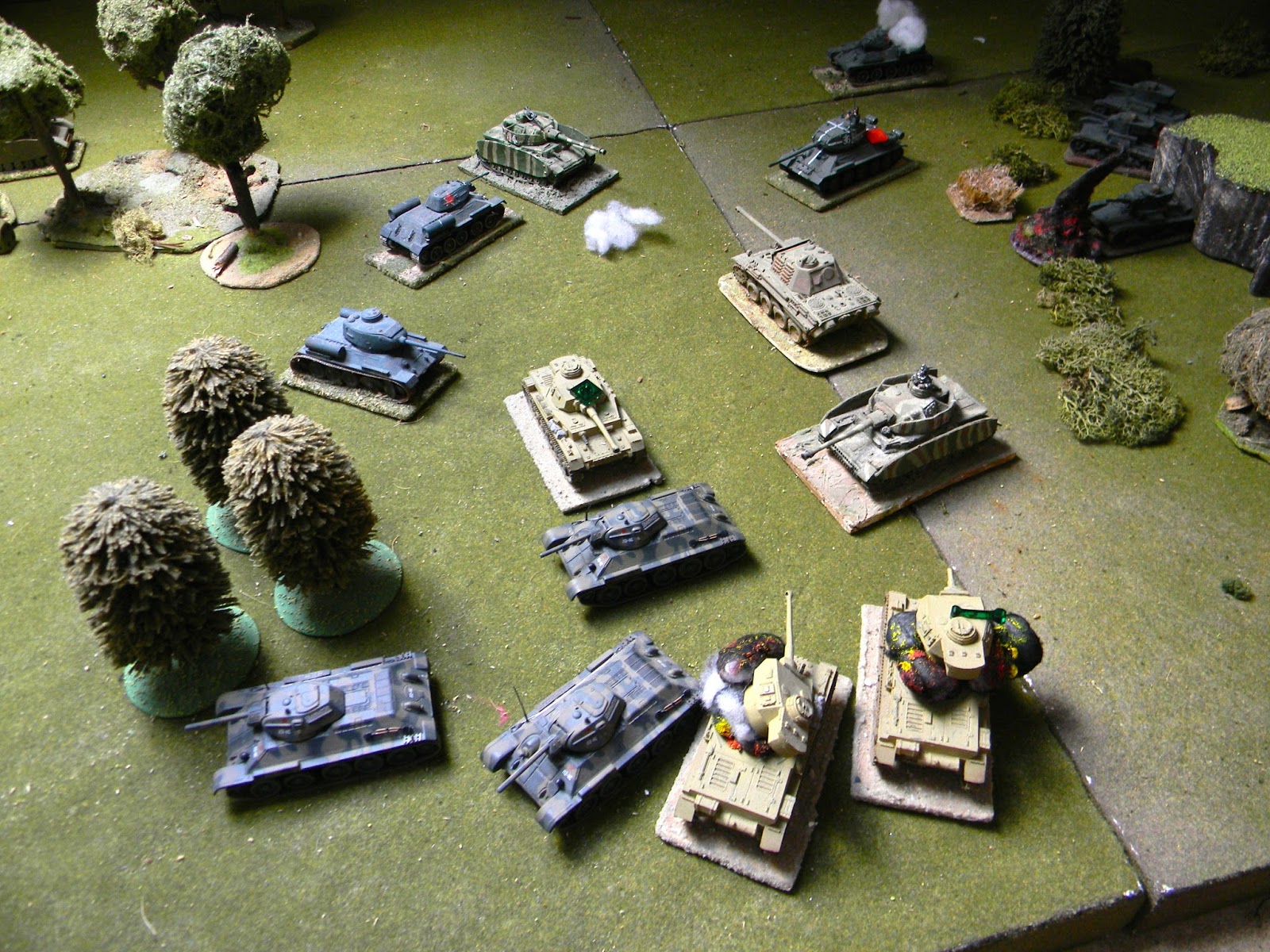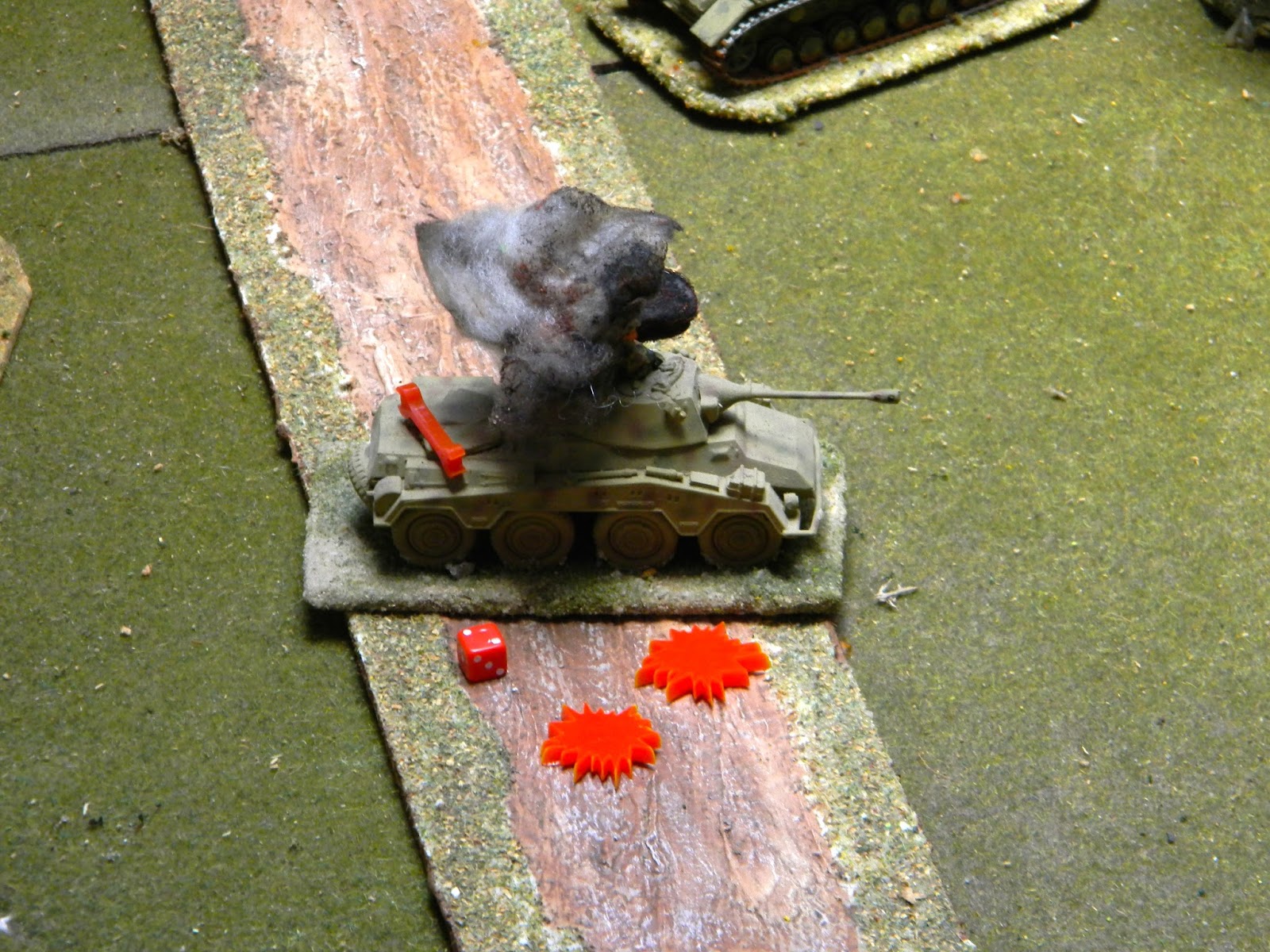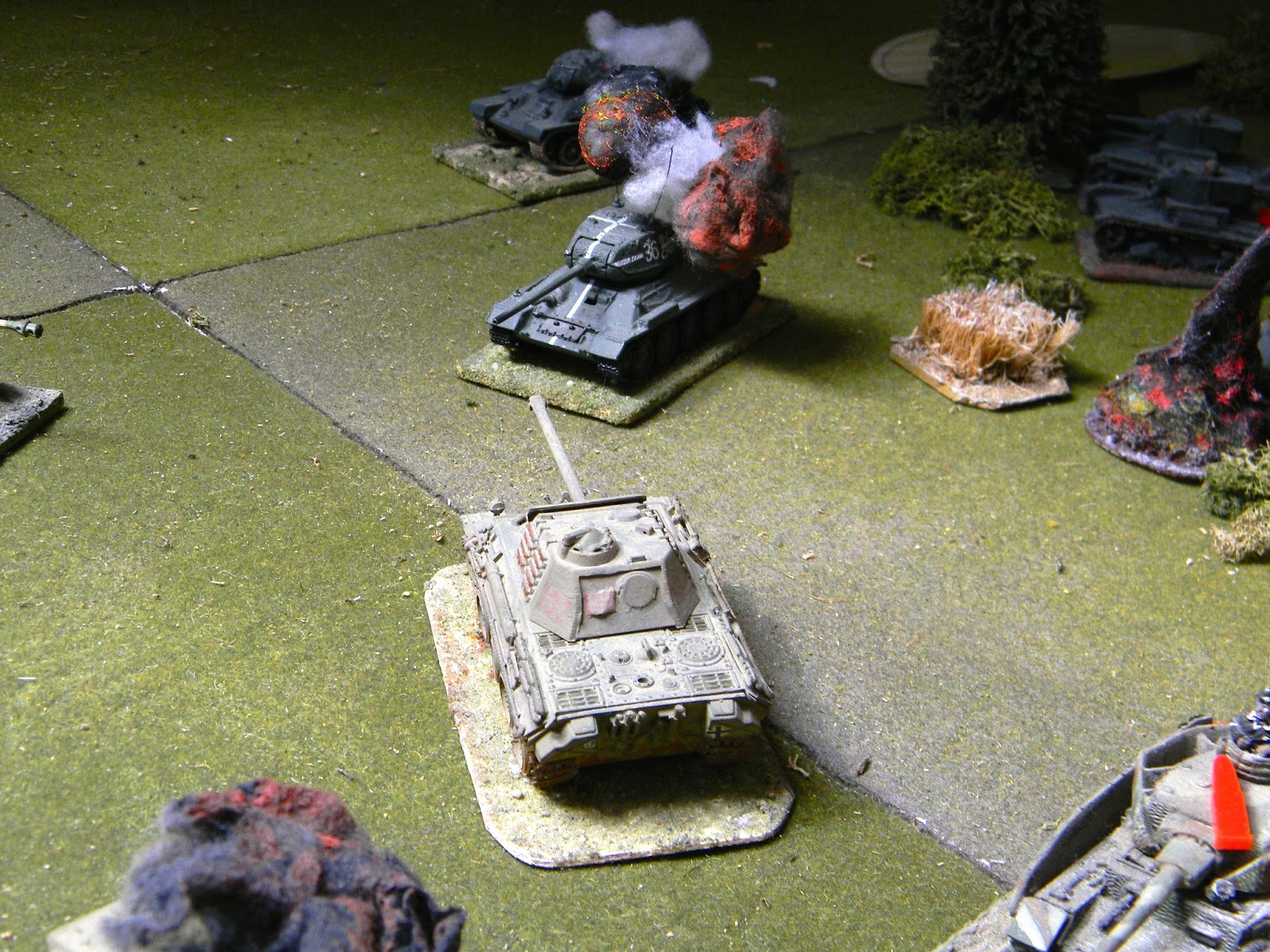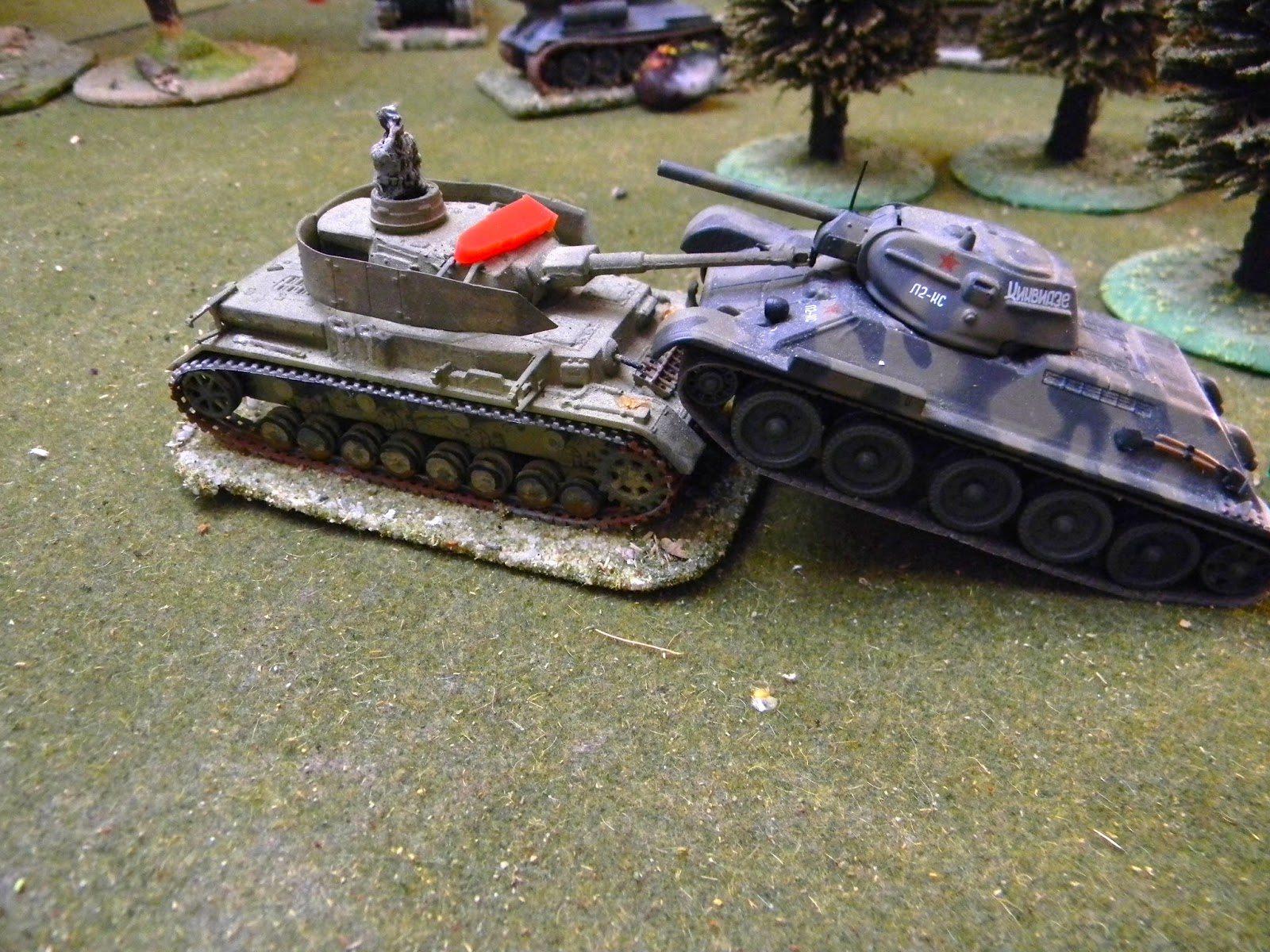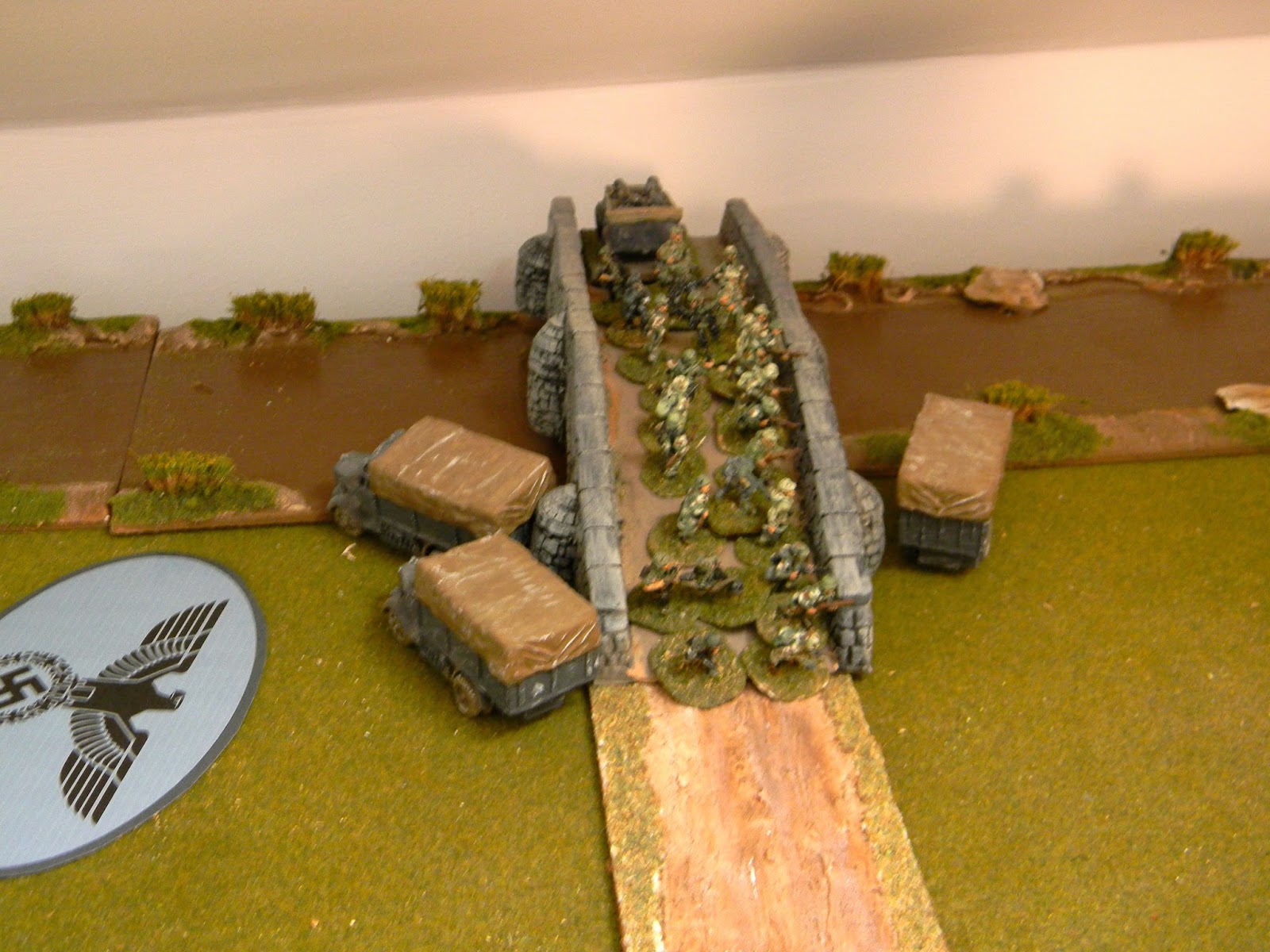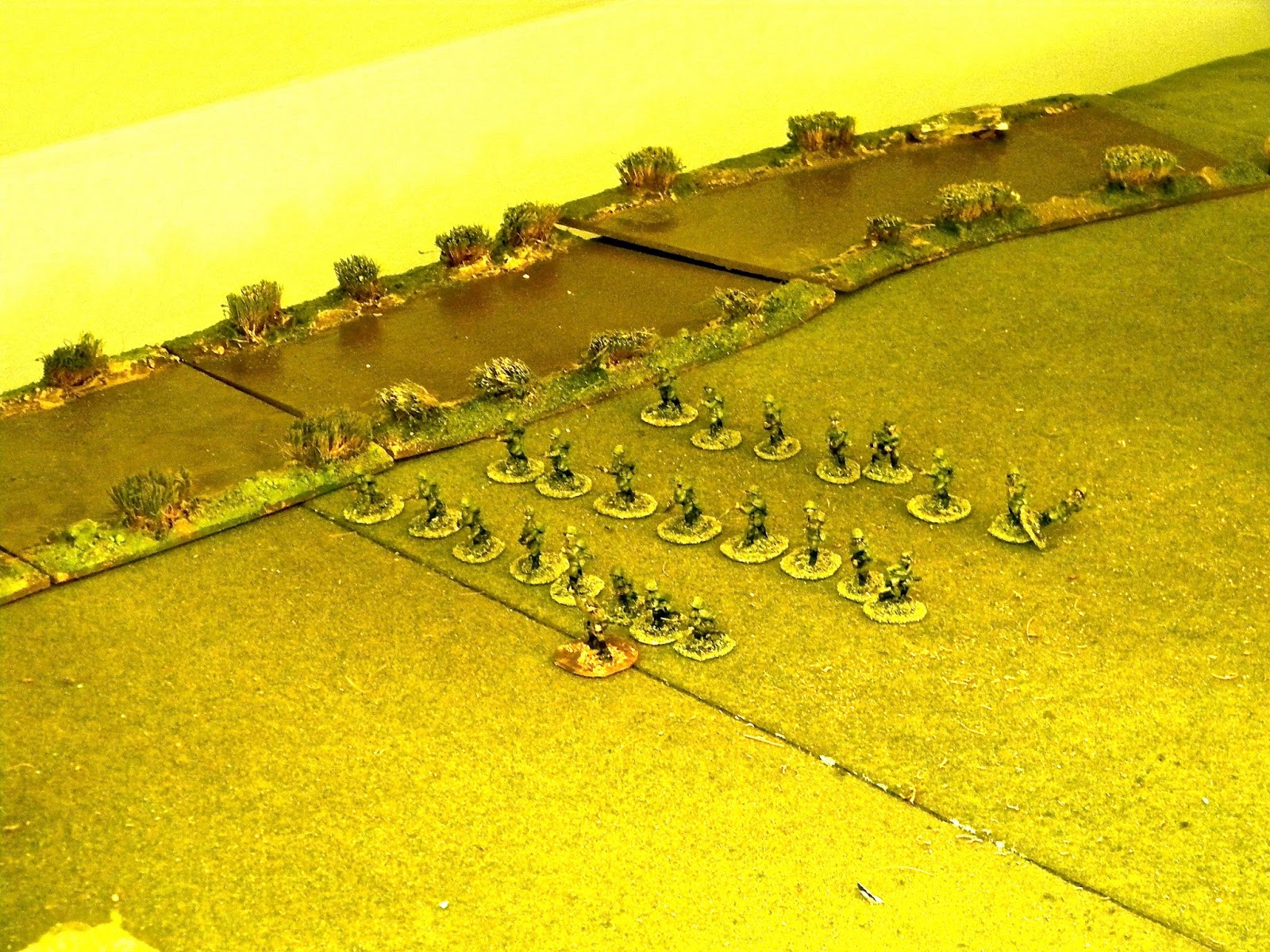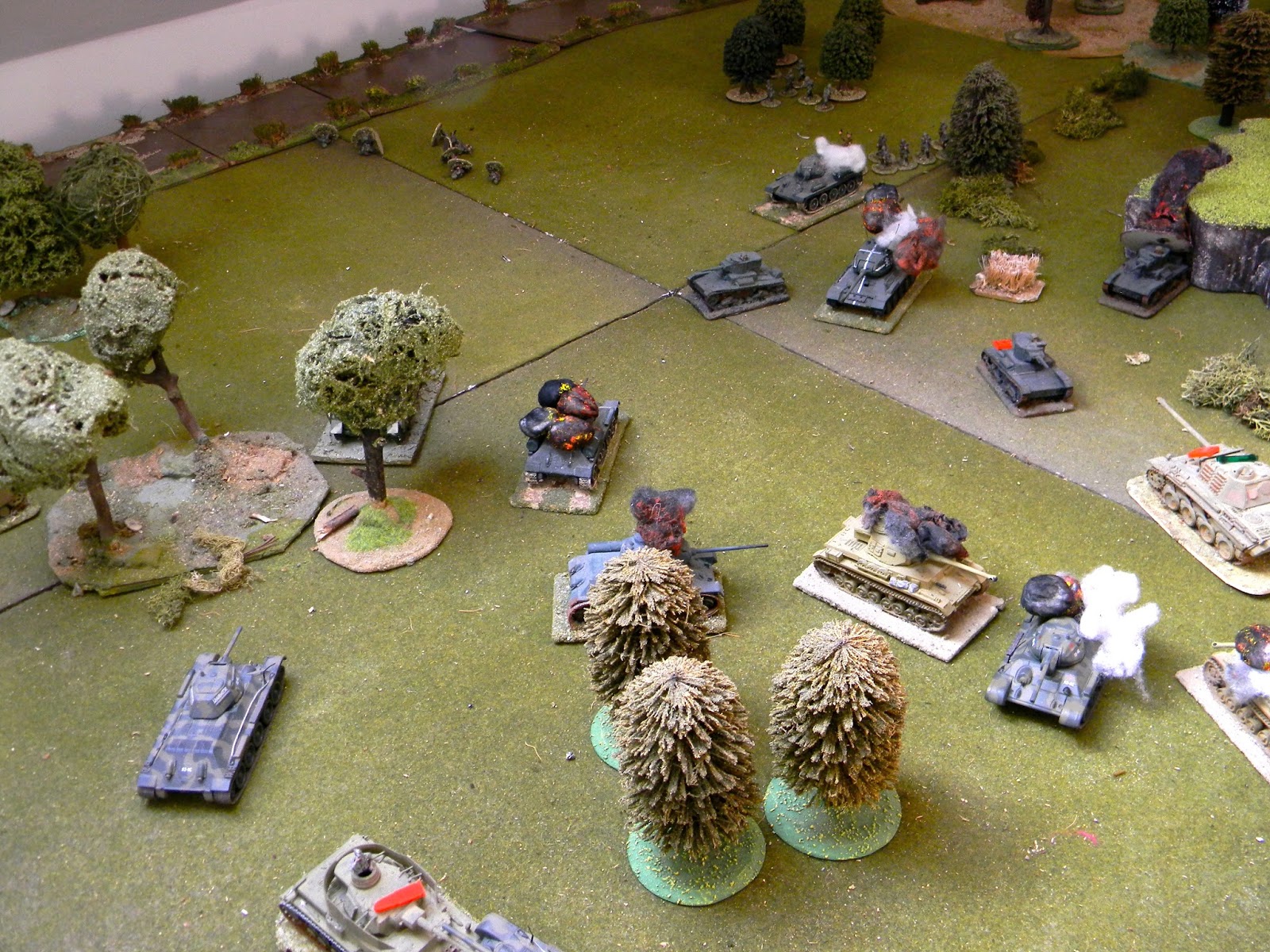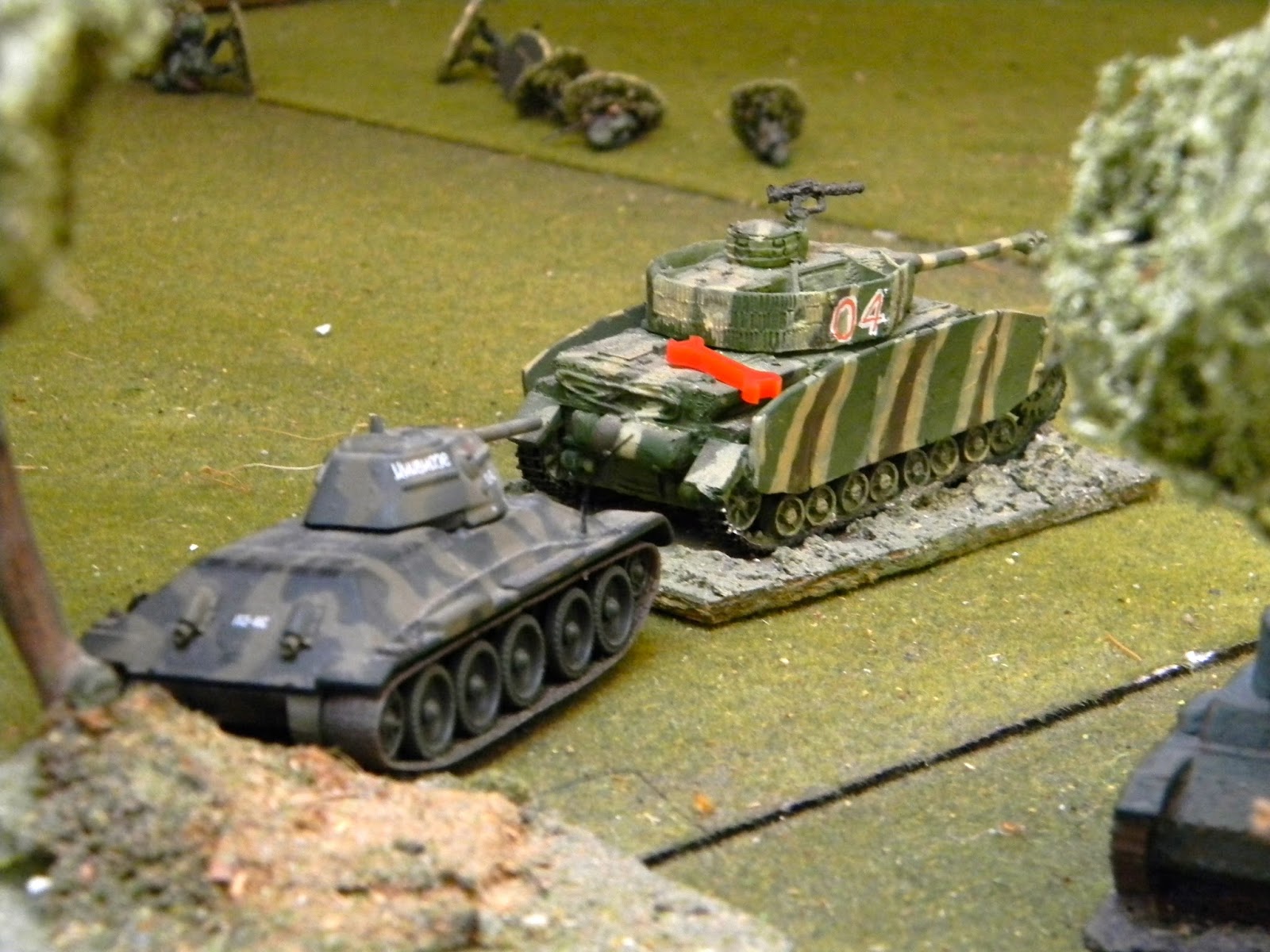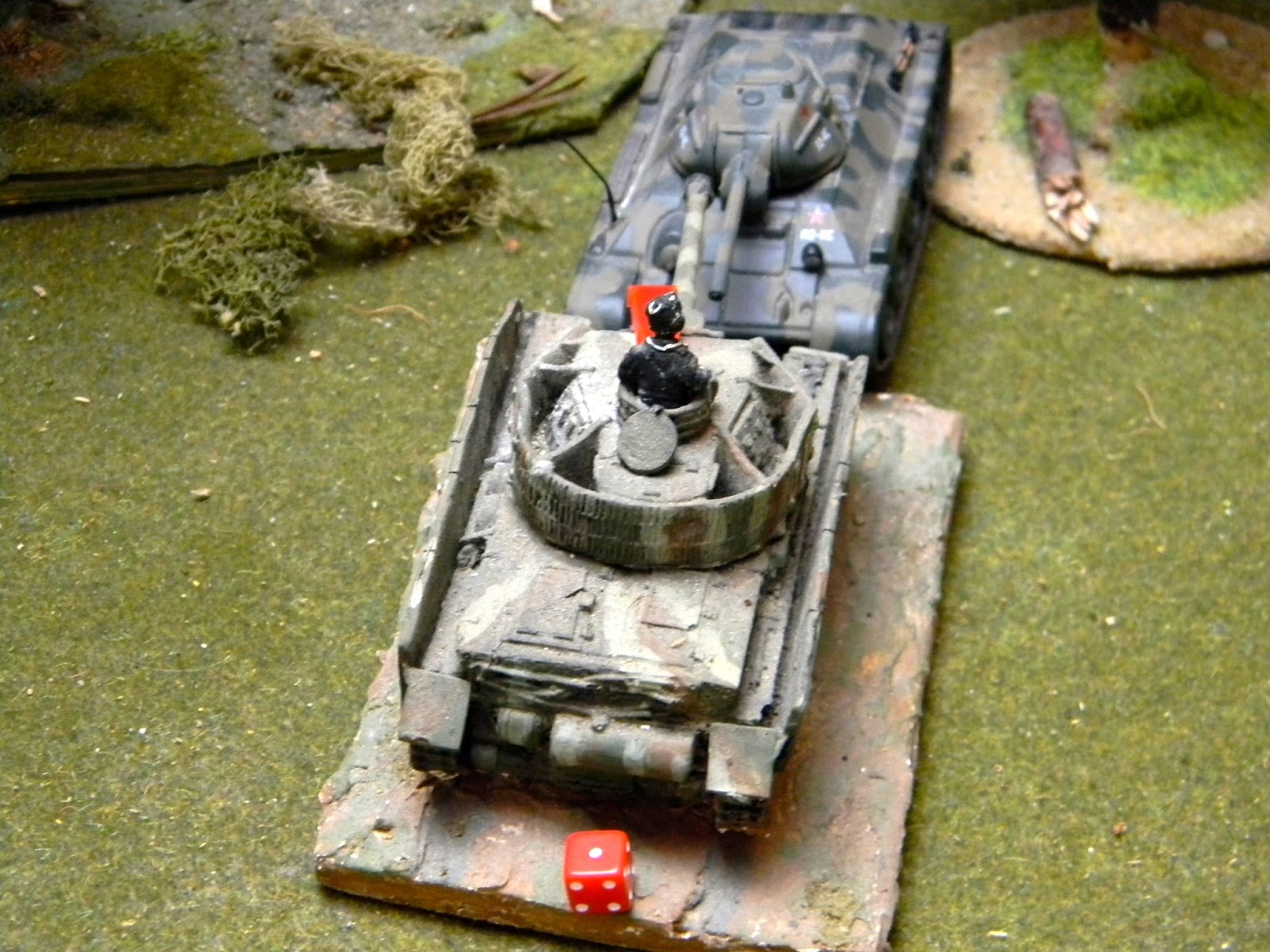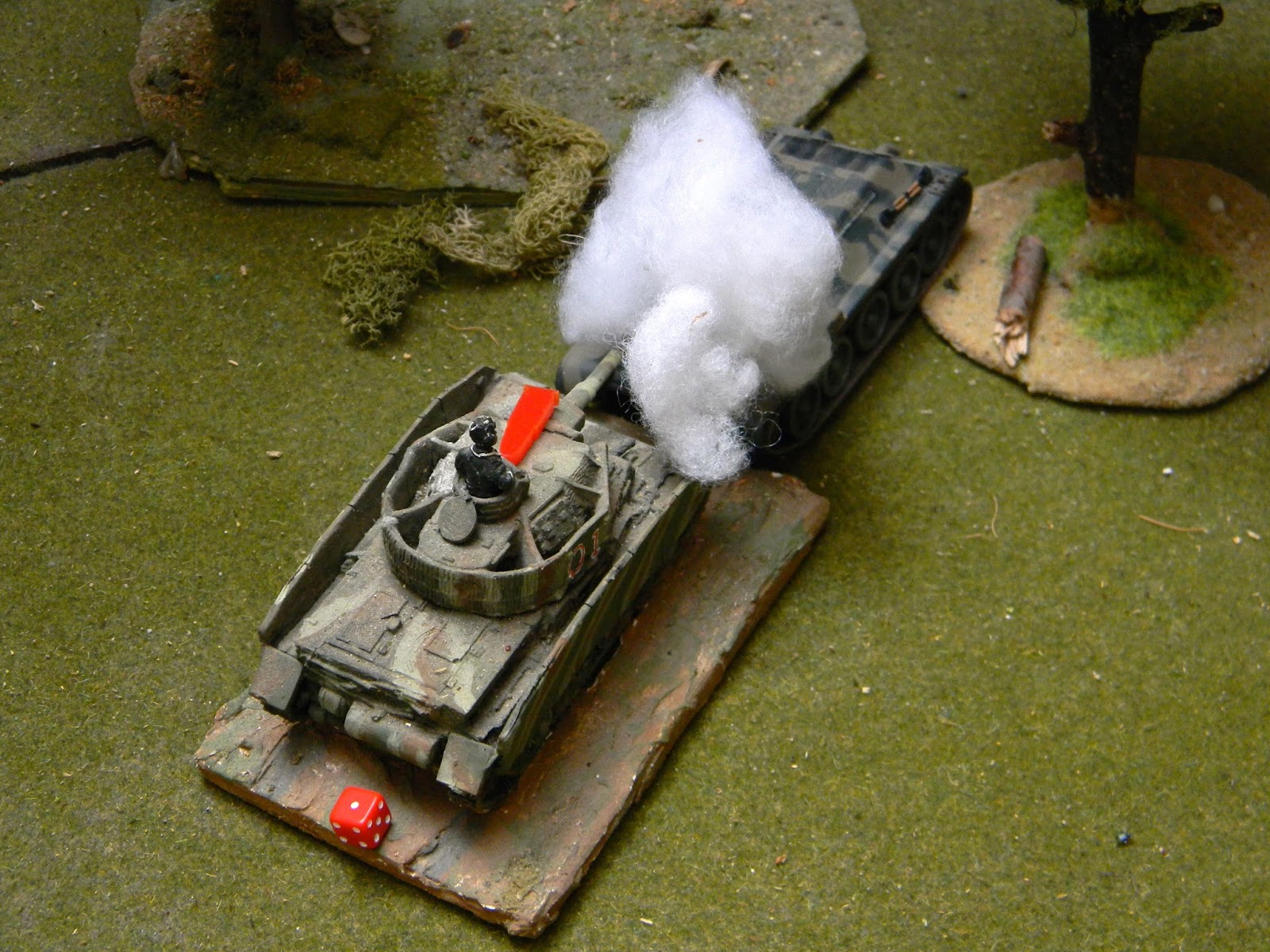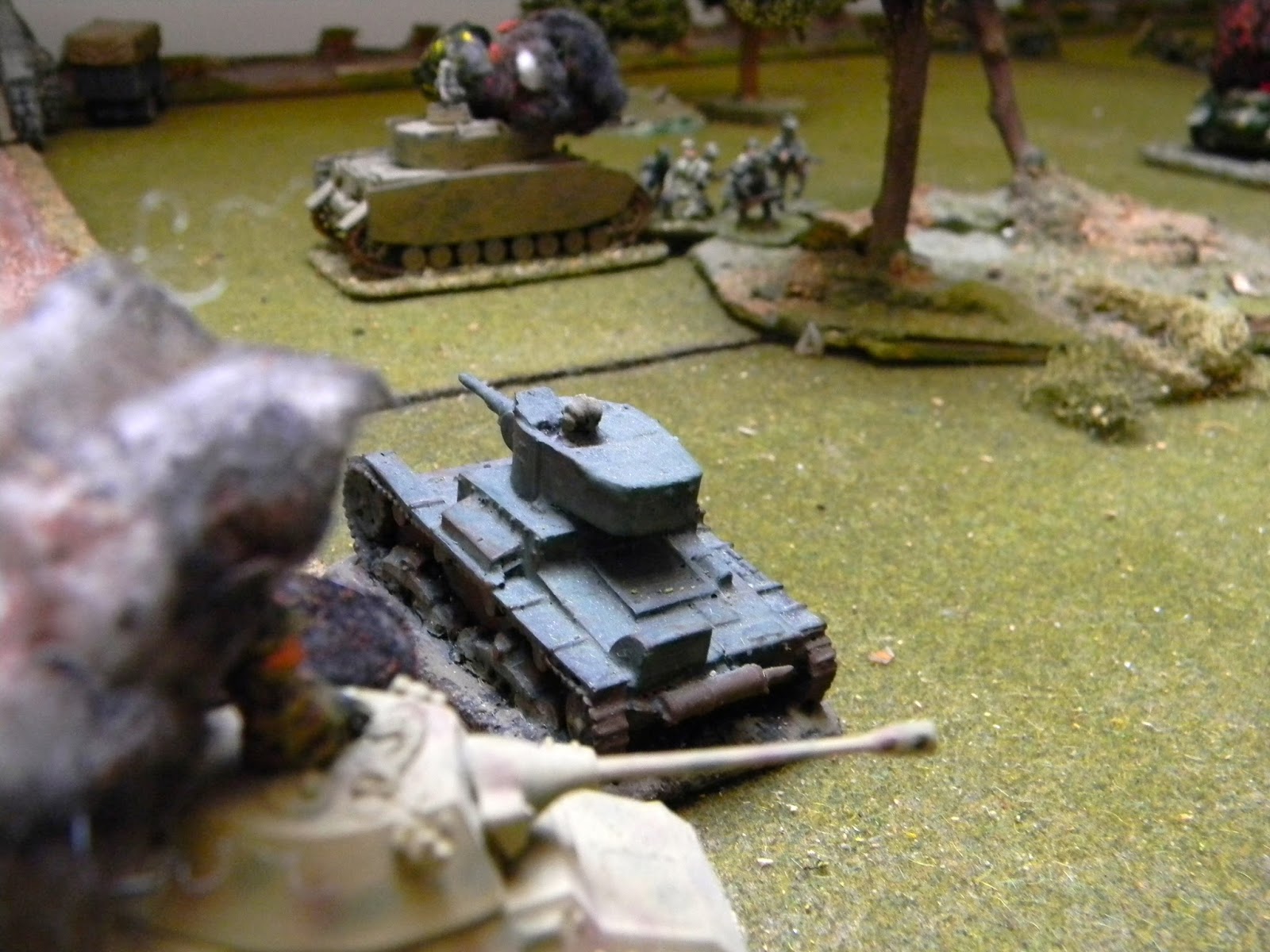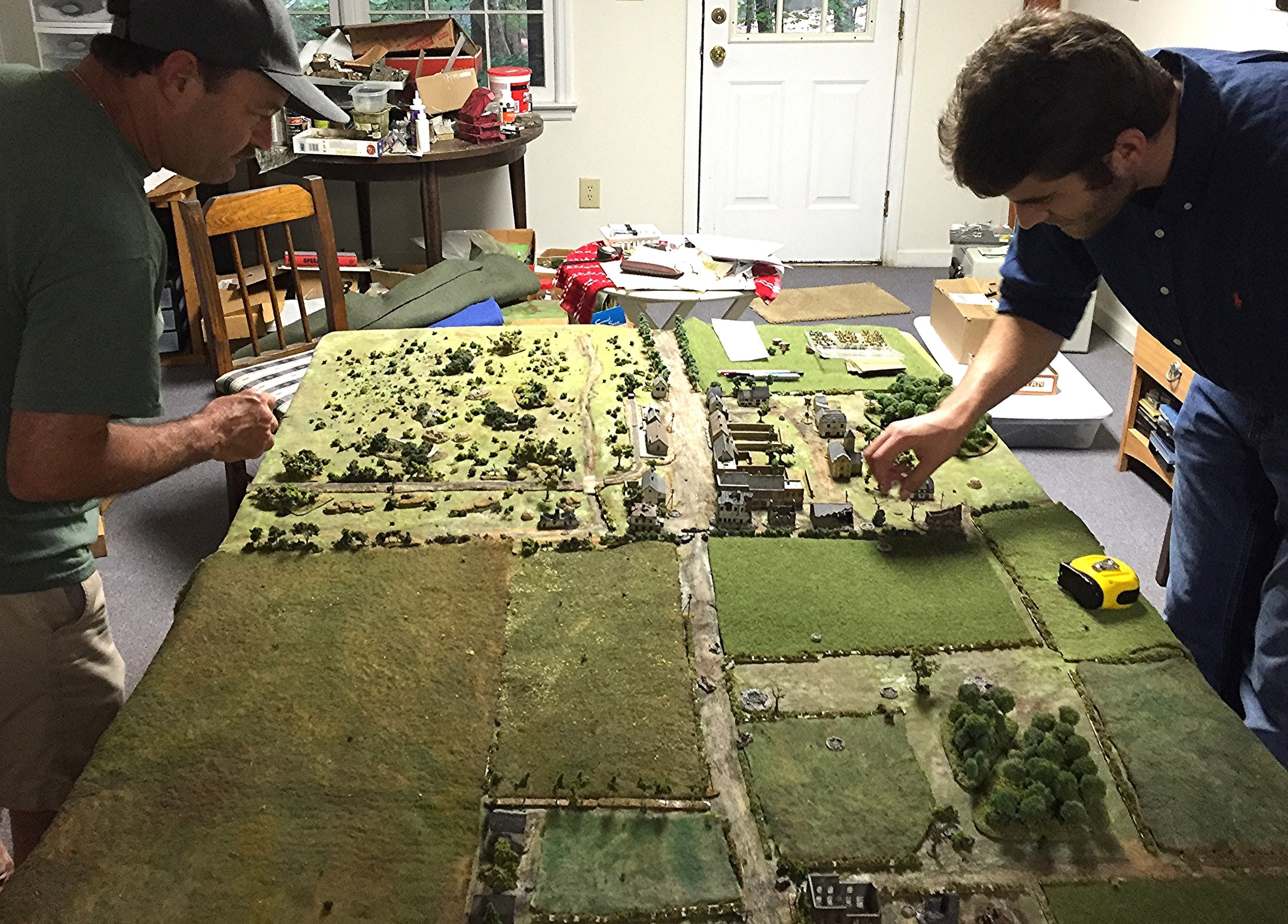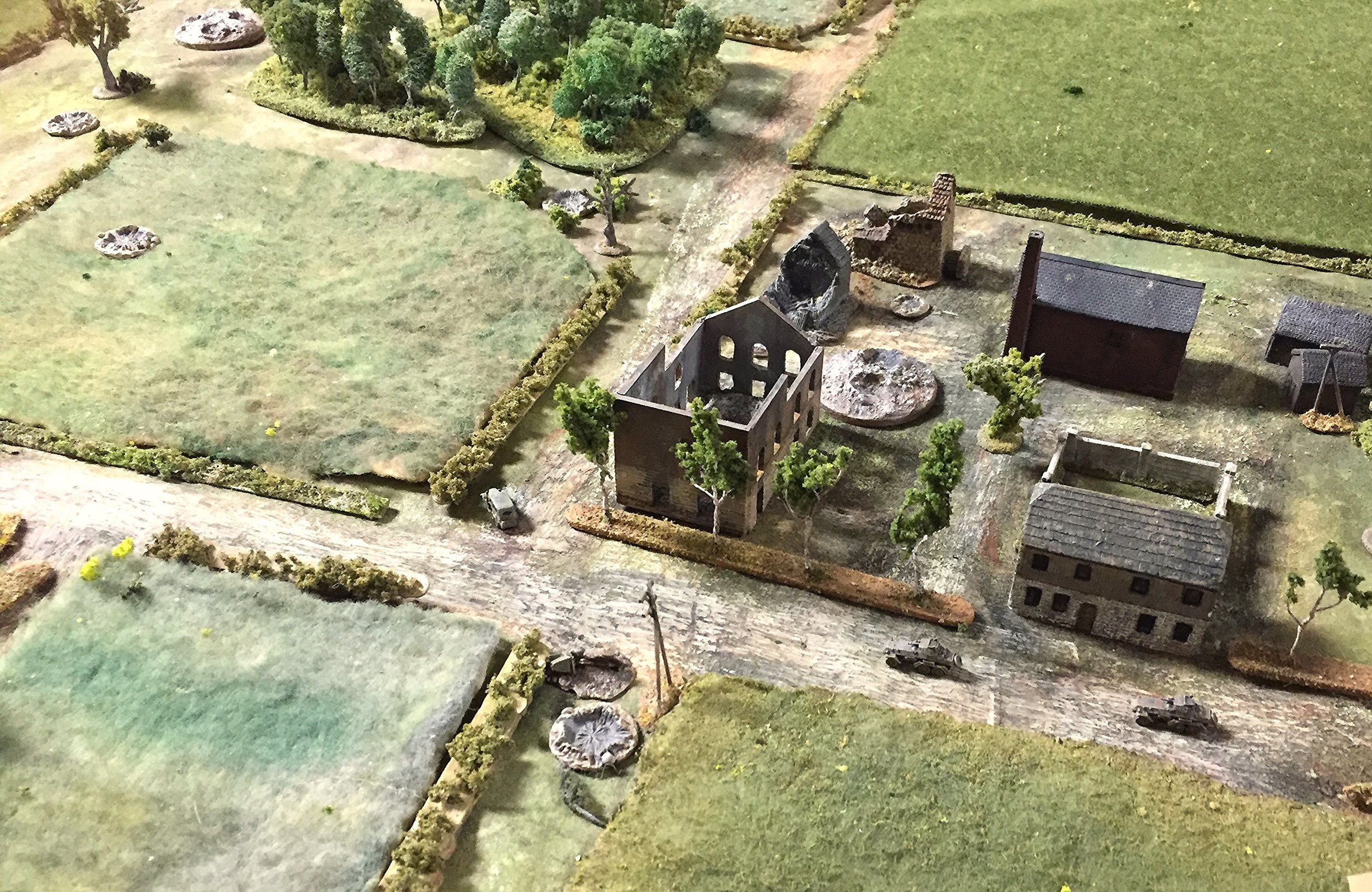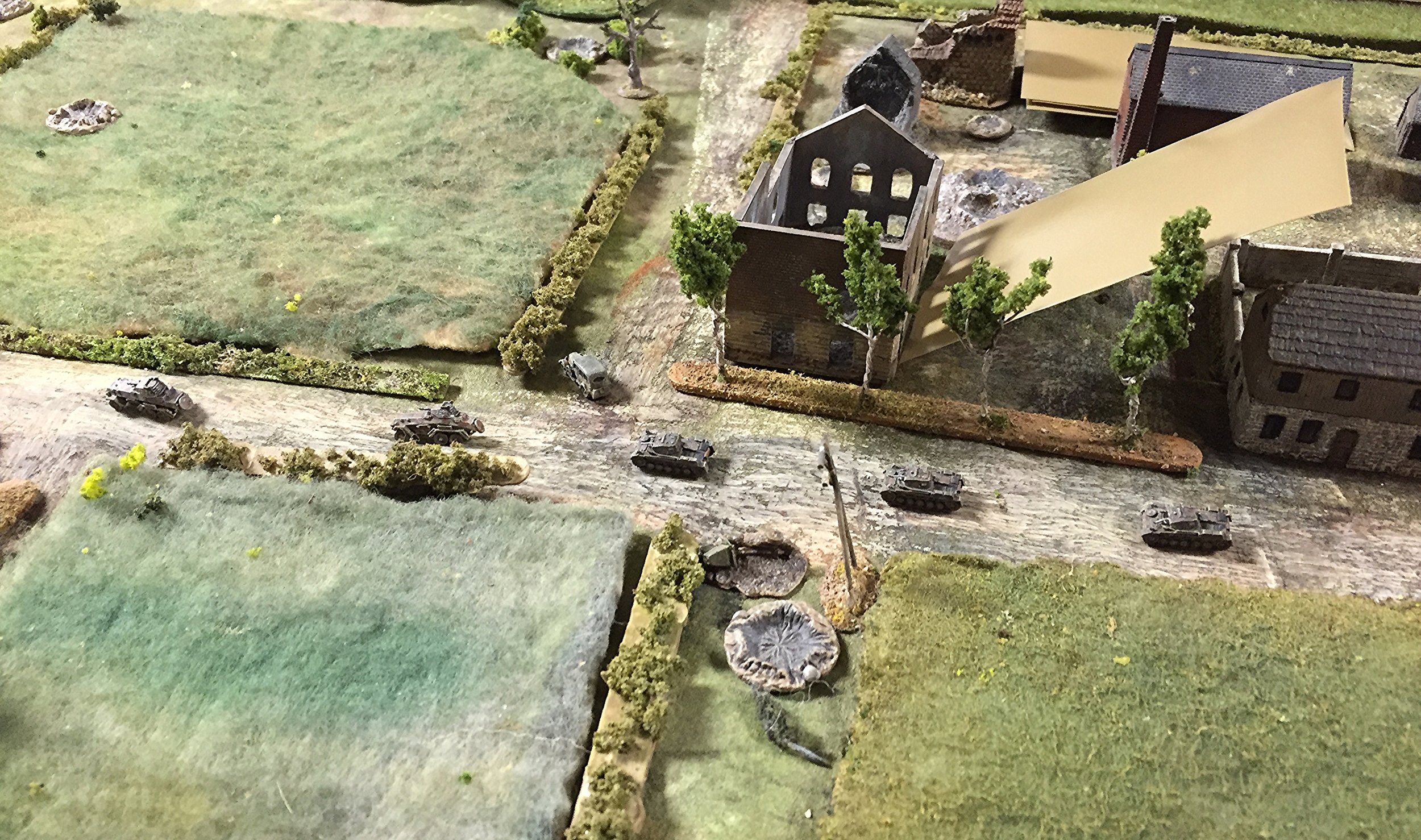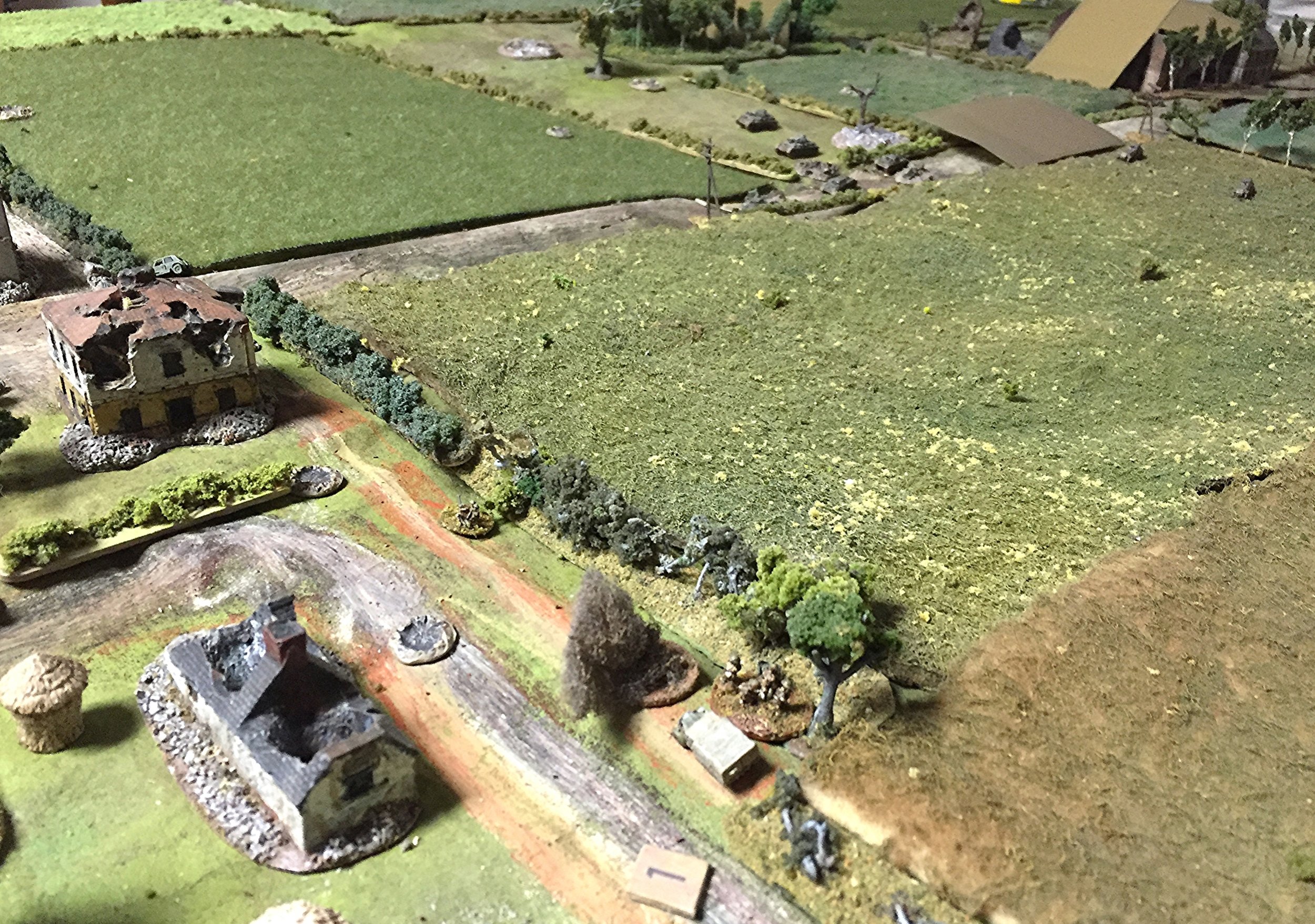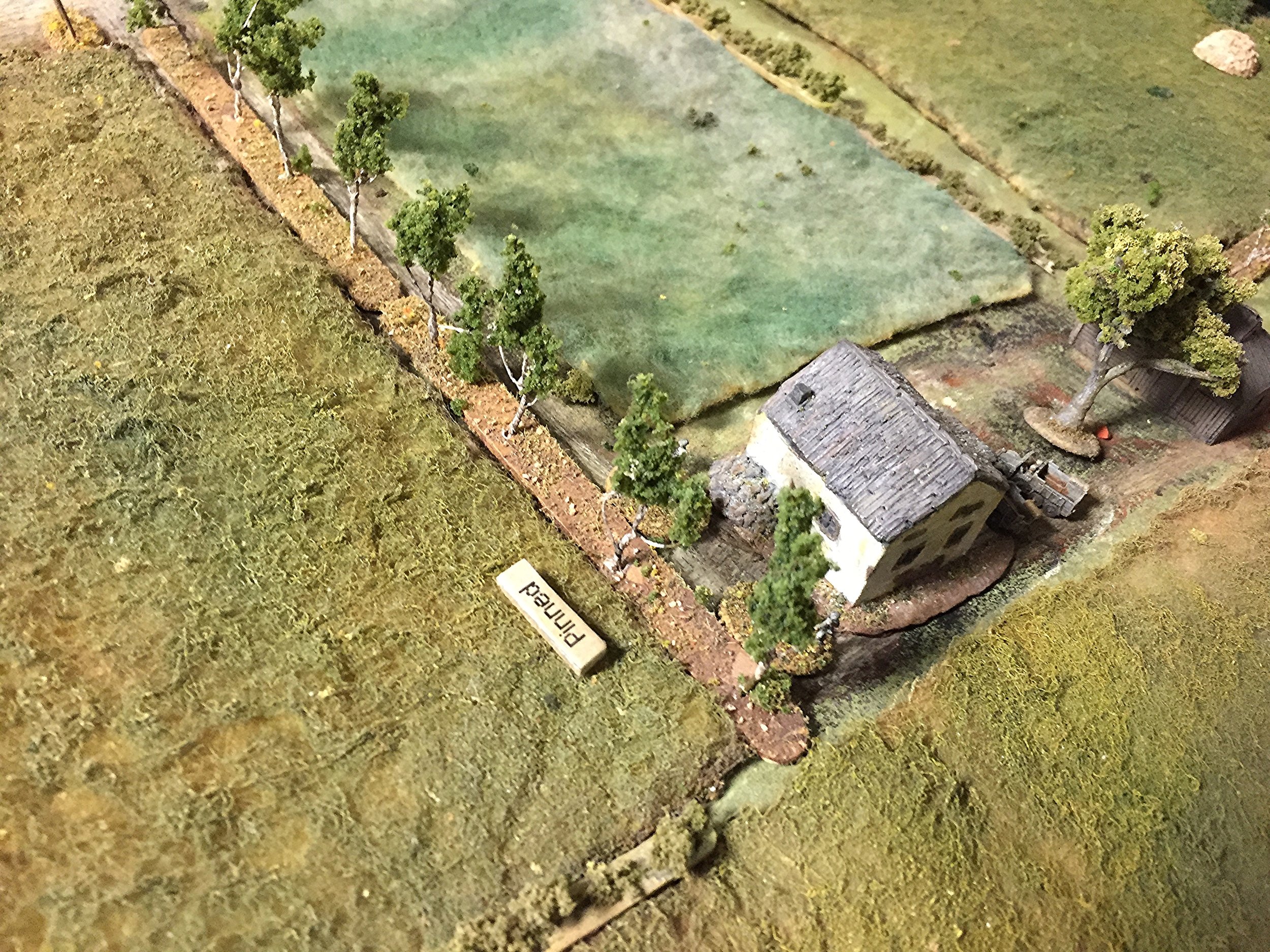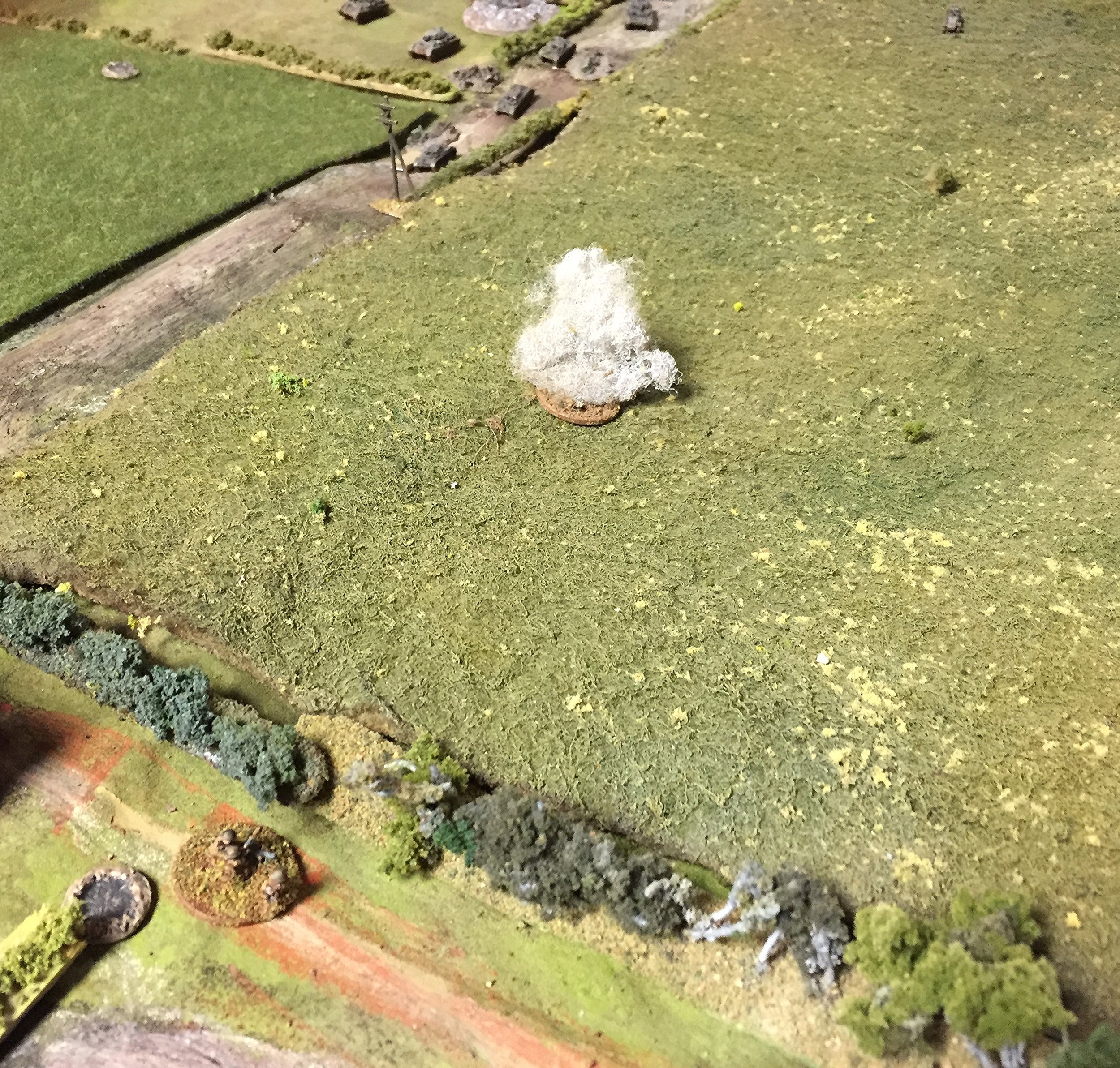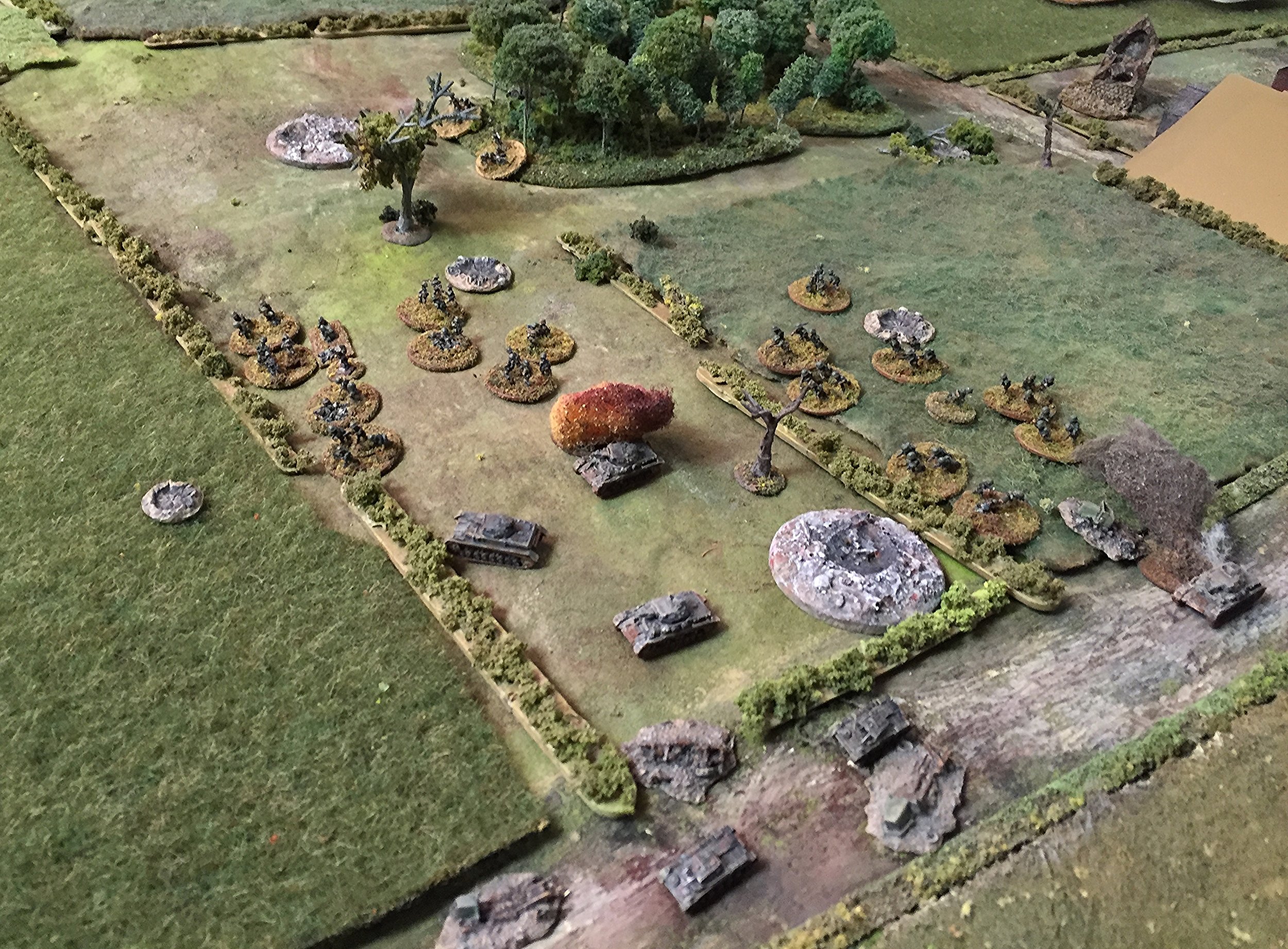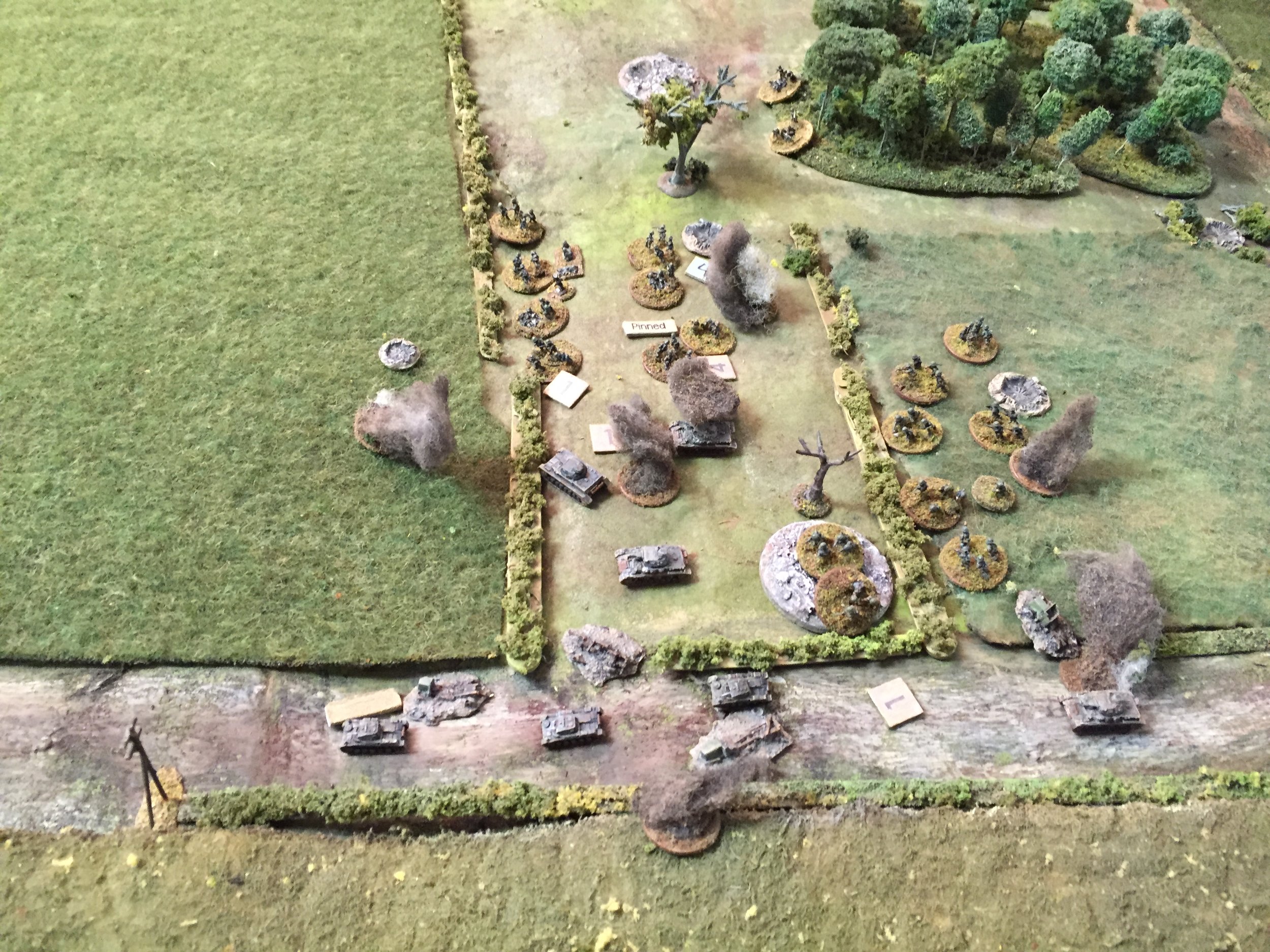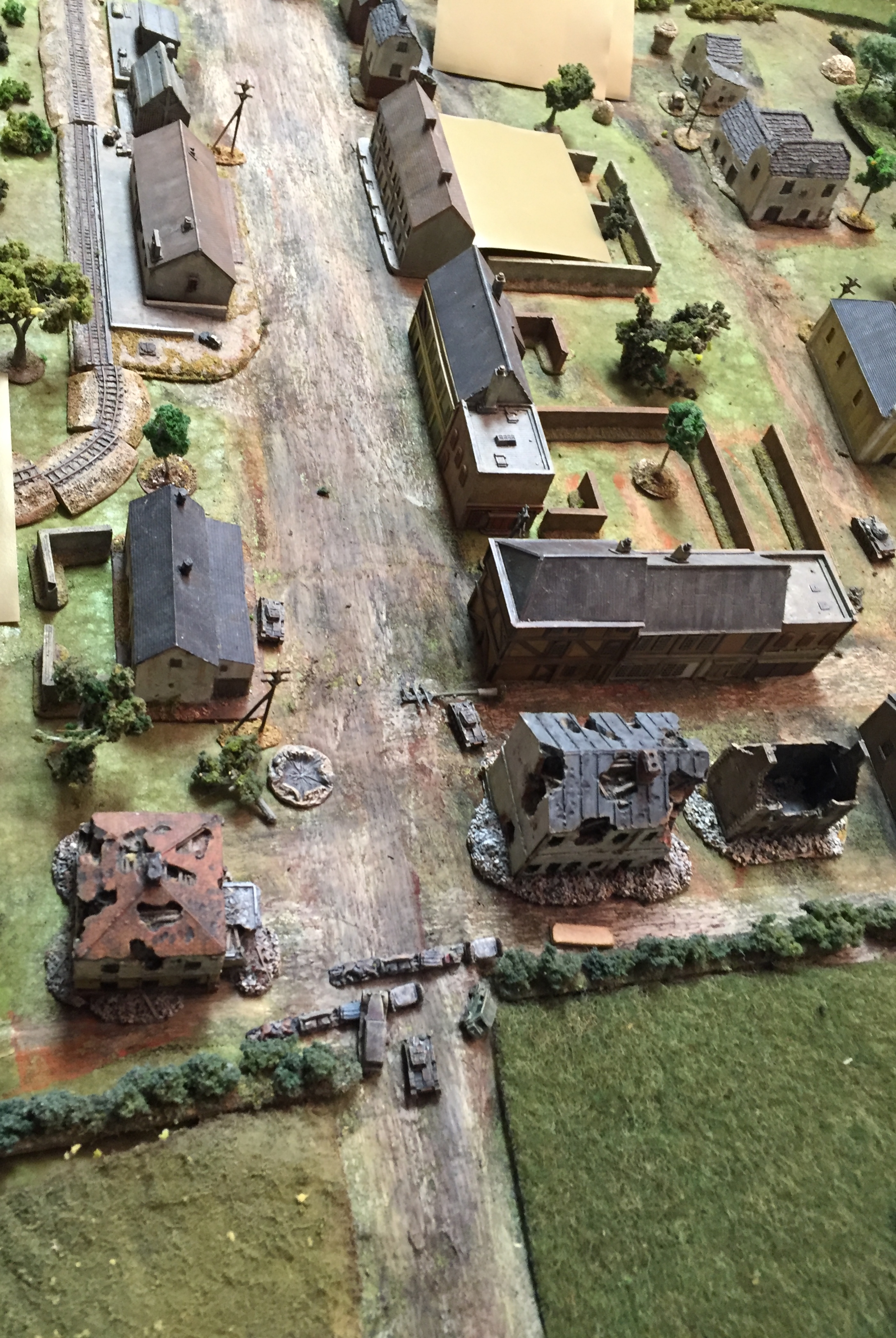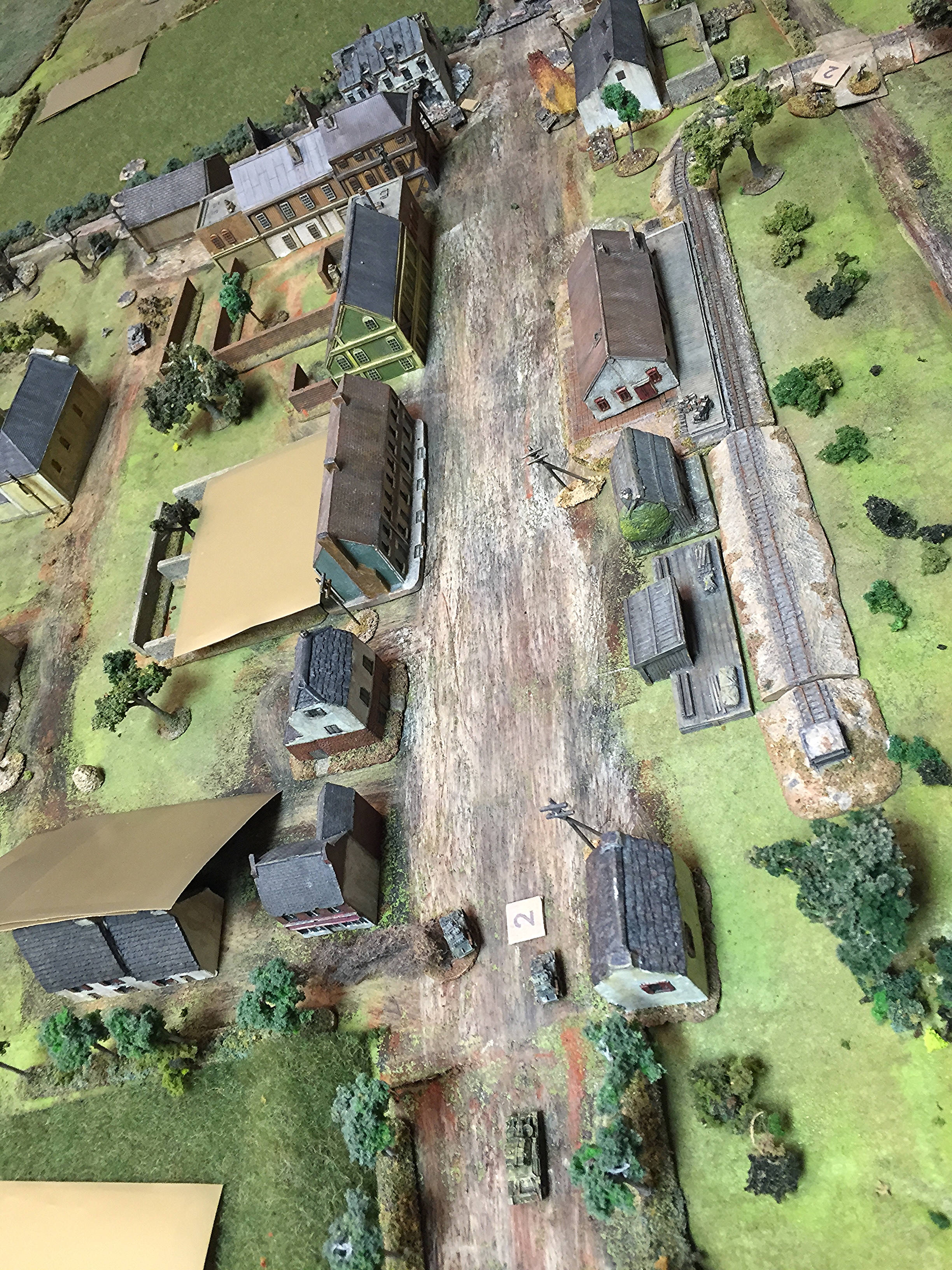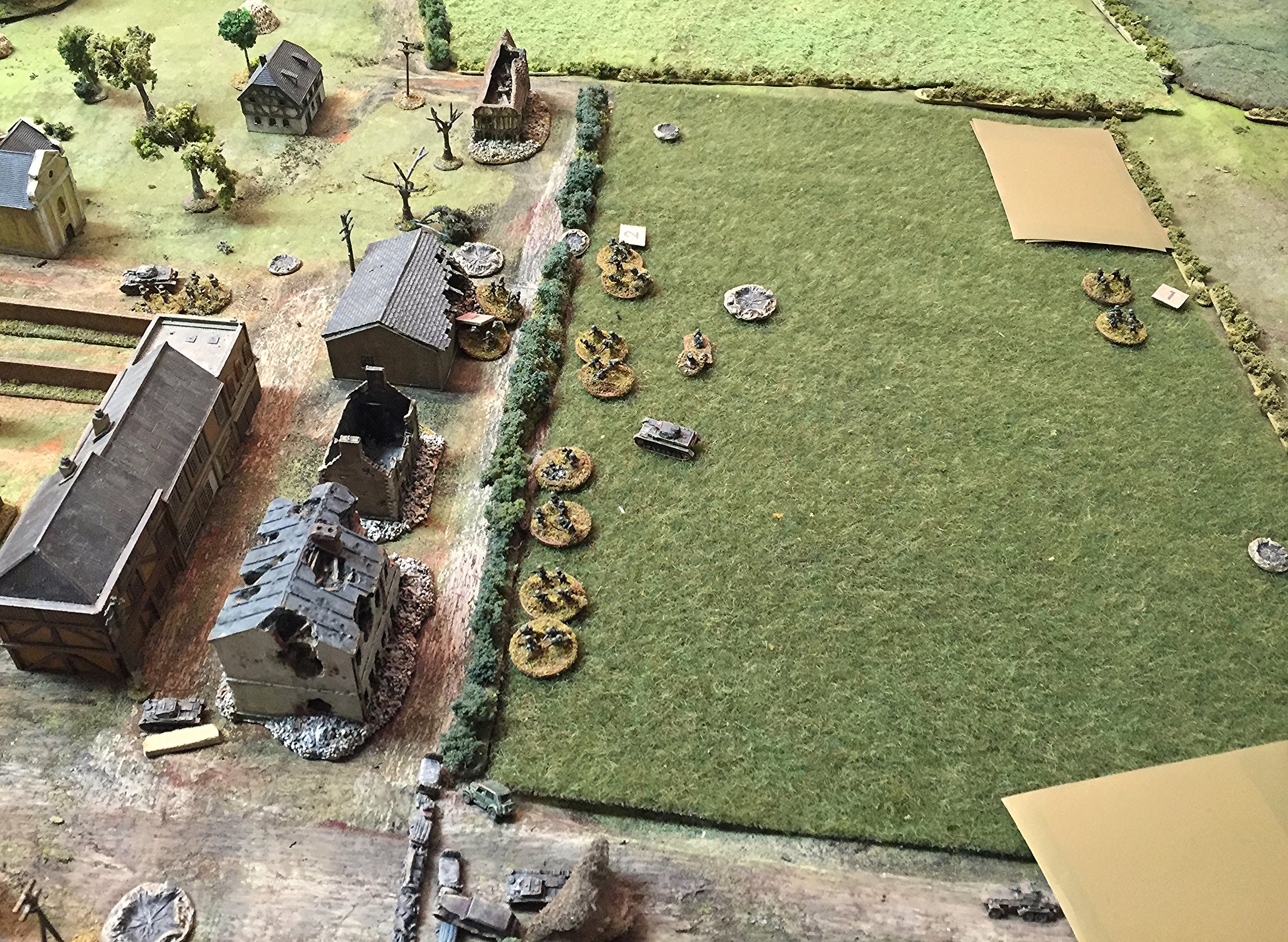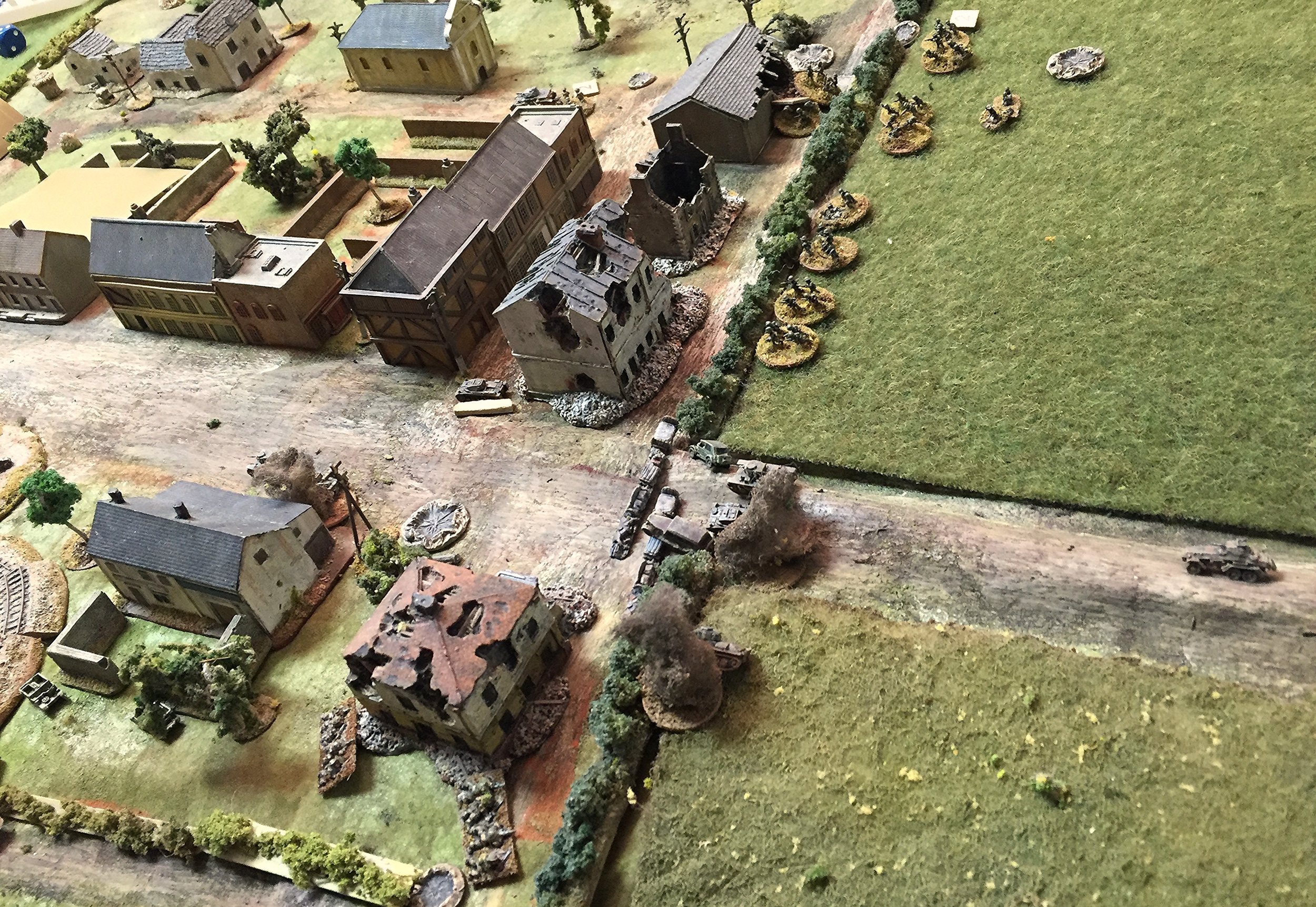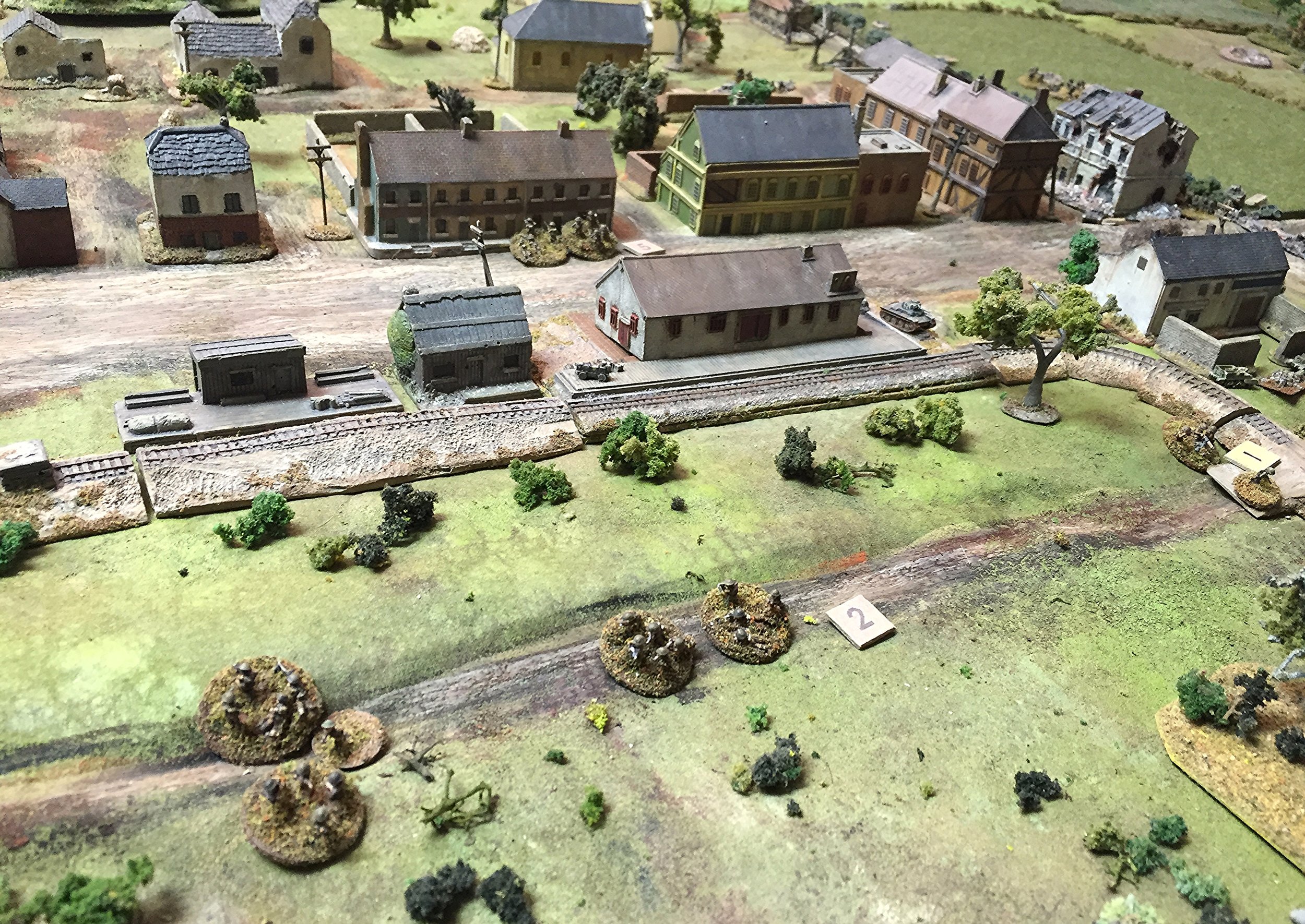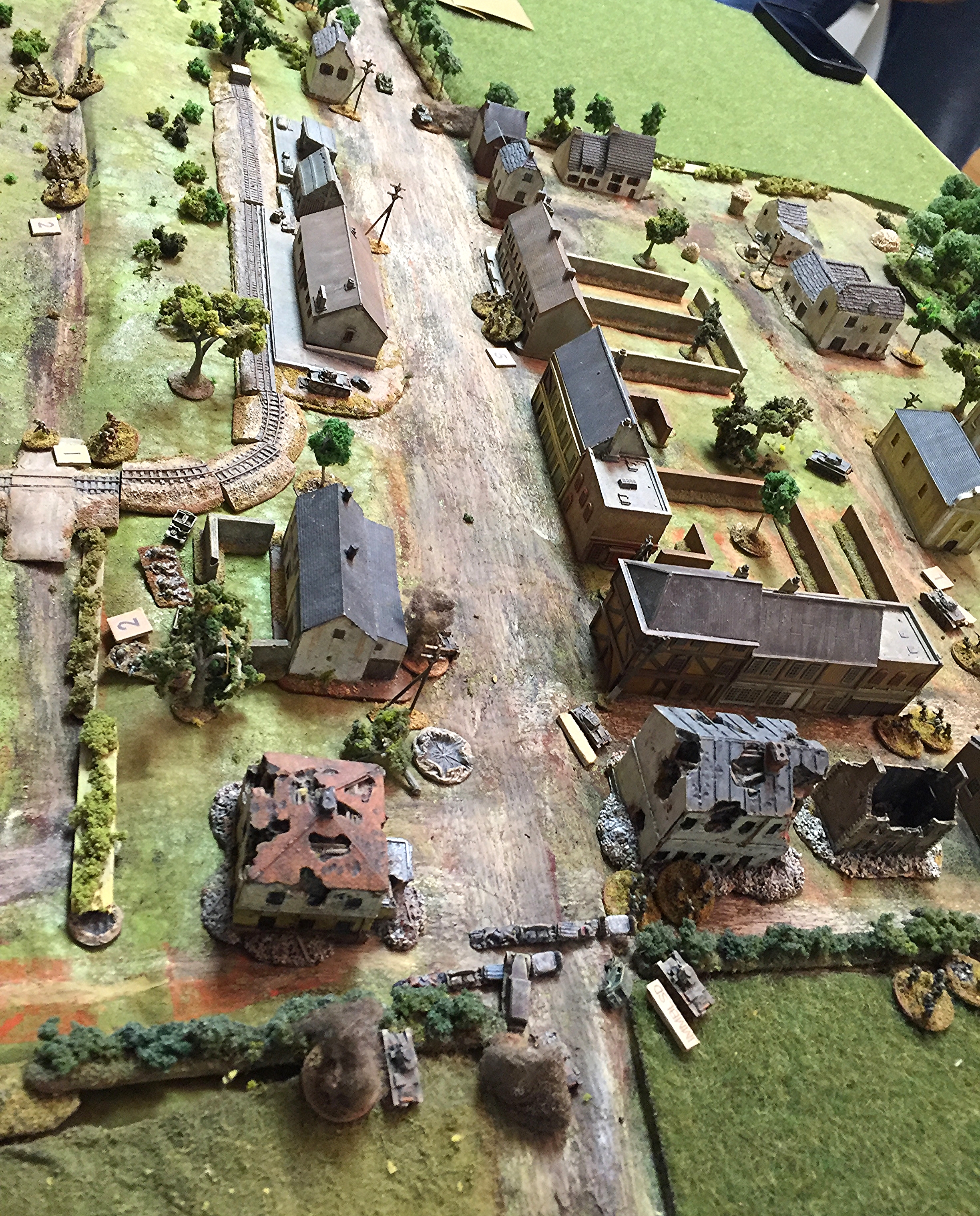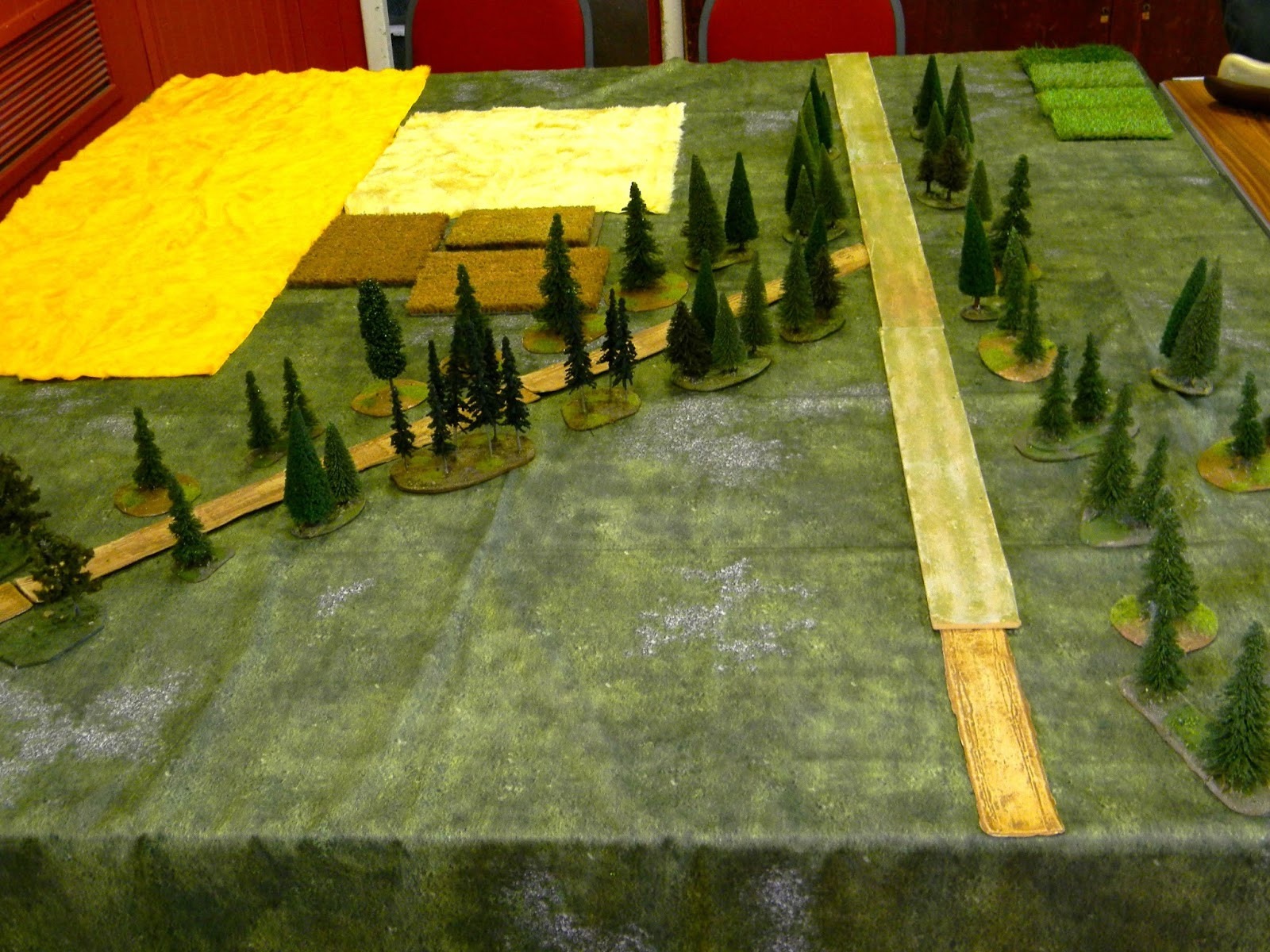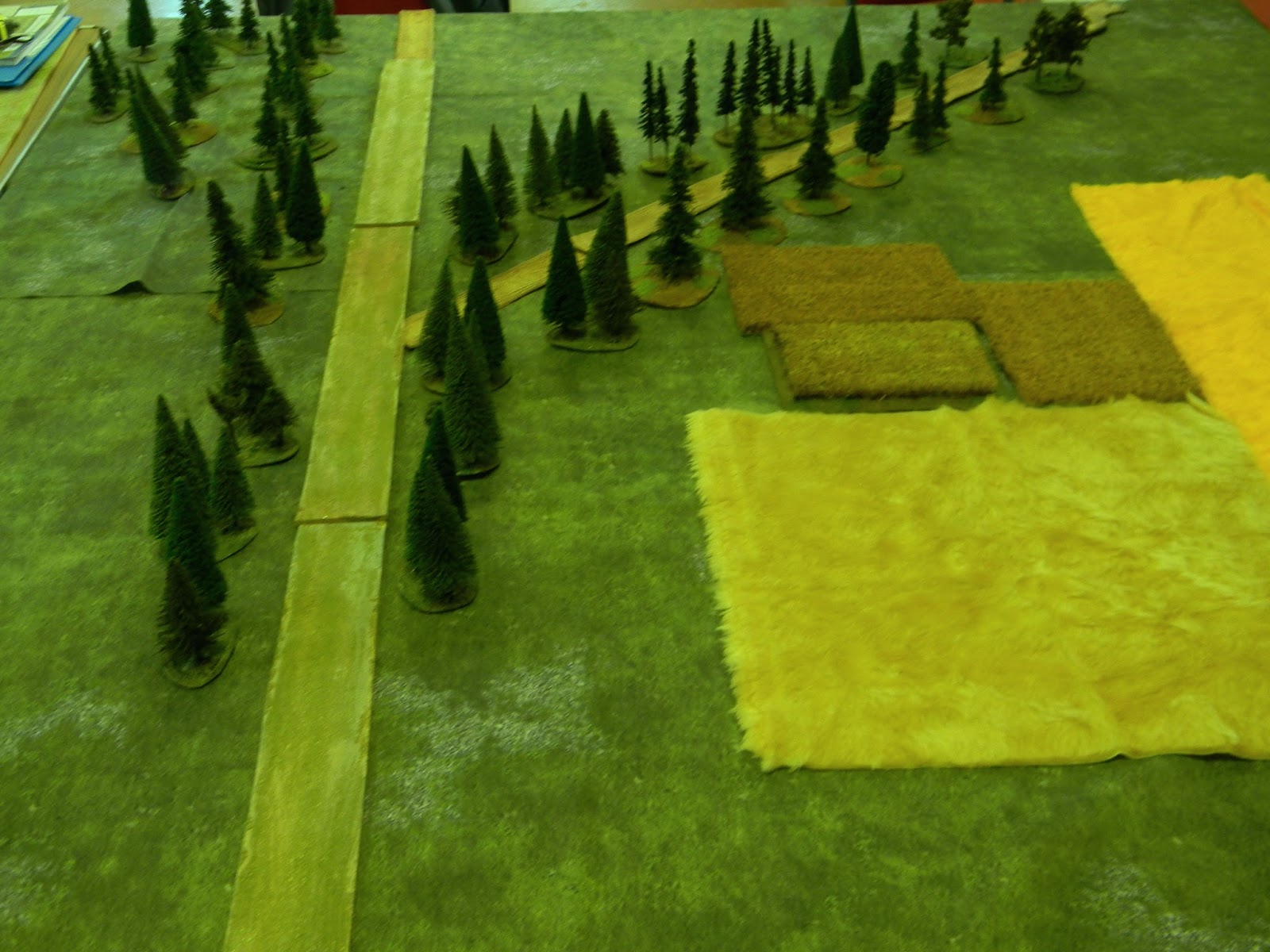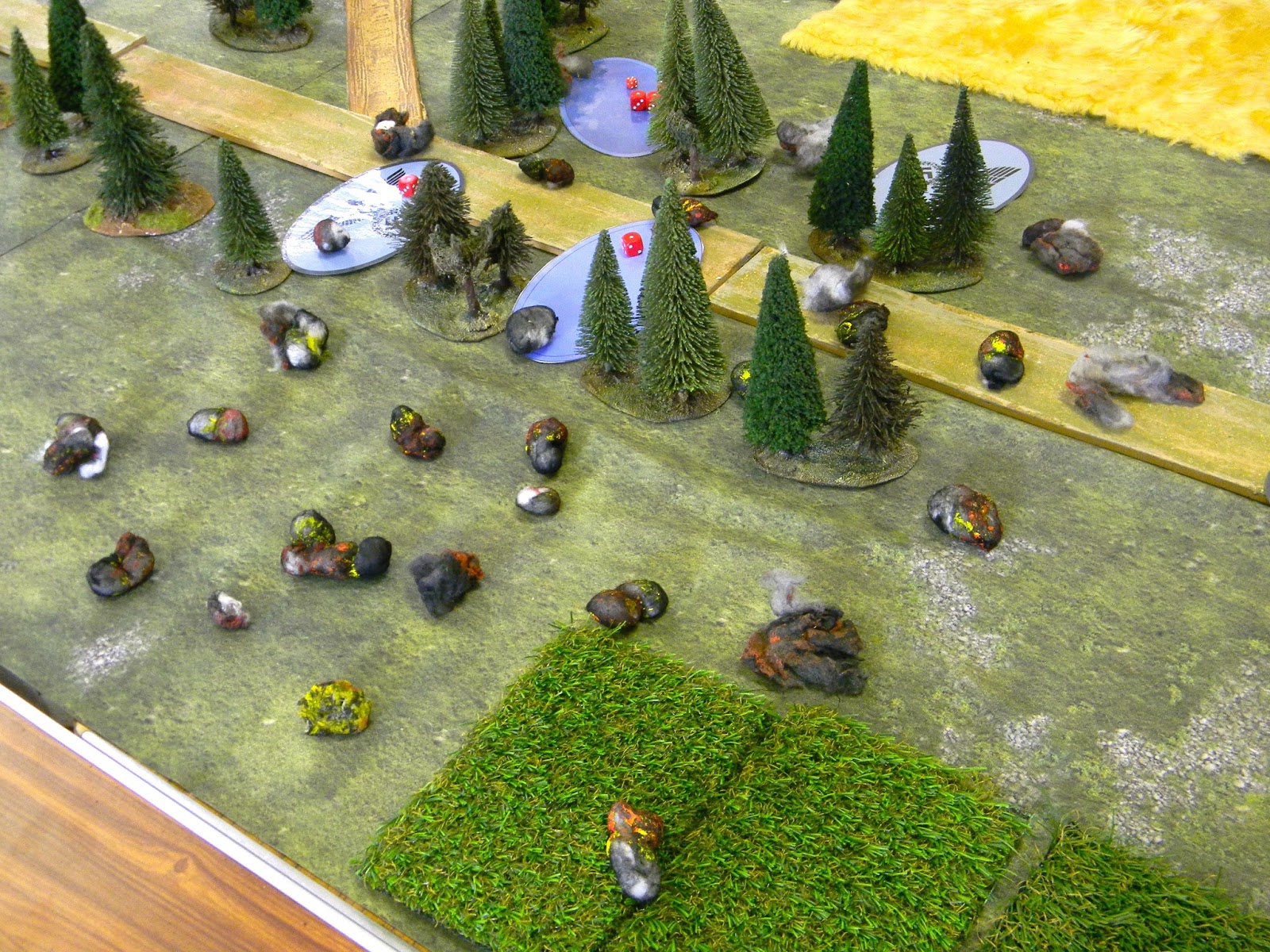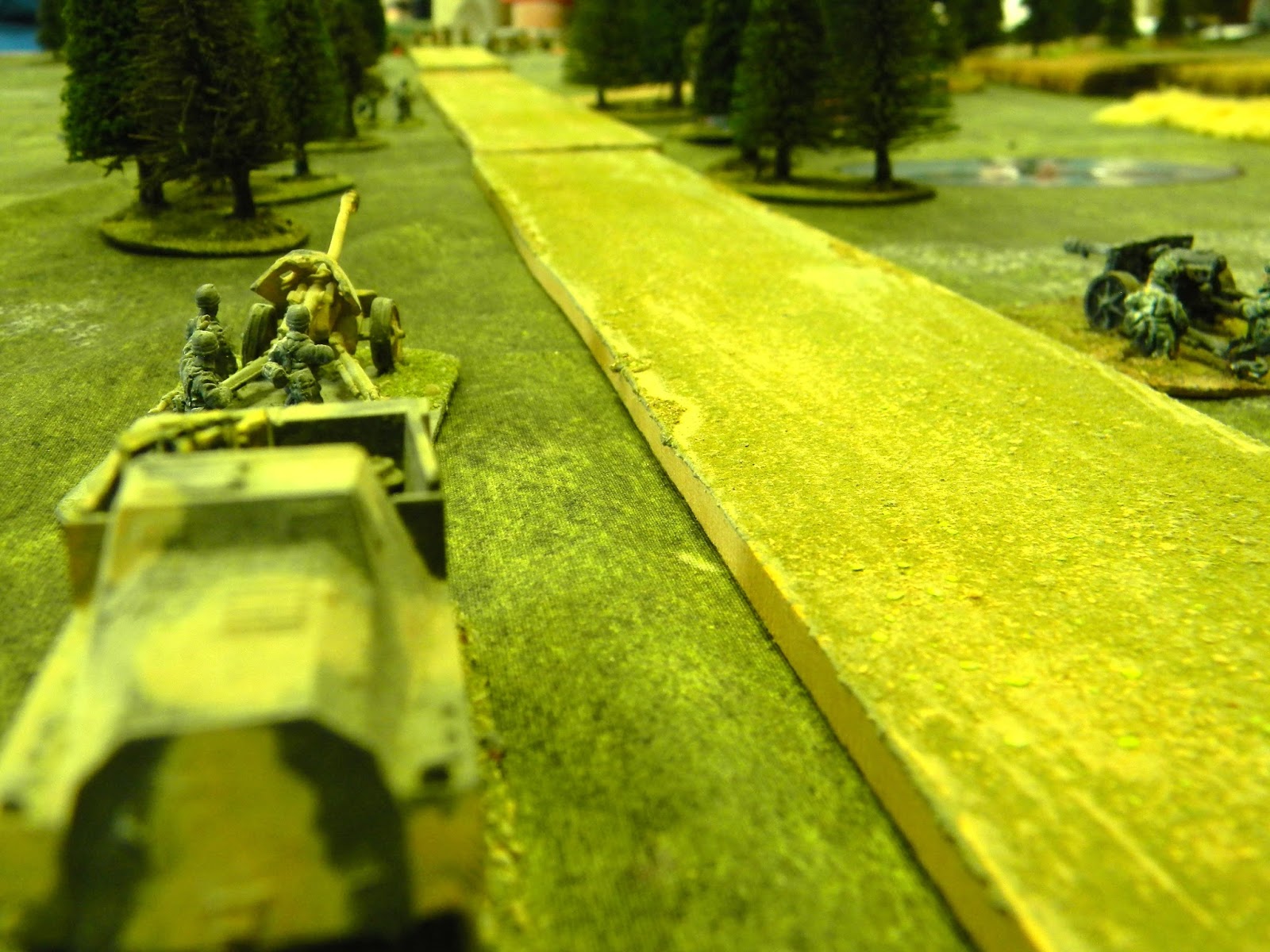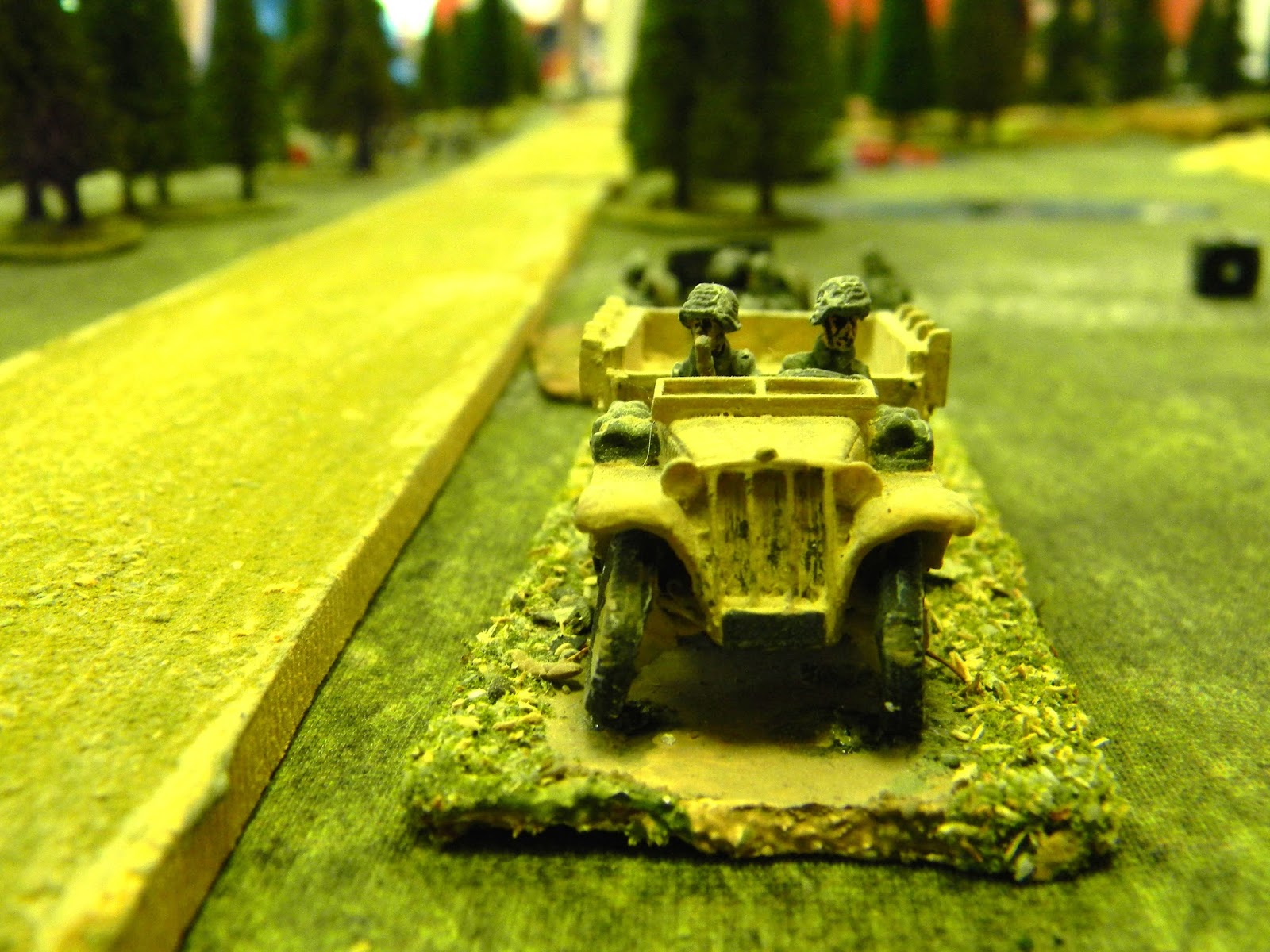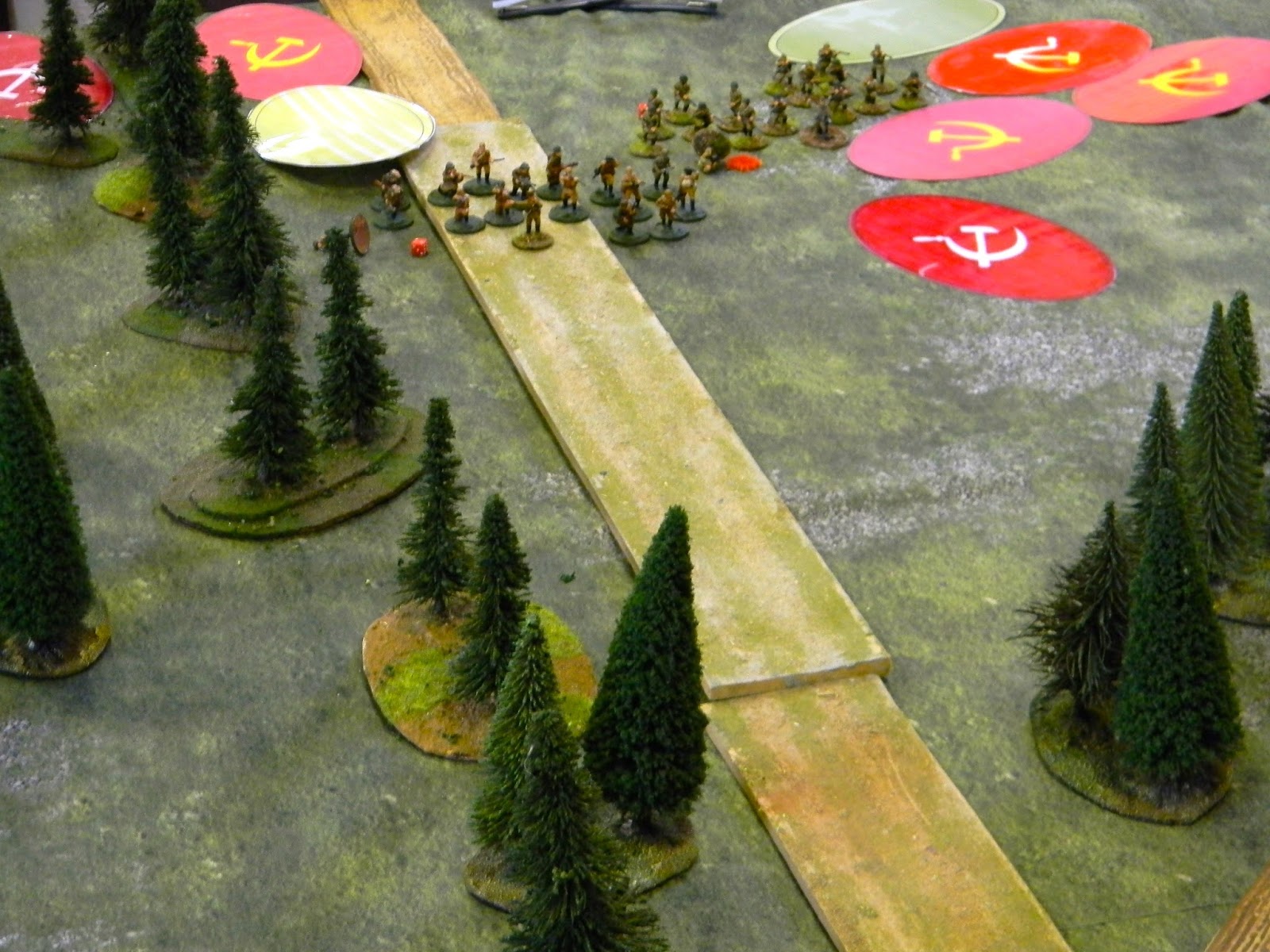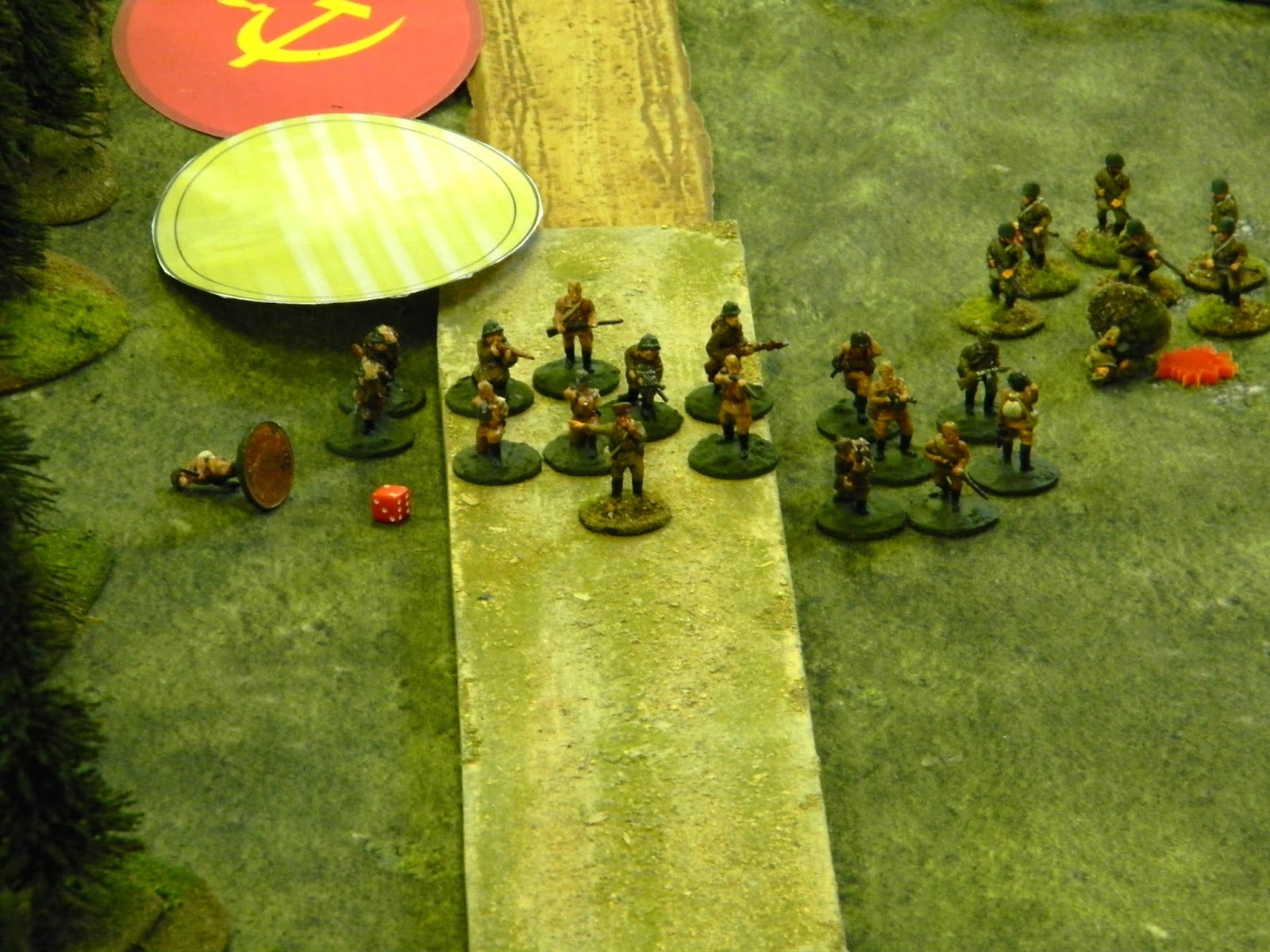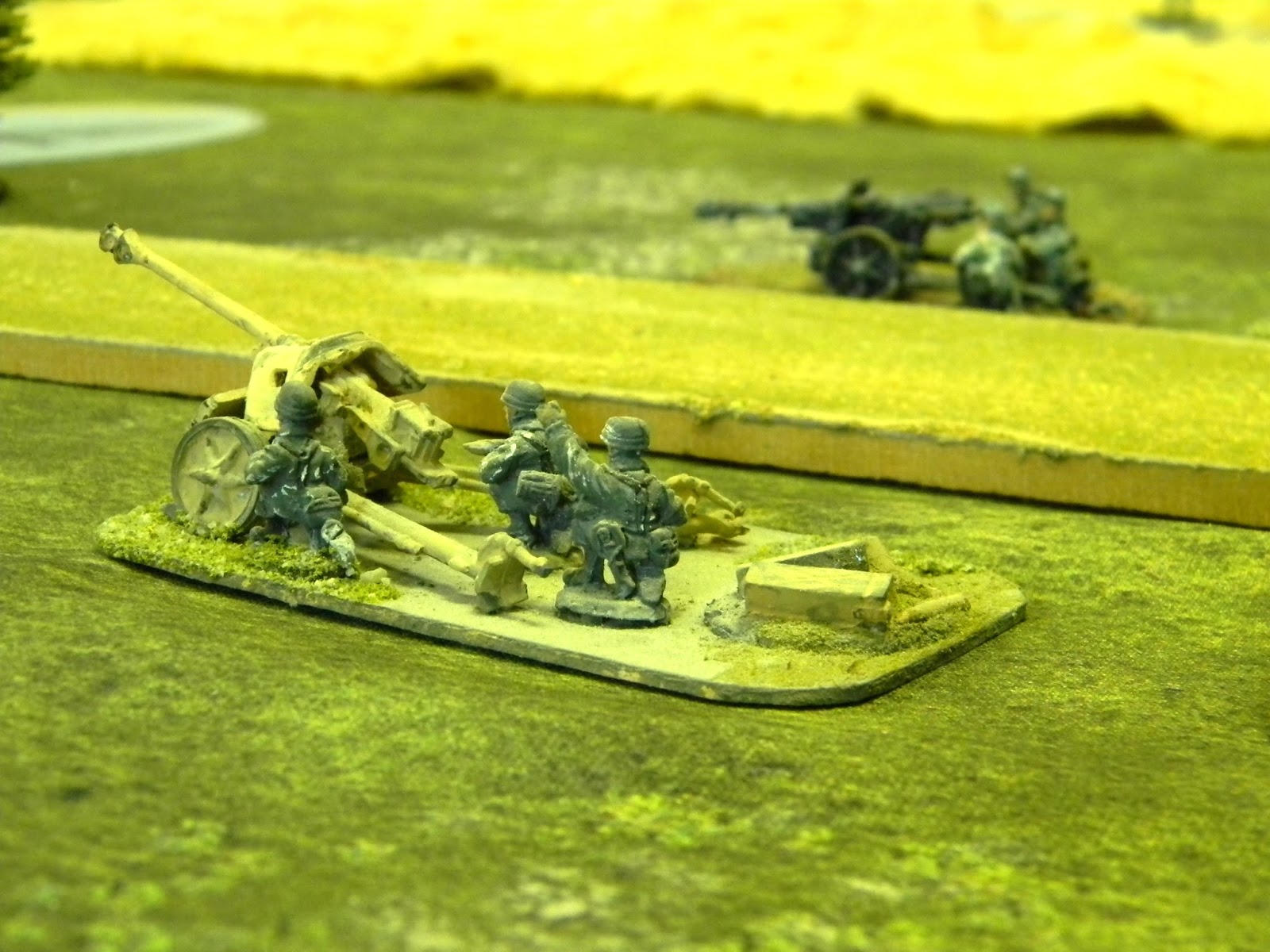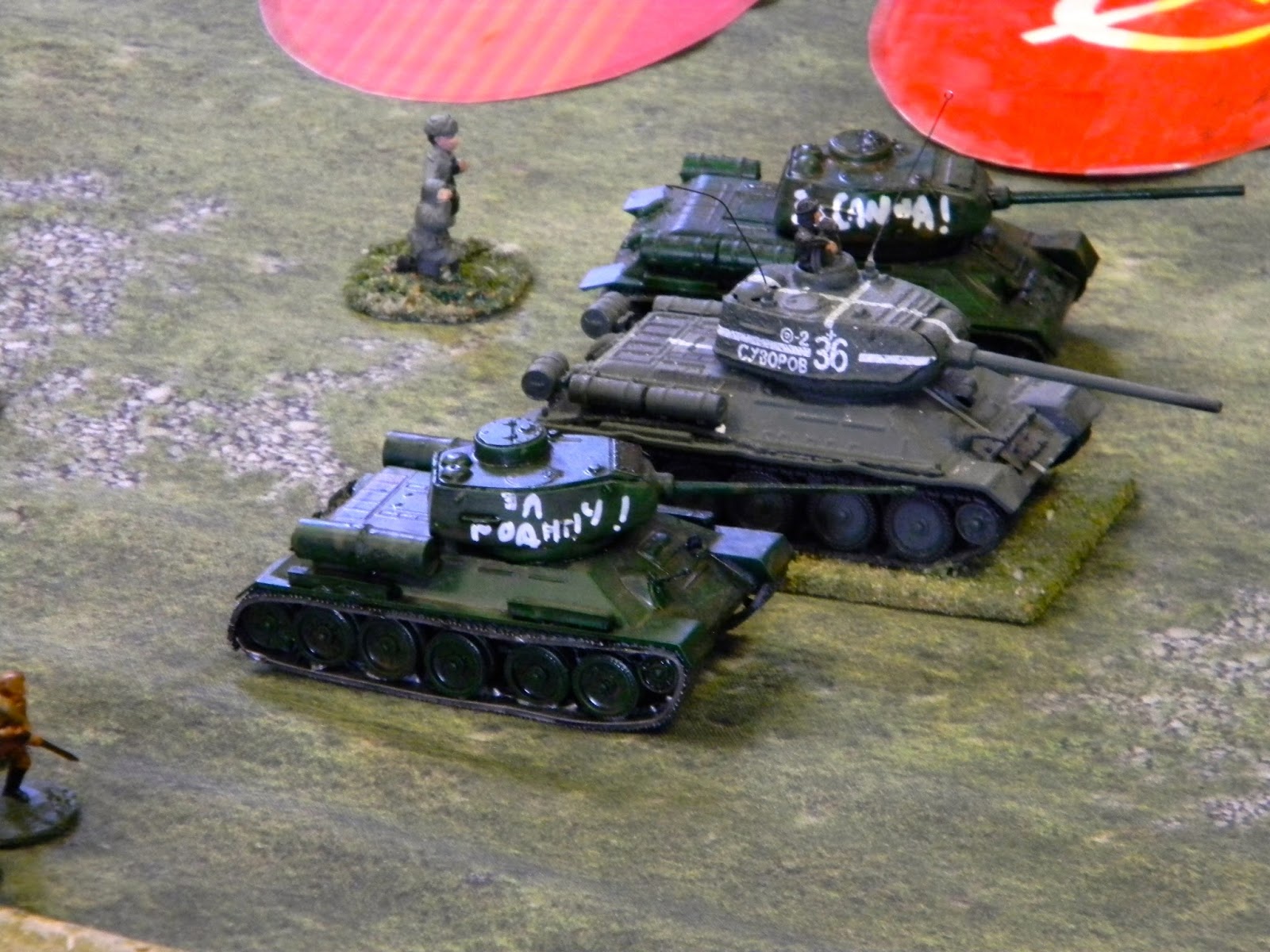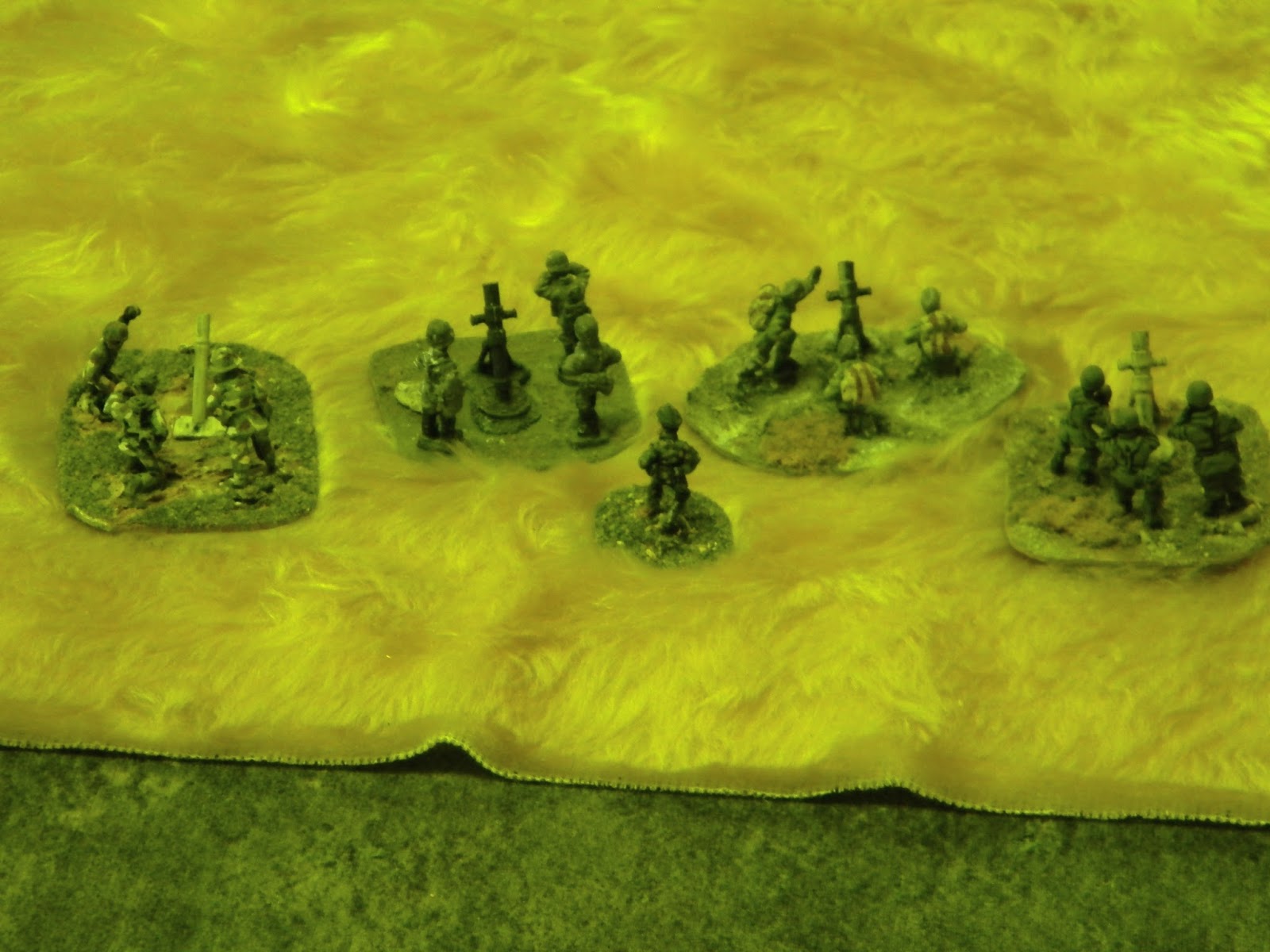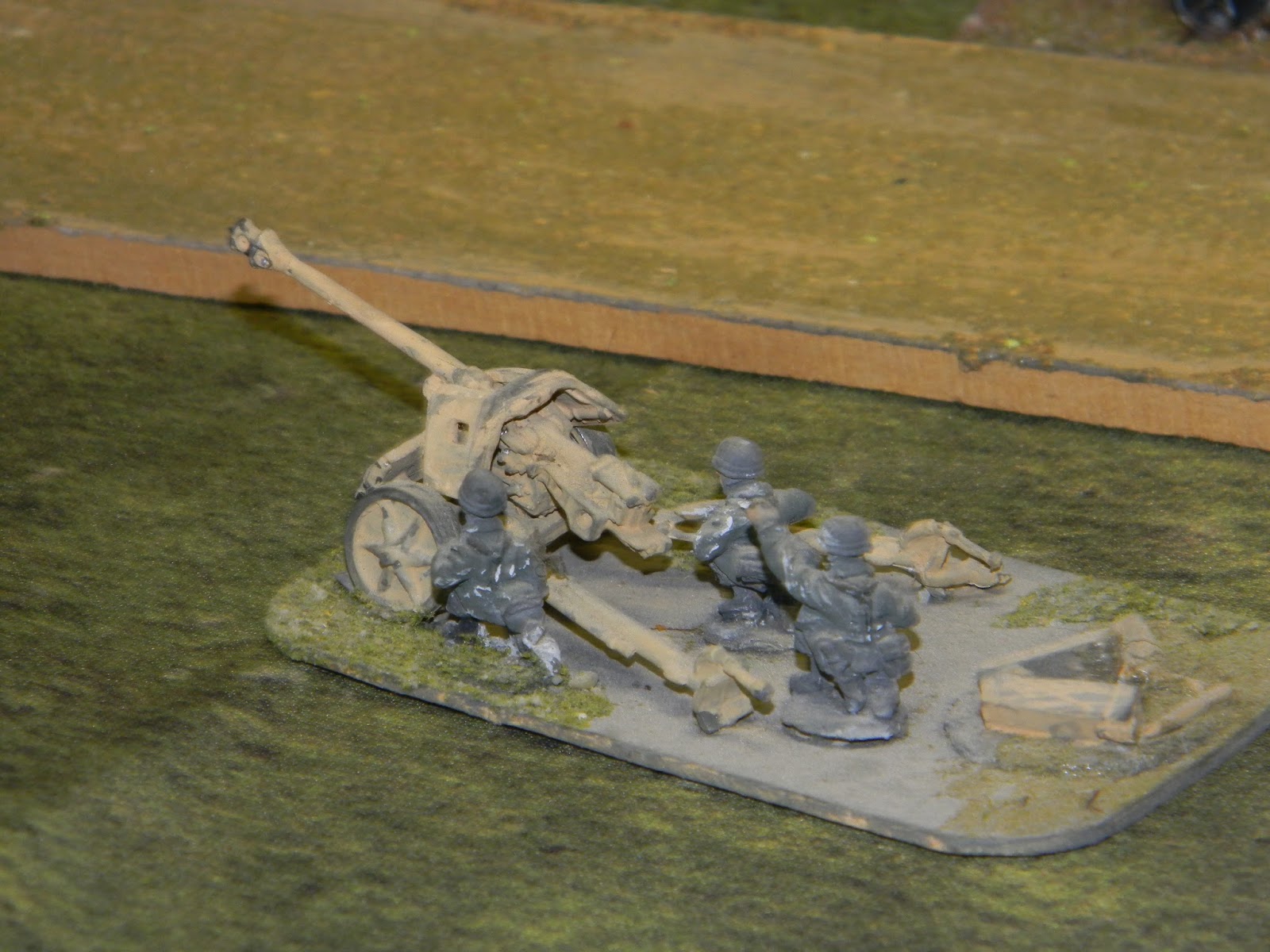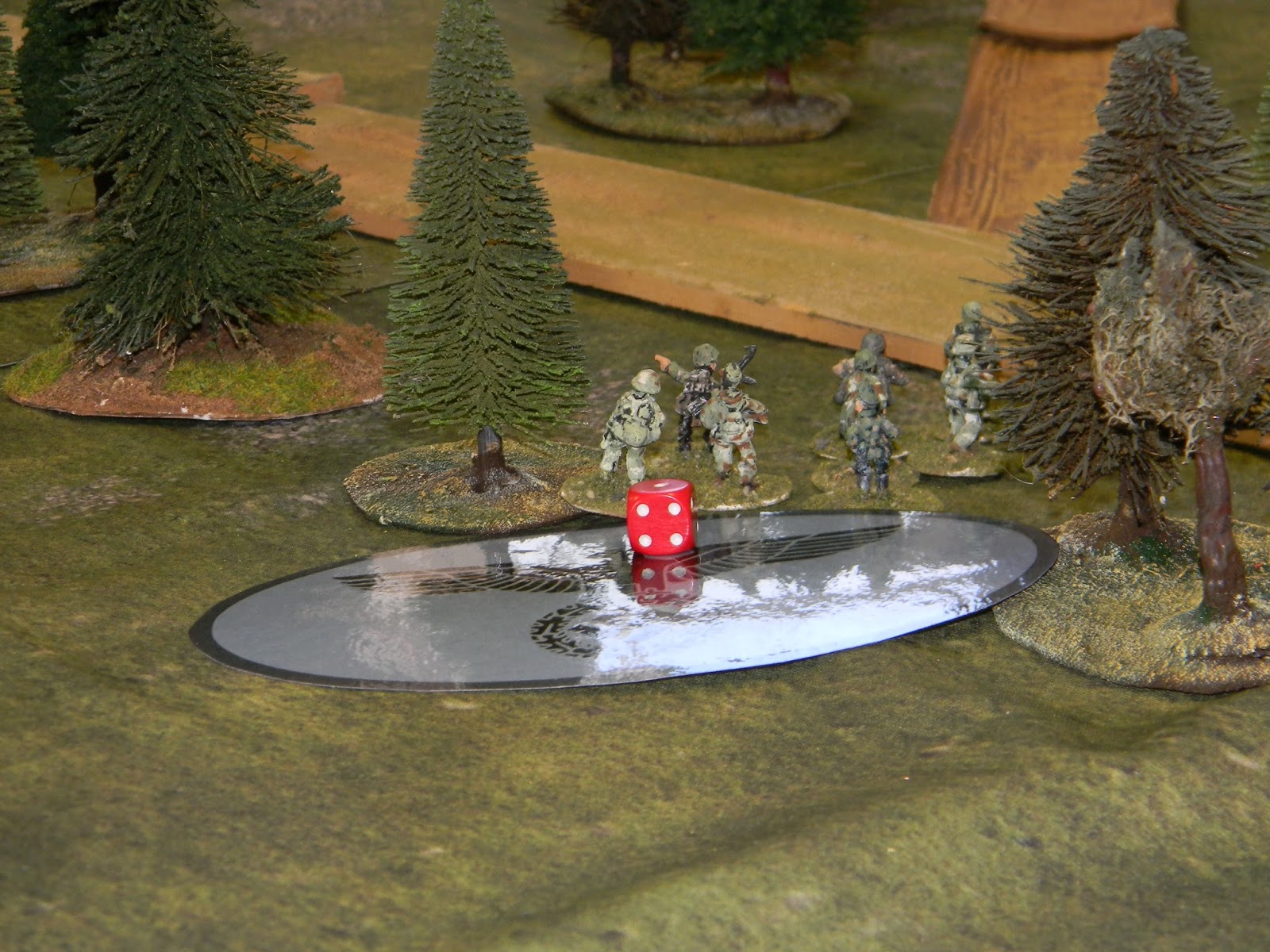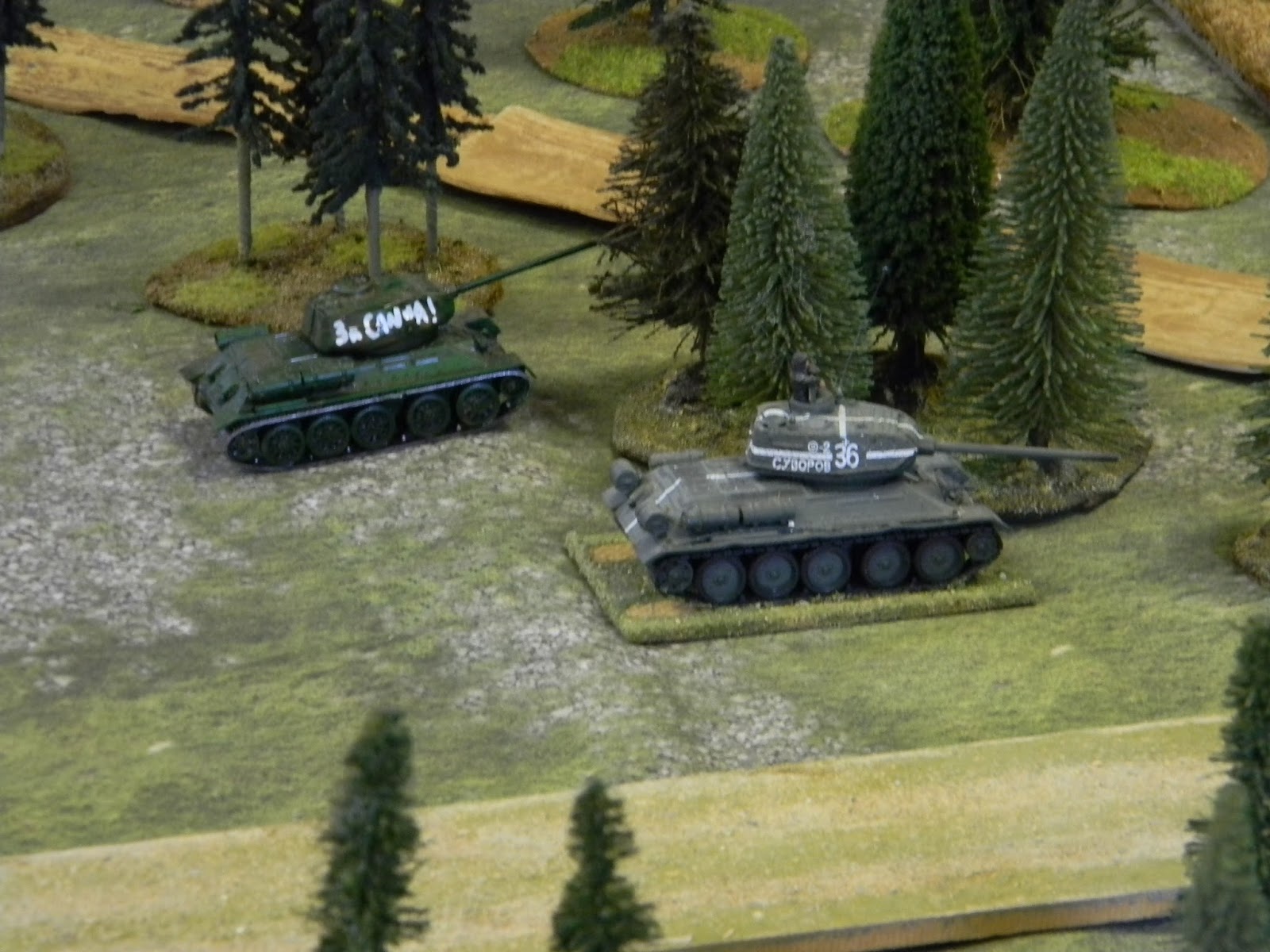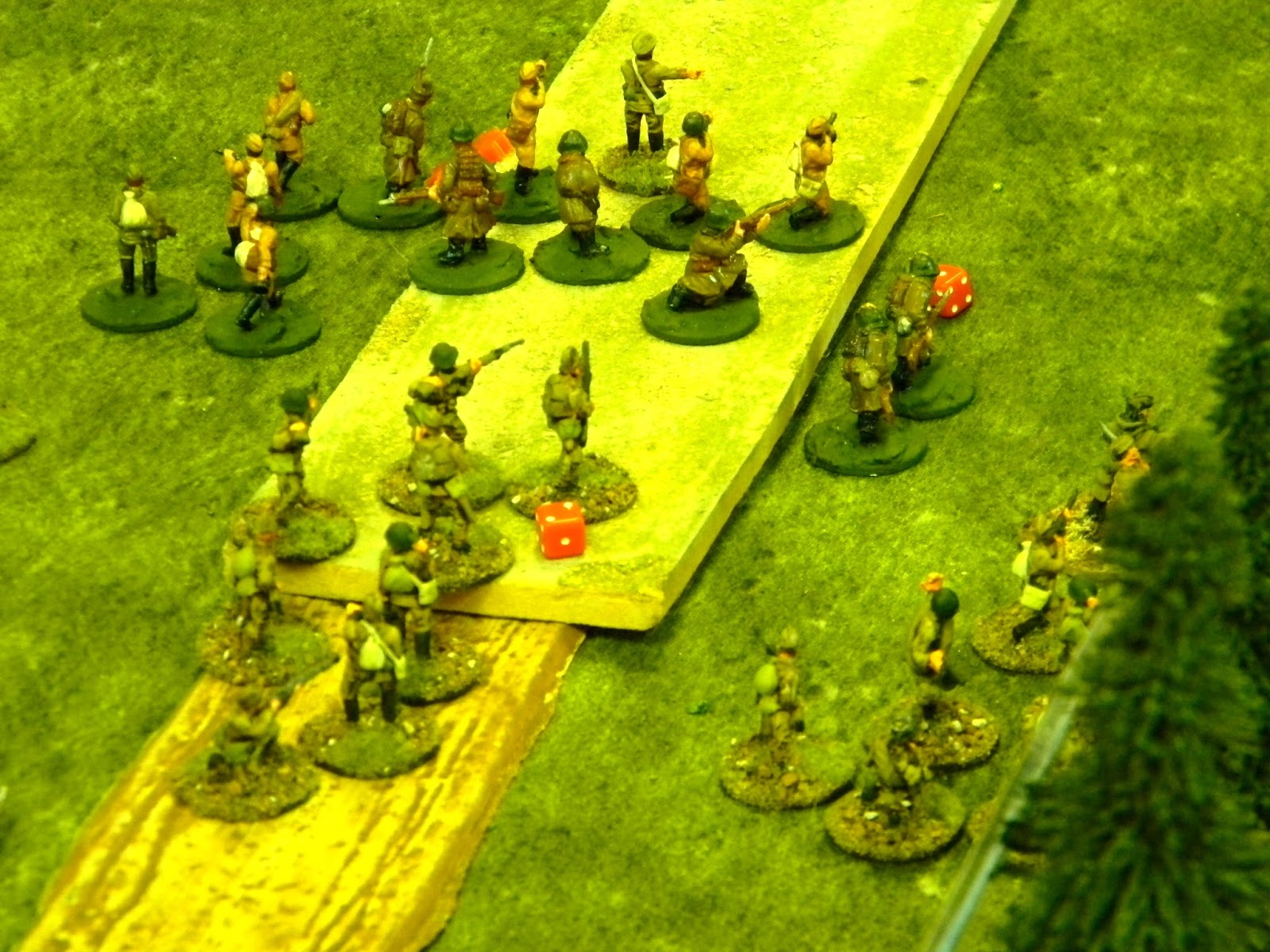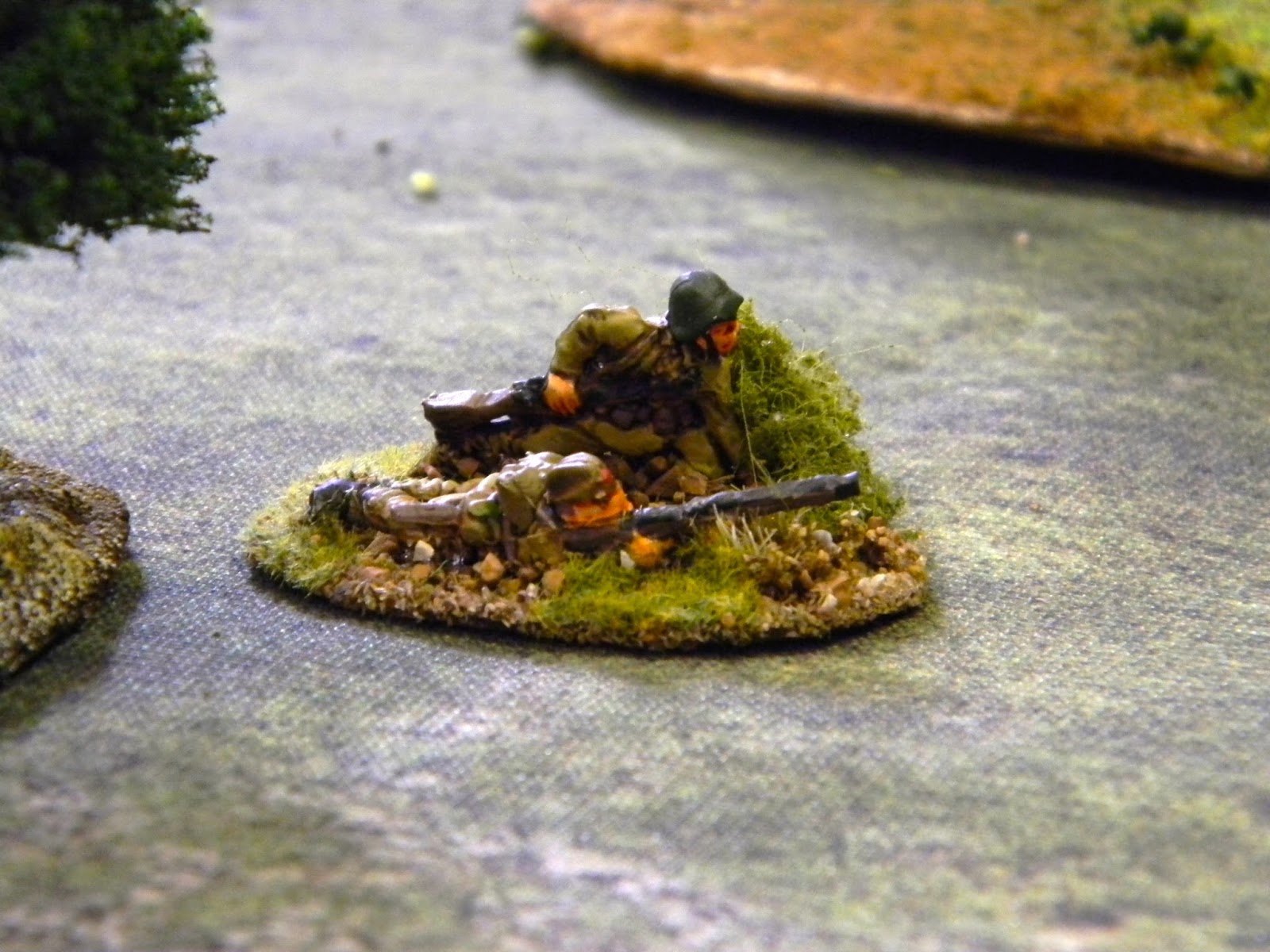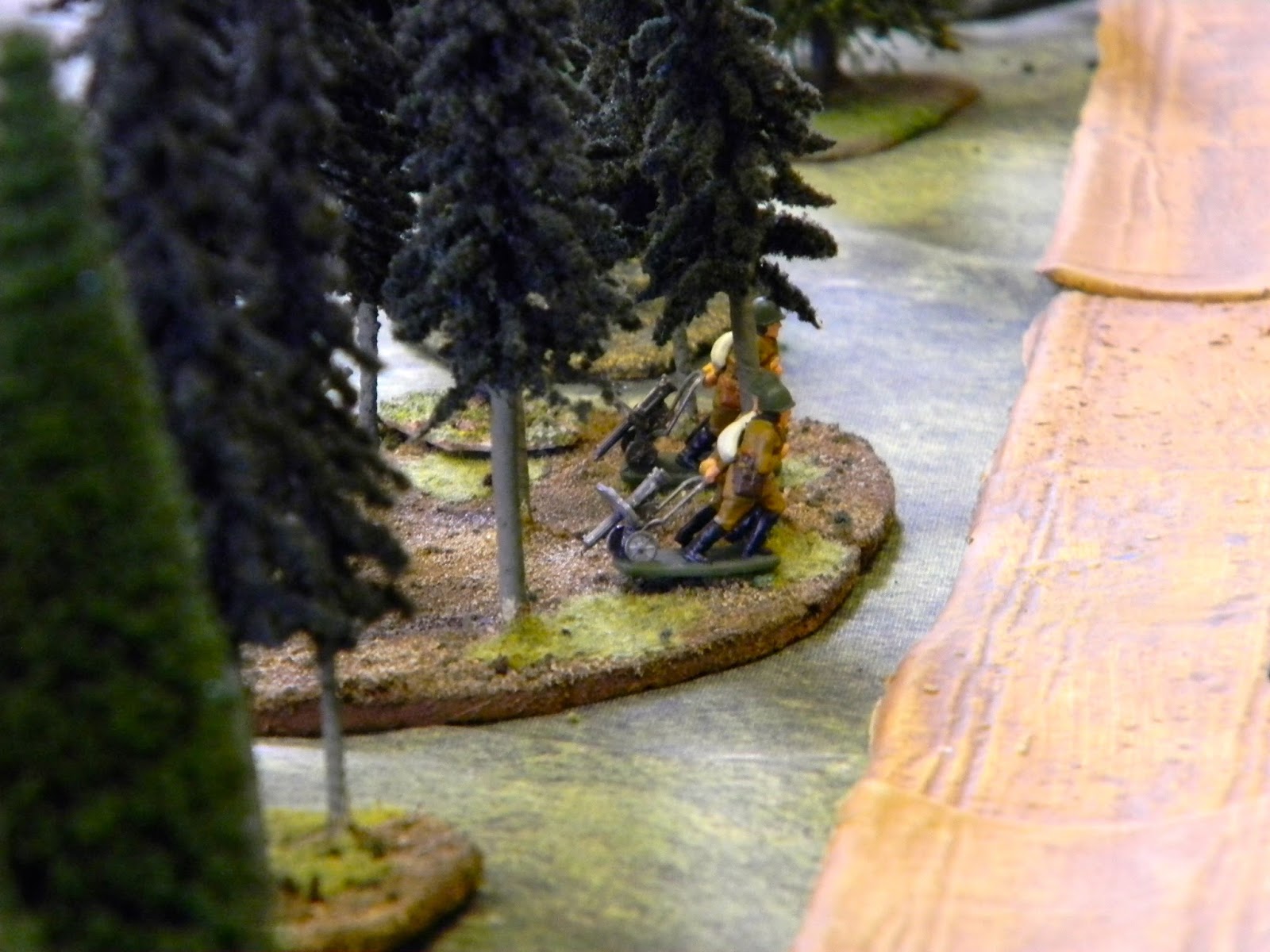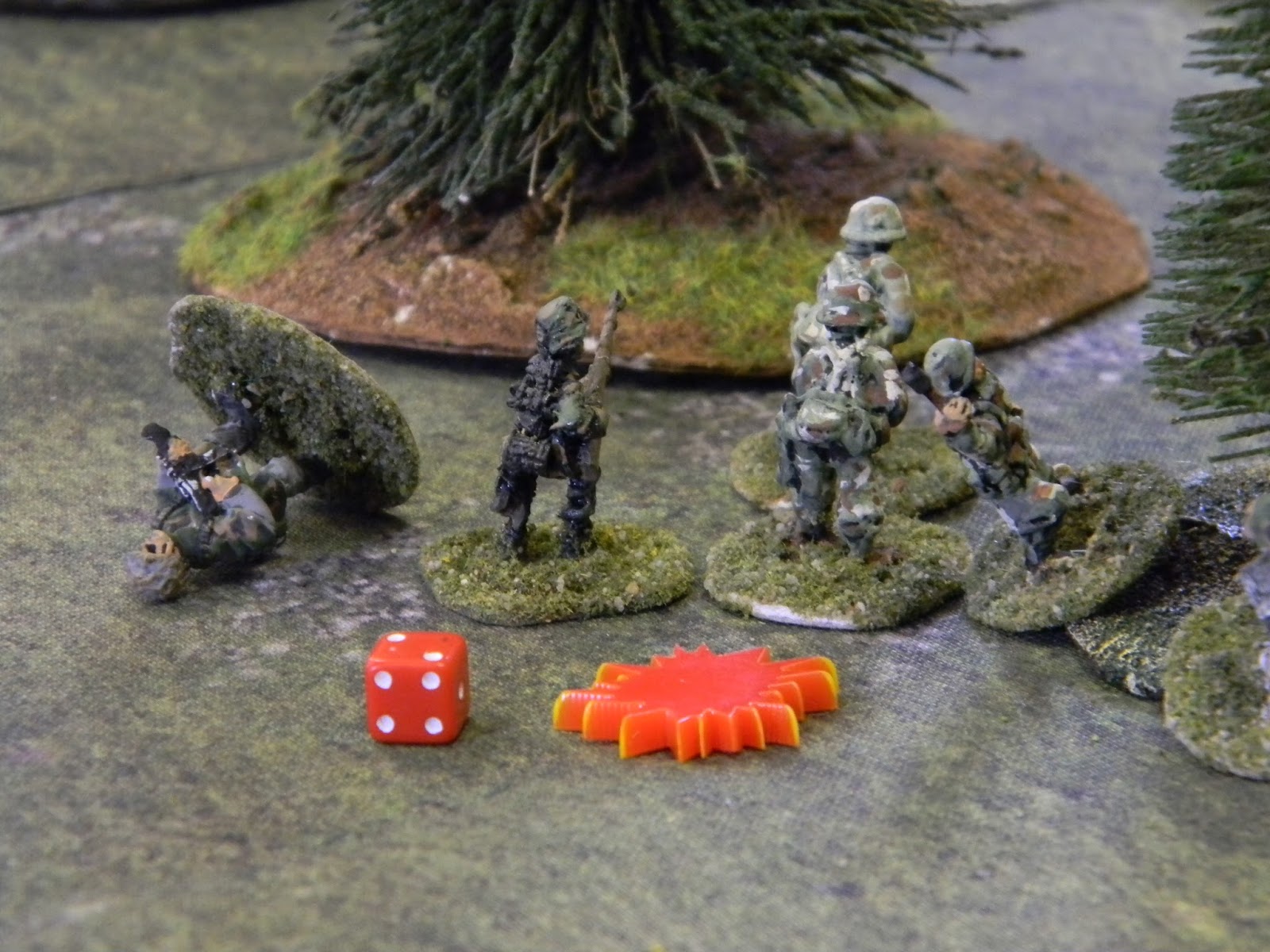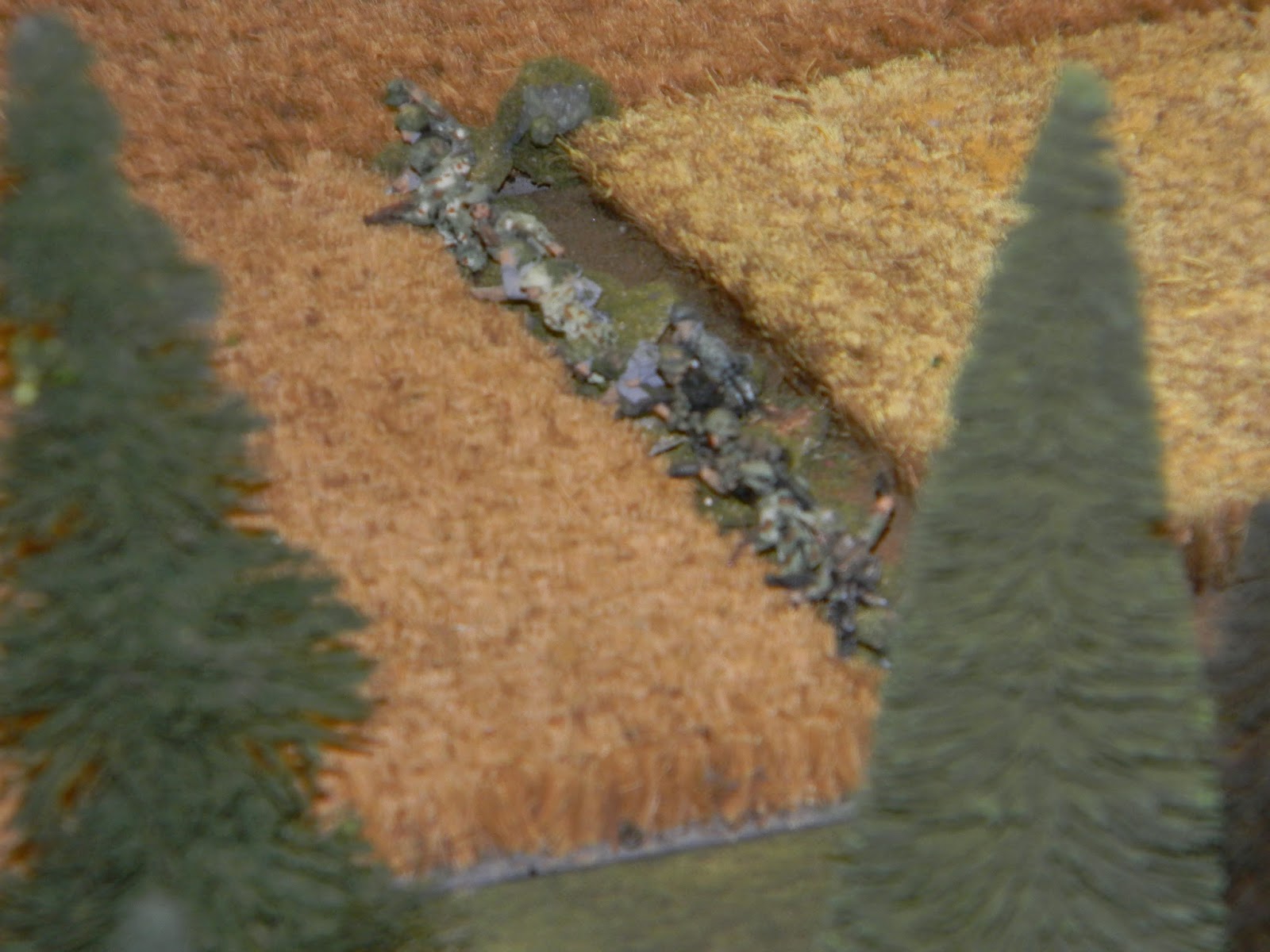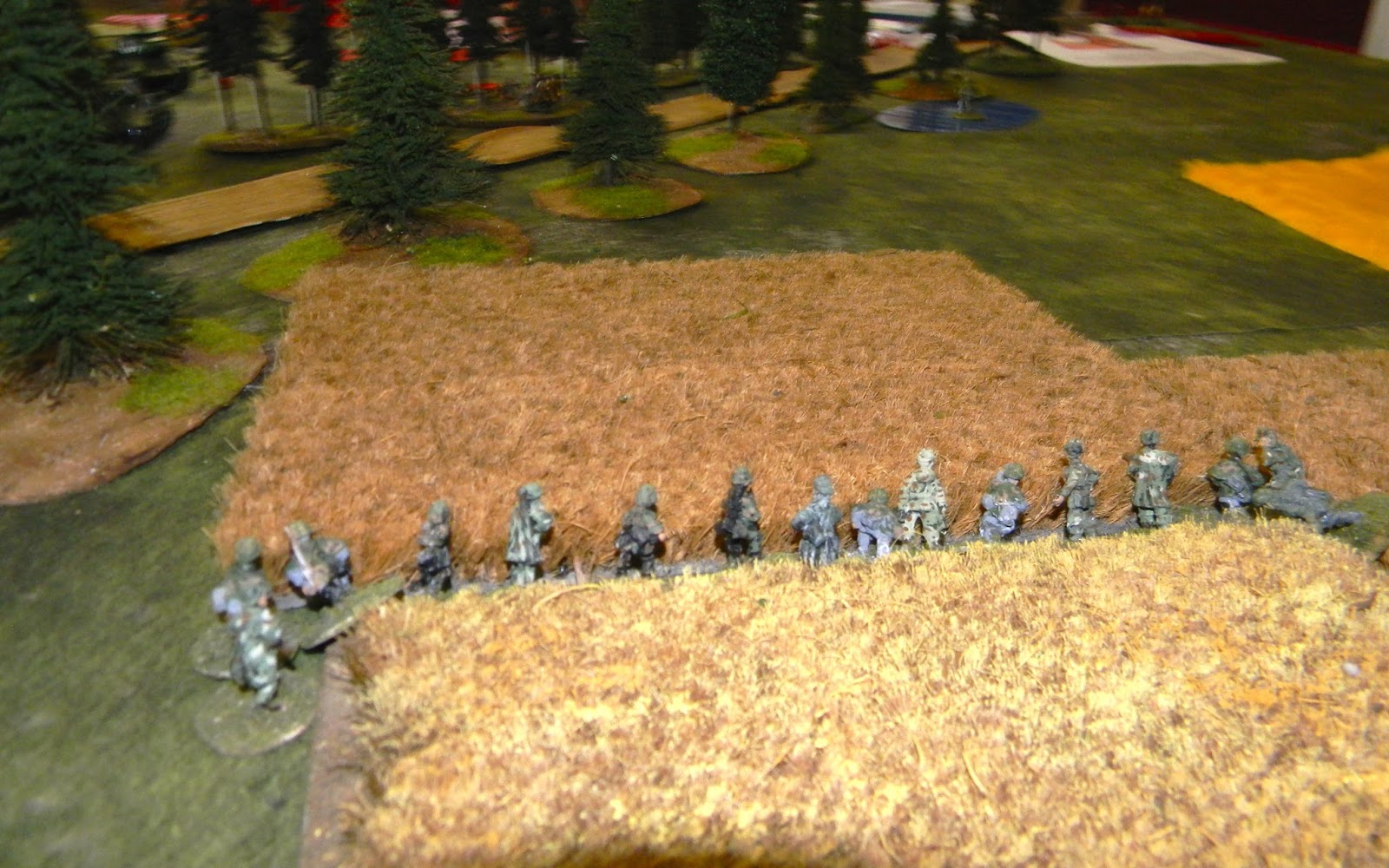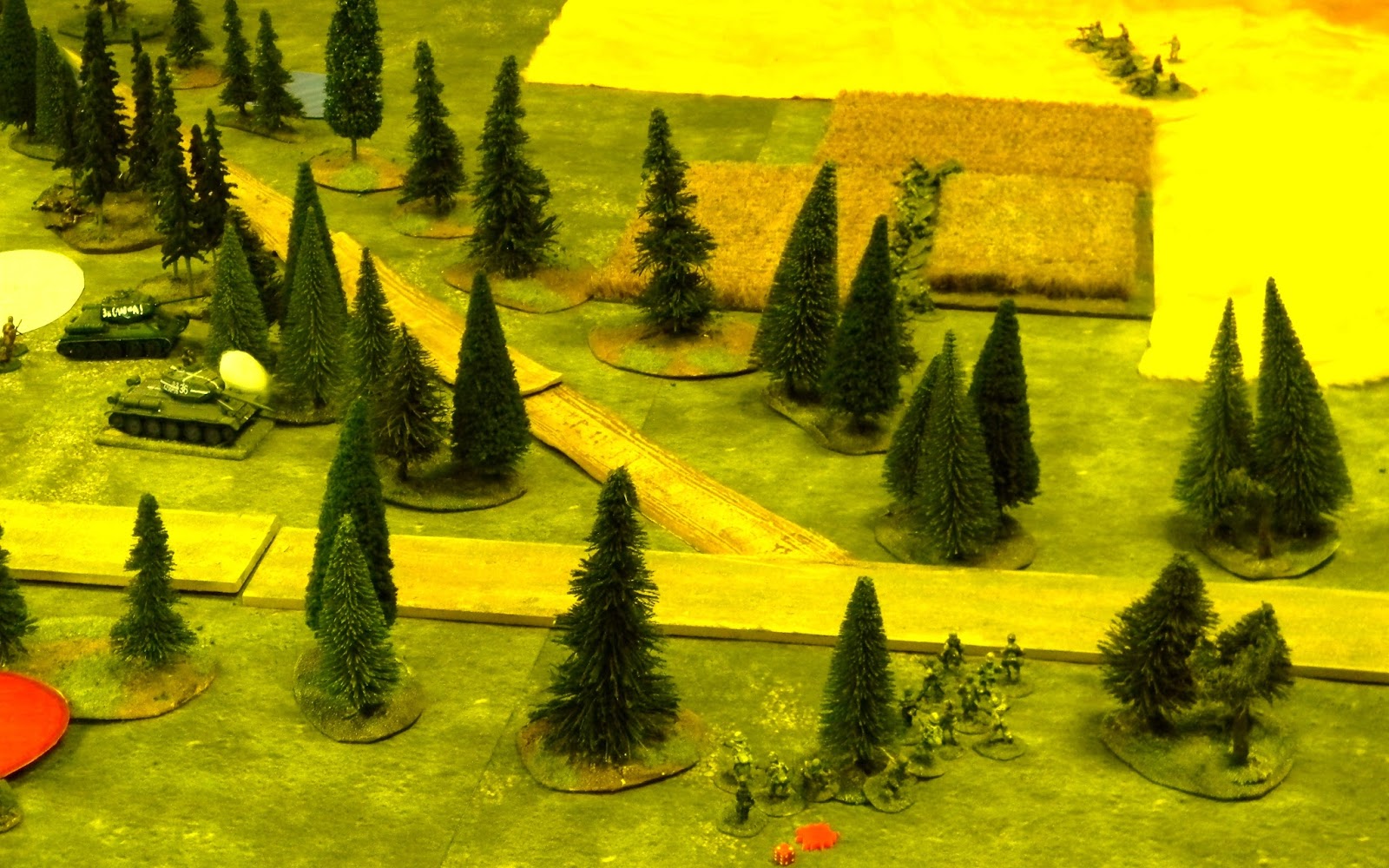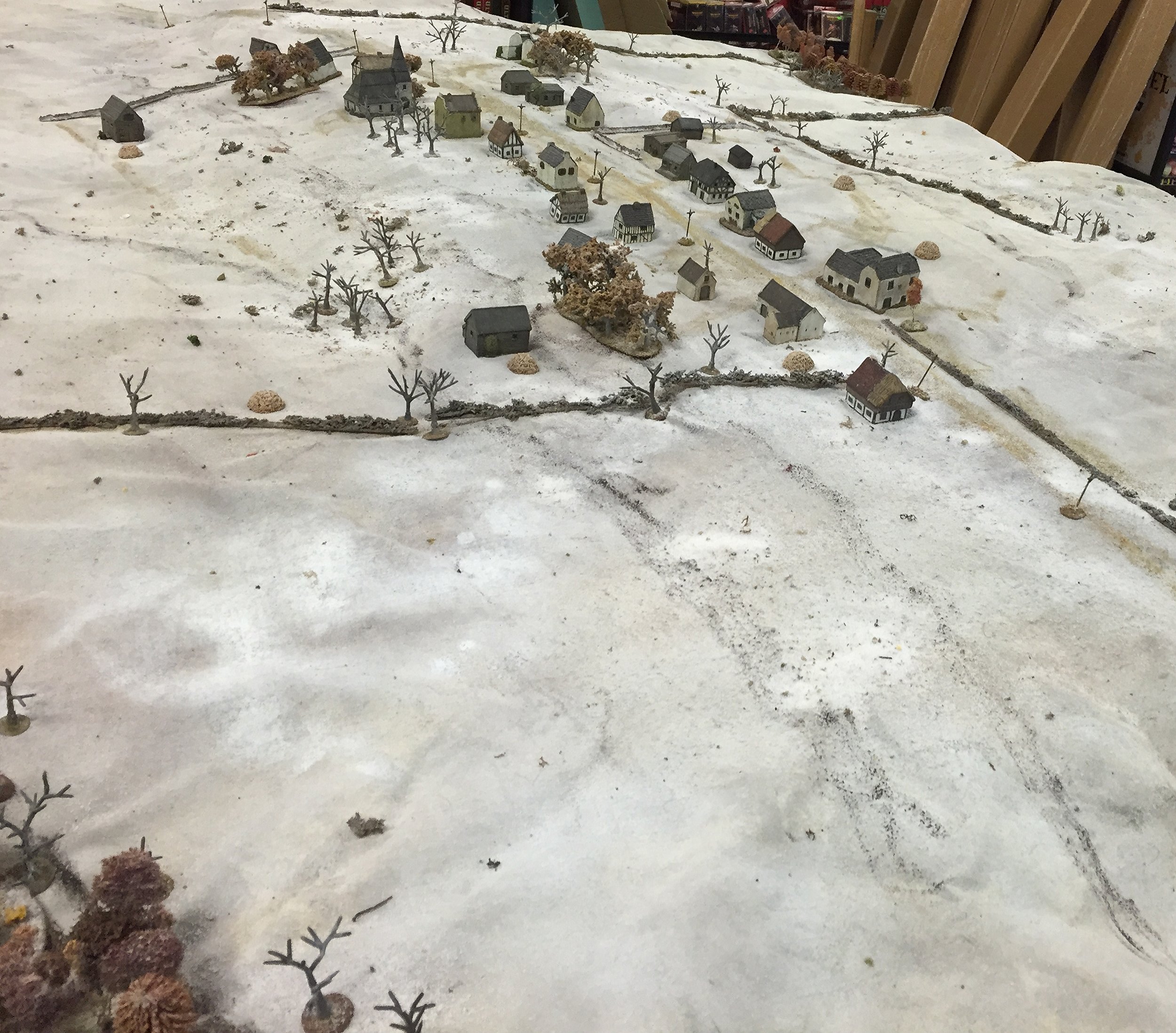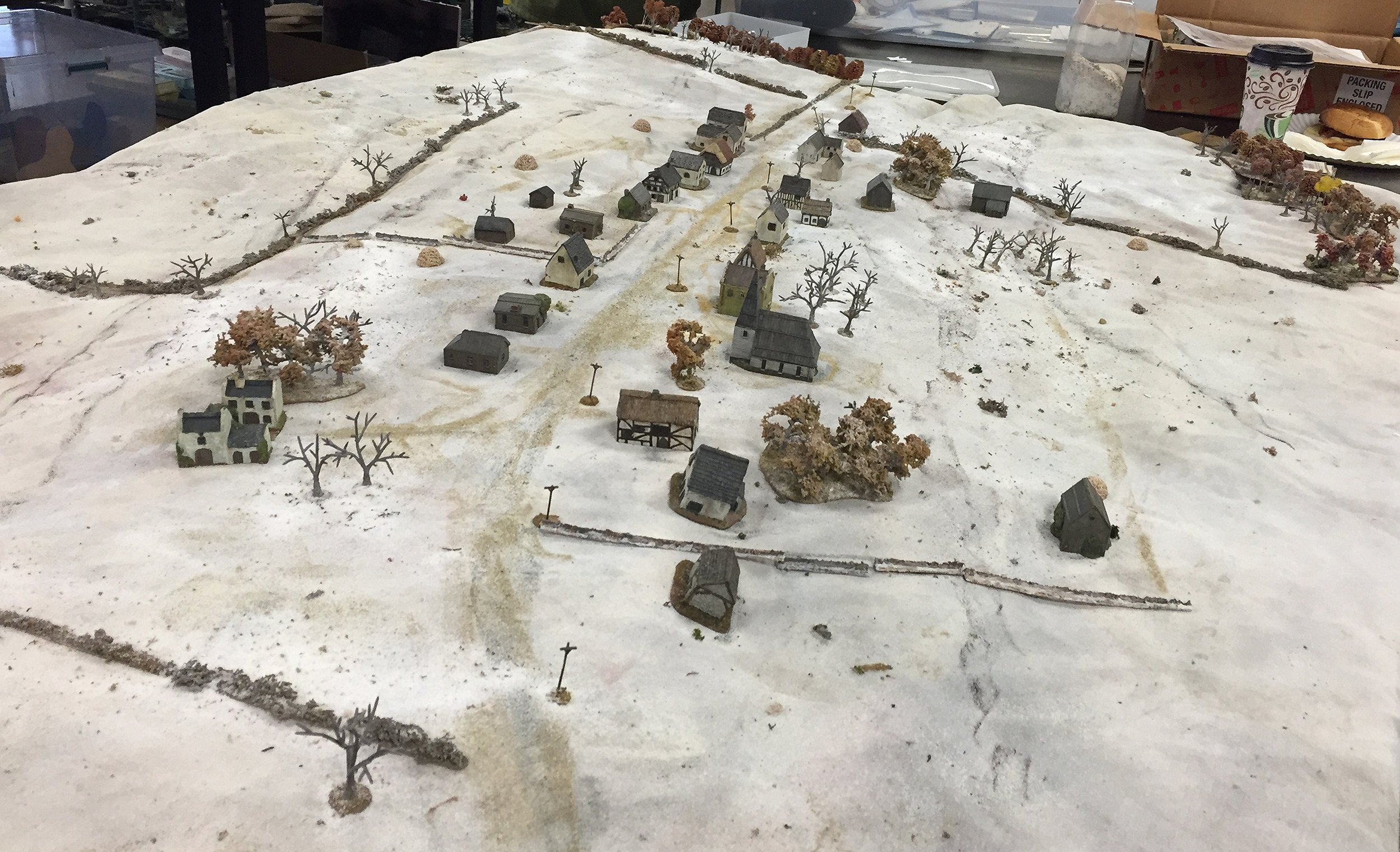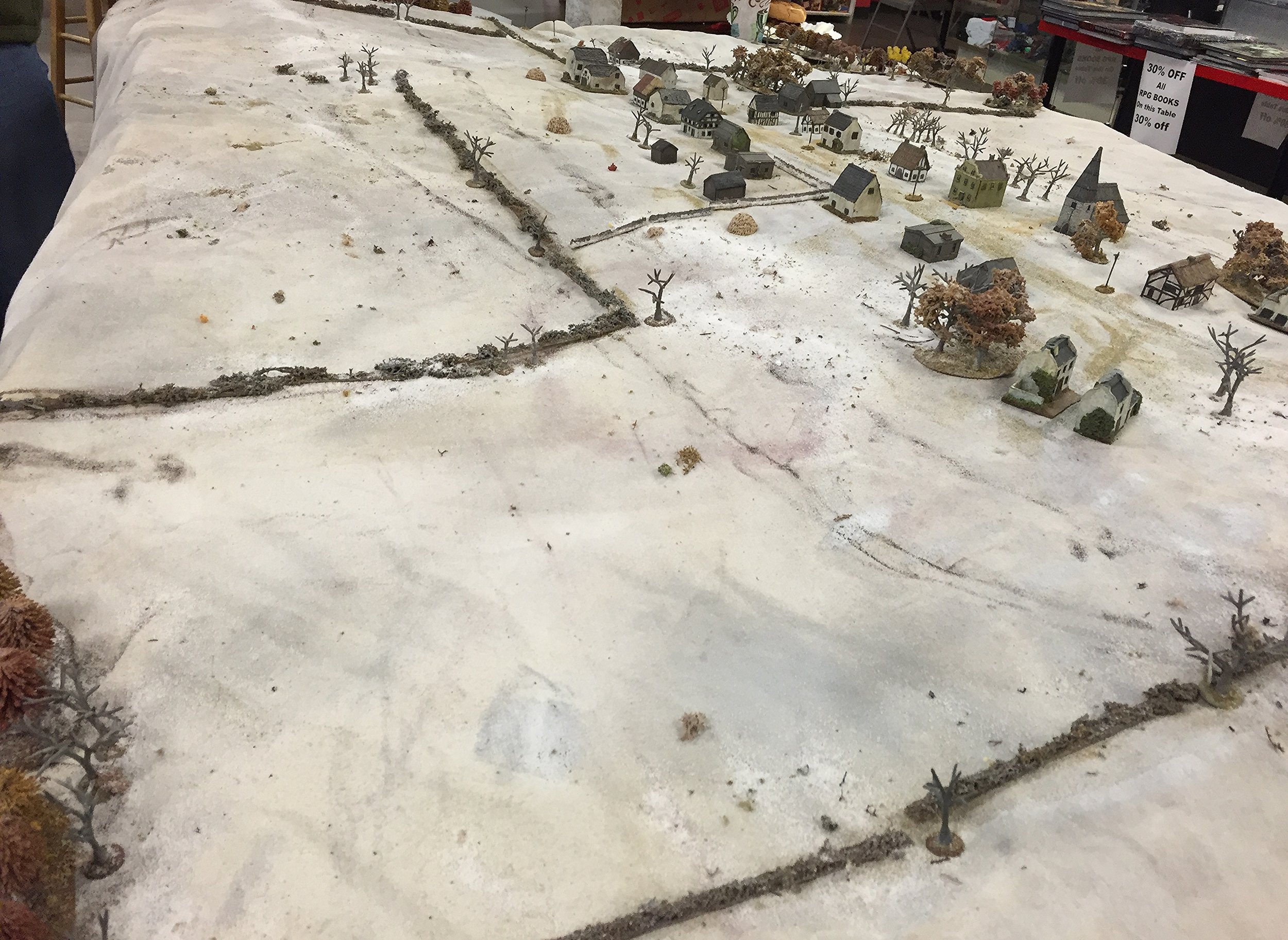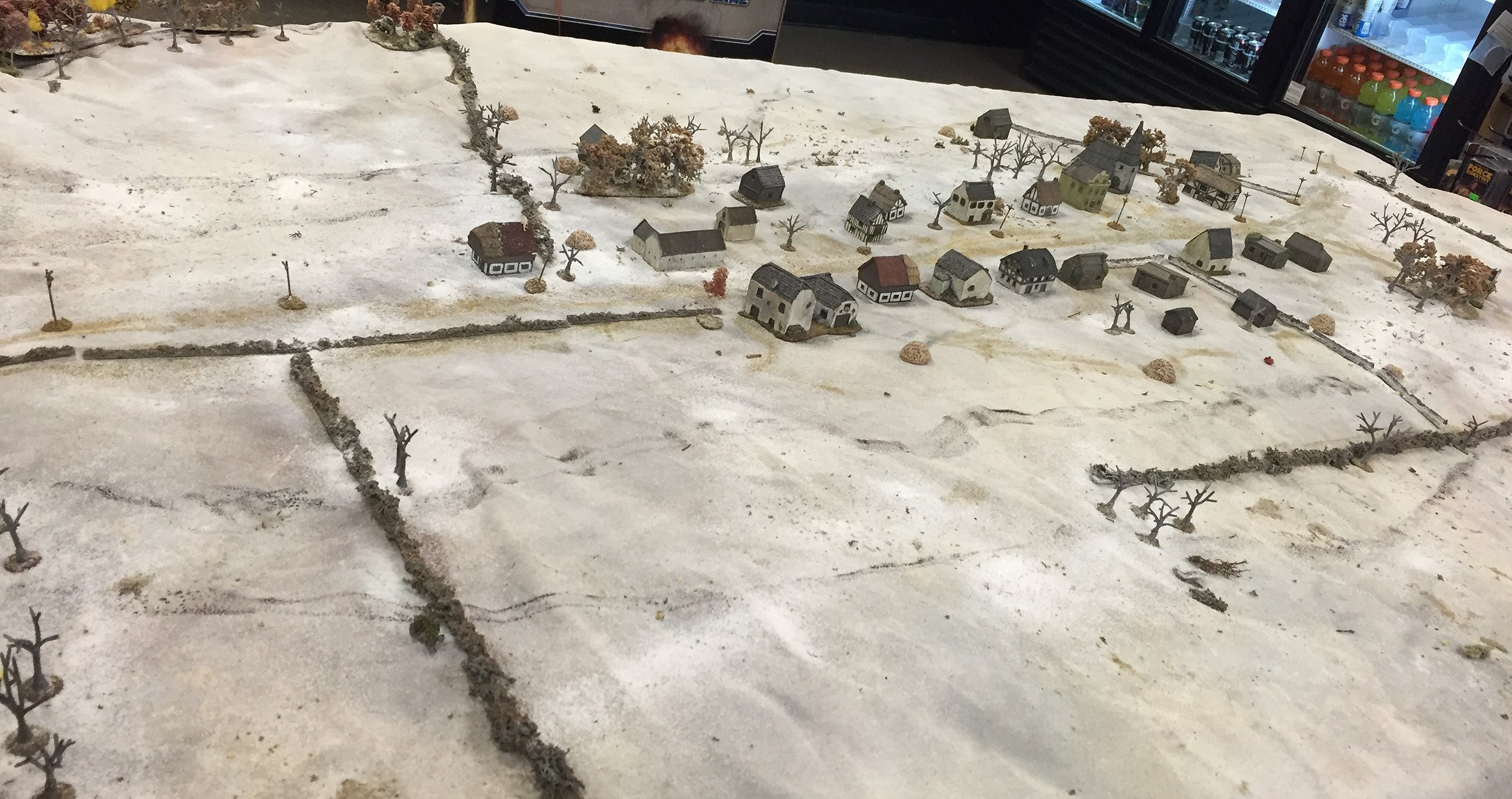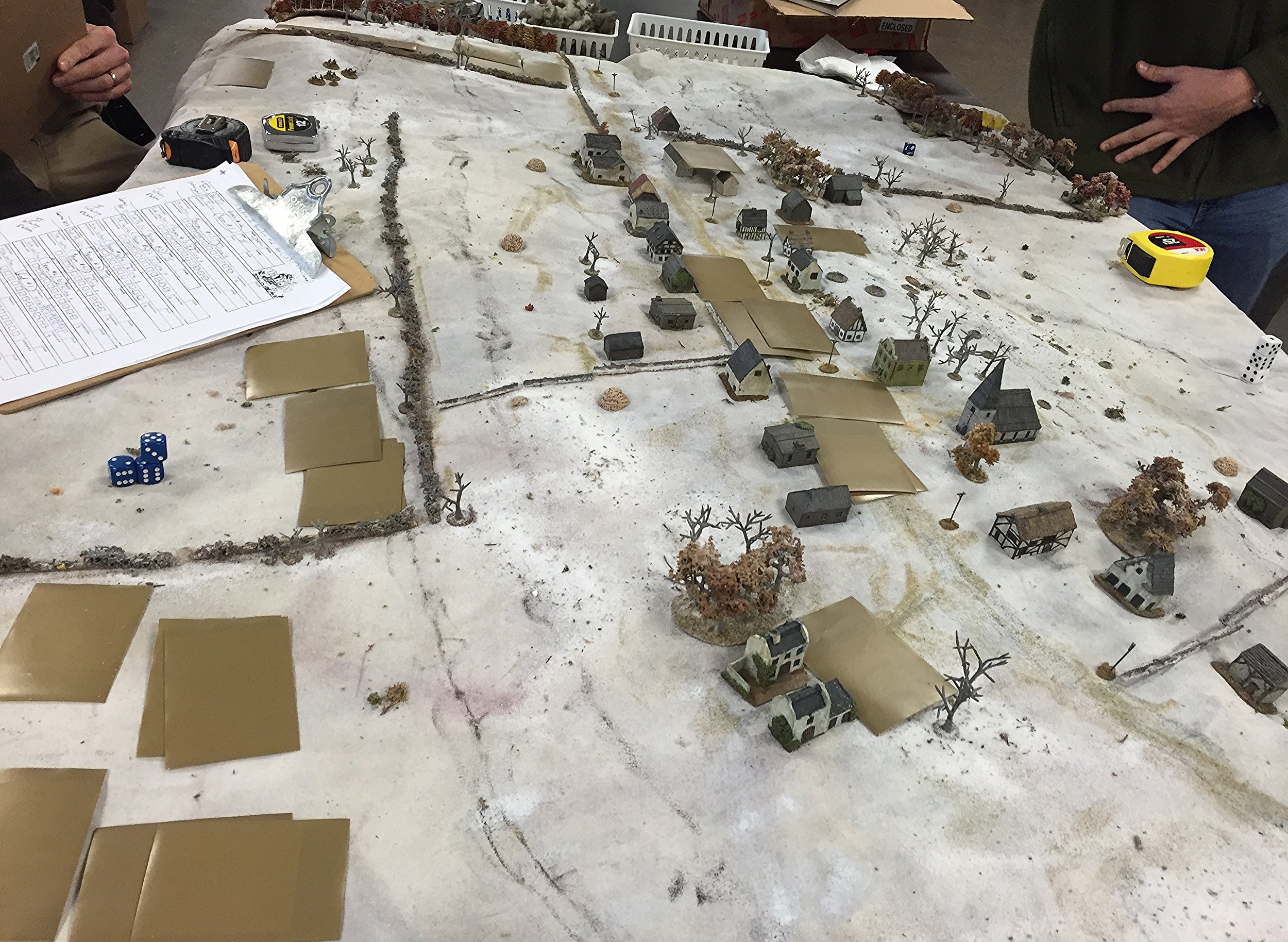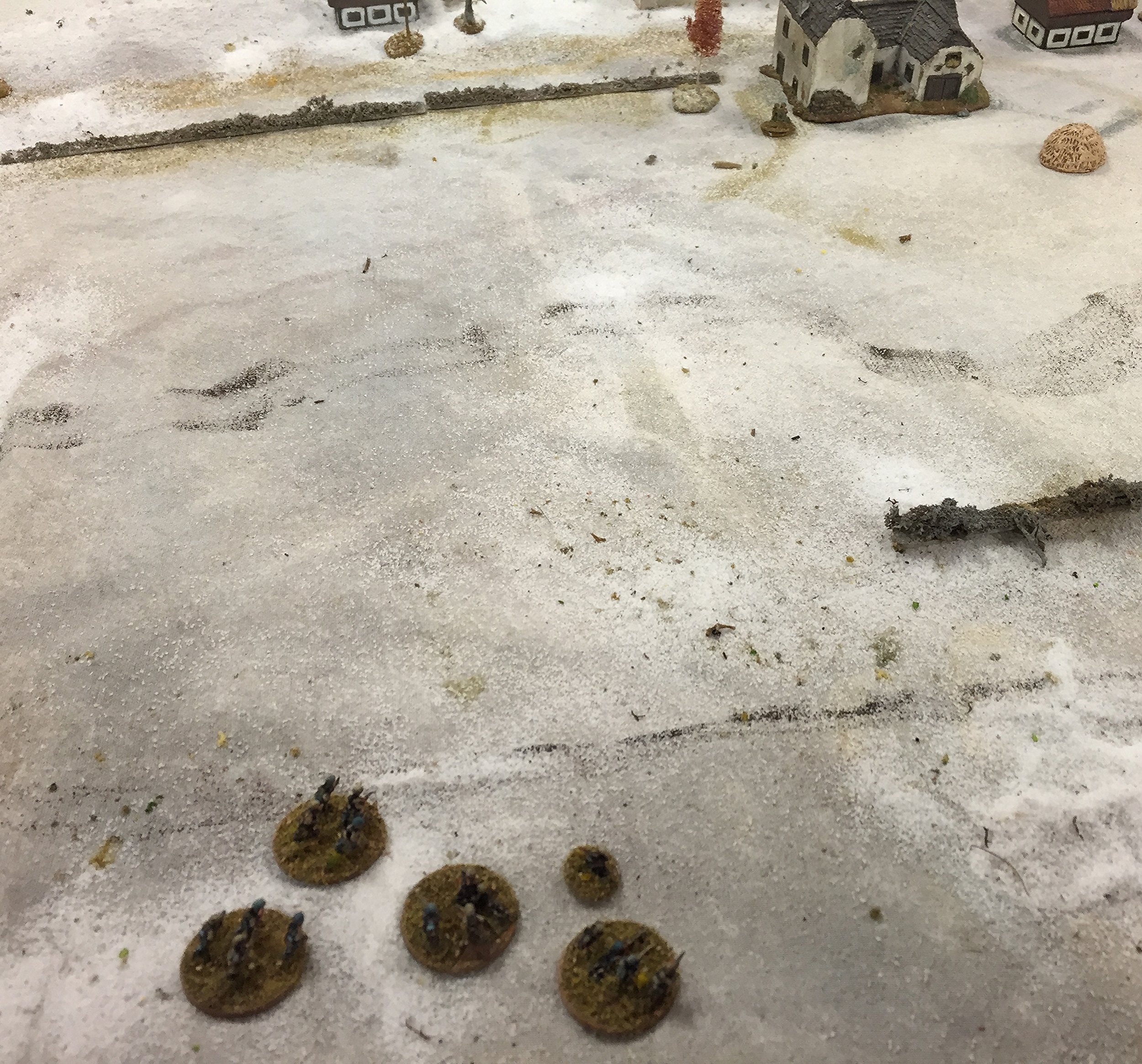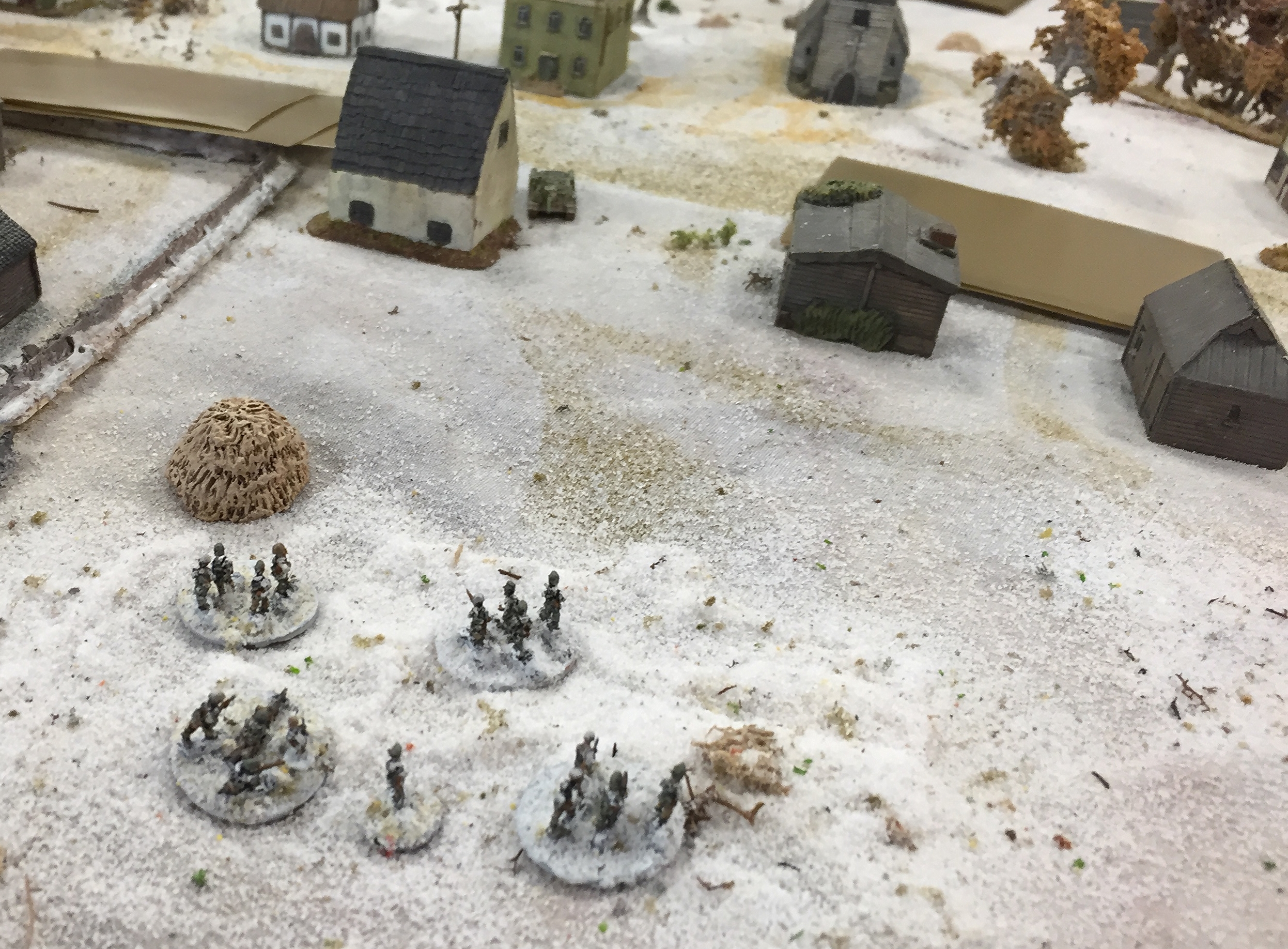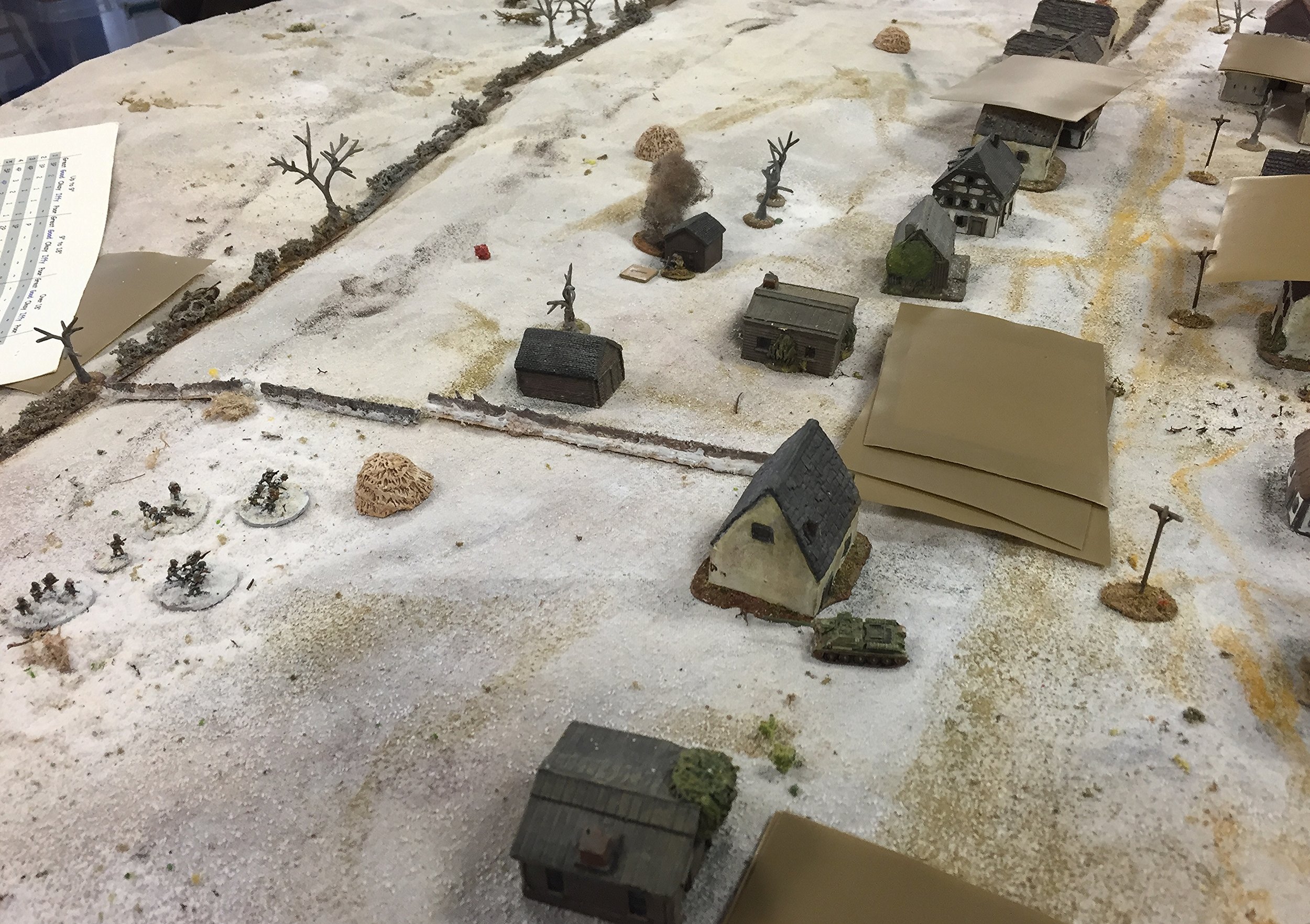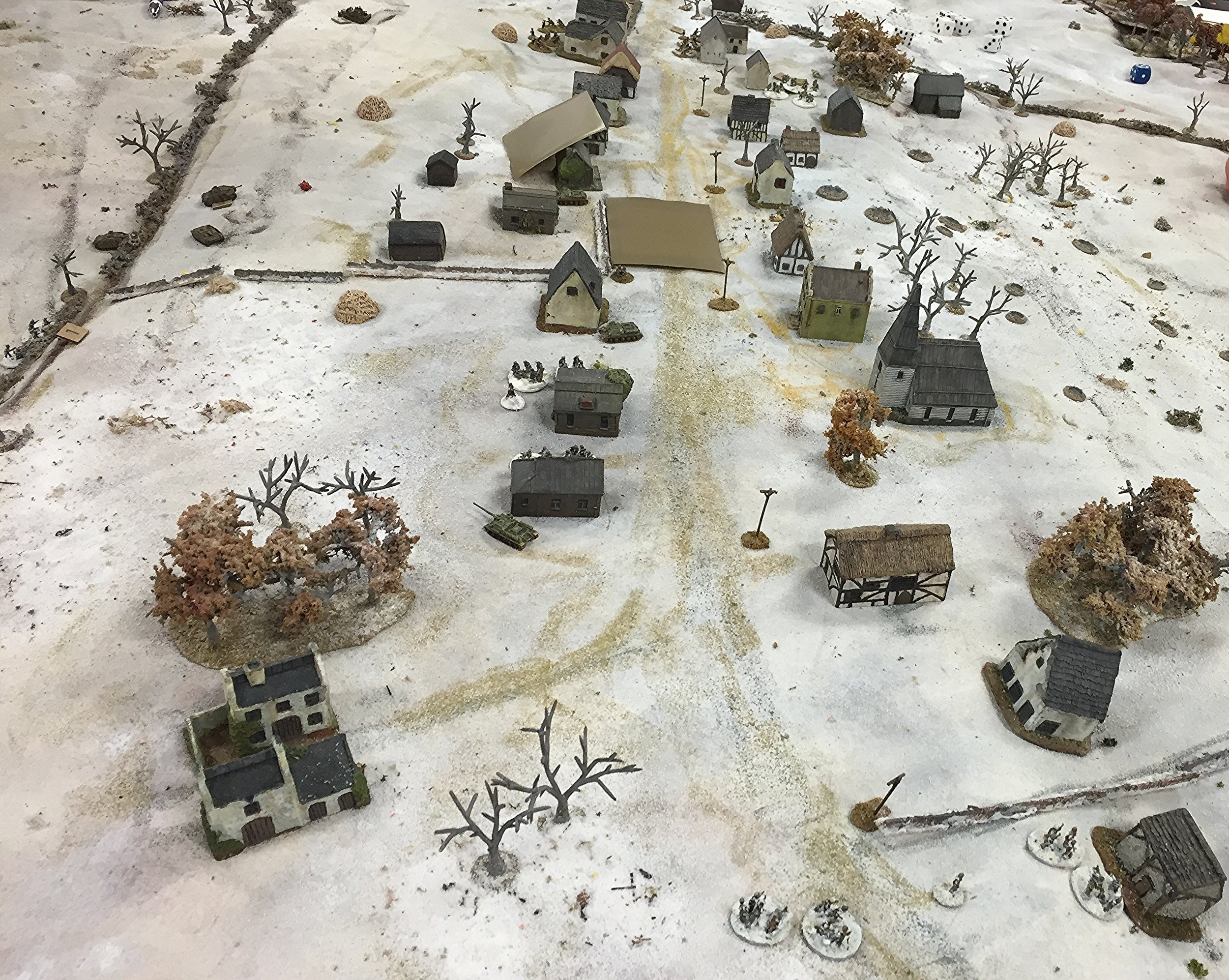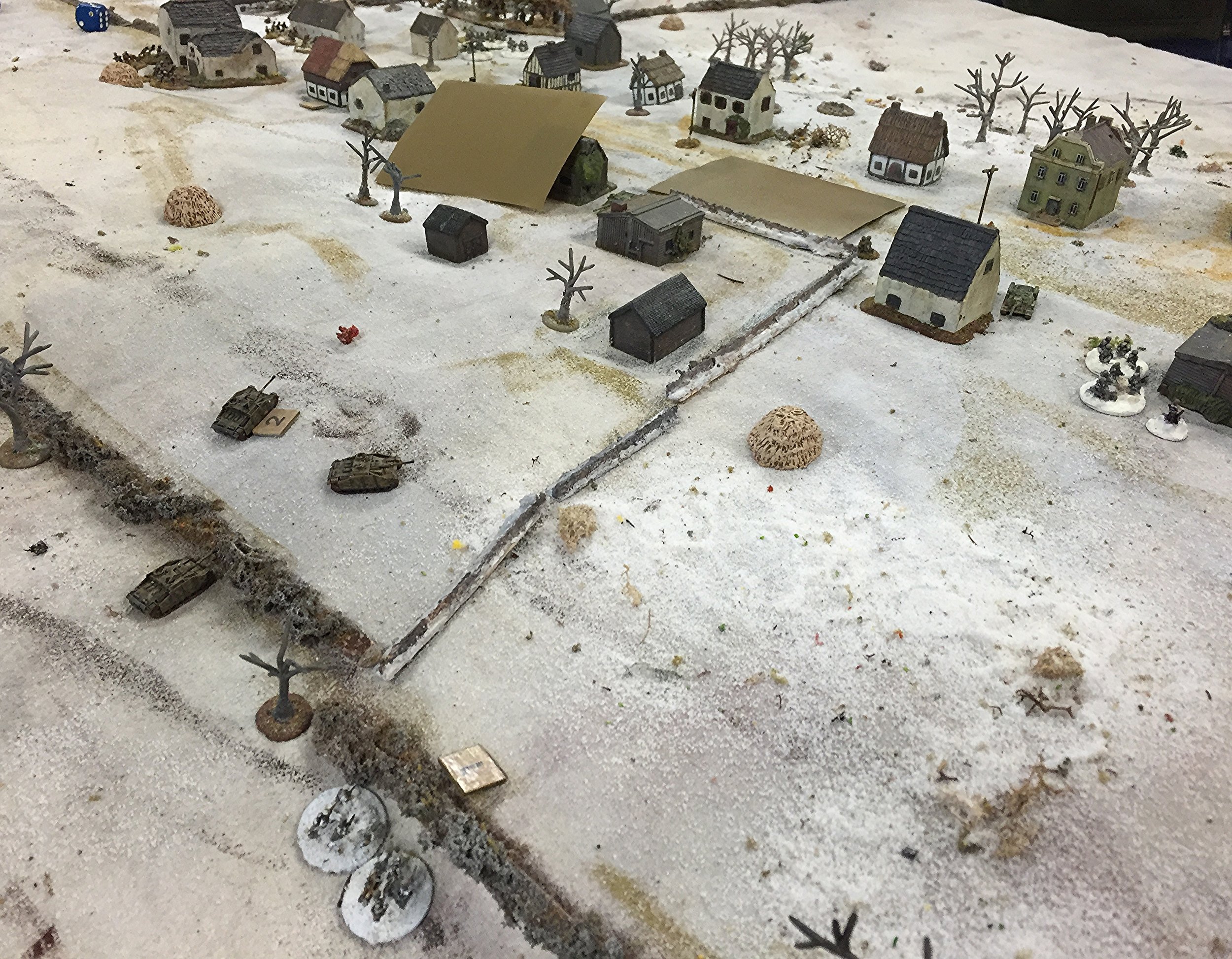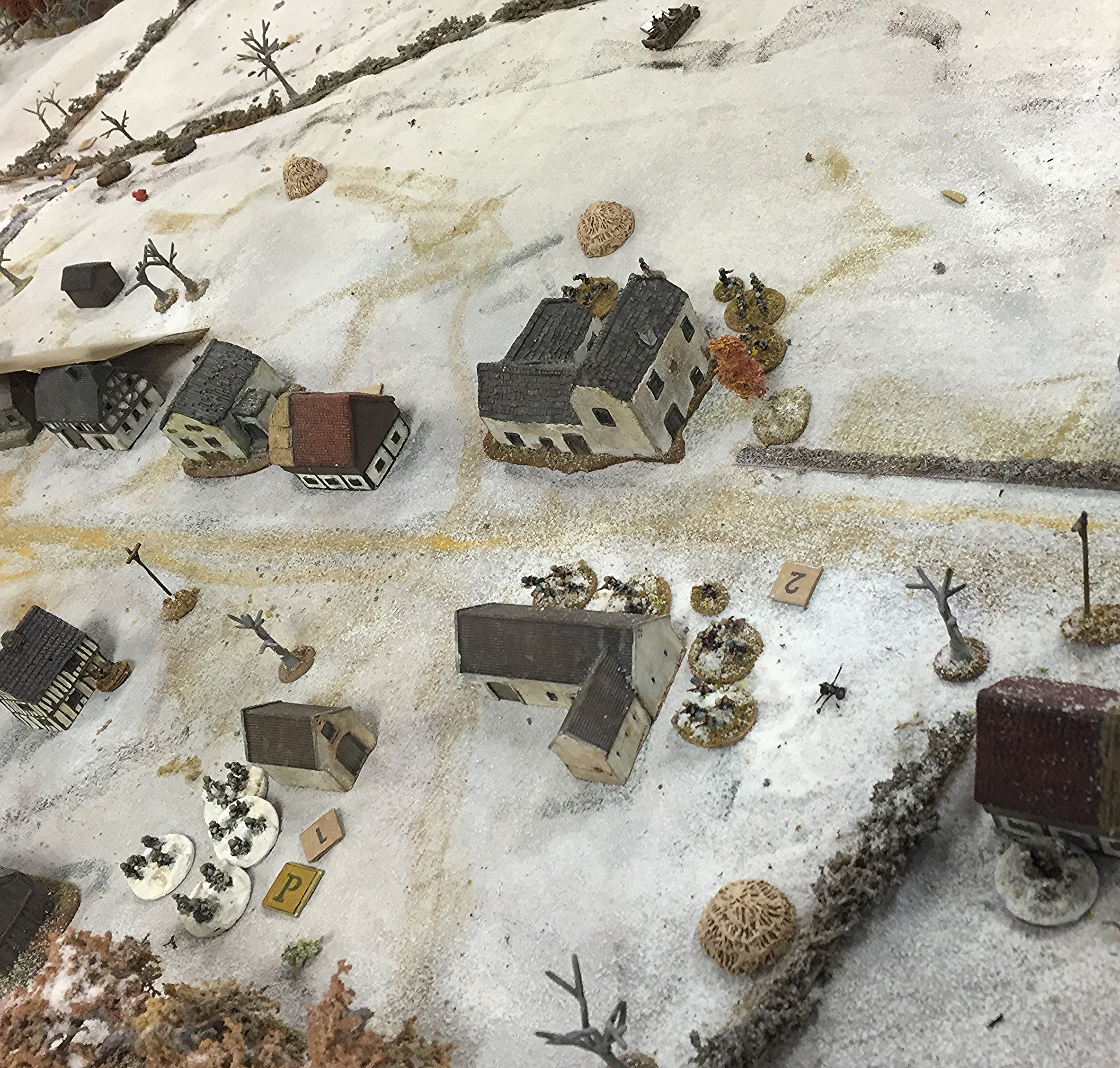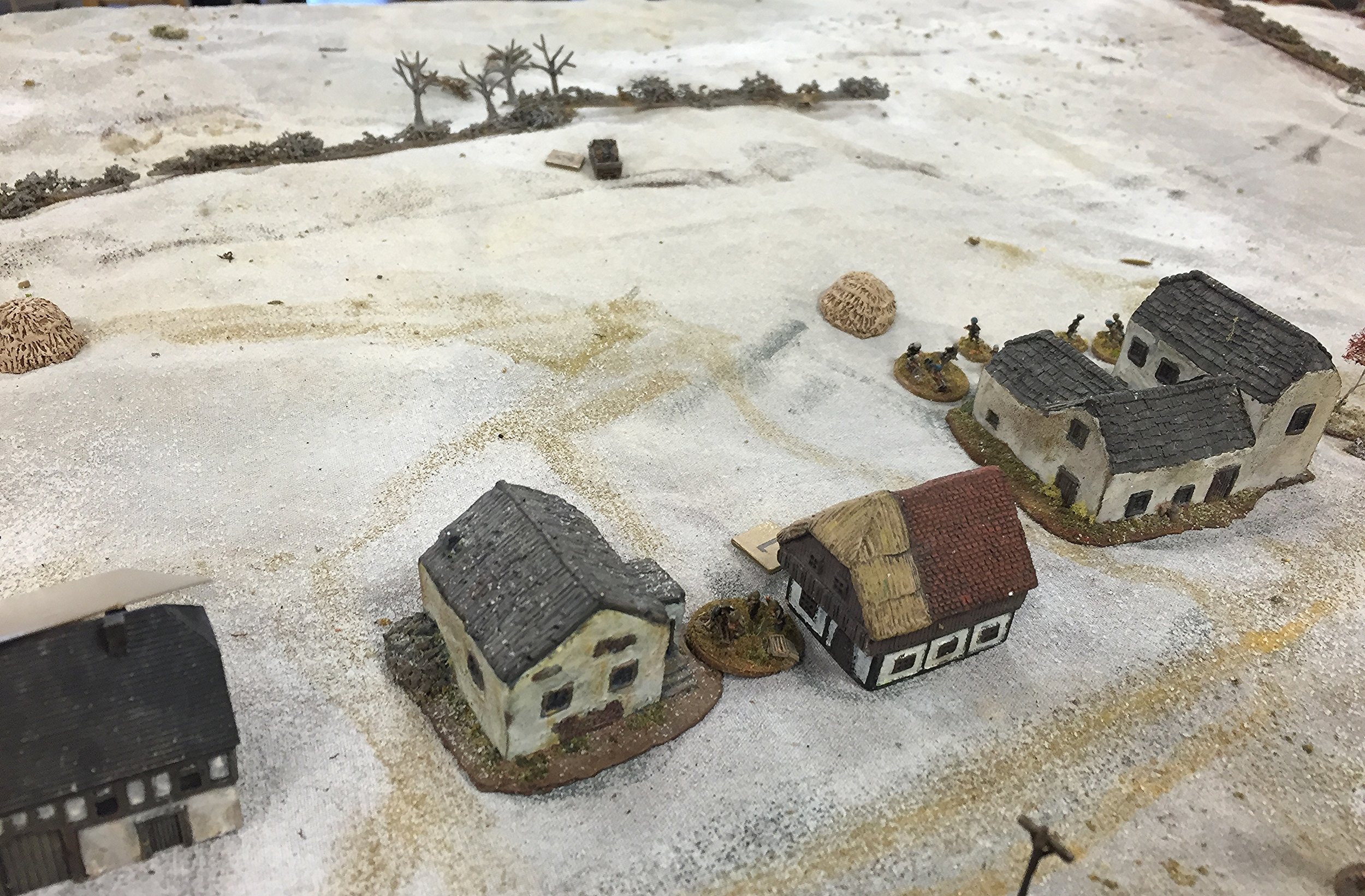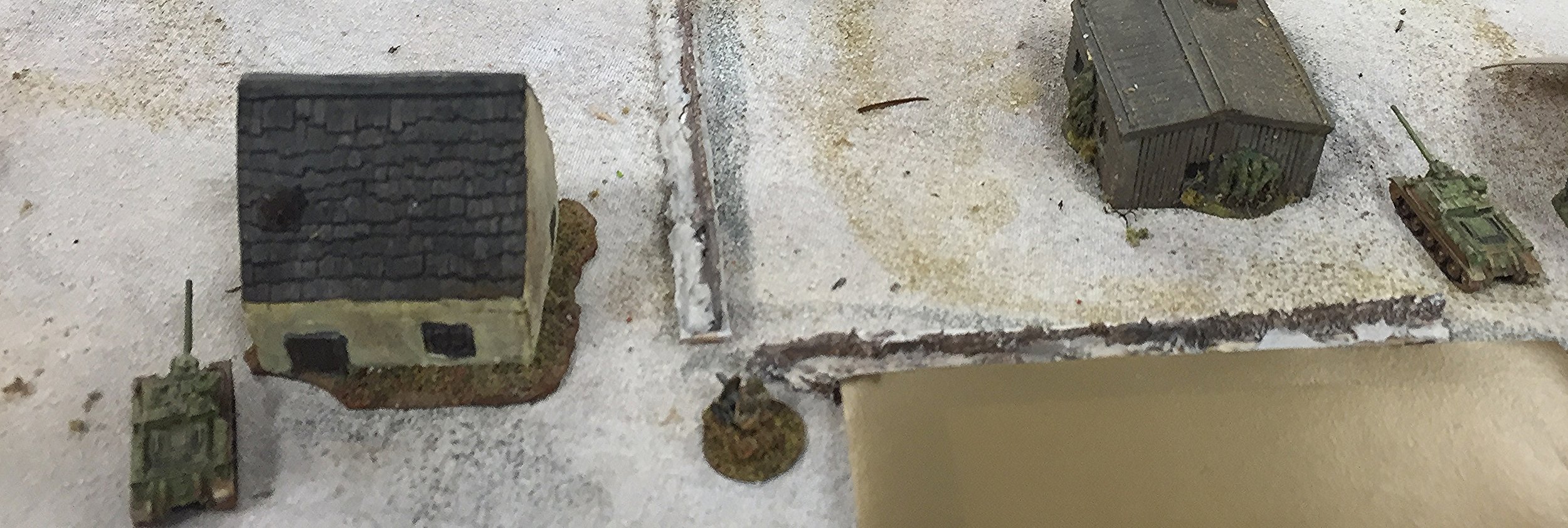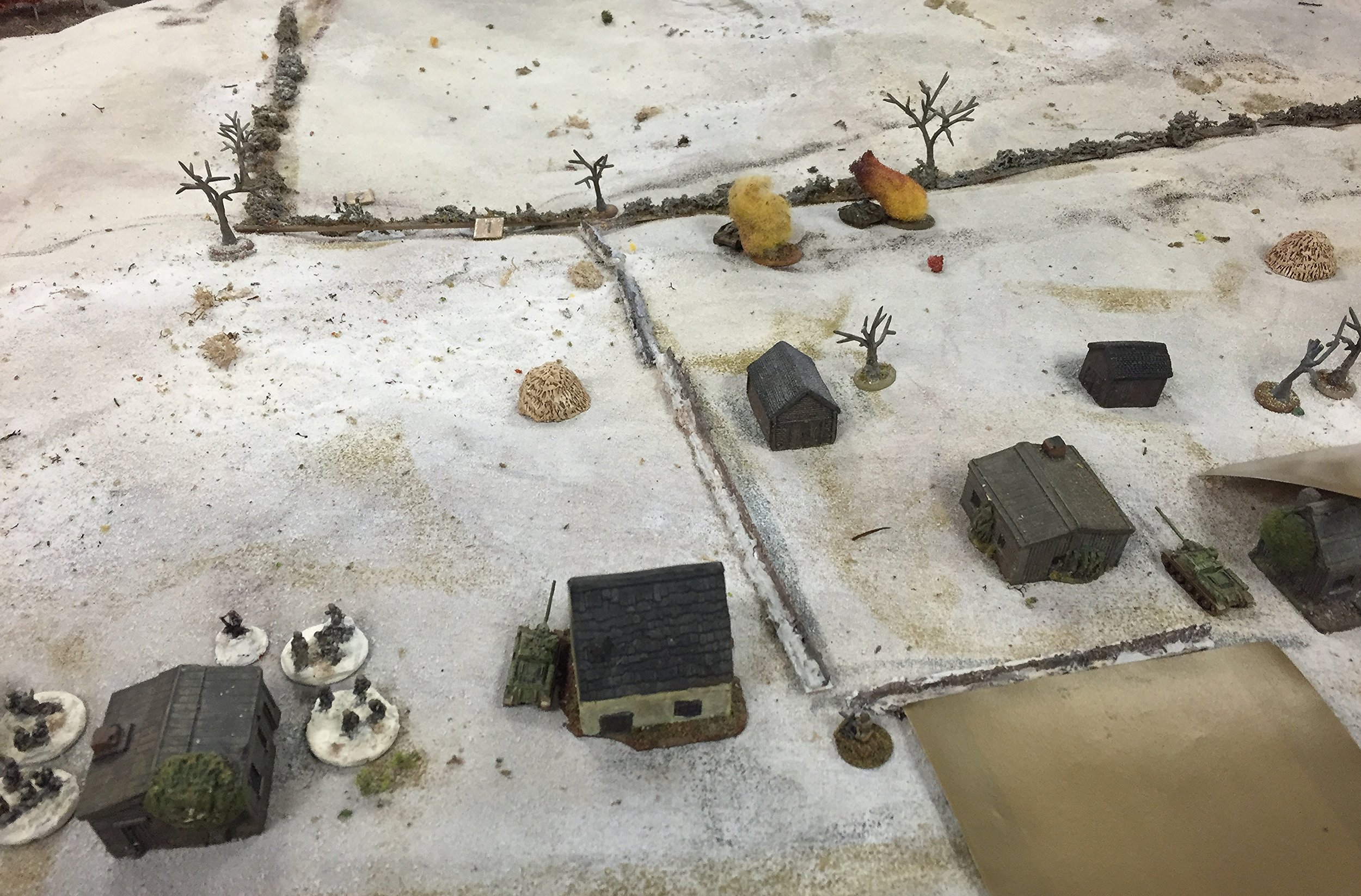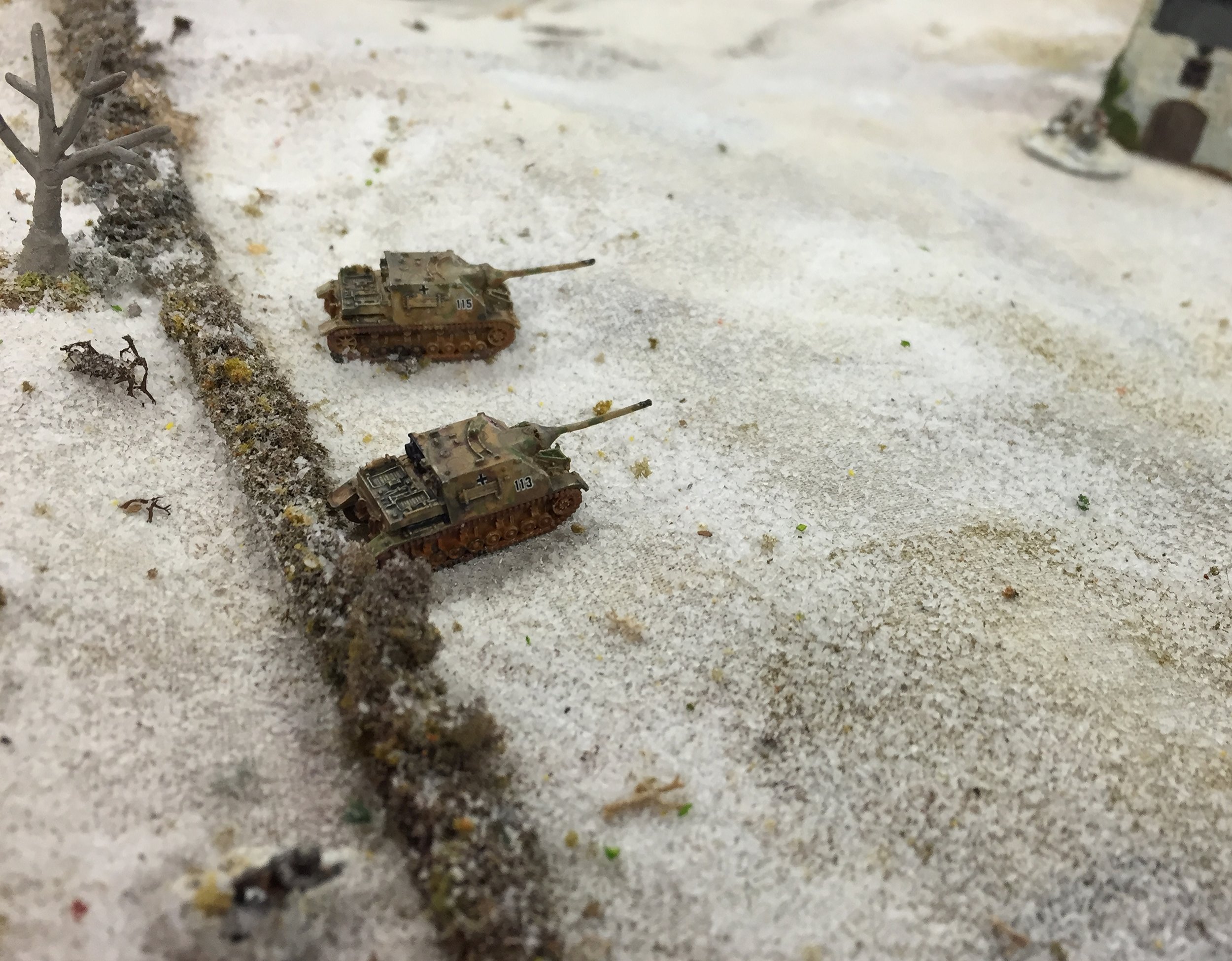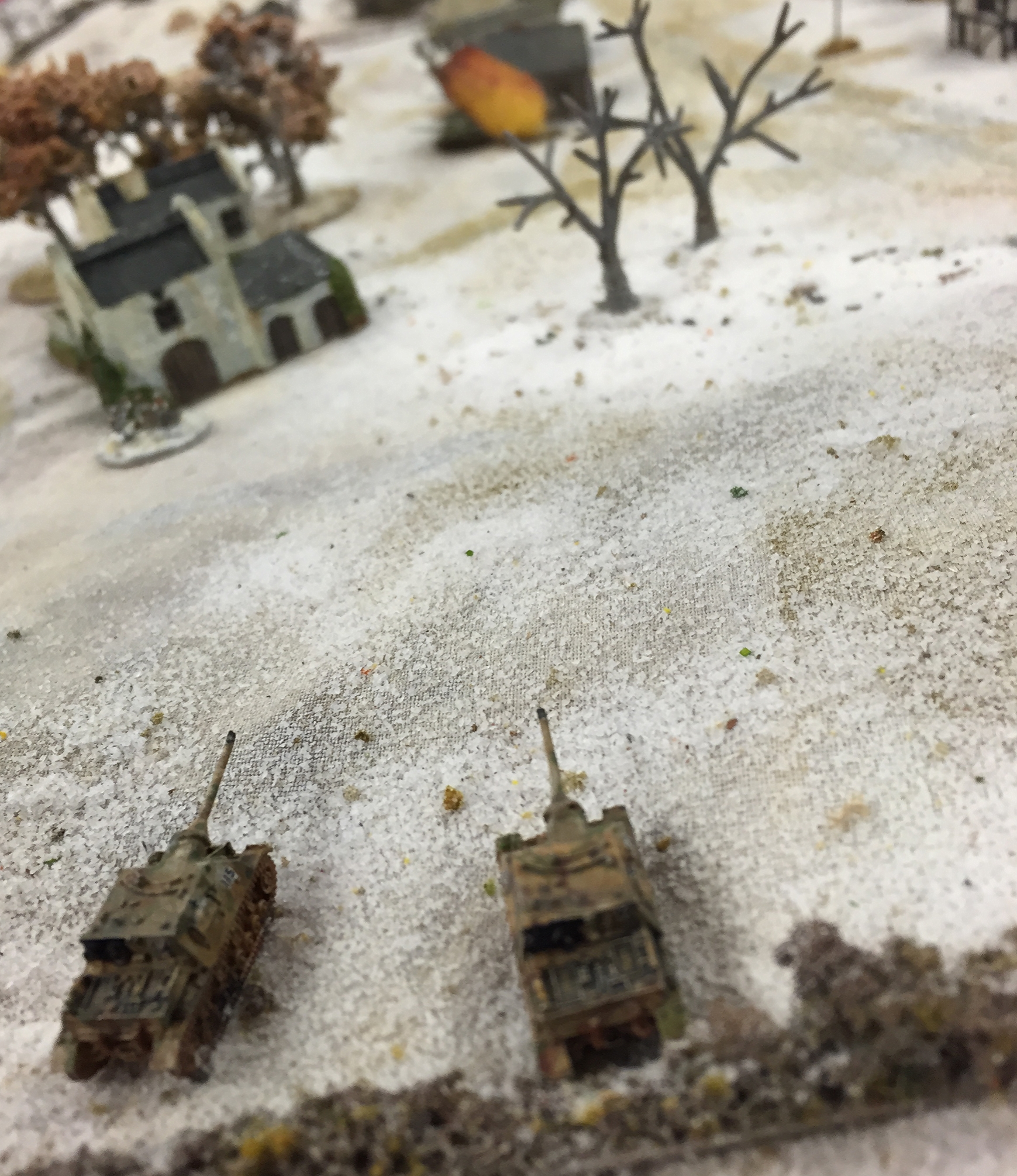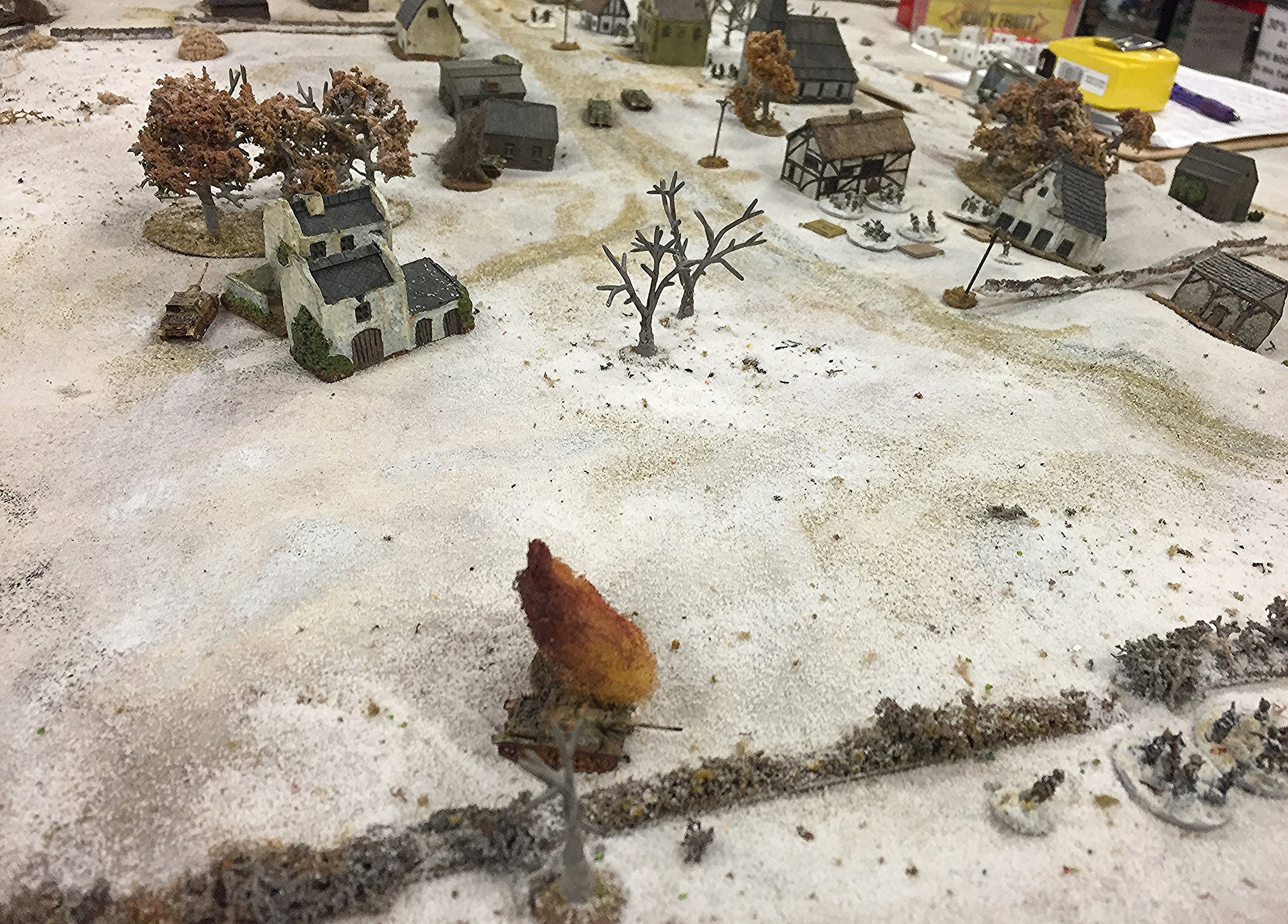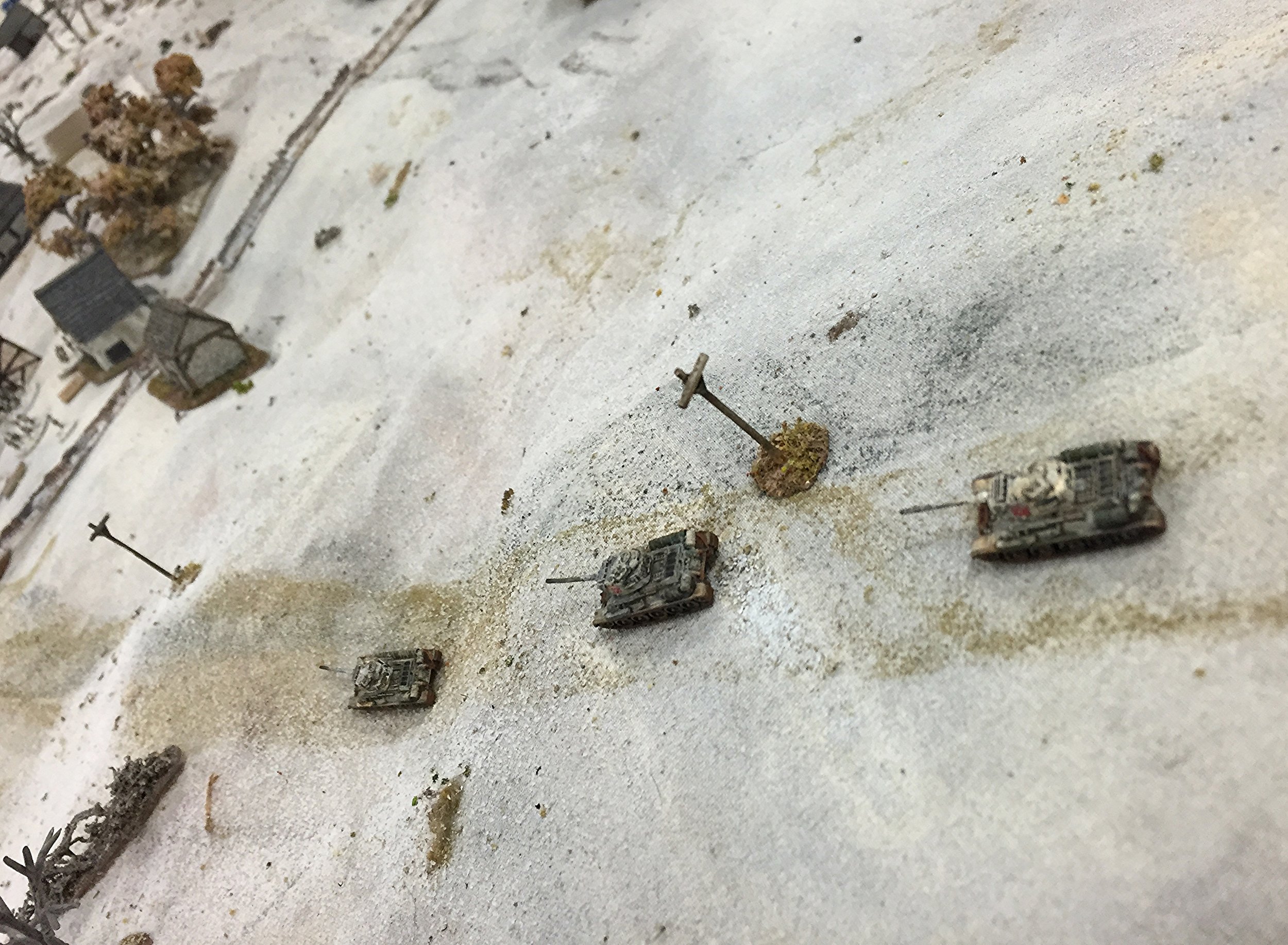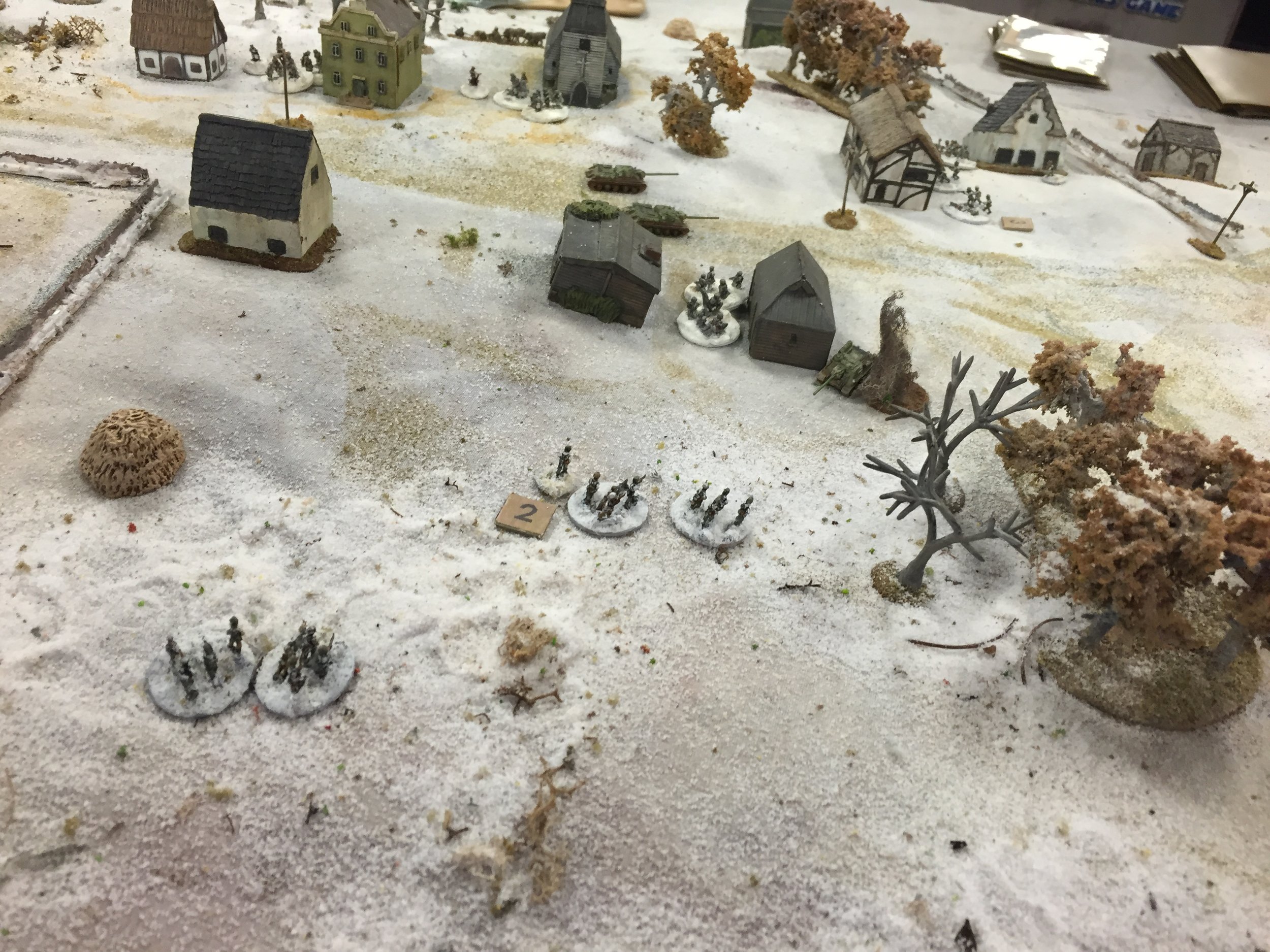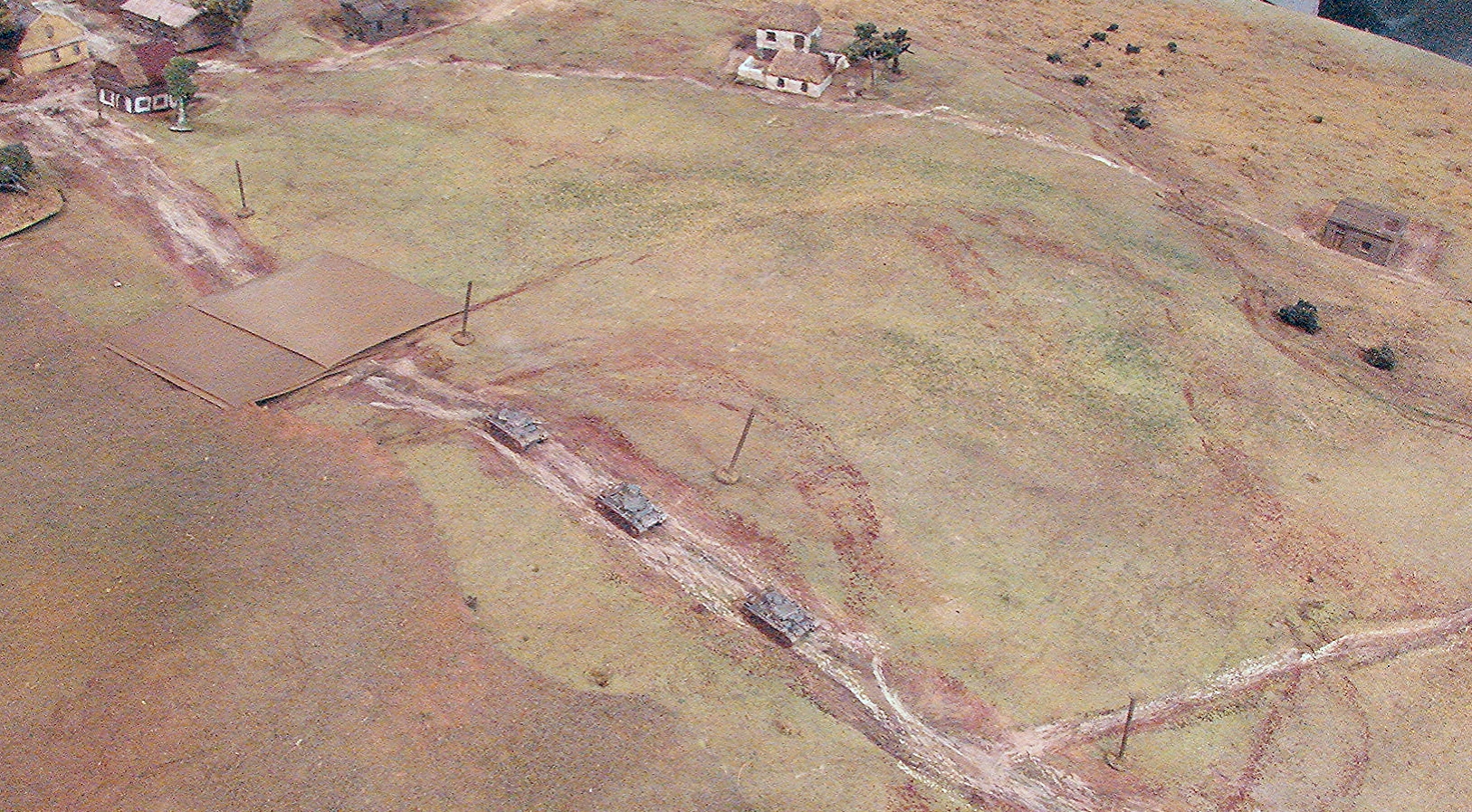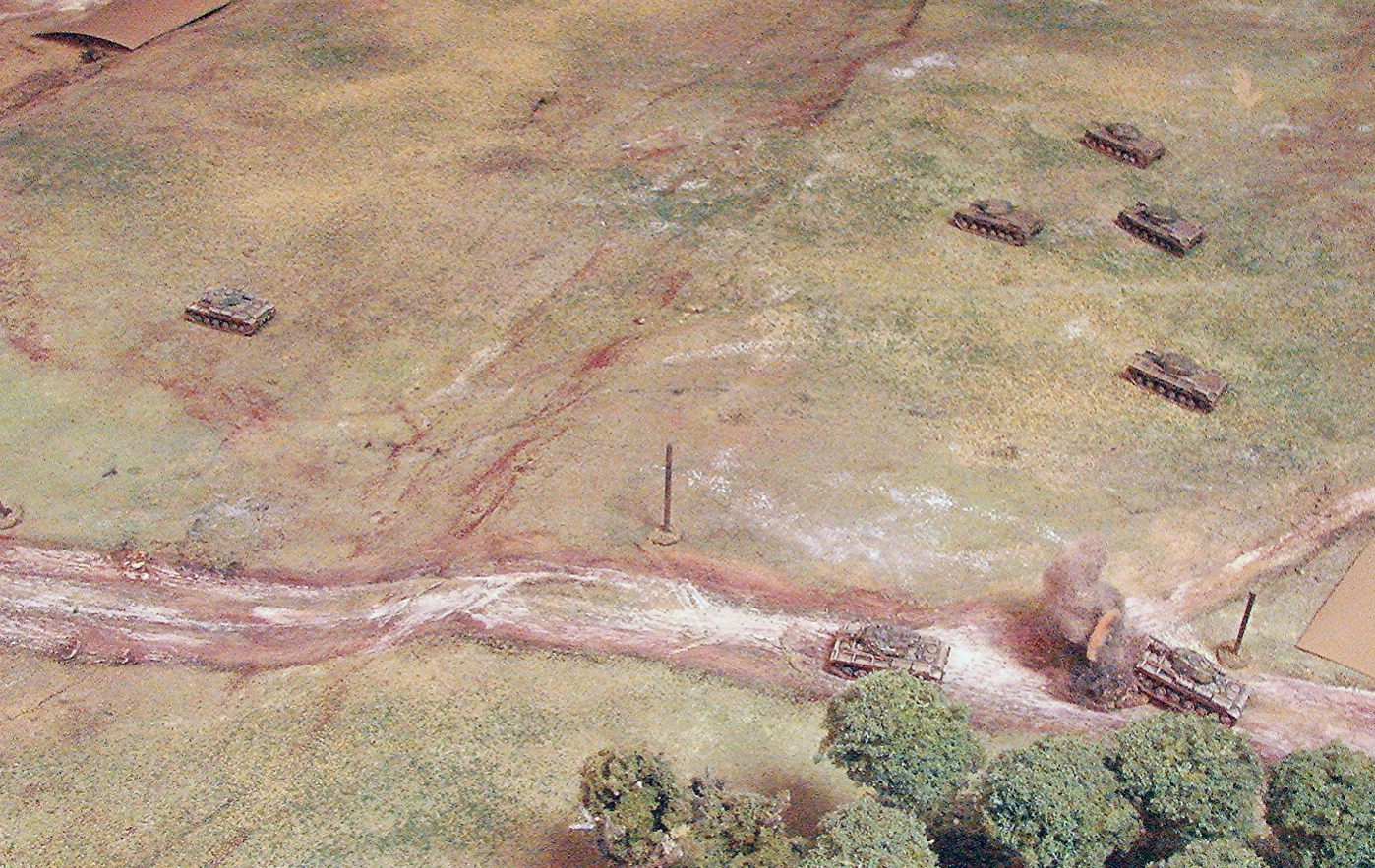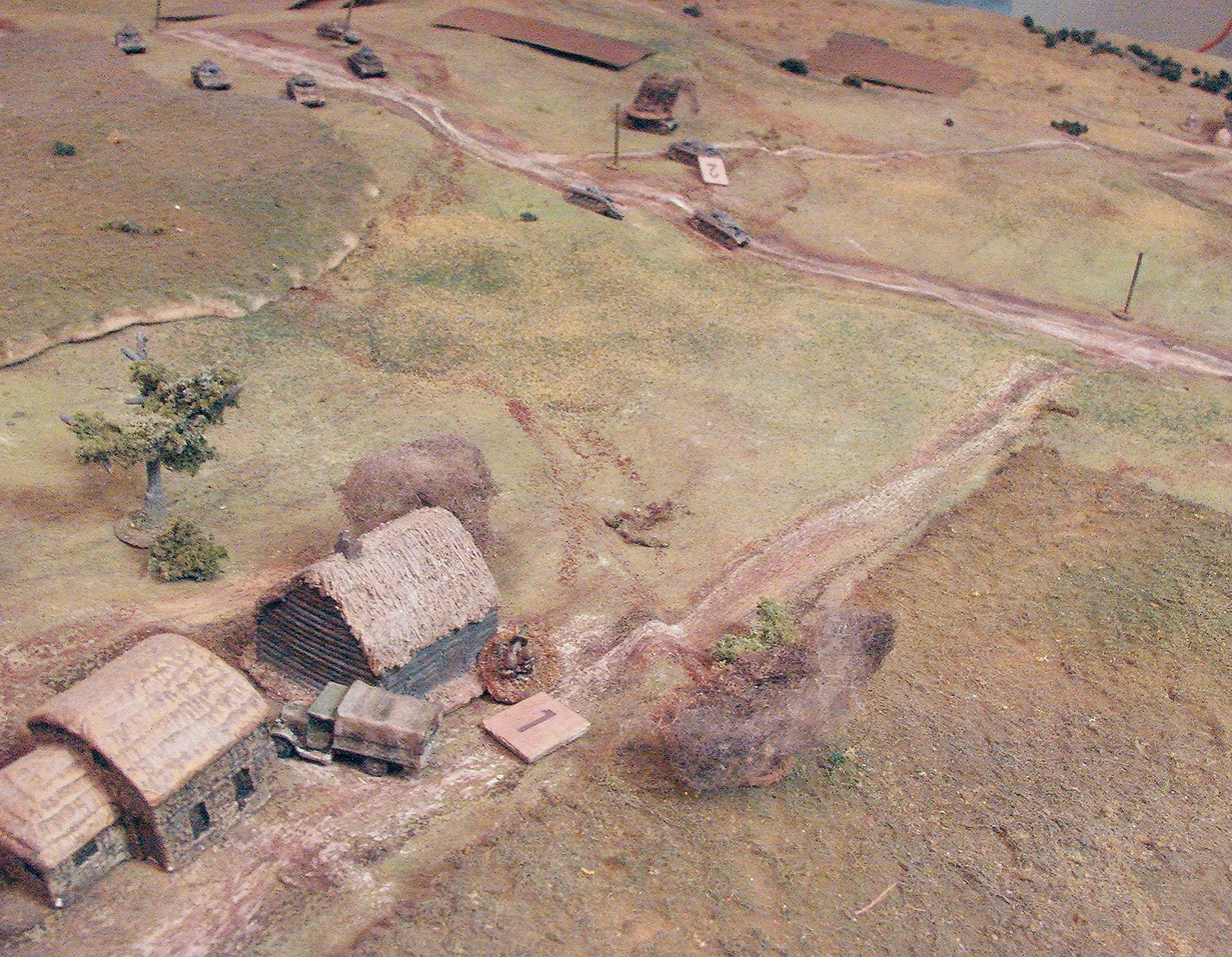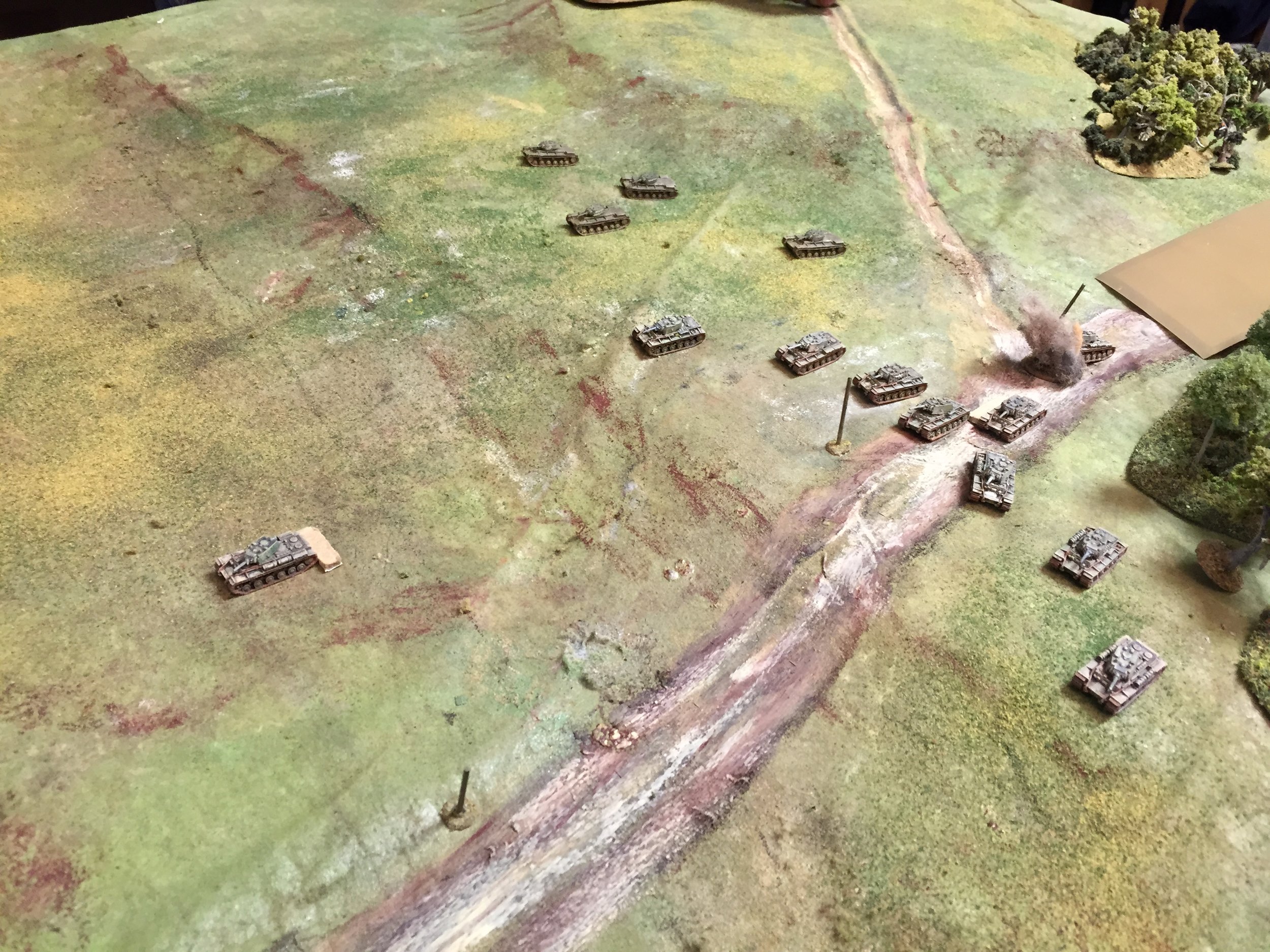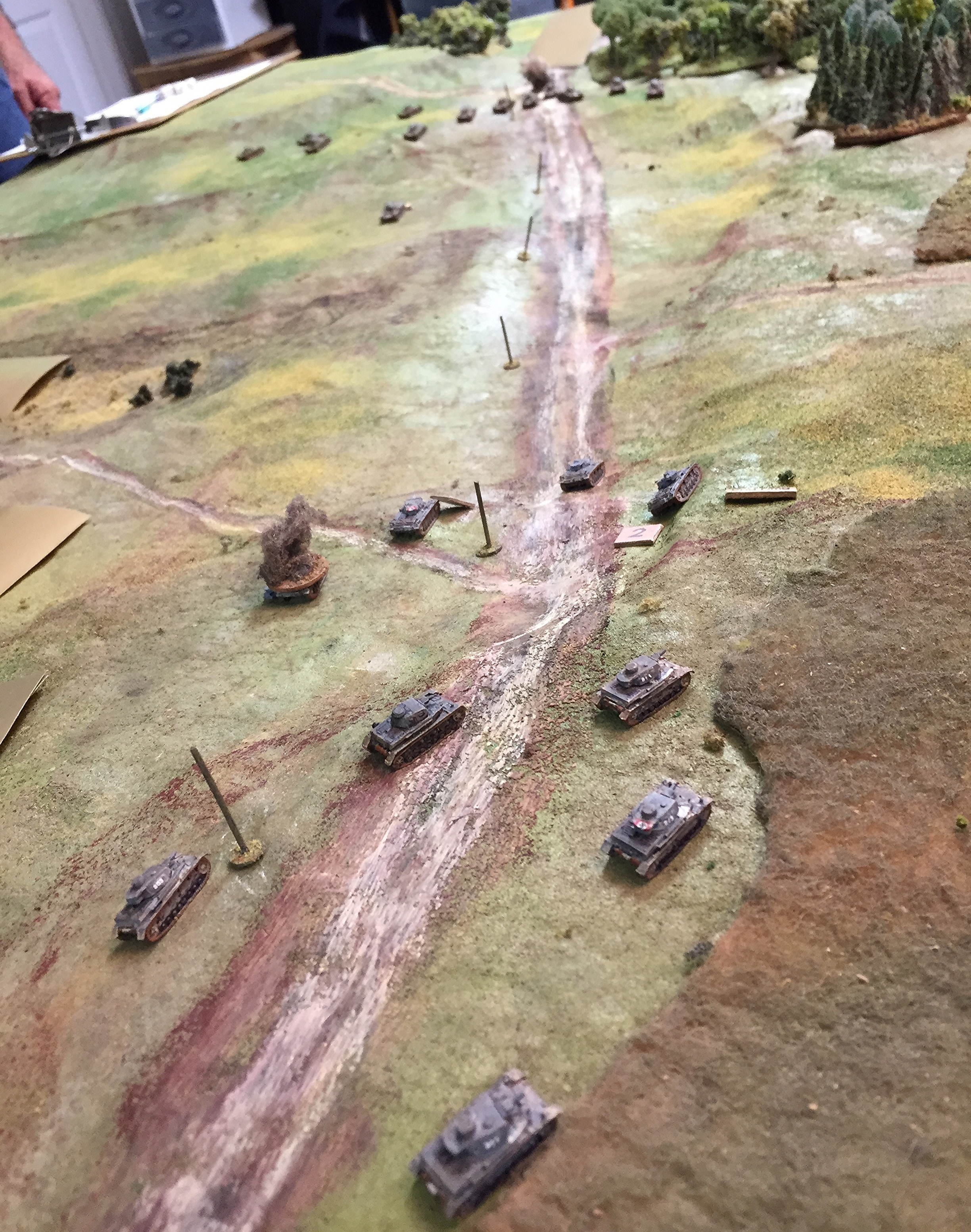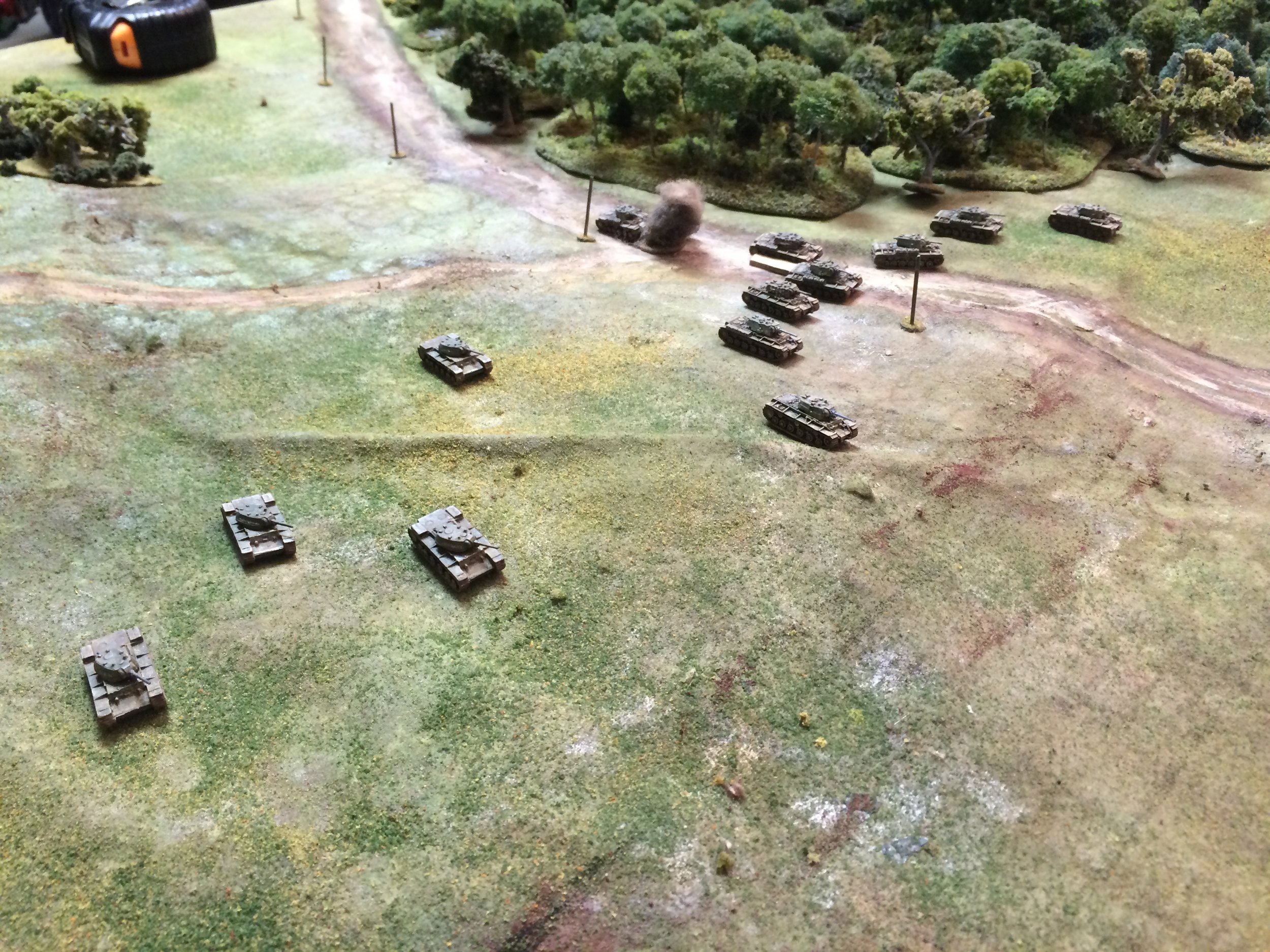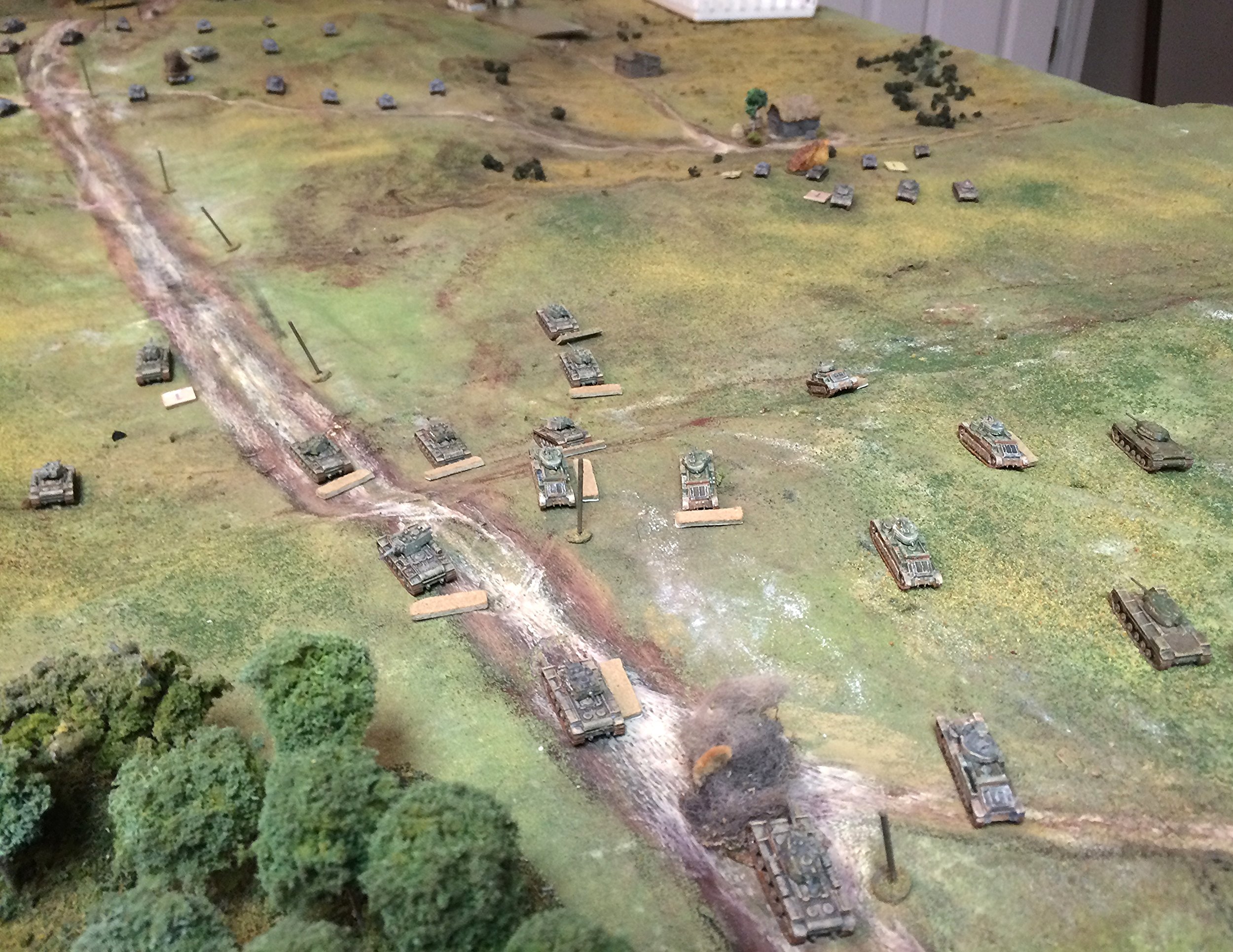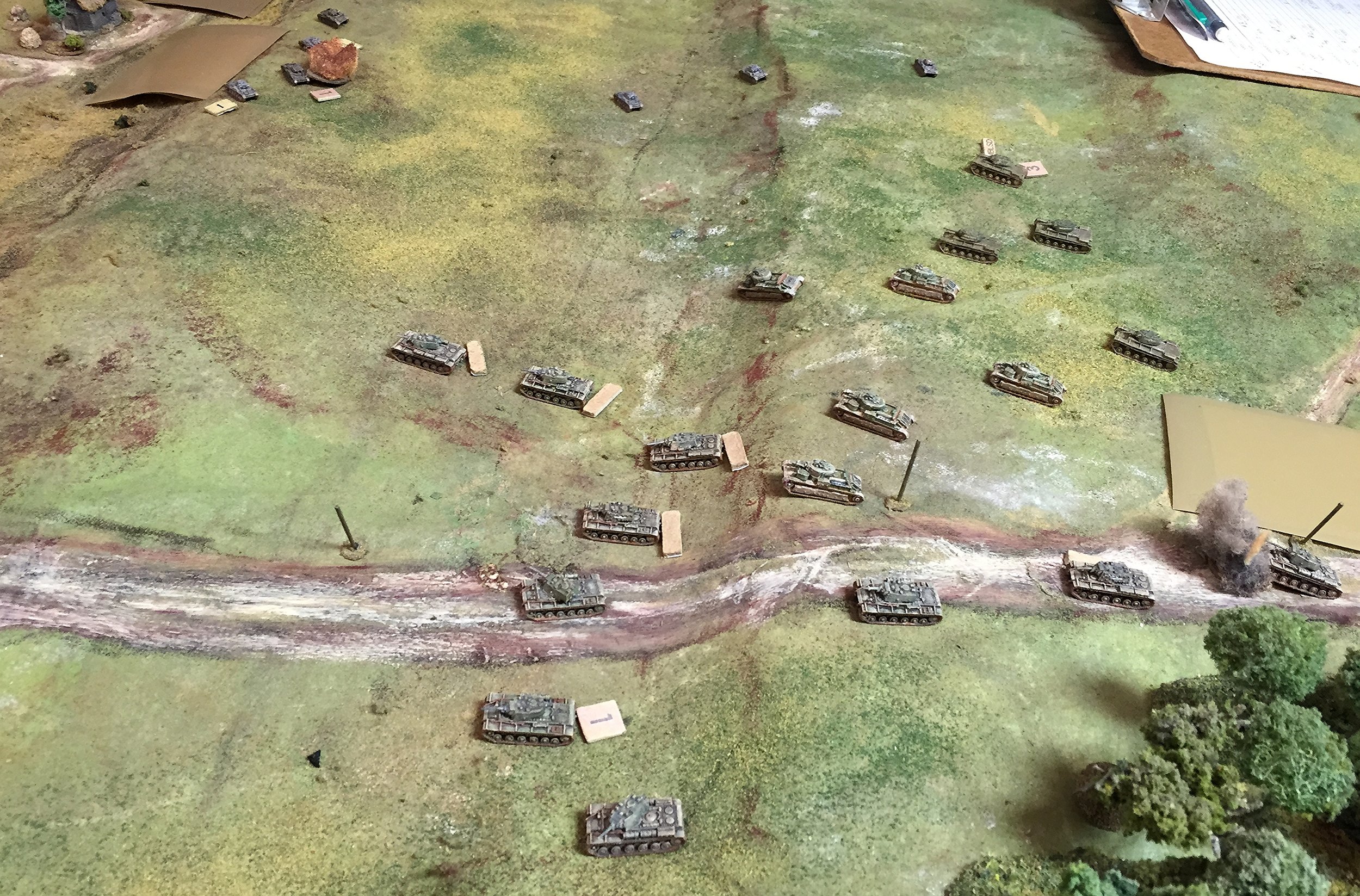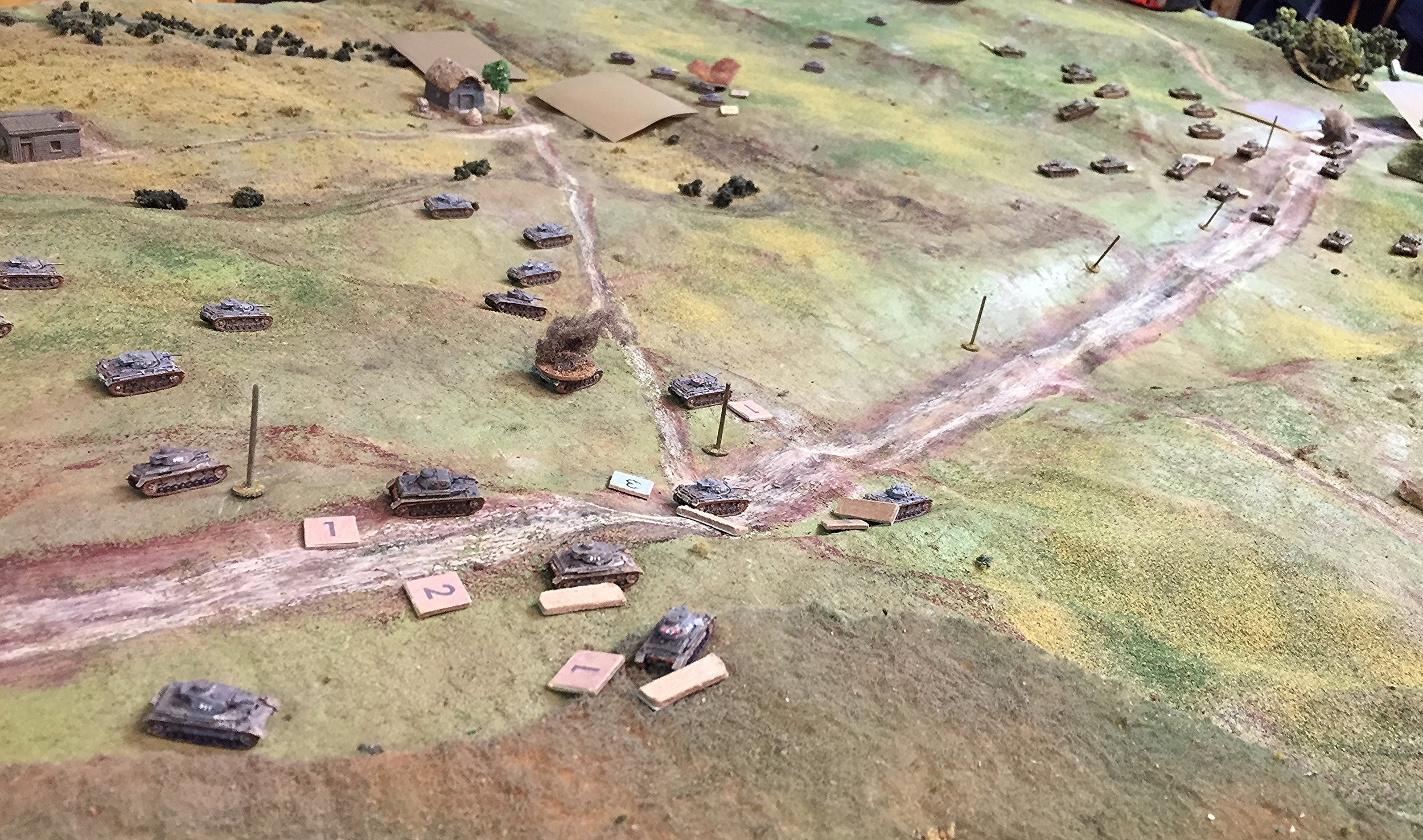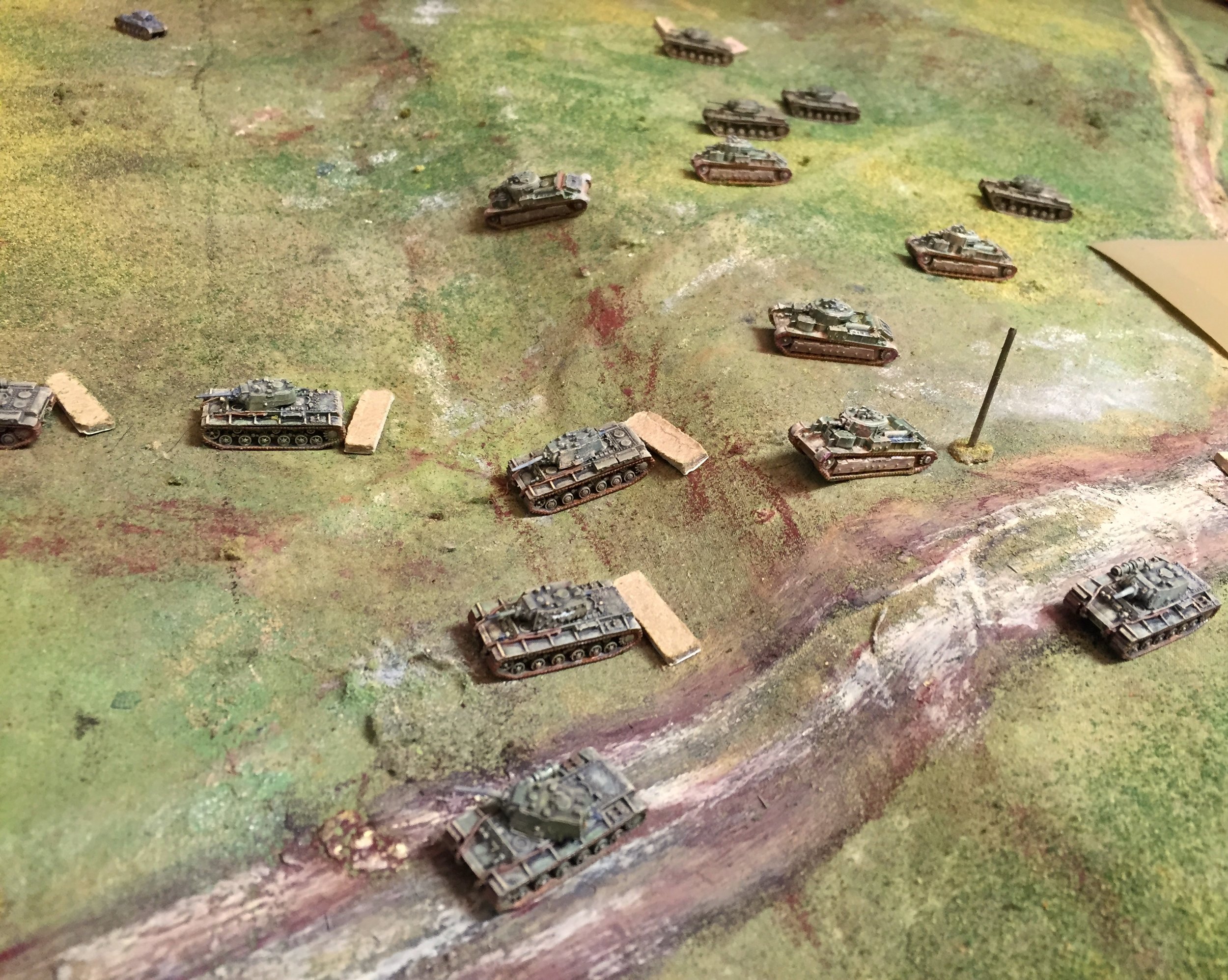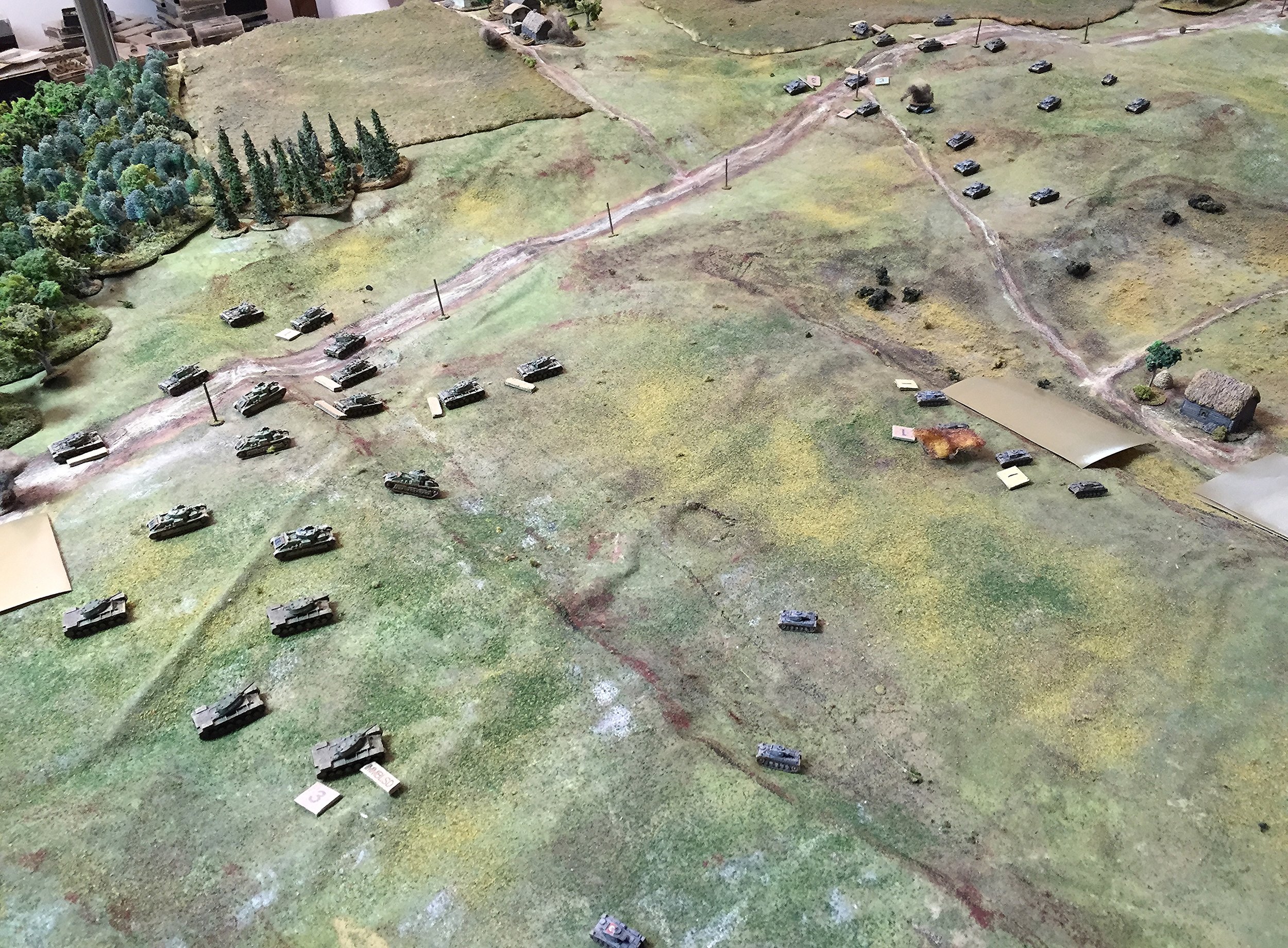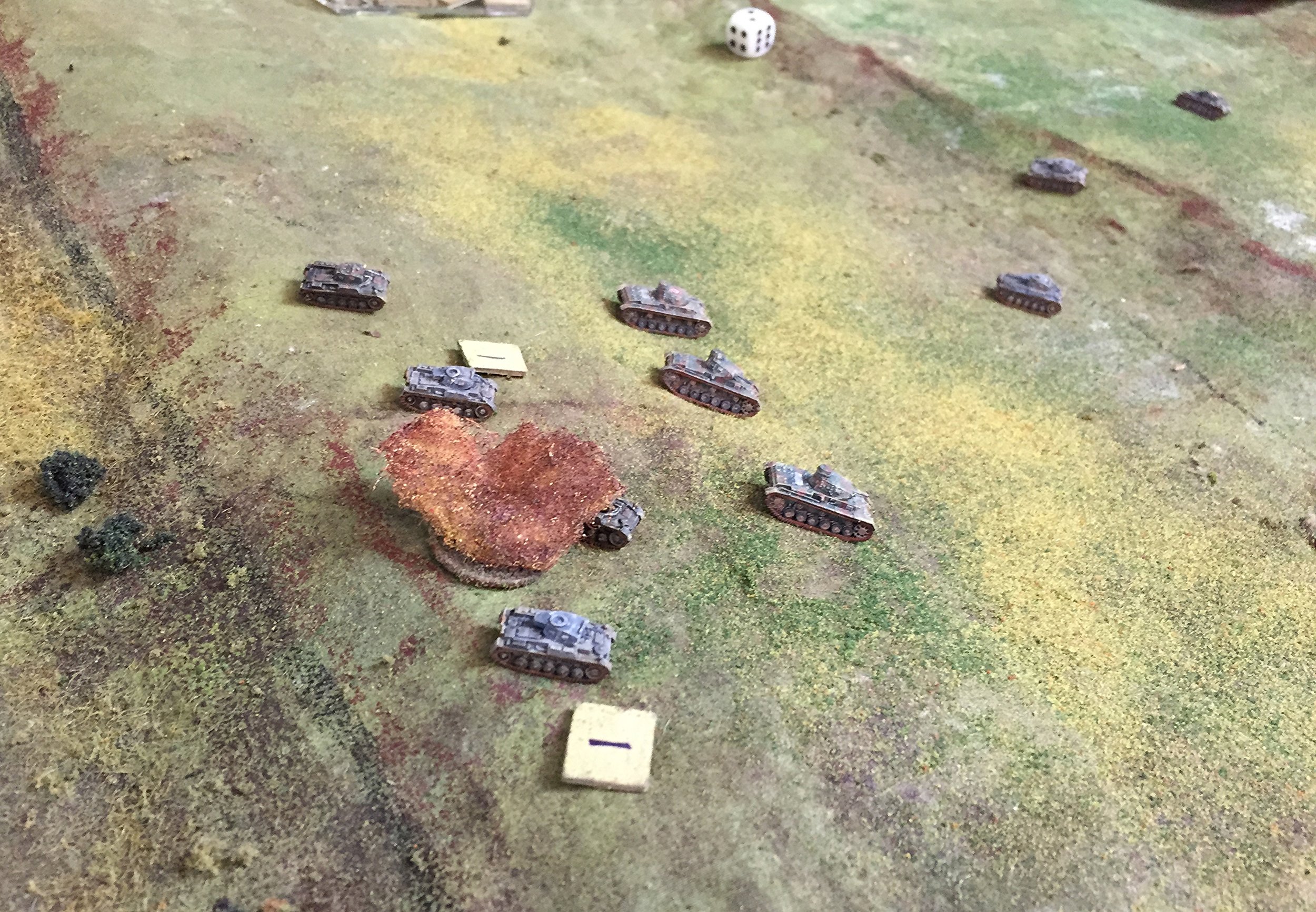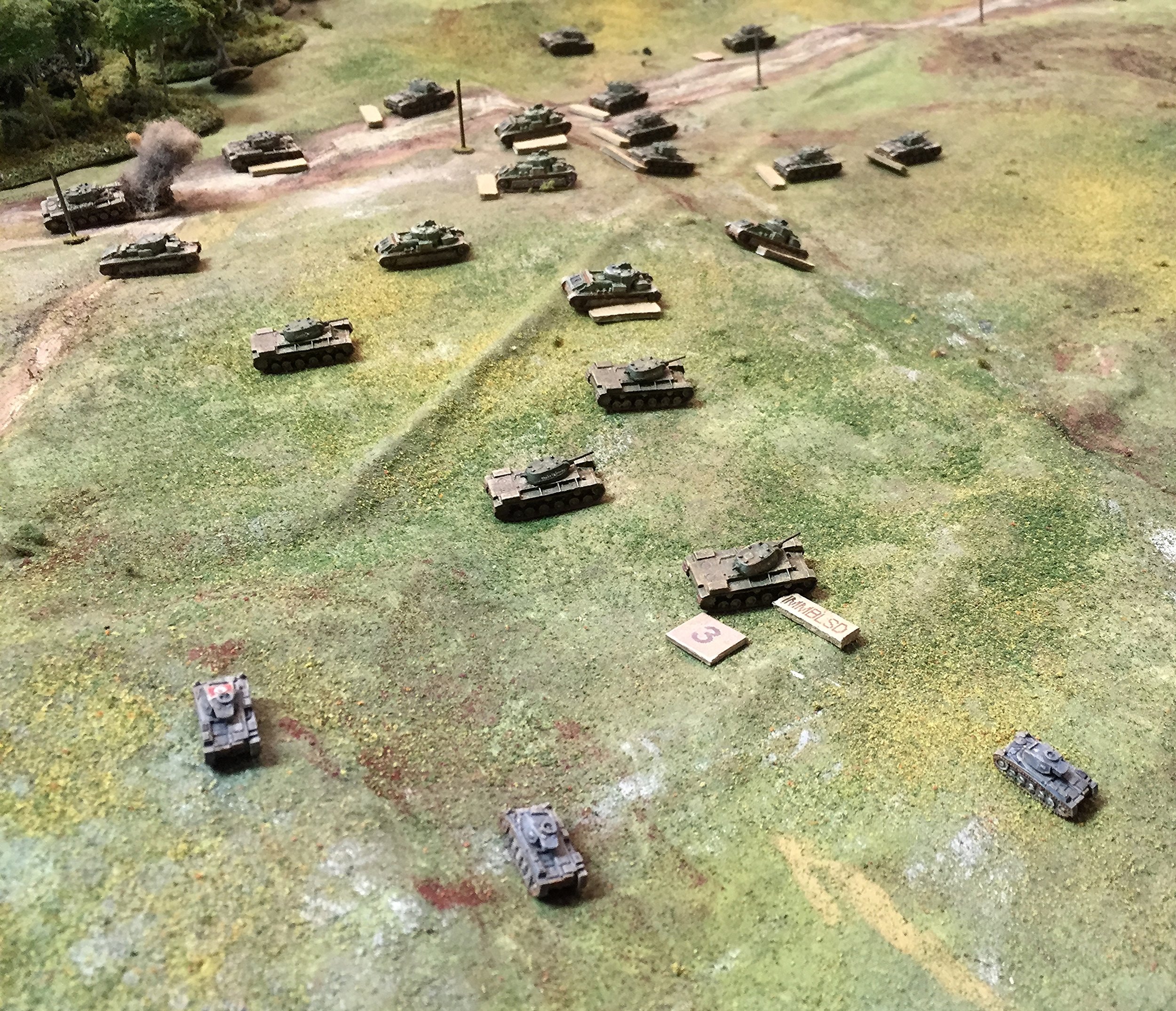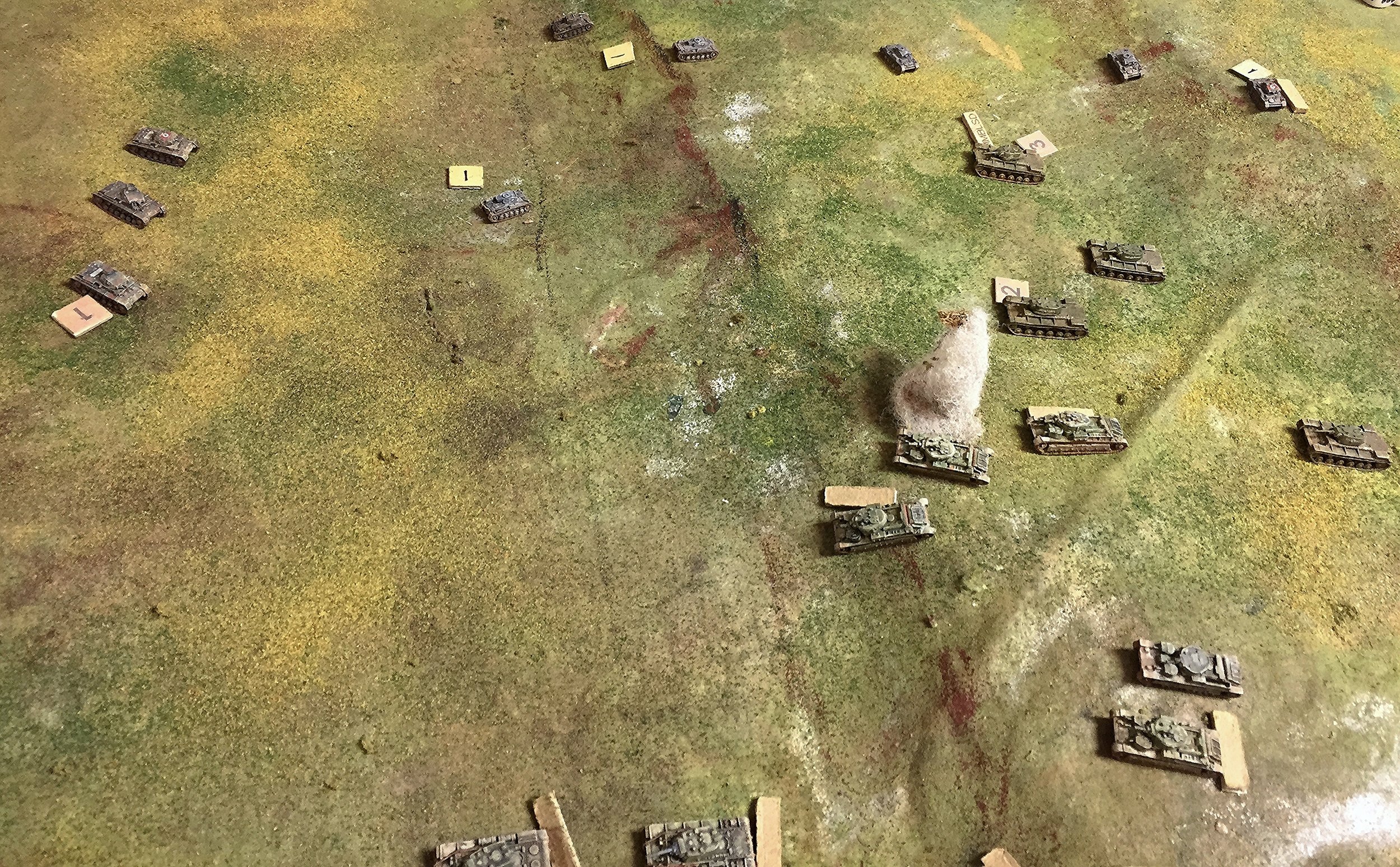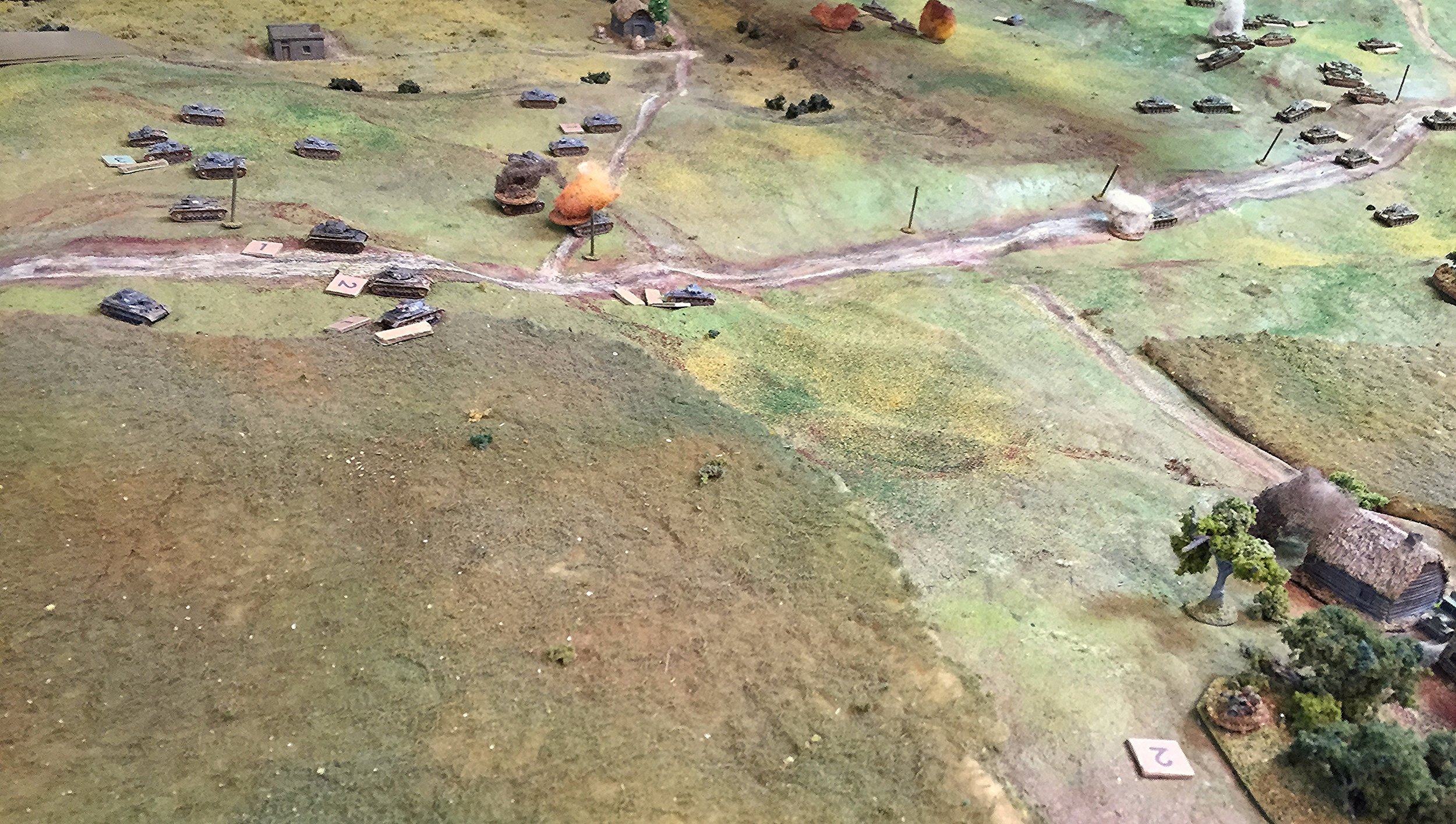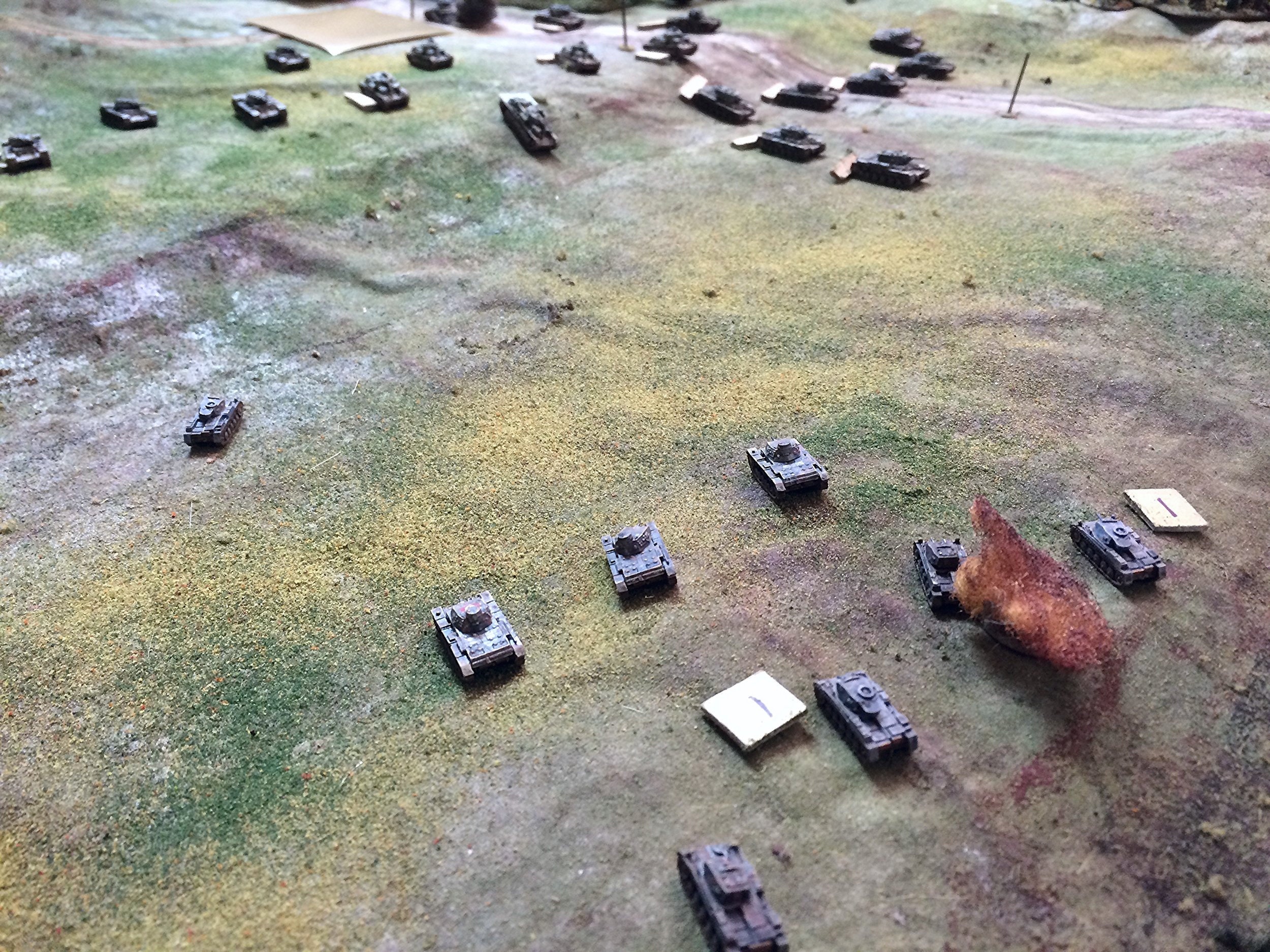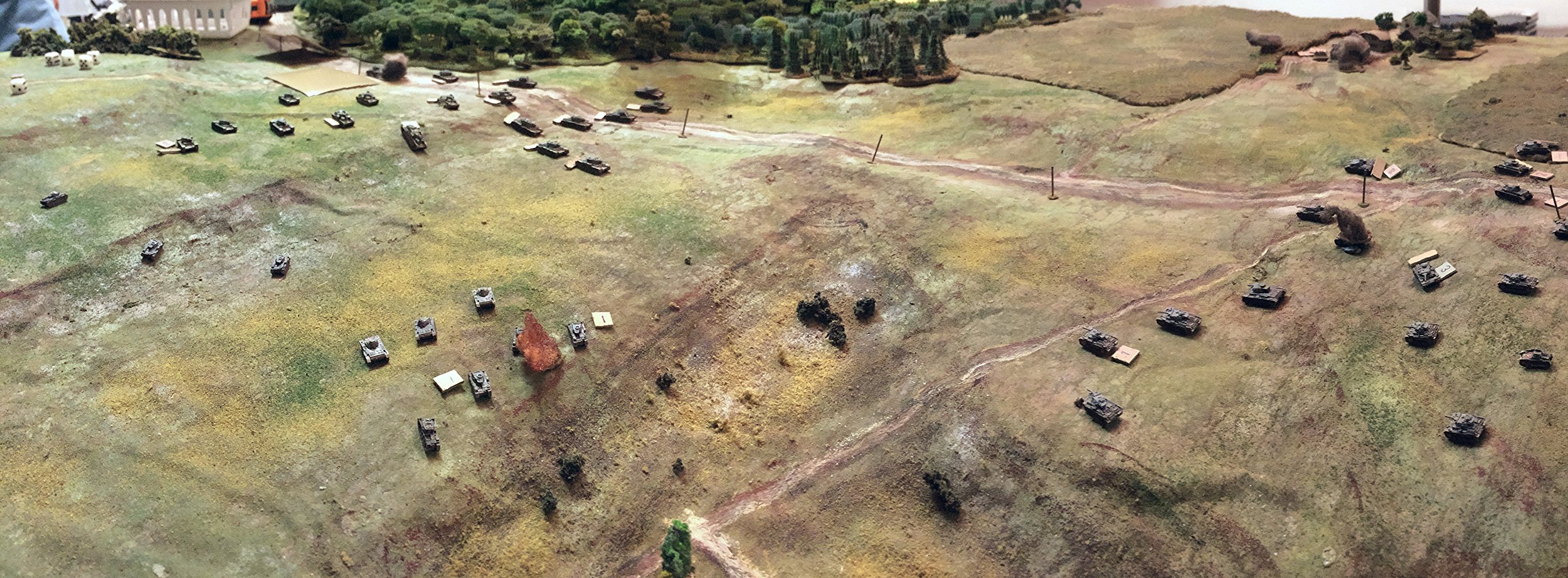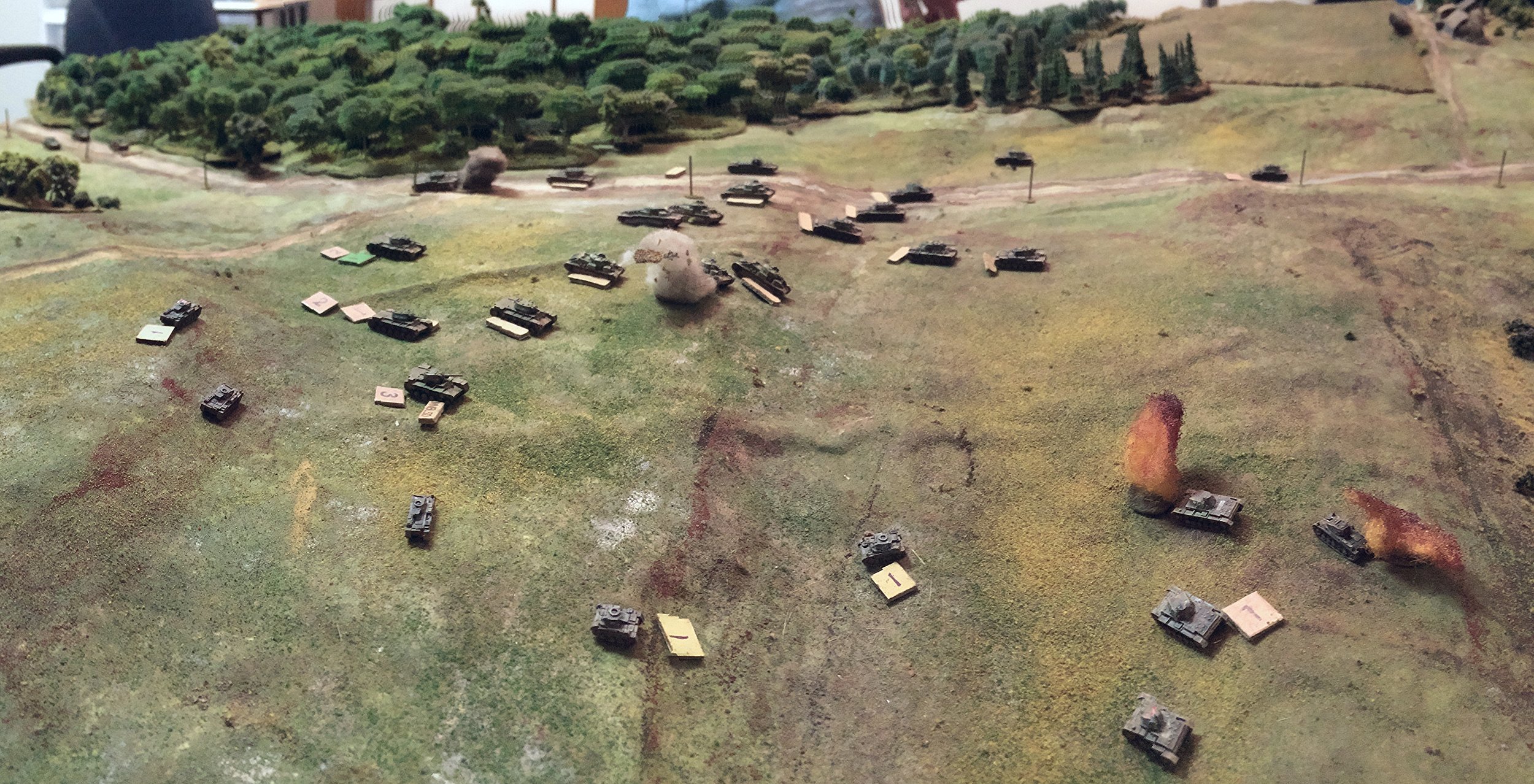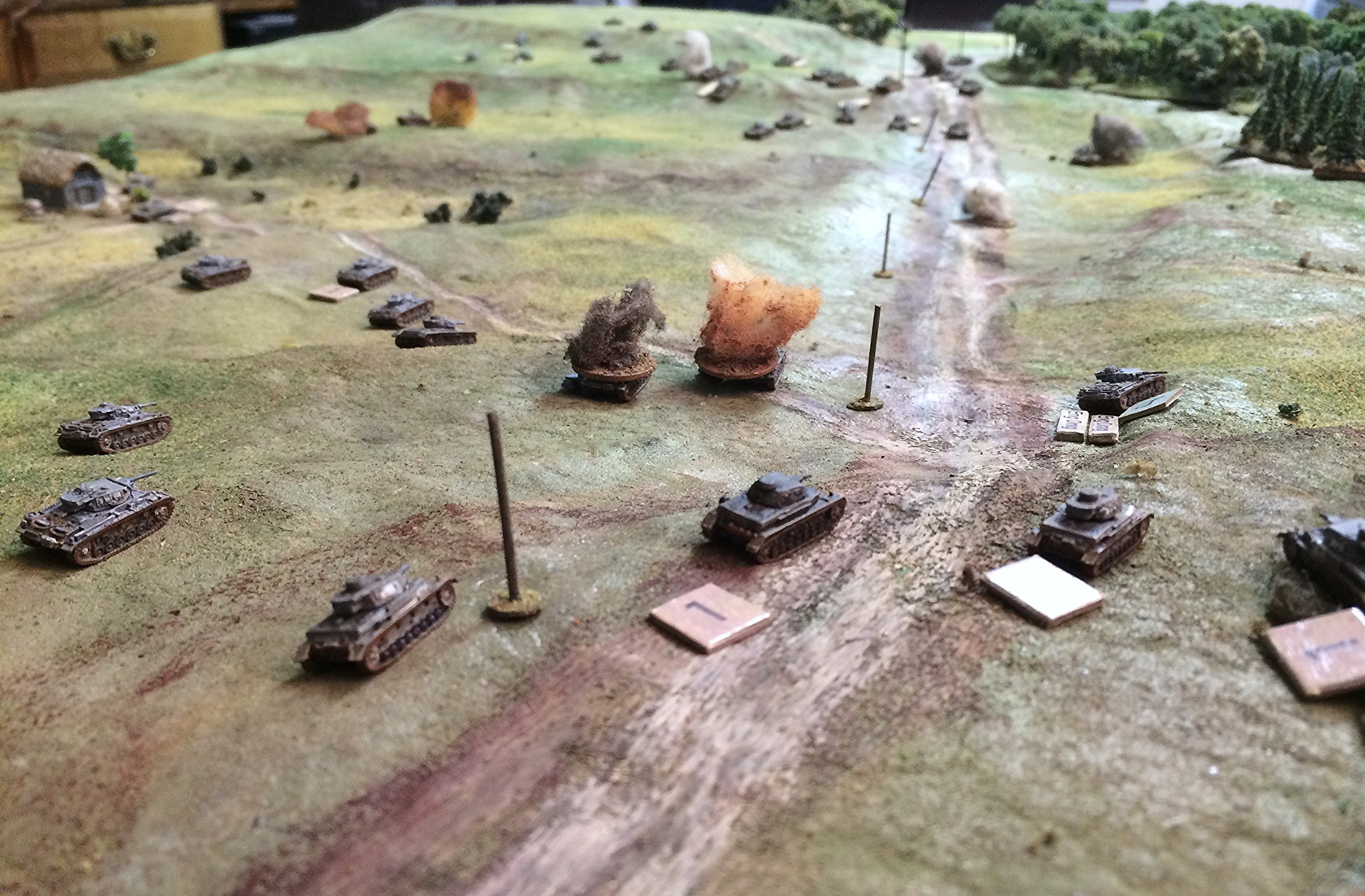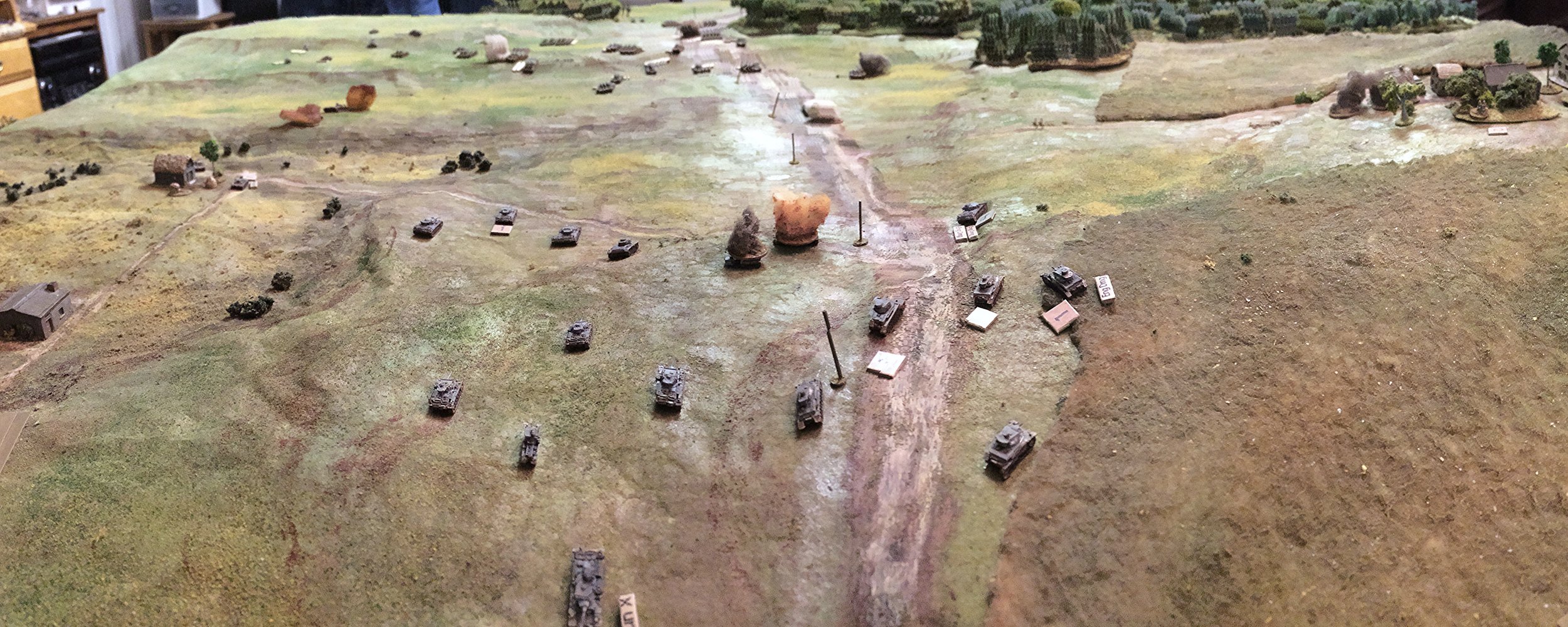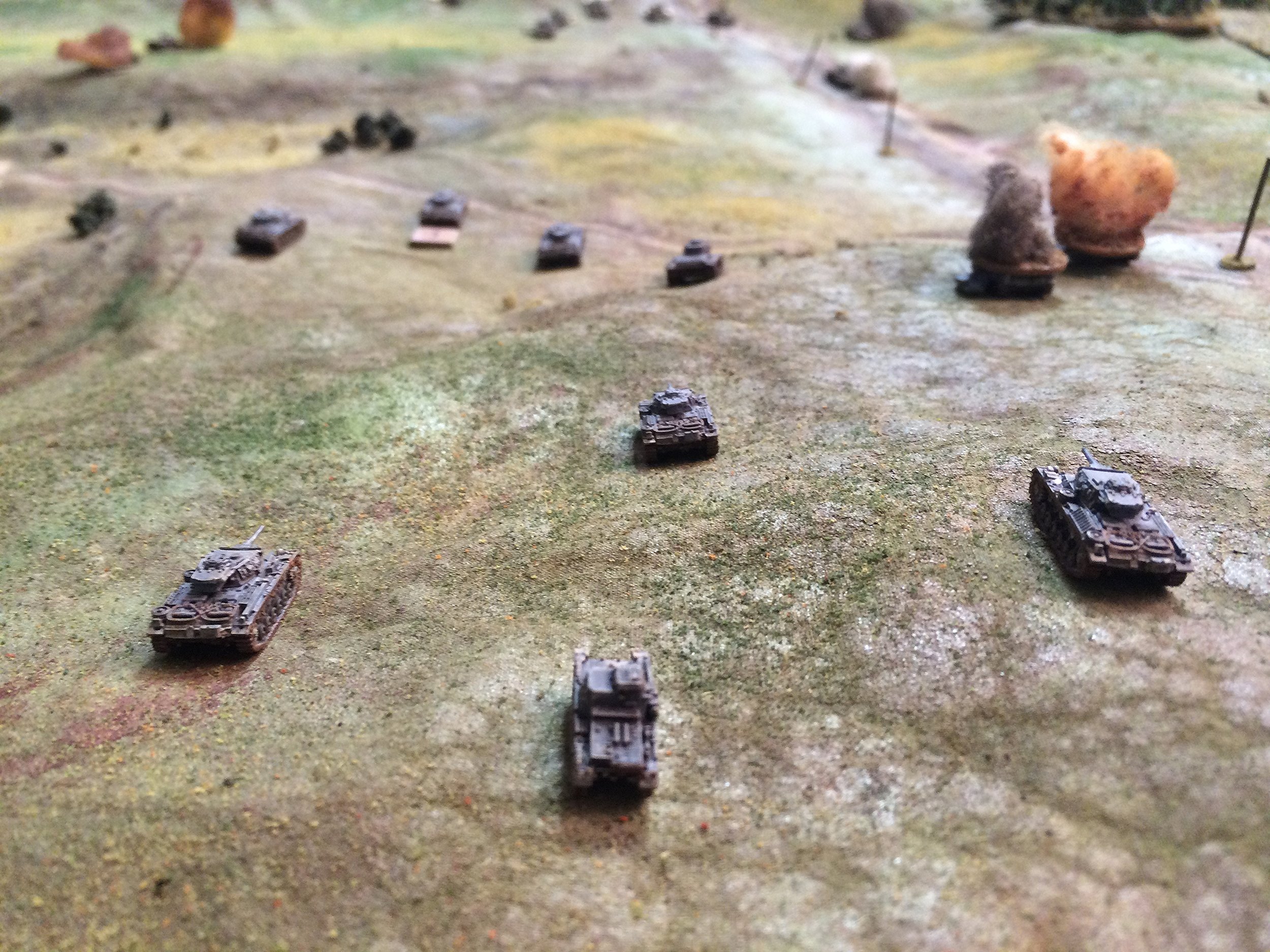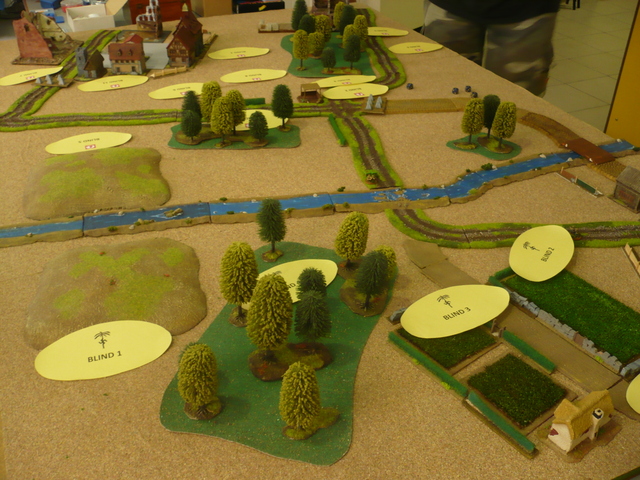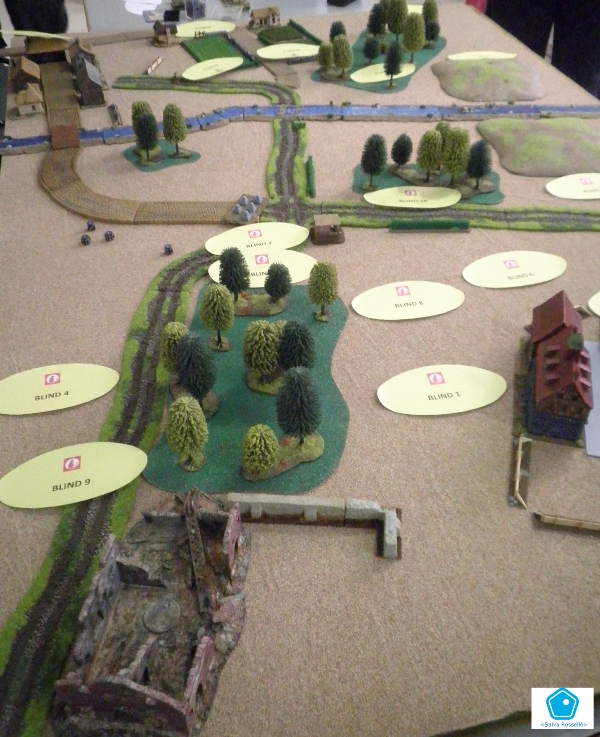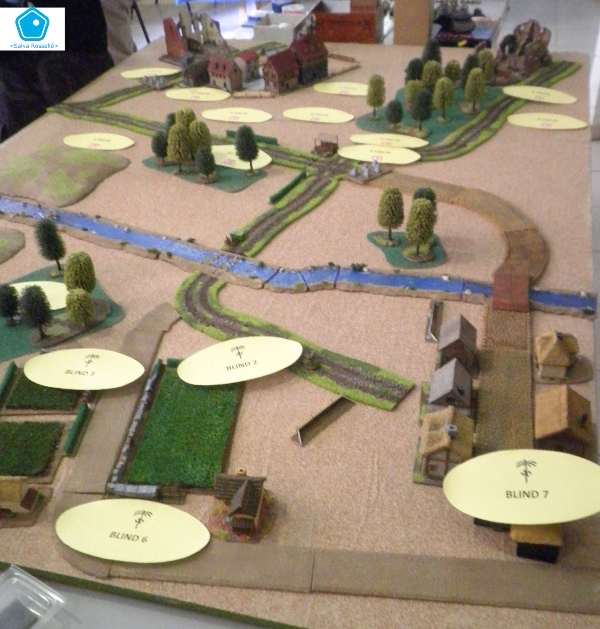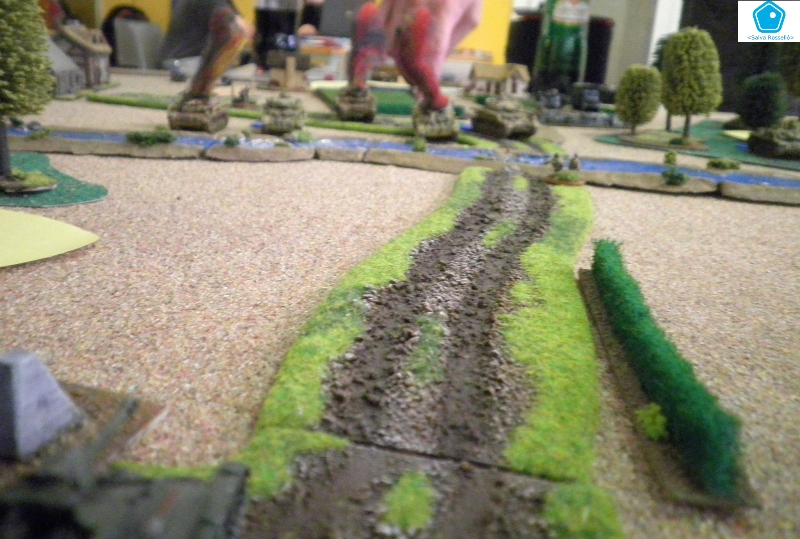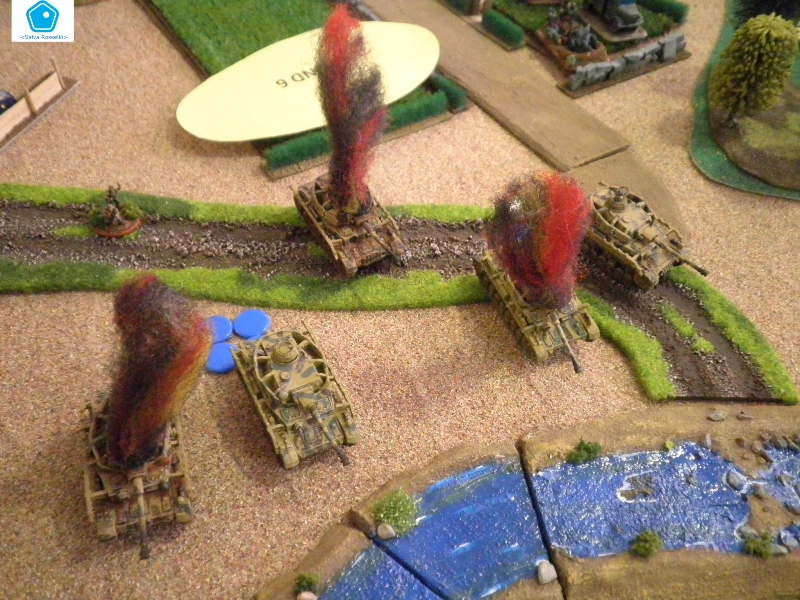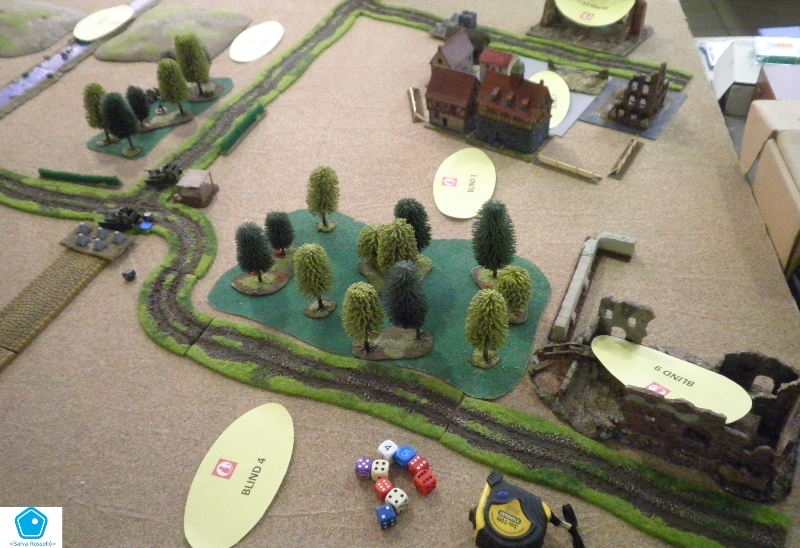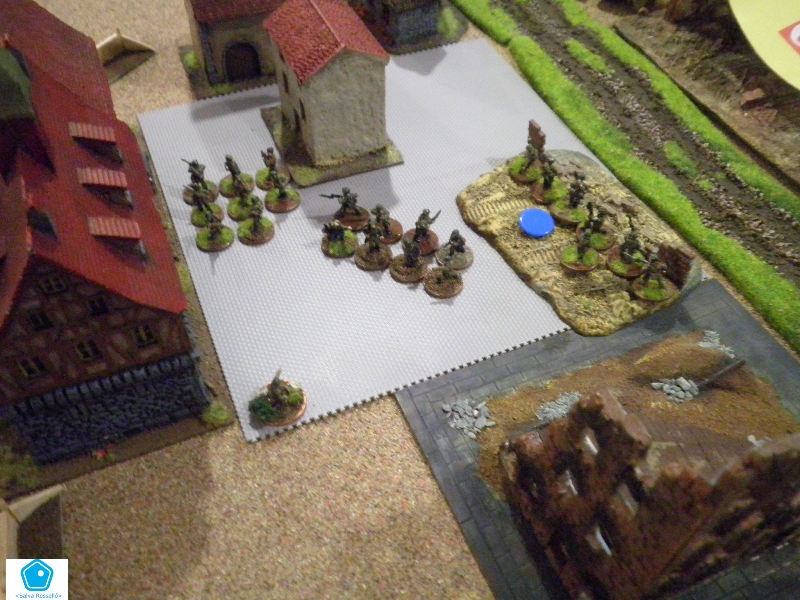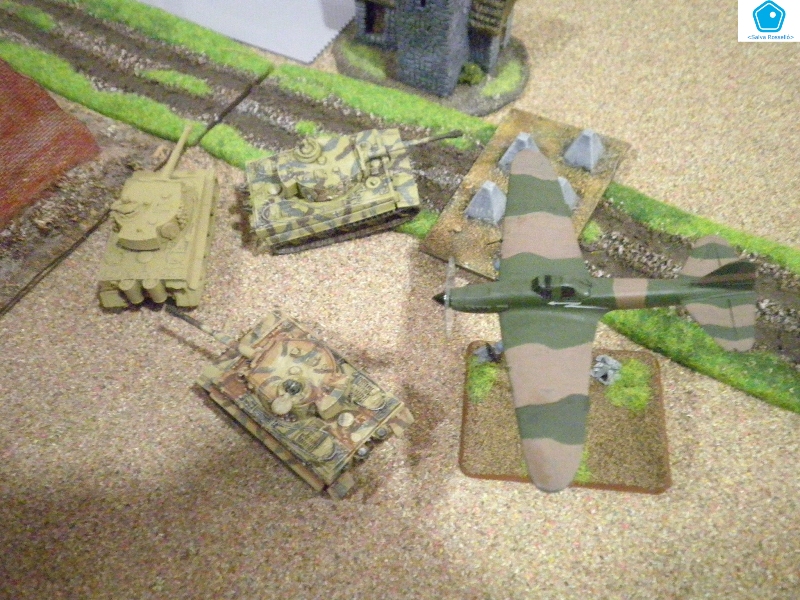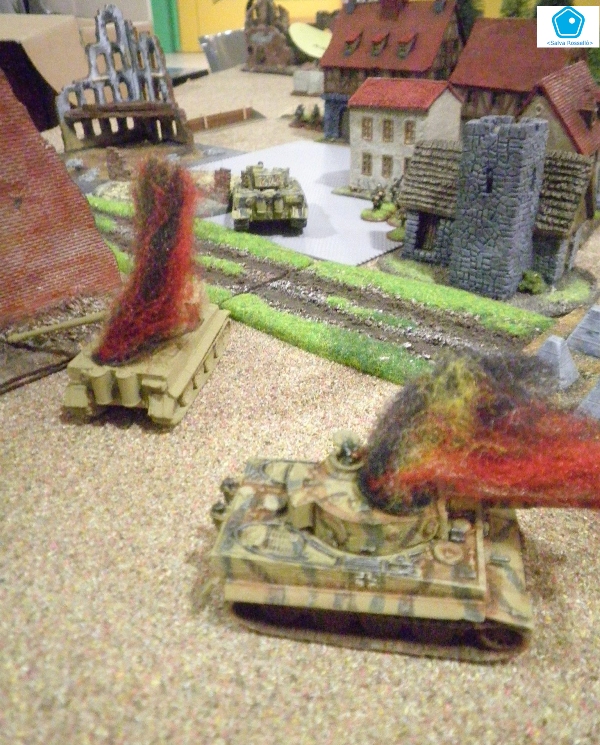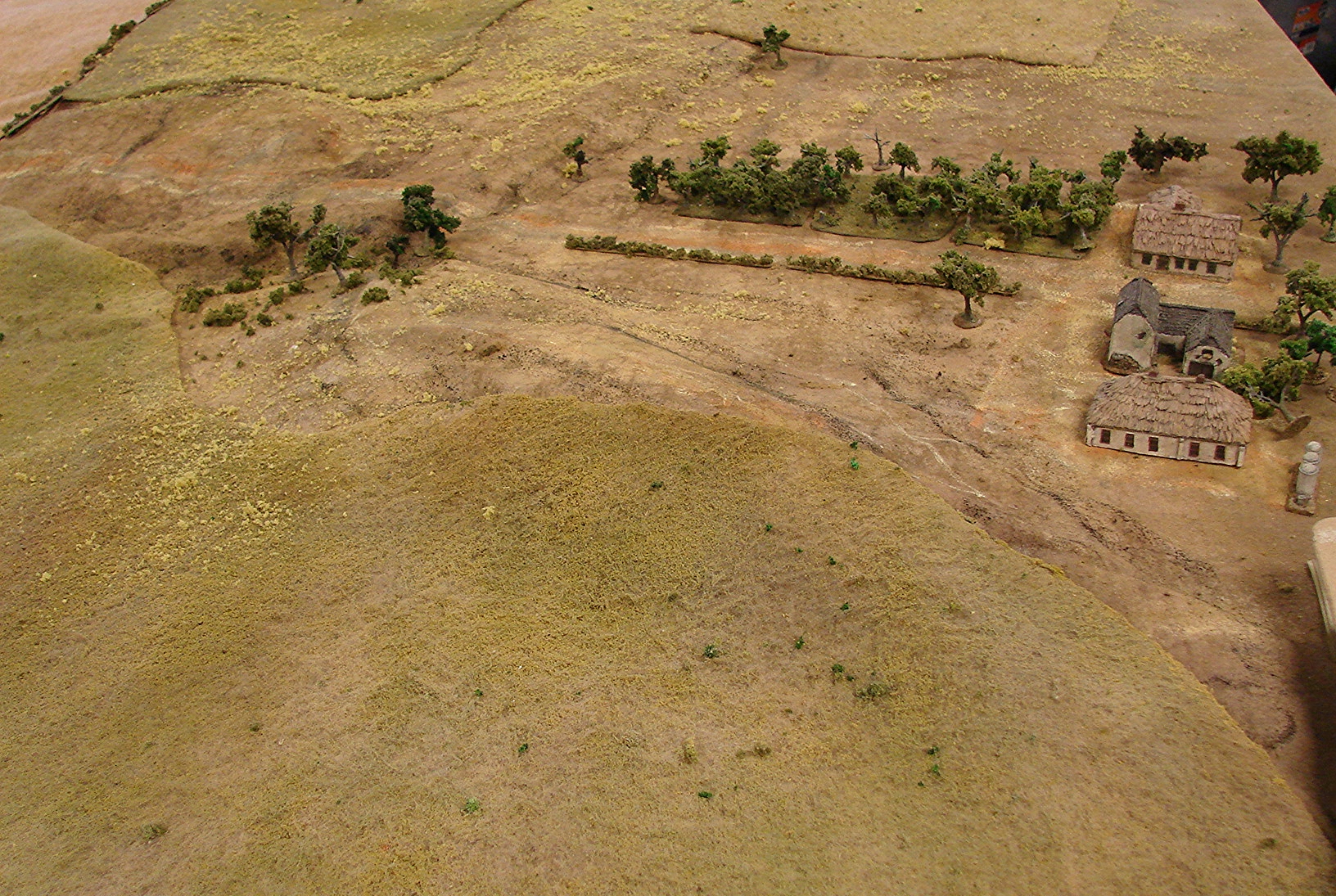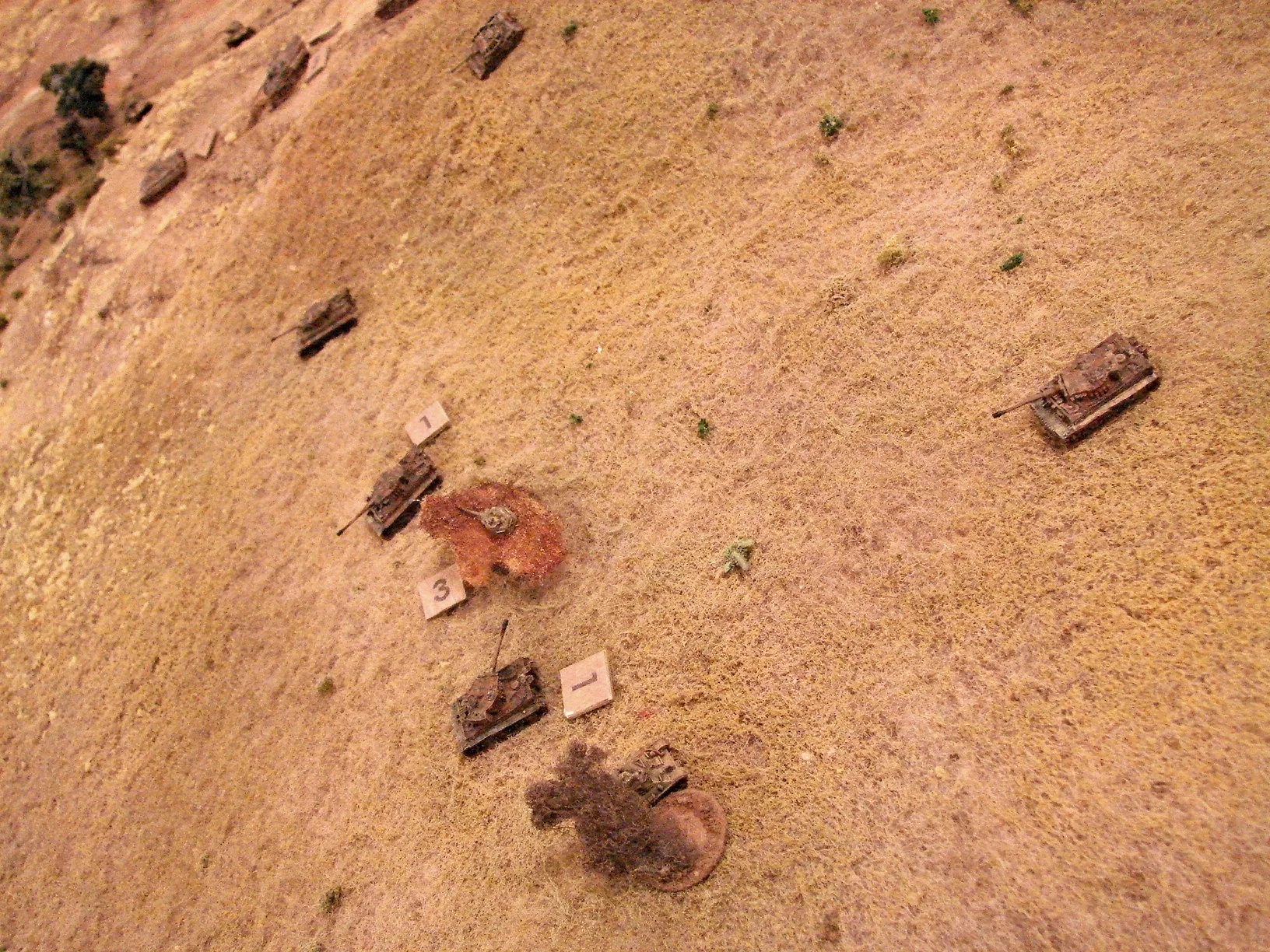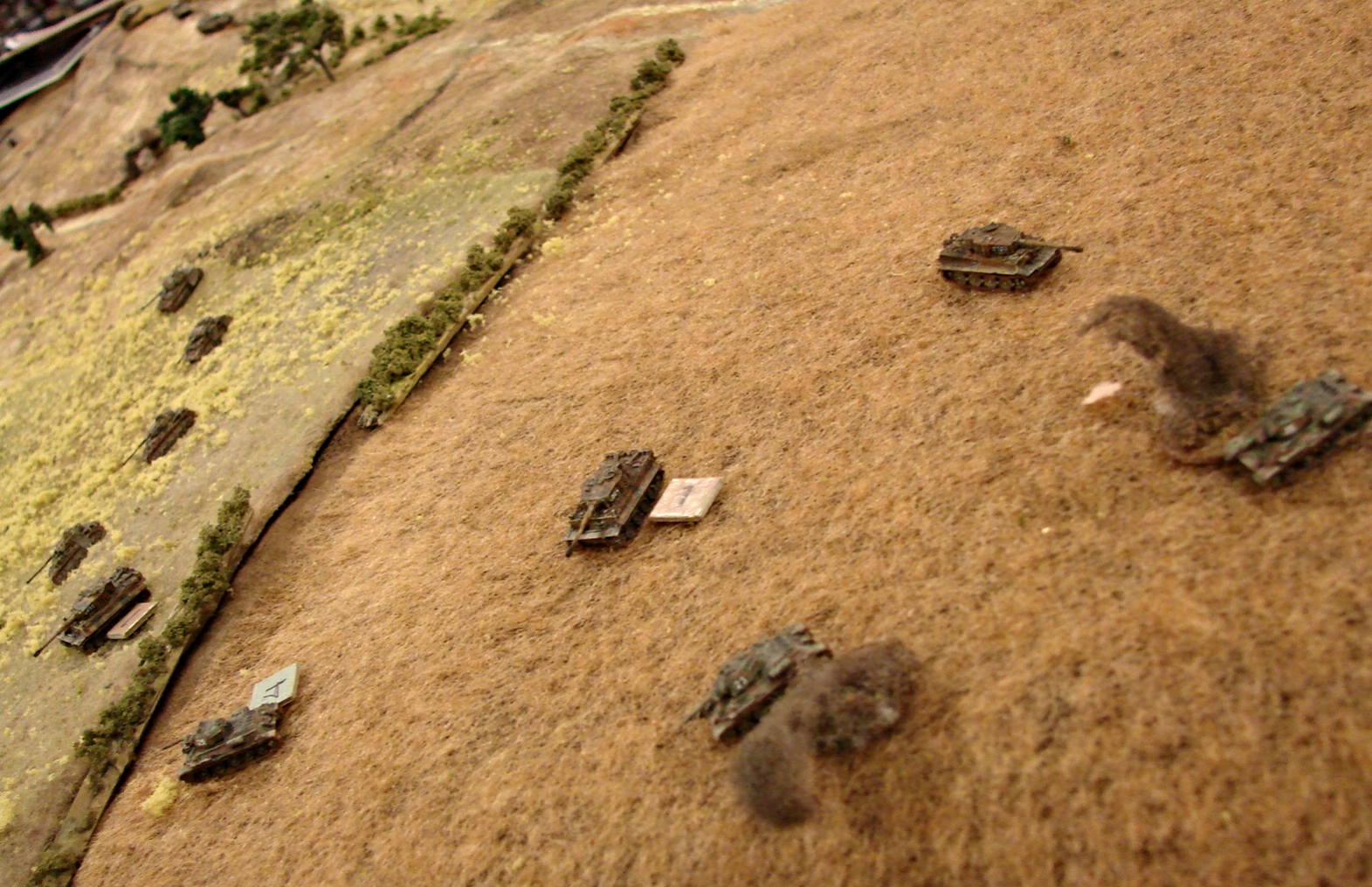Four picture from Sigur Skwarl featuring his first game of IABSM in which he used the first scenario from the rulebook.
Had a request at the club for an IABSM practice/teaching game. From experience, while the first couple of scenarios in the book are good for this, but:
- they don't include everything straight off. I know this is deliberate, but sometimes you also want to teach why a combined arms approach really works
- they can take a long time with inexperienced players
I think I'm now a grizzled enough veteran of the game that I can deal with this, so time for something a little different: IABSM Lite.
No rule changes, but the scenario was designed to fit on a 4'x4' area with sub-company strength forces and a more tactical approach.
The Forces
The British had two platoons; three Big Men, including the company CO; three Sherman V's with a Big Man; and an FOO with two fire missions from a rather busy 25pdr battery (reflected by being 1 pip harder to contact).
The Germans, holding the farm, had one infantry Zug with two Big Men; an MG42 with another Big Man; an FOO with a couple of 80mms; and a StuG III.
Extra cards were Allied Rally, Allied Heroic Leader, Axis MG Bonus and Axis Dynamic Commander.
Simple mission: Take/Hold the Farm
Colin (running the Brits with advice from me) rapidly twigged that there was no cover to be had approaching the farm, so sent a couple of Blinds by circuitous routes to see what he could spook while radioing for a nice big smoke barrage to advance behind.
There was quite a bit of 'no, I won't bring any more Blinds on yet' going on, which was slightly more cat-and-mouse than some IABSM games I've seen. In the end, he brought two infantry platoons on behind the smoke, and managed to get a good way up the road and across the fields before a flurry of Tea Break cards blew the smoke away.
At which point (having been pre-briefed by both Carl - who was watching while playing something else - and I, he brought the 2" mortars into play. The German section in the red-roofed farmhouse took a fair bit of tap, but things never quite panned out to get them Pinned preparatory to a close assault.
With hindsight, I should have reminded him a bit more than I did that HE Pins, and he should probably have brought the Shermans on before the second platoon to plaster the farmhouse and guarantee some Pins behind which to close assault. As it was, when they came on, the StuG (up on the road across the back of the table) picked off first one, then another, in consecutive activations.
The Brits also lost a couple of sections to enfilade fire from the farmhouse, which I think wouldn't have happened had the Shermans been around to do their job. In the end, the infantry in the farmhouse were down to five figures on four Shock, and two platoons went in and basically forced them out due to excess Shock after a tied close assault .
We pretty much left it there, not least so we could talk about it. Essentially taking the farmhouse had cost the British two Shermans and half their force, but the Germans were down to one section, an MG and a StuG III which had a pretty commanding view of the battlefield. It would have been interesting.
Thoughts on "IABSM Lite"?
I think it works: the tricks are:
- Scenario design
- have a clear tactical objective, and set it around the middle of the table.
- make it a bit 'narrative' in nature so the players don't forget what it is
- rationalise some smaller forces: two third of a company or so.
- make sure there's a bit of cover around deployment areas!
- more Big Men
I think this last is pretty key. To keep things moving and make them interesting (and also to show off the 'magic' of the Big Man concept), you need to have slightly more Big Men than the normal org charts suggests. I'd even go as far as to suggest that some platoons should have their 2inC on table as a Big Man as well as the Lieutenant. Colin was, I think, pretty impressed with the flow of the game, and the way the Big Men worked : there was a moment which just felt right where he had a Big Man hare back down the road to activate the 2" mortar.
You might possibly consider, if you go with platoon 2inCs as Big Men, leaving the actual platoon cards out. I dunno? Thoughts?
I'm toying with a few more smaller tactical teasers like this: I think it could be fun and it can finish in a club night.
Mike Whitaker
Today's game was a random encounter using the IABSM rules between the Germans, preparing to withdraw, against advancing Soviets.
Each side's objectives are clear. The Germans must prevent the Russians from taking the town they are defending. The Soviets must clear the Germans from the tabletop.
We played the game on a table 180x240cm (6ft x 8ft) with a lot of terrain, making sure that each side had plenty of cover to fight from.
But let's see the game from the eyes of a camera mans from the time: in black and white.
The two sides begin the game hidden from their opponents under Blinds, separated by the natural obstacle of the river.
As units are spotted, between Russian rage and the aggressiveness of the Germans, the first casualties are not long in coming.
But the Germans have all the axis of advance towards the town well covered.
But the T-34s manage to find a narrow defile through which they advance unseen.
Other Soviet tanks do not bother to try to conceal themselves and fall victim to the precision shooting of the Germans.
But the Russians are no slouches at shooting either, and hit back hard.
But as soon as their Blinds card is drawn, more German tanks appear from where they've been hiding, and hurt the Soviets badly.
It's not just the Soviet tanks that are causing the Germans problems, the Russian anti-tank guns are working hard as well.
The industrial sector of the tow, apparently less well defended, falls to the Soviet infantry.
Allowing their self-propelled artillery forward into good positions from which to threaten the enemy.
The game had to end at this point due to running out of time. We declared the result a draw: yes, by concentrating their fire, the Germans had slowed the Soviet advance enough to be able to withdraw from the town; but the Soviets had already managed to take part of the town before this happened.
But the main aim of the game was to have fun with friends, and that we managed.
Burt (with almost all pics from VIIII Legion)
The Blandingshires at Grochstadt
A newly-retired acquaintance said he'd like to come for a game and he'd never played either of the Two Fat Lardies WW2 rules. So after a bit of email discussion a date was set and I devised a scenario.
View of the table from the German side
The objective for this game was two fold: introduce Don to I Ain't Been Shot Mum, and get some unplayed kit on the table. A straight forward set piece attack then. Late war, North West Europe, two understrength companies as the first wave of a battalion attack on a German defensive line. The two companies are supported by a troop of Churchill tanks, the battalions Wasps, a Churchill AVRE and a FOO. The British are hampered by the "Hesitant Troops" card but they do get "Heroic Leader" and "Rally".
The Germans have two understrength platoons, a pair of Pak40 AT guns, plenty of MG42s and entrenchments plus my new Brummbärs. The Germans are hampered by "Ammo shortage" and "Breakdown" but they get the "Bonus MG Fire".
The Game
Artie crouched under a wet hedge with his company and surveyed the pile of rubble that the maps called Grochstadt. His friend from B Company came up beside him.
"All right, there Artie?"
"All right Bert. You?"
Bert's company was to envelope Grochstadt from the right while he attacked from the front. They had tanks and flame throwing Wasp carriers, but he still didn't like it. The 4th Battalion, Blandingshire Fusiliers had lost a lot of men in Normandy and Holland. The companies were barely platoons.
"Righto, then. See you on the objective." Bert stuck out his hand. Artie shook it and they both repeated the Regimental cry "What ho, Blandingshires!" with a chuckle.
Bert disappeared into the predawn gloom to rejoin his company before the attack.
Artie checked his watch and looked to the platoons on his left and right. It was time. He waved everyone forward and they stepped off to cross another field.
First contact. Germans open up on 3 platoon
A company stalled at a line of bushes. Artie could hear smalls arms crackle to his right as B Company bumped the defenders lining the road. High velocity AT shot screamed over the Churchill tanks deploying from the woods.
Finally he got his men moving across the last field towards the still quiet town.
Churchills advancing
British attack on the town developing
A Company advances into the German MGs
German armoured support
Germans in the rubble
Where was the bloody artillery? His platoon on the far left started to go to ground in the middle of the field. "C'mon! Keep going!" He waved them forward.
The young Lieutenant jumped up, waving his sten gun. "What ho Blandingshires!" he cried and charged forward. The rest of the platoon got up and followed straight into disaster.
As they neared the ruined town the rubble erupted with the sparks of small arms fire and the shredding paper sound of several German MGs.
2 Platoon about to get slaughtered
A vicious fight ensued but only a handful of the platoon came stumbling back dragging a few wounded with them.
Over to the right he could hear the sound of rifle and Bren fire answered by more MG42s.
A big Churchill AVRE clanked up to try and blast the defenders out of their rubble.
1 Platoon presses the attack
With a whoosh and a godawful bang, a panzerschrek rocket roared out of the town and hit the big tank squarely, brewing it up.
Panzerschreck team brews up the AVRE
Their supporting armour started engaging some big German assault guns, with little effect to either side. Except they weren't supporting his remaining platoon trying to assault the town.
Churchills trade shots with the Brummbärs
Things were stalling, and his company was getting cut apart in front of the town. He grabbed the driver of his company HQ carrier. "Get up their and get the Bren on that fucking MG nest!" The corporal put the machine in gear and off it rattled, bullets pinging off it's sides. Soon the Bren gun was chattering away in answer. He then got his other platoon to press it's attack and after a vicious exchange of grenades and close range rifle fire they had a foot hold in the rubble.
More clanking behind him as the Wasps from the Carrier platoon finally got clear of the hedge.
"Where the hell have you been?"
He ran to each carrier, directing it's deadly flame onto the Pak nest and the MG42 nests that had caused him so much grief.
Wasps burn the Germans out of Grochstadt
Only a few Germans were left to surrender in shock or run away in terror.
And there's nothing left....
What remained of A Company dug in among the rubble and got a brew up started. B Company was still tangled up in the hedges along the road clearing the Germans out of some trenches and bunkers. But C and D Company were coming up and the German SP guns were backing off covering the retreat of the surviving grenadiers.
God what a mess. Artie surveyed the damage as he positioned his men to defend the rubble. The Padre and the stretcher carriers were coming up searching for wounded and taking them back to the RAP. 3 Platoon had been pretty much wiped out on the far edge of Grochsadt, caught by fire from a bunker while trying to knock out a second German Pak. Good old Bertie had caught a bullet trying to cheer his lads on to the end.
Artie sat down on a broken wall, suddenly very tired. He fumbled with this pipe as his driver shoved a tin cup of tea into his hand.
"All right there, Sir?"
"All right, Herb. Cheers."
Conclusion
It was a pretty bloody game. 2 Platoon rushing into the German MGs without support or suppressive fires was devastating. The AVRE would've been great for blasting the Germans out of their defences but a stalking Panzerschrek team got it's card first. The Wasps once they finally showed up were pretty devastating, which was good for the Blandingshires, as the attack was running out of steam.
It's been a few years since I played IABSM, so it was good to dust them off and play something bigger. I forgot a few things of course. I need to make markers to remind me that units are pinned or suppressed.
You'll also notice some clear plastic markers with unit labels on them. These are to remind the players which units are activated by which cards.
The Blandingshire Fusiliers are my fictitious British regiment from my Colonial gaming with the BGen Sir Percival Gronville Wooster, VC KCBE.
My friends running the British managed to have fun. Don would like to give the rules another try. My Churchills, Brummbars, Wasps and AVRE all got some game time. So objectives met.
James Mantos
The TFL Specials are a great source of inspiration and scenarios. Here, Charles Eckart plays through Mike Brian's scenario from the 2005 Summer Special: The Initiation of Dashwood-Brown.
Note that as Charles didn't take any pictures, all the photos to dress the text, below, are taken from other IABSM AARs featured on Vis Lardica.
Introduction
As the scenario was originally written for the IABSM v2 rules, we made a number of adaptations to bring it up to v3 standards:
- Big Man ratings:
- Sturmbannfuhrer Merkin rated at Level IV + Dynamic Leader card
- Captain Brown, Lieutenant Evans, Obersturmfuhrers Bender & Bratwurst: all at Level III
- Sergeant Graves, Scharfuhrer Knippling: both Level II
- Sergeant Daniels, Corporal Hall, Sturmmann Zermits: all Level I
- German mortars are contradictory in the article: given as 8cm in the text but listed in the cards as 12cm. We used them as off-table 12 cm mortars.
- Removed the “Up from the Ranks” card and substituted a D6 roll to see if a replacement Big Man appeared when a lost Big Man's card appeared.
- One try only and if no new Big Man appeared the Big Man's card was removed.
- A roll of 1 to 3 would replace a British lost Big Man; a roll of 1 to 4 would replace a lost German Big Man. The difference was because the scenario presented the British as in combat for the first time while the Germans were veterans of fighting in Normandy.
- A replacement for a lost Big Man would be one grade lower than the lost Big Man but a Level I Big Man would be replaced by another Level I Big Man.
- The Vickers MMG’s were assigned to the infantry platoons and would act on the respective platoon card, so only a MG Bonus Fire was needed.
- Each side rolled 1D6+6 for the turn they could place their Reinforcement card into their deck. The Germans got turn 8, the British got turn 12.
Finally, we used the Chain of Command Force Morale tracker for IABSM. Both the Brits and Germans started at Morale 10.
The Game
Normandy, 1944. Suave ladies-man Captain Royston Dashwood-Brown and his men of 6th Dorsetshire Regiment are about to get their first taste of action on the battlefields of France...
FO Lynn took position in the ruins on high ground to try to spot German positions while 1st Platoon on the left of the road led by Sgt Graves and 2nd Platoon under Lt Evans to the right of the road moved to and across the Start Line.
Graves was to move to the hedgerow along the east-west road and probe forward toward the church while Evans cleared the manor house that overlooked the fields west of the main north-south road.
The Germans had had plenty of time to camouflage their positions well (hidden Blinds) so FO Lynn was unable to locate targets.
British scouts (a dummy Blind) moved down the main north-south road and were immediately spotted by the Germans. 1st and 2nd Platoons cautiously moved through the woods east and west of the road with no hard contact but their advanced scouts (more dummy Blinds) were spotted by German outposts (also dummy Blinds). FO Lynn spotted some German outposts running back toward the town but the Germans were alerted to the likelihood of a British attack. Over the next turns HE rounds impacted the fields west and south of 2nd Platoon and in the woods ahead of 1st Platoon. Both halted and called for tanks.
British players muttered “Jerry is windy” and “We’re almost half way across the table and no contact, he’s being foxy too”.
Sure enough, with only one platoon, the MMG’s and ATG’s starting on the table, the Germans were playing for time. They didn’t want to bring their 2nd Platoon and panzers on until they identified the main strength and direction of the British attack and were hoping for additional reinforcements soon after it was discovered.
To this end they placed their dummy Blinds forward to act as outposts to reveal British movements. Their infantry and guns were placed back where they would have long fields of fire.
The British No.2 tank troop joined 1st Platoon and No.1 Troop joined 2nd Platoon soon after. German HE fire was erratic, switching from one location to another each turn. This encouraged both British platoons to rush through the beaten areas toward their objectives.
Evans' 2nd Platoon covered by two MMG’s and the tanks dashed along the hedgerow toward the walled orchard north of the manor but luck was against them. HE fire caught the trailing third section, inflicting four Shock and the entire platoon went to ground.
Next turn the HE fire shifted away and with the help of Rally and Big Man cards Evans was able to remove all shock. While Evans was restoring order to his men the three M4 tanks of No.1 Troop rolled forward, crashing over the north wall of the orchard. One tank was disabled with a thrown track when crashing through the wall. They then fired their main guns at the north face of the manor itself. The wall collapsed in a heap of rubble and, unknown to the British, two Germans were killed and four Shock delivered to Obersturmfuhrer Bratwurst's squad with a MMG in the manor. Both the British and surviving Germans were unable to see each other through the dust raised by the collapsing wall. It was now up to Evans infantry to get into the manor sans support fire.
Stumbling through dust over the rubble, Evans lead two sections into the manor, quickly engaging Bratwurst's men in close combat. A brutal fight ensues in the gloom. Five Brits are down with four Shock on the rest, but the Germans lose Bratwurst, six men and a MMG. The five men remaining have six Shock. Considering the confusion and Shock, the five Germans are ruled as surrendering.
Meanwhile...
Meanwhile Graves' 1st Platoon and No.2 tank troop arrived just one hedgerow short of their objective. Looking ahead toward the house and last hedgerow nothing was seen. But what about the house to the left? Graves decided to send one tank and a section toward the house ahead covered by an MMG, two tanks, and the other two sections to discover any hidden Germans.
“Luck mates.” First section dashed across the open ground protected from flank fire by the tank to their left and entered the empty house. The advancing tankers watched the house beyond a low wall on the left and “spotted something there”. Can they fire first? The main gun barks sending HE into the building with no replying fire. “It was nothing…?” Graves moves his remaining two sections, two covering tanks, and MMG to the objective hedgerow.
The first tank section in the manor orchard risked disabling another tank and crashed over the remaining wall into the manor courtyard. Both made it.
Decision time for both sides. How would Dashwood-Brown use his reserve 3rd Platoon and No.3 tank troop? Where would Sturmbannfuhrer Merkin commit his 2nd Platoon and panzers? Most of all where were those damn German ATG’s and MMG’s?
Quick Break
All the foregoing took only an hour to play through. We decided to pause while Brits and Germans considered their next moves. Written so far mostly from the British perspective and not wanting to show favourites we call a break for Bier und Brats.
Resuming the game after the break we wanted to keep the pace of action up so allowed both sides to re-deploy as long as movement was under cover and not apt to be seen. Also, nothing could advance farther than the most advanced positions still held.
The Germans put their panzers in good ambush positions along with having received a reinforcement (a Tiger!) in an earlier turn. Their second infantry platoon put one Zug into the houses in the main part of town while two others settled in at the church with the mortar FO. One Zug was in the eastern woods with a MMG to guard that approach.
The British had decided that Evans' 2nd Platoon and No.1 tank troop would again risk becoming disabled by crashing through the south wall around the manor, advance into the large orchard, turn left to interdict the western approach road to prevent German reinforcements arriving from there.
Graves' 1st platoon would send one section to clear the two buildings on their left then probe into the eastern woods. The rest of the platoon along with No.2 tank troop would hold in place to engage anything seen around the church.
No.3 tank troop followed by 3rd Platoon and HQ would advance through the fields directly west of the main road and with their right flank covered by smoke rounds called by FO Lynn, and would seize the large building just west of the road. They would then push on through the fenced field to the town itself. Once the town was taken the church could be engaged from at least two directions. The final assault on the church would be from the western side.
At least, that was their plan. Things heated up fast.
Action!
First Platoon spotted a German ATG hiding in the hedgerow just across the road to their right. Graves led a section to close assault it but was surprised to face a full Zug led by Zermitts as well as the ATG crew. In a nasty fight, the Germans are driven into the building where the struggle continued. Zermitts and most of his men fell, five men surrender to Graves. The ATG is taken but the Brits pay a heavy price. Only Graves and one British soldier survive.
As the British reserve moved into the field with the tank wrecked in the previous day's fighting, German FO Roth spotted them and requested a fire mission.
British No.1 tank troop smashed through the south wall surrounding the manor followed by Evans' infantry they enter the field beyond. The infantry reach the low hedge near the road.
Graves spots a Panzer IV in the town, dashes back to his original position to warn No.2 Troop to radio the other tanks about this.
Captain Dashwood-Brown is informed by his boss that a troop of Churchills and a platoon of infantry is available to support him. “Get going and take that town, Captain!”. German ranging rounds hit the Captain’s field. Yes, time to go! “Where’s that smoke cover Lynn?” The tankers aren’t waiting, they race through the gate, deploy in echelon right and move forward. Smoke rounds drop to cover their right flank but FO Roth has adjusted German fire and two of 3rd Platoon's infantry sections are pinned with Shock.
No.2 troop tanks fire on the church, AND MISS! “How the hell do you miss a building big as that?” wonders Sgt Graves. The tanks fire again and open up part of the church.
German HE fire continues to pummel 3rd Platoon, suppressing it and causing more shock.
Evans platoon and No.1 tank troop move east through the orchard toward the town but see no Germans.
Captain Dashwood-Brown decides his 3rd Platoon is stopped and orders the Churchills and 4th Platoon to join Graves' 1st Platoon. Together they are to assault and take the church. Once that is done the center of town will be flanked on both sides and the Germans will probably withdraw.
Sergeant Lumsden, leading 4th Platoon, considers moving through the fields too slow and takes the platoon and Churchills down the main road.
Evans moves his infantry up to the orchard's low hedge near the road but the movement is seen by the Tiger. The turret turns, the MG fires but without effect. Deeper inside the orchard the two Sherman 75’s now vaguely see the Tiger. Both fire their guns and watch a round bounce off but one round has penetrated the big cat that stalls, temporarily immobilized.
The Shermans continue throwing rounds at the Tiger but none penetrate. The infantry fire a PIAT with little apparent result. But the Tiger has had enough and cranking up the engine the big cat retreats.
British Force Morale has dropped to 8 but the Germans are now at just 3. Sturmbannfuhrer Merkin orders a withdrawal before his force collapses with many more losses. Another ATG is abandoned, being too far forward to get away.
Conclusion
It was an interesting game, taking a little more than three hours. Everyone agreed that using Force Morale with IABSM was an excellent idea since it provides a clearer view of how a battle is progressing.
When there is a large difference in morale between the contending sides the lower morale force should consider breaking off the fight. Ending the game before morale collapse would save strength for the next battle in a campaign.
The Germans were particularly unfortunate in this game. Each time they rolled for a morale loss the result was usually the worst possible. The Brits faired much better.
The German side's decision to withdraw before morale collapse could be justified by their lack of sufficient infantry support for their panzers once the British had flanked them by entering the large orchard with infantry and armour and could still attack their front with strong forces
Charles Eckart
This is the first scenario in the Too Fat Lardies' "Bashyna or Bust" campaign, after our "refresher" last Sunday, using I Ain't Been Shot Mum rules.
We have resumed with Steve Clarke being the Soviets and me the bad Nazis. Objective for both sides: take and hold the river bridge.
A slim victory was declared for the Germans - they had the bridge but all the armoured support had gone.
The Russians were in no state to contest it however.
This time the IABSM rules came back to us more easily and the game flowed - in hindsight, this would have made a better introduction for Mike and Allan but we will get the game down to the club again some time.
Meantime, Steve Clarke and I will move onto Scenario 2 in the campaign...
My chosen scenario for Operation Market Larden 2017 (the TFL games day held in Evesham each year) was scenario #06 from the Poland 1939 supplement, The September War: Wegierska Gorka.
Taking place between 2nd and 3rd September 1939, the battle for Węgierską Górką, or the “Hungarian Height”, took place near the Polish-Slovak border and was fought between Polish mountain troops and German infantry. The Polish position included a number of anti-tank bunkers overlooking the valley below, and was therefore of significant strategic importance.
As I wasn't sure of how experienced the players would be, I chose this as a simple attacker/defender scenario with, obviously, the Germans as the attackers. They had to capture or destroy three Polish bunkers and ideally rout any enemy troops present as well.
One quick note. As OML has outgrown it's original home, this year the game would take place in the function room of the hotel in Evesham where we usually end up drinking: highly convenient!
Although a bigger space, and handy for later entertainment, the lighting was unfortunately not good, which meant that my camera suffered all sorts of problems: so no brilliant photos from the day, just a whole load of mildly blurred ones!
Noddy phlegmatically prepares for the German onslaught
The Morning Game
The morning encounter would see Ty playing the Germans and Noddy playing the Poles.
The Nodster had an anti-tank gun and three MMG teams split between the southern bunkers (the ones furthest from him in the pic); another ATG and MMG team in the middle bunker; and two field guns and an MMG team in the top bunker. In addition, he had positioned a platoon of mountain troops supported by three tchankas in trenches between the southern and middle bunkers, dug in along the crest of the hill.
Ty had three full platoons of infantry at his disposal, a platoon of hard-ass assault engineers, a platoon of four MMGs, and two platoons of light tanks (nothing tastier than a Panzer II).
Feinting north with a few Dummy Blinds, Ty brought on his force at the southern end of the table, aiming to hit the central and southern bunkers in one go. Once, however, he had realised that the gap between the southern and middle bunkers was plugged with Polish trenches full of infantry and MMGs, his men changed direction and all headed towards the southern end of the Polish line. By this time, however, he had lost one platoon of light tanks to anti-tank gun fire.
Polish line revealed
Germans mass for the attack
Both sides had called in artillery as soon as possible, but the lines were very busy and neither arrived in time to really influence the battle. In the picture, above right, you can see the dice counting down the turns until each sides artillery appears. You can also see, bottom left, the German MMG platoon: still trying to get into a firing position rather than already upfront laying down covering fire as the infantry advances.
By this time, the Germans had also now lost most of a platoon of infantry, but had finally managed to get themselves into a position from which they were happy to launch their assault on the southern bunker.
In went the engineers, who managed to clear both the MMG post and the main southern bunker before running out of steam.
Assault engineers prepare to go in
southern bunker falls
Up came the German infantry, what was left of it, and more bloody combat occurred as the southern part of the Polish trench line also fell to close assault.
There was a brief moment of comic relief as the Polish CinC used his Heroic Commander card to charge one of the advancing German tanks, but only managed to blunt his sword on its armour.
And that was really the high watermark of the German assault. At this point, as they regrouped to advance, they realised that they didn't actually have any men left...and that it was a long way between the southern and centre bunkers.
Game one: a 2:1 victory to the Poles (i.e. two bunkers held, one lost).
The Afternoon Game
View from the German entry point
After a quick lunch, I re-set the table for the afternoon game. This time, the Germans would be played by Bob; and the Poles by IABSM-newbie, Vlad. This was apparently a nickname, as there was no trace of a Transylvanian accent and although the room was dark, there was still daylight!
As we'd had one attack on the southern end of the Polish position, I was hoping that Bob would try to take the bunkers with an assault across the bridge by the lavender fields i.e. hitting the northern bunker first. As his Blinds began to deploy, however, it was obvious that the Germans had gone for the same axis of attack as they had done in the morning, and the action again would centre on the southern bunker.
This time, however, the Poles had done something different. Although there were trenches dug in the same place as last time, between the southern-most and centre bunkers, they were empty: Vlad had been worried about an attack from across the bridge, and had held his infantry and MMGs back at the northern-most bunker until he could see which way the German attack would unfold.
German attack unfolds
outflanking the line with the panzers
As he hadn't had to change direction, Bob's attack was much tighter than Ty's. His Blinds swept up to the bottom of the slope and, as they were revealed, formed up to effect a classic outflanking manoeuvre: infantry and MMGs as the base whilst the panzers and engineers (the Blind by the panzers in the photo, above right) swept around the Polish flank.
Vlad meanwhile, recognizing the danger, had not only brought his infantry down and into the trenches (the Polish Blind in the left hand photo, above) but had also emptied his northern bunker and sent the field guns therein down towards where the Germans were pouring round the end of his line.
The southern bunker quickly fell to the German engineers, but the Poles then received reinforcements (they had conspicuously failed to appear in the first game) in the form of a second infantry platoon. These reached the Polish trenches at about the same time as his original platoon, and fierce hand-to-hand fighting broke out.
The rest of the German line now moved forward and, as you can see in the somewhat blurry photos, below, things looked pretty bad for the Poles who, by now, had thrown everything they had in a battle for the trenches.
But time waits for no man, and despite the fact that we had been moving the game on pretty smartishly, the Germans ran out of time before they could complete their victory.
A difficult one to call, as it was obvious that the Germans would have eventually won the game: this time, they still had the men to do so. The Poles, however, knowing that the Germans had to beat the clock, had thrown everything they could into holding the enemy down below the central bunker, so deserved to be rewarded for their efforts.
In the end, I forget what I actually decided, but it was still technically a victory for the Poles on the 2:1 rule. Maybe the Germans had done enough to get a winning draw out of it, but...well, they hadn't captured the bunkers, had they.
Aftermath
A couple of great games of IABSM in the company of four fine players of the game. As I said in the introduction, the only annoying thing was the light and therefore my lack of decent pictures, but that is a small matter in the greater scheme of things.
What really pleased me, however, was sitting opposite one of the players at the curry later that night, seeing him sitting there thinking about what he could have done differently to win the game. I could tell that, at that moment, all he wanted to do was get back to the table and play the scenario through again...and again...and again...until victory was his. What more could a humble scenario-writer (such as myself) wish for.
Robert Avery
The guys from Florida wanted a France '40 game with BEF units so I stole a ready made scenario from Rob and the VisLardica blog. It is a German attack on a British held village along the Dunkirk perimeter. The table is flat with a main road running the length of it. Fields with minor hedges are the main area that the Germans have to cross. Their is an end of the line RR station and large area of scrub in the British half of the table.
A return to "I Ain't Been Shot, Mum". This is one of the last battles in the "Bashyna or Bust" campaign by the Too Fat Lardies. The Germans have dug in on the road to Bashyna in an effort to stop the rot.
As some of our club members wished to try out IABSM, I thought this scenario would be a good introduction. Bob and Mike played the part of the Germans with Steve C and Allan taking on the role of the Soviet commanders.
The bogged down Russian commanders felt that they were getting nowhere and decided to call it a day, opting to withdraw rather than take any more punishment.
The well co-ordinated German defence had held the line and prevented the Soviets taking Bashyna, just down the road from here.
We were quite rusty with the rules not having played them for some time and trying to remember how the indirect fire works was a challenge. Probably not an impressive start for Mike, Allan and Bob as Steve Clarke and I really like IABSM.
Must have another go soon to persuade them they are onto a good thing!
Norseygamer
So it was off to Benson again for a re-run of Dave’s Battle of Benson scenario: a fictional Operation Sealion encounter imagining the Germans, having invaded England in the autumn of 1940, are working their way towards London and need to capture a vital bridge on the Oxfordshire/Berkshire border in order to continue their advance.
The last time we played through the game (click here for the AAR, will open in a new window) I played the Brits, so was looking forward to having a go as the commander of the initial Fallschirmjaeger drop: my aim being to capture the bridge by a coup de main and then hold until re-inforced. My force consisted of four platoons of FJs supported by a couple of MMGs, with an HQ gruppe of 10-men plus an anti-tank rifle team. Although my troops were good quality, they had fairly standard weaponry (i.e. no bonus for having loads of SMGs) and had been badly roughed up in the drop (i.e. weren’t Aggressive and only Level II Big Men at platoon command level, meaning that a whole 3-gruppe platoon couldn’t be activated at once by their commander).
The terrain we were fighting over is shown below, and represents the real Benson area in 1940. Later on in the game, when one of the players was complaining about lines of sight (it was probably me!) it was suggested that they might like to walk down the road and have a look for themselves, as the hill and woods in dispute is still there today. The objective is the Shillingford bridge, between the two white houses at the bottom of the table.
The Battlefield
The Objective
With the actual drop taking place off table, my plan was to split my force into two and hit Shillingford simultaneously from both sides. On my left flank, I brought three platoons under Blinds onto the table near a large ruined house (now an old people’s home). In the photo below, you can see that I sent forward one platoon under a Blind in an immediate reconnaissance-by-assault on the house: having no Dummy Blinds, I thought I can either creep forward and get spotted then shot at out in the open, or I can get stuck in asap without taking damage on the way in. Back and to the right is a Blind holding over its Actions: that’s concealing a couple of MMG teams that would reveal themselves and give covering fire if there were Brits in the house.
FJs under Blinds move in
Well, there were: a squad of regular infantry. My machine guns fired, but such was the range and their cover that the Brits only took a bit of Shock. Far more damaging was the close combat that followed: the first round ended in a draw, the second with the Brits being wiped out, but I did sustain three deaths per squad in my own platoon: about 40% casualties, meaning that the platoon was probably relegated to providing covering fire in future.
A costly assault
Just behind the house was a small wood which the Brits had fortified with some sandbags. Within this mini bunker was an MMG and an anti-tank gun, but these were soon taken care of by my troops now occupying the house. The way to Shillingford on the left was clear!
Meanwhile, on my right flank, another two platoons and the HQ gruppe arrived on table, and began to make their way towards Shillingford, keeping to the hedge rows for cover. Before long, they were in position opposite the two buildings at their end of the bridge, and had spotted and were exchanging fire with a couple more squads of British regulars supported by a Vickers. I had a bit of luck here, in that as the Vickers opened fire from its position in the grey barn, I hit it with a ‘natural 17’ on the dice: Churchill’s favourite number so an automatic kill on a support weapon.
Second drop
Second drop in position to attack
Although you can’t see them in the pictures above, there are three squads of Home Guard (commanded by Captain Mainwaring, Sergeant Wilson and Corporal Jones!) at the other end of the table. These began the game protecting the lock and Benson itself, but began moving down table towards me as the game progressed, but were largly wiped out by a couple of rounds of fire from the two MMGs and the HQ gruppe. Their only significance was to delay the advance of the HQ gruppe for a turn or two, which worked in my favour as at this point the British received reinforcements: two carriers (one with an MMG, one with an anti-tank rifle) and an armoured car.
This was hardly unexpected, but still a real pain in the Germanic backside: as the left hand squad of the FJ pltoon in the road opposite the village found out as they lost two men to MMG fire. Desperate measures were obviously called for.
HQ gruppe and the British carriers
Next chip out of the bag was German Heroic Commander, so my CinC grabbed the anti-tank rifle from the team standing enxt to him, jumped the hedge, and walked down the road towards the carriers, firing from the hip.
Obviously he missed, but was fortunately rescued by the appearance of the German Dynamic Commander chip, allowing him to neatly hop back over the hedge and, somewhat sheepishly, hand the ATR back to its team.
Although mildly diverting, this hadn’t solved the problem, so the HQ gruppe of ten men charged up the hedgeline and close assaulted the nearest carrier. This turned out to have somewhat TARDIS-like qualities, as it contained the MMG, eight infantrymen and a driver. A close combat ensued that annihilated the HQ gruppe and left only a couple of dead Tommies on the ground. What it had done, however, was to effctively disarm the carrier, at least until the British infantry could climb back on board.
Meanwhile, the armoured car edged past the carrier and skidded into a handbrake turn opposite where the German CinC and ATR team (plus a light mortar team) were calmly discussing what was wrong with the sights on the PzB39. A round of LMG fire killed one ATR crew member, but the other chap managed to disable the armoured car and force its crew to abandon ship, leaving the road neatly blocked.
Amusingly, when the triumphant anti-tank rifler turned to his CO, hands raised in victory, all he could see was the CO and light mortar team sprinting away for the safety of the platoons near Shillingford. The ATR gunner followed suit as fast as his little legs could carry him.
Preparing to take the Shillingford Hotel
Meanwhile, back on the other side of the river, the first set of German reinforcements had arrived: a recce force of a single Panzer II and a detachment of motorcyclists. Although this was good news for the Germans, the single British medium mortar (by the truck to the right in the picture above) had their range, and began dropping shells right on top of the narrow area around that end of the bridge, not so much causing casualties as slowing everything down and causing a bit of a traffic jam.
Back in Oxfordshire (i.e. the other side of the river) the FJs had moved forward and taken the grey barn building. Resistance in Shillingford was now down to just one squad of British infantry holed up in the Shillingford Hotel.
FJs about to take the barn (the grey building, centre)
Along the road, however, behind the carriers, a british Blind now appeared, repidly deploying as a column of tanks (two A-13s and a MkVIb) supported by an anti-tank gun and a lorry-moubted section of infantry. Seeing the road was blocked, they pushed through the hedge and headed cross-country for Shillingford and the river bank.
British Blind on the road
Blind revealed: British tanks arrive
By now, the FJs should have been in Shillingford, digging in to resist British counter-attack. However the luck (up to this point, the dice had really been with me) now deserted the Germans, and their chip just wouldn’t appear. Worse, the main German reinforcements (a couple of Panzer IIIs and a Panzer IV) had now arrived and, rather than helping, had just contributed to the traffic jam around the bend in the road near the hill. Oh, the British carrier with the anti-tank rifle had been shot at and killed by a Panzer III as it tried to sneak behind the German tanks.
The focus was now bouncing from one side of the river to the other, as the German anti-tank rifle gunner managed to halt the lead tank with a couple of flank shots before being killed himself. The British tanks replied, however, by blowing the lead Panzer III to bits with a couple of well-aimed shots up the jacksy, not before, however, the Panzer III had managed to pin the British squad in the house with some equally well-aimed HE fire, allowing the lead FJ platoon to win the following close assault, even if their bashed-up command structure (only Level II Big Men) hadn’t allowed them the walkover it should have been.
A close up of the tanks just before the German MMGs open fire
Now the German machine guns opened up. They had been gradually moving forward, and were actually in the dug-out previously occupied by the British anti-tank gun by the ruined house. This proved to be a very good spot to occupy, as they were able to pour several rounds of fire into the flank of the second A-13, causing its crew to bail out of what had become a very large collander!
At this point, unfortunately, the game had to end. In terms of what was left on the table, the Germans had two 80-90% strong platoons of FJs, a couple of bashed up platoons of FJs (50-60% strong), a full platoon of regular infantry (just arived with the Panzers), two MMGs and three tanks (a Panzer II, Panzer III and a Panzer IV). The British had a bashed up squad of infantry still in the white building opposite the hotel, an anti-tank gun, a slightly bashed up A-13, a single squad of infantry, and an untouched MkVIb.
Naturally I claimed victory for the Germans, but Victory Conditions were consulted and it was pointed out that I hadn’t actually taken the bridge. Yes, the Germans 100% controlled one end, but the other end was technically overlooked by the remains (4 men) of a British squad. On top of that, no German had actually stepped foot on the bridge. The battle was thus declared a draw, my (many and loud!) protests that if we had just continued for one more turn, then the bridge, and indeed perhaps the whole battlefield, would have been German-held, met with only the single word “if…”!
It had been a great game, with a well-balanced scenario contributing to the action. As mentioned above, for once my dice-rolling was phenomenal…although my opponents quickly caught on to what was happening and started getting me to roll for my own casualties. At one stage, therefore, we reckoned that I was actually killing more of my own men than those of the enemy: for one roll, I even switched to using their dice rather than mine, and still managed to inflict three kills out of three potential kills on one of my squads.
My thanks to Dave and John for running the game, and the rest of the Benson crowd for being such good gamers. I’m now off to the modern day Shillingford bridge, figures case in hand: at least one of my FJs will soon be standing on that damn bridge!
Robert Avery
Hello people.
Here's another of the games that I have in my personal archive and that, for a variety of different reasons, I have not previously uploaded to the blog.
For this game, set in the Spring of '44, the Germans are in defensive positions around a small town on the eastern front, with the Soviets attacking them from two directions: the north and the west.
The sides began the game under Blinds and spent a bit of time "dazed and confused" as to where their enemy actually was.
Soon, however, each side could see the white's of the other's eyes, and battle was joined.
In the end, the game was a draw, as although the Soviets had advanced some way towards the town, the Germans still enjoyed good morale and had much fewer casualties. A more aggressive Soviet attack, or even a couple of bad die rolls, could have swung the game either way in an instant.
Burt
I recently bought a whole set of new buildings for the gaming table (Ed.'s note: these were from the Miniature Building Authority, and bought as a result of a post on Vis Lardica!). I also just finished up some brand new armor. So, of course, we had to play a scenario likely to allow me to use the buildings and my brand new armored assets to the fullest.
Peaceful Village awaits destruction
It turns out that we had a fun and interesting battle, but it almost entirely skirted the town, foiling my hope to use their "destructible" features. And to add further insult, my brand new JagdPanther on the German side and my brand new M36 Jackson tank destroyers on the American side were both a big fizzle.
The Scenario
An American infantry company re-enforced with a couple of 57mm AT guns and a couple tank destroyers must hold on to a recently captured country crossroads in France, Autumn 1944. The forward observer in the bell tower of the church has a radio link to a four gun 105 battery. He sees a large column of German armor coming their way at a good clip.
Here They Come!
Captain Bernie and Lieutenant Chad deployed one platoon of infantry across the width of the board on the edge of town. The other two platoons were held back to await developments. The plan was keep the Germans busy on the outskirts while they stumbled (hopefully) into the three pre-registered artillery target zones.
AT in Village Square Covers Road
The Germans were commanded by Captain Will and Lieutenant Mike. Their objective was to either take the crossroads back by annihilating the enemy, or, if possible, by severely weakening the defenders, then cutting them off from the rear, and forcing their surrender.
They had a rather potent armor and armored Infantry force (four StuG 75mm armed assault guns, one brand new JagdPanther with an 88mm gun , two half-track mounted panzergrenadier platoons and an infantry platoon advancing on foot) but no artillery support.
They were constrained to come in in column on the edge of the board. They sent their dummy Blinds to the right side of the road through the orchards, and all of the actual units went swiftly to the left, skirted by hedges, wheat fields, and low hills. That did not put them out of sight of the forward observer in the bell tower, and very soon a StuG platoon off Blinds and four units still on Blinds were clobbered by American artillery. It didn't hurt or slow the Germans too much, and they continued to press on. Their foot sloggers advanced to the edge of the wheat field and began a desultory fire fight with the Americans on the edge of the village that continued to the end of the game.
The Americans started to shift some of their reserve Blinds over to their right to cover what was now, clearly, the main German effort.
One of the AT guns was in initially positioned far forward on the right but not where it could cover what turned out to be the actual avenue of approach of the Germans. It clearly was about to get flanked. The Americans moved to limber that gun up and get it out of there. They also pushed forward their (awesomely powerful) 90mm armed M36 Jackson TDs to await the German push over the small hill on the right of town.
The TDs Move to Meet the Threat
That's when it all became astoundingly interesting, dramatic, and messy.
A mounted squad of panzergrenadiers started the action and drove up the hill and dismounted. They fought a bloody close combat with the crew of the AT gun that were trying to escape, wiping them out.
AT Crew Can't Escape
AT Crew Can't Escape II
About to Spring
They found themselves face-to-face with an entire platoon arrayed behind a light hedge a few yards out of close combat range. The big-gunned TDs were behind them. The panzergrenadiers were roughed up and their half track was destroyed by the TDs, but it kept the Americans busy.
The next turn, the Germans began their main assault. Two StuGs pushed around the little hill and started a gun duel with the M36 tank destroyers. Two more StuGs crested the rise. A flurry of bazooka fire met the Germans, but to little effect.
Assault Guns Top the Rise
Amazingly, the German assault guns dispatched first one then the other of the American TDs before they could knock out a single assault gun.
StuGs and TDS Shoot It Out!
The American infantry had not sat idle during the armor shoot out. They sent three squads forward and tried their best with anti-tank grenades. They were cut down by the advancing panzergrenadiers and by the bow gun of the JagdPanther which had followed the StuGs up the hill.
Men vs. Machines
Uneven Fight
The last intact platoon of the Americans came streaming out from the cover of the village to try and stem the tide. One of their brave bazooka teams scored a side hit on the mighty JagdPanther and it burst into flames. At this point, the referee was somewhat annoyed that his brand new additions to the table had all failed ignominiously. But you couldn't argue with the fact that it was a pretty damned busy and exciting battle on the American right flank.
JagdPather About to Blow Up
About this time, the Americans finally got their artillery shifted and gave another good wallop to the German infantry as it was trying to reform and mount back up. The Germans still had four functioning assault guns and at least three half tracks filled with eager panzergrenadiers, and they pressed forward and around the back of the town, running straight into a section of armed reconnaissance jeeps and some supply trucks, which they soon turned to flaming wreckage.
The Backdoor is Wide Open
Flanked! Americans Must Fall back toward the Square
The Americans ably shifted their infantry back toward town, sending bazooka teams at the armor and scoring a couple of hits, but eventually running out of ammo and men. The bazooka team that played peekaboo with the panzers at the cemetery gate was particularly bold.
Bazooka Teams Score Some Hits
At this point, the Germans still had approximately as much infantry as the Americans but they also had three functioning assault guns and controlled every axis of approach.
The sole remaining American AT gun in the village square couldn't face every direction at once and the German half-tracks of the HQ platoon came round behind the church and machine gunned the crew down in one volley.
The End: Surrounded and Out of AT Defenses
The Americans had zero anti-tank assets left and were corralled into the area around the church. They were clearly surrounded with absolutely no chance to break out. It was just a matter of time before the German armor turned their cover to burning rubble or, God forbid, they surrendered...so we called the game at that point. Well played by all!
Joe Patchen
Captain Bernie Gets Contemplative
A 6mm I Ain't Been Shot Mum game played at Gigabites Café, Marietta January 2016.
I wanted a fairly small late war, East Front game so went with this skirmish from the Knight Gunner book. The scenario takes place Feb 3, 1945. Fallschirmjaegers are trying to retake a series of villages with the aid of 276 StuG Abt.
Mark Luther
A monstrous tank bash game in 6mm played at my place in October 2015.
This was a rather ambitious attempt to make a game out of the large tank battle outside of Radekhov on June 23, 1941. It was a 4 to 6 player game that would involve dozens of tanks on both the German and Soviet side.
The Germans were from the II Battalion, 15th Panzer Regiment, 11 Panzer Division. A mix of the usual Panzer IIs, IIIs and a few IVs.
The Russians units were tanks from the 20 Tank Regiment, 10th Tank Division, 15th Mechanised Corp. A mix of KV1s, T28s and T26s. Lots of KV1s: fourteen vehicles
Mark Luther
Another game of IABSM dating back to 2012, the main aim of which is to further explore how the rules work. No scenario: just some terrain laid out on the tabletop, a couple of armies and off we go. Strategus Maximus and Burt play the Soviets, Fasbender and Daemon play the Germans...and, for the first time, we are introducing the IABSM concept of Blinds.
Objectives: The Germans must capture a bombed out town, the Russians must stop them doing so.
As soon as the game starts, Soviet aviation begins to punish the German armor.
And where Soviet armor was supposed to have been, Soviet motorized artillery appears instead: and proves very effective as panzerjaegers.
It all looked as if the speed of the German advance was going to quickly end the game in their favour, but an unfortunate die roll reversed the situation and, from here on, it was an easy battle for the Soviets, and a hard slog for the Germans.
The German advance constantly bumped up against hidden Soviet units, and those that they did pre-spot were exactly what they didn't want to find: Soviet anti-tank guns and artillery!
Although it was getting more complicated for the Germans, especially with their dodgy dice rolling, the game was not yet decided, but it really did now look as if they were going to have some difficulties in achieving their objective, especially with the Soviet mobile artillery firing away and holding their positions like lions despite taking extreme punishment!
When the Germans managed to cross the river, which had become their own personal Calvary, they realised that they still had some chance of achieving their goal...provided the dice didn't keep rolling against them.
Given the line of Soviet anti-tank guns in front of them, the Germans then decided on an infantry assault.
Meanwhile, behind a hill, a company of Soviet T-34 tanks was spotted by the Germans. These they could not budge from their strategically important position, although they did do them some damage.
The T-34s, ignoring what the Germans are doing to them, decided to continue with their commander's plan: part of them would attack the Germans approaching them from the other side of the hill in order to delay them for long enough for the others to retreat.
Meanwhile, in the town, the Russian infantry moved into their defensive positions, just before the Tigers started to appear outside the village.
Soviet aircraft, however, aware of the damage they've been able to do to Germans tanks earlier in the day, attacked the Tigers, managing to inflict enough casualties to make the German tanks begin to rethink their attack. On top of this, the T-34s, retreating as planned toward the village, hunted down the rest of the Tiger unit, catching them off guard.
In the end, the only Tiger that remained intact headed for the entrance to the village, more to protect itself from the Soviet aircraft and T-34s than with the aim of taking the town, and found itself assaulted and destroyed by Soviet infantry.
The T-34's, on the other hand, although they've taken heavy casualties, are still following orders and ready for the fight.
The T-34 that have gone to meet the troops on the other side of the hill, are also received "with love and affection" by advancing German tanks.
Meanwhile, the German mechanized infantry, seeing that the Soviet mobile artillery are Pinned from repeated impacts, manage to surround them. Suddenly, however, one of the armored transports jumps in the air, with troops inside included: an IS-2 unit appears from behind the forest, hitting the undefended flank of the half-tracks.
Meanwhile, the German infantry assault on the anti-tank gun battery has still not yet been fully resolved. Each side has lost about half their men, and one Soviet gun crew has limbered up in order to retreat.
Meanwhile, the infantry in the village had barricaded every position in preparation for the German assault.
Although we would have liked to continue, at that point we ran out of time and had to stop.
The German assault had four clear stages:
- The first was an advance without too much opposition.
- The second was confusion in their orders (how we interpreted the bad luck they had from those rascally dice!)
- The third was a resurgence of confidence and a new breakthrough.
- And the fourth was the advance halted as they ran into unexpected Soviet units.
The Germans really did very badly in the game, especially considering that the bulk of their troops didn't even manage to cross the river, and were effectively held up by small units of Soviet antitank artillery and a few T-34s.
In the end, although it was very clear that the Germans weren't in a very good position, we agreed on a draw, especially as much of the poor German performance could be blamed on the dice!
Burt Minorrot, with some of the images by VIIII Legion.
This is a game dating back to 2012 (I'm slowly working my way through the archives) played between Burt and Strategus (the Soviets) and Fasbender and Dae (the Germans). It's a random 15mm set-up using I Ain't Been Shot, Mum! As usual, the Germans were defending a town, with the Soviets attempting to re-take it.
The Germans used their Blinds to try and hide where they deployed, whereas the Soviets, much more numerous, although also using Blinds, didn't bother to try and hide, but spread out right the way across their edge of the table.
The game began with the Russians advancing forward cautiously, almost immediately coming under fire from German artillery concealed within the town.
The Soviets then sent tanks forward in an attempt to outflank the German positions.
The Germans revealed their armour, hidden at the edge of some dense woods. The Soviets, determined to take the town, brought up their katyushkas.
Soviet machine guns units deploy on the top of a hill in order to cover the advance of the infantry. German aircraft attempt to drove of the Soviet T-34s, now approaching dangerously close to their positions.
The Soviet outflanking force of tanks does seem to be having an effect:
Some of the small villages surrounding the town are now in Soviet hands:
But the Germans aren't beaten yet, and their response is not long in arriving, forcing the Soviets to re-locate both to defend themselves and to protect the advance of the infantry, as in the case of their machine guns.
Unfortunately, at this stage we ran out of time, and had to end the game before it became clear who was the winner.
Burt
A 6mm I Ain't Been Shot Mum game played at Gigabites Cafe in July 2015. Folks wanted a tank bash so I went with the Kampfgruppe Stachwitz vs 6th Tank Corps near Verkhnopenye on July 10, 1943. The action starts very early in the morning with the mixed task force of KG Stachwitz from the Grossdeutschland Division moving on to some higher ground after learning of a large concentration of Soviet tanks to the southwest.
Soviet crews were rated as having three action points and the Germans four with a couple of +1 tank aces, so quality to the Germans.
Mark Luther
"So what do you fancy playing?" I asked Bevan: "More Poland?"
"No, I fancy a change. Can you do US Marines assaulting a Japanese-held beach in the Pacific" he replied.
"No" I said, "but I can do US Rangers assaulting a beach in Sicily..."
On 10th July 1943, as part of Operation Husky, a special grouping of Rangers and combat engineers known as Force X was sent in ahead of the main US 1st Division assault on Gela, Sicily and the high ground immediately behind the town. Their aim was to secure the town's pier...but unfortunately their landing craft were spotted as they came in and the pier destroyed before they could get to it. Force X landed anyway, and were very surprised when they came up against Italian troops from Major Rubellino's 429th Coastal Battalion who actually fought back and showed no signs of surrendering or retreating. It took four hours of hard fighting before the town's defenders were eventually subdued.
That's the abbreviated background to the fourth scenario from the Sicilian Weekend scenario pack for the company-sized WW2 wargame, I Ain't Been Shot, Mum! and was the battle that Bevan and I would play. Bevan took the part of the American Rangers and Engineers, I played Major Rubellino's Italians.
Gela, looking down towards the beach where the American landing craft have just appeared
Force X
Force X, commanded by Captain James B. Lyle, consisted of two platoons of Rangers, each consisting of two 8-man assault squads and two 5-man LMG squads. One platoon had a sniper with them, the other a 60mm mortar. The Rangers' HQ had an extra Big Man, as befits veteran troops, and a couple of bazooka teams. With them was a platoon of combat engineers led by Lieutenant Walter "Monday" Poniedzialek consisting of three 10-man engineer squads backed up by a single chemical mortar (a 4.2" heavy mortar). The Americans could also call in fire support from the destroyer Shubrick's 5-inch guns.
Each platoon would disembark from its own landing craft.
The Italians
The Italians would begin the game with just two MMG teams on table, each in its own pillbox on the beach. Historically, these were very successful, with one Rangers platoon just about wiped out when caught in a crossfire between two pillboxes.
The rest of the Italian force consisted of a full company of keen but Green troops: an HQ platoon of two 8-man squads, and then three platoons of four 8-man squads each. They would therefore outnumber Force X about 2:1 and arrive by trucks along the main road at the top of the table.
Crucially, however, the Italian Big Men, unlike their American counterparts, were of universally poor quality: the company commander was Level II, each of the platoon commanders was Level I. This would prove crucial in the coming battle, as I found out how unresponsive and fragile that made my force!
The Italians were defending a ruined church at the opposite end of the table to the beach. All the Americans had to do was dispossess the defenders of the church...but they only had three hours of game play in which to do it.
the objective
the italian infantry arrive
The Game
The game began as the American landing craft hit the beach. The first platoon of Rangers immediately charged out of their boat and headed straight for the nearest, concrete, pillbox. This they took, but not without losing half of one of their assault squads on the way in, and another couple of men and their commander in the assault itself. As happened historically, the Rangers were finding out the hard way that the Italians were actually here to fight!
The Engineers and the other Ranger platoon originally headed straight inland, trying to get into cover among the dunes at the back of the beach.
Realising, however, that they weren't going to make it all the way, the Rangers changed their minds and ended up emulating their colleagues and charged the pillbox the second pillbox anyway.
They, too, captured their pillbox, and they, too, sustained quite a few casualties doing so, also including their commander, but at least the beach was now secure, and the chemical mortar team could begin setting up their weapon.
Meanwhile, the Italians had de-bussed a couple of their platoons, anxious that the chip pile was looking all too green (unit activation is by poker chips, with the Americans using green chips, the Italians blue chips) and that they could easily get trapped under their Blinds as Force X danced rings around them. Players of IABSM will know that one of the crucial decisions is when to move your force off their Blinds (used for concealment and rapid movement) and onto the tactical table top.
Italian platoons 1 and 2 deploy in the narrow streets of Gela
Death from Above!
Having dealt with the pillboxes on the beach, the Americans then started to work their way forwards into the town itself. As the going was tough (a combination of sand and poor dice) they took the opportunity to call down fire from their on- and off-table artillery assets. This proved disastrous for the Italians, as both the chemical mortar and the Shubrick not only started their shoots almost as soon as they were called upon (calling up artillery support can take a bit of time in IABSM!) but landed their initial shells almost exactly where they wanted them too.
Firstly, Italian Platoon 2 was caught in the narrow streets of the town by a barrage from the chemical mortar, directly hitting the centre of the platoon's deployment area. It wasn't so much the fatalities, which were few, but the fact that the platoon was now Pinned down and taking Shock: something that the single Italian Level I Big Man (Tenente Guiseppe Udine) was incapable of doing much about!
Much worse than that, the Shubrick then scored a direct hit on Italian Platoon 3 as it was still in its trucks at the back of the town.
All trucks were destroyed, and casualties amongst the closely packed troops were high!
Vicious Streetfighting
With the Italians reeling from the effects of the artillery fire (the chemical mortars also caught the Italian Company HQ in their trucks, but it wasn't a direct hit, so casualties were comparatively light) the Americans were now able to make their way into the town unmolested.
The Engineers, who had remained under a Blind, now led the way, charging down the main side street of the town to take Italian Platoon 2 in the flank. The Italians, seeing them coming, didn't bother to hang around: with their ears still ringing from the effects of the mortar fire, they routed, fleeing backwards with some squads now having eight or more points of Shock!
This shot was taken half way through the Italian rout: two squads have already been moved backwards
Now, however, things bogged down a bit for the Americans. Yes, the Italians were battered, but there had been an awful lot of them to start with, and those that were left had now hunkered down in houses and factories and were shooting anything American that moved. Not only that, but the Shubrick and chemical mortar now had to cease fire as they ran the risk of dropping shells on their own men.
Slowly the Rangers and Engineers edged forward, but time was ticking on, and, with their limited numbers, even the occasional casualty was painful in the extreme.
Climax
At this point, looking at the clock, I actually thought that the Italians might hold on.
As you can see in the photo below, although two squads of Engineers (top left) can now see their target, it's still quite heavily defended: two untouched Italian squads with their Big Man.
Likewise, the Rangers coming up from the beach in the house top right are blocked by three (admittedly battered) Italian squads led by Capitano Ravenna, their company commander.
Bevan and I looked at the clock. The Americans were so close to being out of time. One more turn, and that's it, we decided.
The turn began slowly, with the third Italian platoon and second Rangers platoon continuing to exchange fire in the factory area of the town.
Then up came the Shubrick's chip.
There was a pause, and then Bevan said: "Right, let's go for it: rain down fire on the church!"
Leaving aside the question of whether this was a legitimate target, being a House of God, only the slightest of deviations would have the Shubrick's shells landing on American rather than Italian heads!
The Shubrick's guns fired, the diced were rolled: direct hit!
Falling masonry, clouds of smoke: the Italians in the church were battered, Pinned and distinctly unhappy!
"You still haven't taken it" I pointed out helpfully, glancing at the clock in a meaningful fashion.
Me and my big mouth!
Next chip out was [American Heroic Commander].
If you look at the pic above again, you'll see Captain Lyle himself lurking in the house next to the two Engineer squads.
This was the opportunity he'd been waiting for. The Level IV Big Man, also an Infantry Ace, led the Engineers in a charge past the gas tank into the church.
One squad was shot down almost as soon as it left the shelter of its house, but the other crashed into the defenders, the assault engineers effectively wiping out their battered opposition.
When the smoke cleared, the Americans were in possession of the church, and had therefore won the game, but Captain Lyle lay dead.
Aftermath
A great game of IABSM that literally went down to the wire. I honestly thought that I could snatch victory from the jaws of defeat, holding onto the church for long enough for the clock to run down...but it was not to be.
Casualties on both sides were horrendous. Historically, the Italians lost 45% of their force before losing Gela, and I think we more than equaled that here. The Rangers lost about half their men, including every Big Man except one; with the Engineers only really having one decent squad remaining as well.
Cracking stuff...and not a tank in sight!
Robert Avery
This scenario, played out by myself (Germans) and Kev (Americans) at the club last Sunday concerns a company of US Airborne troops dropped inland from Utah Beach as part of the D Day landings. C Company’s dropzone is in the region around La Forge, a small hamlet on the road west from Sainte-Marie-du-Mont. Unfortunately, the company’s three platoons have been dispersed and need to join up in La Forge and consolidate their position and prevent German troops from attacking the landing zone.
Capt. Eugene O’Neill, commanding C Company has set up his Command Post in the hamlet and deployed Able platoon in defence. Baker and Charlie platoons are scattered around and are attempting to find their comrades. Capt. O'Neill has to hold on until troops from Utah Beach can reinforce him. These are represented by a platoon of M5A1 light tanks.
So far, the US troops haven't been attacked, but German forces moving towards Utah Beach have spotted the Americans and need to eject them before joining the forces opposing the seaborne landings.
US Forces
HQ : (1 blind +1 dummy)
- Capt Eugene O’Neill (L4)
- Lt. Marvin Doolittle (L3)
- 2 x bazooka teams (2 men each)
- 2 x Browning 0.30 LMG (3 crew each)
Able Platoon: (2 blinds + 1 dummy)
- Lt Doug Gatsby L3)
- 3 x sections(10 men)
- 1 bazooka team
- 1 60mm mortar (4 man team)
Baker Platoon:
- Lt Steve Austin (L3)
- 3 x sections (10 men)
- 1 bazooka team
- 1 60mm mortar (4 man team)
Charlie Platoon:
- Lt Harry Cooper ( L3)
- 3 x sections (10 men)
- 1 bazooka team
- 1 60mm mortar (4 man team)
Tank platoon (on the road, heading for the village)
- 5 x M5 light tanks
- Lt Lou Reed (L2)
La Forge: a sleepy Norman hamlet
The first US platoon arrives from this side of the village
German Briefing
American parachute troops have landed and are all over the countryside. One group is in the vicinity of La Forge. A company of Panzergrenadiers with vehicles has been dispatched to round up the Americans and prevent them securing the roads. Because of the risk of attack by fighter-bombers against large columns moving on roads, the German forces will arrive in separate groups. Two Panzerjägers are available but will not arrive immediately.
The Germans will approach from this side
German Forces
Wave One (arrives when German blind chip is first drawn) 2 blinds plus 2 dummy
HQ Element
- Oberleutnant Stefan Wurst (L4 Big Man)
- 3 MG42 MG teams (2 men each)
- 3 Panzerschreck teams (2 men each)
- 1 SdKfz 250/10 with 37mm PaK and 1 SdKfz 250/9 with 2cm cannon and MG42
Zug One
- Feldwebel Otto Klein (L3 Big Man)
- 3 rifle squads (8 men each)
- 2 Panzerfausts
- 1 additional MG42 team
Wave Two (chip goes in the bag when German blind chip is next drawn) 2 blinds
Zug Two
- Feldwebel Uwe Seeler (L3 Big Man)
- 3 rifle squads (8 men each)
- 2 Panzerfausts
- 1 additional MG42 team
- 2 x SdKfz 251/9 (75cm L24 howitzer)
Wave Three ( chip goes in the bag when German blind chip is drawn for the third time) 3 blinds
Zug Three
- Feldwebel Hans Helder (L3 Big Man)
- 3 rifle squads (8 men each)
- 2 Panzerfausts
- 1 additional MG42 team
- 3 x SdKfz 250/9 with 2cm cannon and MG42
The German A/T chip goes in the bag with Wave Three
Panzerjäger Zug
- Leutnant Georg Ritter (L3 Big Man)
- 2 x Marder III 75mm Pak 40
The Game
The Germans begin their advance under blinds, spotting the Airborne platoon in the paddock surrounded by hedges in the hamlet. On the right more German troops move to occupy the walled garden, again under blinds.
Having been spotted by the Americans in the village, the German Zug takes cover in the walled garden. This will prove to be a problem in the coming battle.
Both sides exchange fire, no casualties are caused but both sides take some shock. The noise of the shooting is bound to attract other troops to the area. First to arrive is a second US airborne platoon, quickly followed by more Panzergrenadiers and some SdKfz recce halftracks. A couple of SdKFz 251 halftracks with short 75mm howitzers also arrive.
Things start hotting up as more fire is exchanged. So far, neither side has suffered many casualties, but shock is slowing things down. The Germans seem reluctant to advance and this allows the US Airborne to start consolidating their position when the final platoon arrives.
This platoon takes up a defensive position behind the bocage lining the road to prevent the hamlet being outflanked by German infantry. The German SdKfz 251/22 with a 75mm Pak 40 near the walled garden opens fire on the hamlet but misses, and this brings an instant response from the US bazooka teams, who destroy the vehicle after a couple of shots.
More German troops arrive
The final US platoon arrives
Things begin to hot up
Bazooka fire destroys the half track
By now, all forces apart from the US tanks and the German Panzerjäger Zug are in action. Both sides are also taking casualties, mainly to heavy fire from the LMGs of both sides.
The platoon defending the hamlet is suffering from MG42 and howitzer fire as the Panzergrenadiers begin to advance across the open fields towards their enemy.
Realising that being stuck in the walled garden is pointless and unable to move along the road due to a US platoon behind the bocage, the German troops climb over the wall and begin to advance across the ploughed field towards the hamlet. A second Zug moves up in support.
However, time is running out because the US cavalry has arrived in the shape of five M5A1 tanks. Where are the Marder anti-tank guns when they are needed?
The M5s immediately open fire with machine guns on the Panzergrenadiers caught in the open, inflicting both shock and casualties. The much-needed Panzerschreck teams seem paralysed with fear and are stuck in the middle of nowhere, unable to do anything useful.
A section of Panzergrenadiers eliminates the US LMGs in the hamlet and advances over the wall towards the houses, causing the US commander to beat a hasty retreat.
There is still no sign of the Marders, who must have fallen foul of the Allies elsewhere in the area, and the machine guns of the American tanks are decimating the Panzergrenadiers caught in the open in the ploughed field. Elsewhere on the battlefield, the third American platoon defending the road behind the bocage, has destroyed a whole section of Panzergrenadiers and pinned another in the open. Oberleutnant Wurst, the German commander is forced to admit that his assault has bogged down and reluctantly decides to beat a hasty retreat before the US tanks destroy his complete company.
We had to call a halt at this point because we had run out of time, but I think that my position (i.e. the German one) was decidedly weak. My infantry were taking a pounding from the tank machine guns and I doubt that my SdKfz 250 halftracks would have stood much of a chance against the fairly weedy 37mm guns of the M5s. I am assuming that their 20mm guns would have been pretty ineffectual against the slightly tougher armour of the US tanks. I really needed those Marders and it was a huge mistake to get the 75mm SdKfz 251 involved early on because it would always have been vulnerable to bazooka fire.
Getting a whole platoon of Germans boxed into the walled garden was a mistake too, especially as an American platoon pitched up almost immediately on the other side of the road, effectively blocking the exit.
Another thought-provoking game, with the victor's crown going to Kev's American Airborne troops.
Carole
The fifth scenario from my September War scenario pack for I Ain't Been Shot, Mum! covers the German 5th Panzer Division's assault on the Polish 6th Infantry Division as it held the line near the town of Pszczyna. And, no, I can't pronounce it properly either!
It's a straight attacker/defender scenario, with the Poles beginning the game holding the town which, as I'm a bit short on Poland-specific terrain, I had built out of what buildings I happened to have available. So please excuse the French look to the place: all I would say is that typical of any beautiful village in the UK, the developers have plonked a brand new "eye-sore" housing estate right in the middle of the town!
As Dave had things to do later on, the Germans would, as the scenario suggests, be on a time limit. So although having what looked like overwhelming numbers, they would have to really get moving to winkle the Poles out of their positions. The German force consisted of a Schutzen infantry company (three platoons, with each squad having two LMGs) supported by a platoon of five Panzer Is and a platoon of three Panzer IIIs. The infantry also had an MMG platoon, an infantry gun platoon, and access to both off-table mortars and air support.
The Poles, although dug in, faced an assault from the Germans that could enter the table anywhere along two sides of the table i.e. they would have to make sure their defence covered a lot of ground. They had at their disposal a couple of platoons of infantry, each with two (huge!) twelve-man squads, supported by three anti-tank guns, a couple of medium mortars, a couple of tachanka-mounted MMGs, and two TKS tankettes borrowed from the division's recon assets. They also had access to off-table artillery.
Plans
The German plan was a little unorthodox (spelt r-u-b-b-i-s-h!) as it invovled not the traditional combined arms approach, but a three-pronged attack designed to keep the Poles permanently off-balance. My panzers would attack from one end of the table, sweeping in to the 'back' of the town; my dummy Blinds would simulate an assault on the other end of the town; and my infantry would come on half way between the two, aiming to capture the church as a good jump-off point for the rest of their attack.
The Poles, unfortunately, largely sussed what my intentions were (I must be getting predictable!). They created a strongpoint with one infantry platoon at one end of the town (the 'back', where my panzers were due to attack) and another strongpoint overlooking the village green and objective marker. The mortars were way out of town at the back, the machine guns split, one to each strongpoint.
The Game
The German Blinds swept onto the table as per the plan outlined above. The fake attack of the dummy Blinds was soon spotted as such, and thus had little effect, but the assault on the church took place almost entirely as planned: with the German 2nd Infantry Platoon not only taking the church (a very surprised Polish FOO was quickly captured at his position in the tower, to be quickly replaced by his German equivalent!) but investing the nearby wood as well.
One slight glitch was that one German squad got caught ambling towards the church by a Polish MMG firing from the new housing estate, and was effectively pinned down out in the open, and then gradually reduced to inefficiency over the course of the next few turns. No matter, I thought, I had the church, and the wood: everything was going to plan.
Meanwhile, the panzers, supported by the infantry guns, had swept on to the other end of the table. The Panzer IIIs were leading, and quickly dispatched a lone Polish anti-tank rifle team for the loss of a bit of paintwork.
The Panzers then failed to spot the Polish strongpoint in the house with the garden (well, it is hard to see out of a buttoned-up tank) and thus began to sweep past it only for one of them to come under a hail of fire from infantry entrenched behind the hedge. Far more dangerous, an MMG opened fire from the upper windows of the house with the blue shutters.
As mentioned above, the panzers had the infantry guns backing them up, and they immediately opened on the MMG's position: not so much damaging the gun or its crew, but causing the building itself to creak and groan and threaten to collapse at any moment. The MMG would have to vacate the property as soon as possible, or risk being crushed under rubble!
Now what I should have done at this point, was to concentrate my fire (the Panzer IIIs, Panzer Is and the infantry guns) on that single Polish section, quickly eliminating it before moving on. Unfortunately, the infantry guns were too busy congratulating themselves on knocking the blue-shuttered house down to do much for the next few turns; the Panzer Is swept past apparently intending to take the town on their own, and the Panzer IIIs got into a duel with the infantry that lasted most of the rest of the game, with machine gun fire killing a Polish infantryman every now and then: most of them safe within their trenches.
The clock was ticking, and the German medium tanks had let themselves get tied down!
Meanwhile, the Panzer Is had, as mentioned above, swept past the Panzer IIIs and headed into town. One broke off and headed for the mortars, which had just started ranging in on the German infantry force, and was immediately engaged by a Polish anti-tank gun. This Panzer I would spend a few turns recovering from being hit, and then go on to force the mortars to retreat off-table, leaving a few bodies behind.
The other Panzer Is attempted to pounce on the anti-tank gun they had now spotted, not realising that actually its position was one of a nest of three guns.
The first anti-tank gun was taken out fairly promptly, the German tanks getting the drop on the crew, but the next took out the German tank commander's vehicle before its crew were driven away from the gun by Shock. Note the Panzer I with all the damage to it bottom-left: that had taken fire from another Polish anti-tank rifle firing from the infantry strongpoint in the town.
Meanwhile...
Meanwhile, the German infantry had been consolidating their position around the church, the house by the church, and the barn by the side of the main road.
That was all well and good, but what now. The infantry in the church couldn't do much, as a charge across to the Polish infantry in their strongpoint would be suicidal without weakening the defenders first...and unfortunately there was no line of fire into their buildings (walls not windows!) for the German MMGs to ply their trade. Yes, they had taken out the final Polish anti-tank gun with a concentrated hail of fire, but they were now just covering the objective marker's position, just as the Poles were too...but the Poles still had possession of the position.
Worse, a thought about trying to work north from the barn had been stymied when the Polish tankettes appeared: happy to block that direction of advance.
So, yes, the Germans were winning, but appeared to have come to a bit of a grinding halt as they came up against the Polish strongpoint in the middle of the town.
Yes...but what now?
To Break the Deadlock
Action was needed: dramatic action. The barn doors swung open and the German 3rd Infantry platoon charged the Polish tankettes! Surely two of the tin cans couldn't stop my platoon for very long?
No, they couldn't, but they weren't going down without a fight, and the German infantrymen found themselves embroiled in a nasty little fight that caused them far too many casualties. I was knocking bits off these tankettes like there was no tomorrow, but I just couldn't kill the damn things!
I was now running out of time. My plan needed updating, and fast.
I decided to bring up the Panzer IIIs and hammer the Polish strongpoint in the town. If I could break that, then the objective was mine and I would win the game. Everything else, I now realised, was both metaphorically and literally peripheral! I would blast the buildings until they fell down, then machine gun the Polish infantry as they fled the rubble.
[Those of you who know their German armour should be chuckling at this point: knowing that the 37mm anti-tank gun on a Panzer III is just about useless for knocking down buildings but, in the heat of battle, I had forgotten this and just fastened on what looked like my largest asset!]
Endgame
Then disaster struck. With just about their last shot before being driven off by the Panzer I, the Polish mortars managed a direct hit on the building holding my machine guns, collapsing the house and forcing the machine gunners to abandon their positions before being buried under rubble.
Things looked a bit grim. Assuming my infantry drove off or destroyed the tankettes, now realising the un-power of the guns on my Panzer IIIs, how was I going to get the Polish infantry out of their strongpoint. I began to contemplate an all out assault. It would be painful, very painful, but might just work.
At that moment, the drone of aircraft engines was heard and, much to my delight, the Jericho horns began to sound and out of the sky dove a Stuka, finally responding to the request of my company commander for a bit of aerial intervention.
The Stuka scored a direct hit on the house, causing lots of casualties to the Poles entrenched inside.
This was it!
The game was mine!
Now was my moment!
My moment, unfortunately, to realise that I had run out of time!
The clock had ticked on to the point where Dave had to go.
We quickly examined the table, and agreed that I would eventually have succeeded in my objective...but eventually was not, according to the scenario conditions, good enough. I was, however, close enough that we both agreed to call the game a draw.
It had been a hard fought game which I should have won, had I not spent so much time shilly-shallying around and not getting properly stuck in. That said, Dave's reading of my intentions and then deployment to block my plans was superb. Without the intervention of the Stuka, I would have had to bring up my infantry guns to shift the Poles with, presumably, my casualties mounting all the time.
A great game.
Robert Avery


